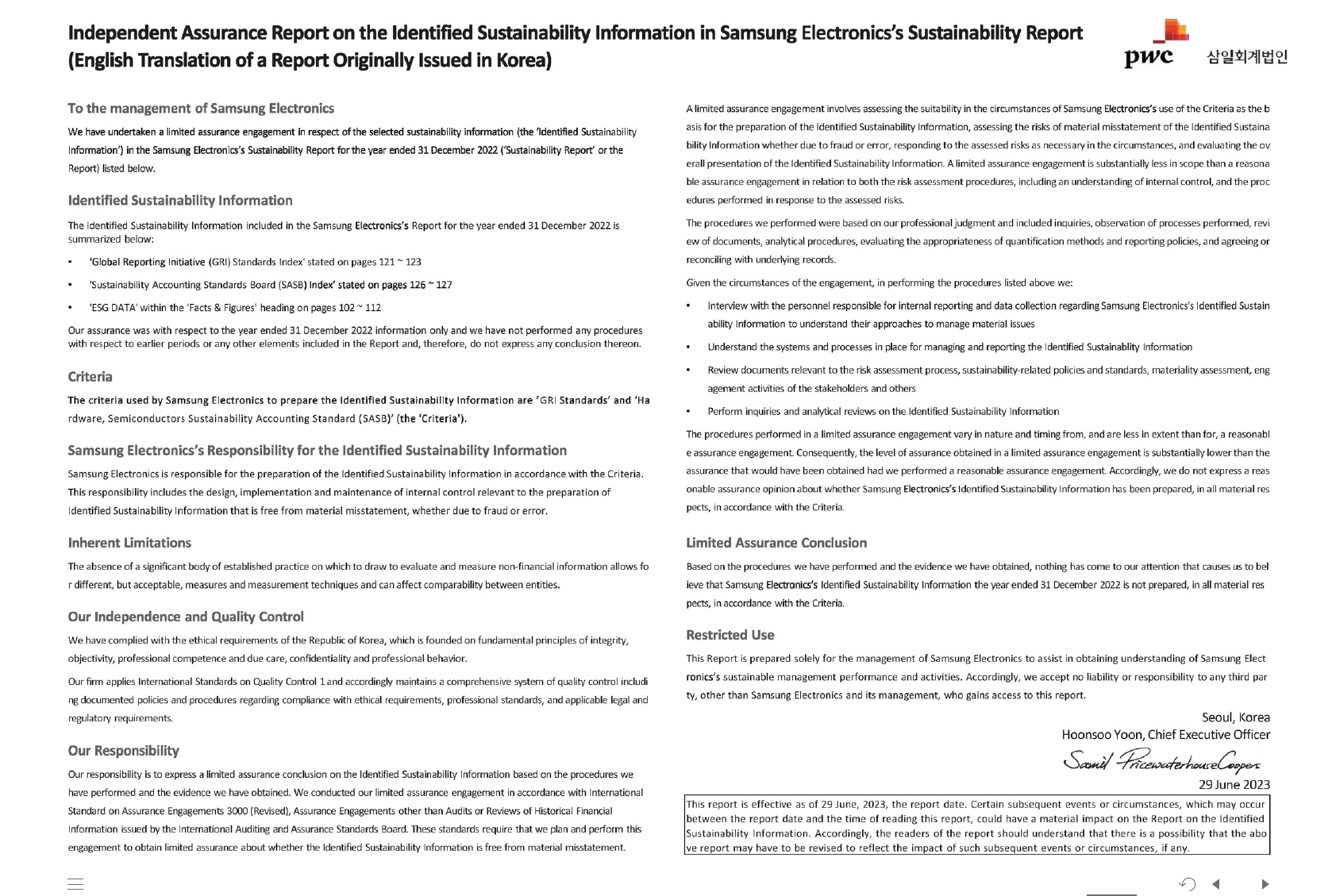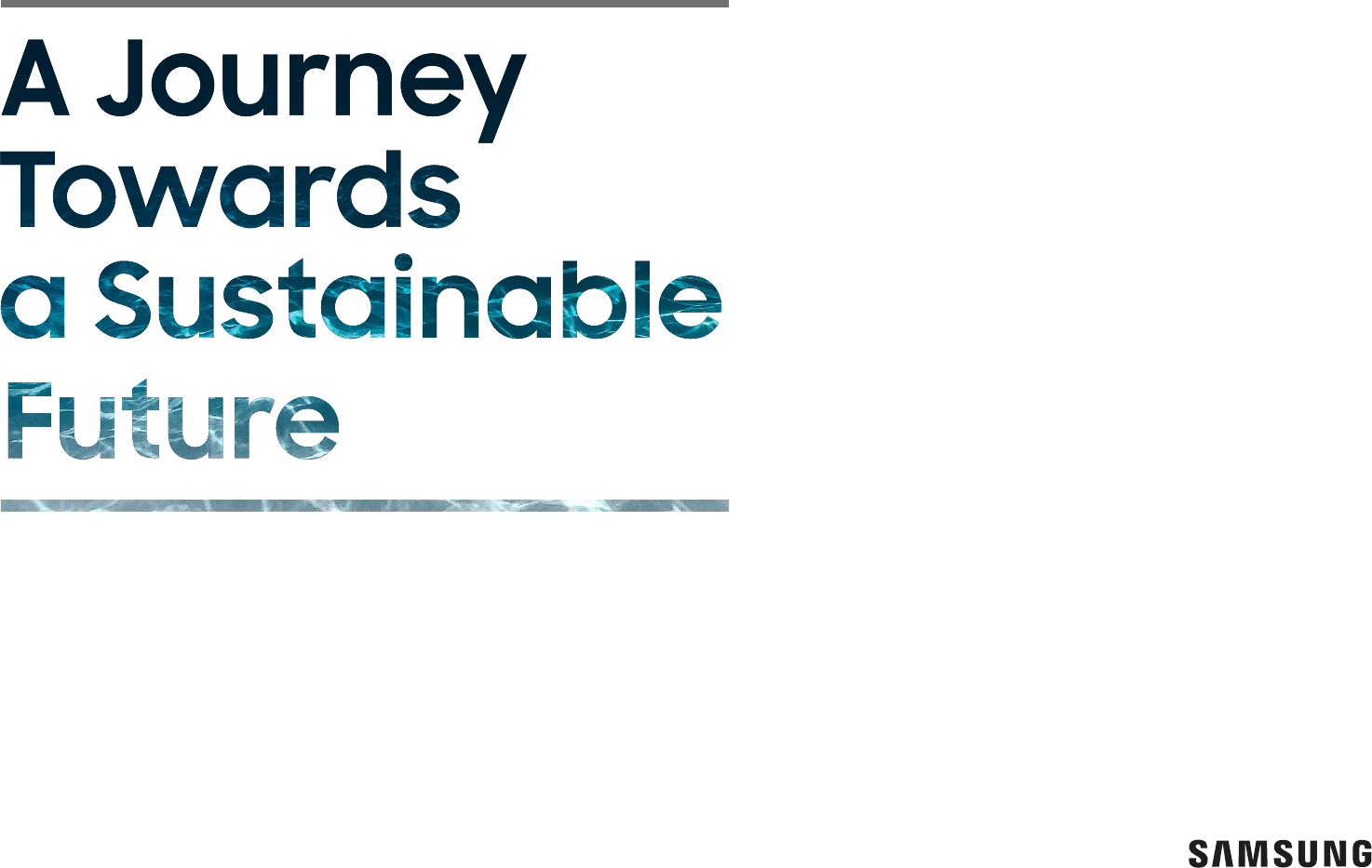
Samsung Electronics Sustainability Report 2023
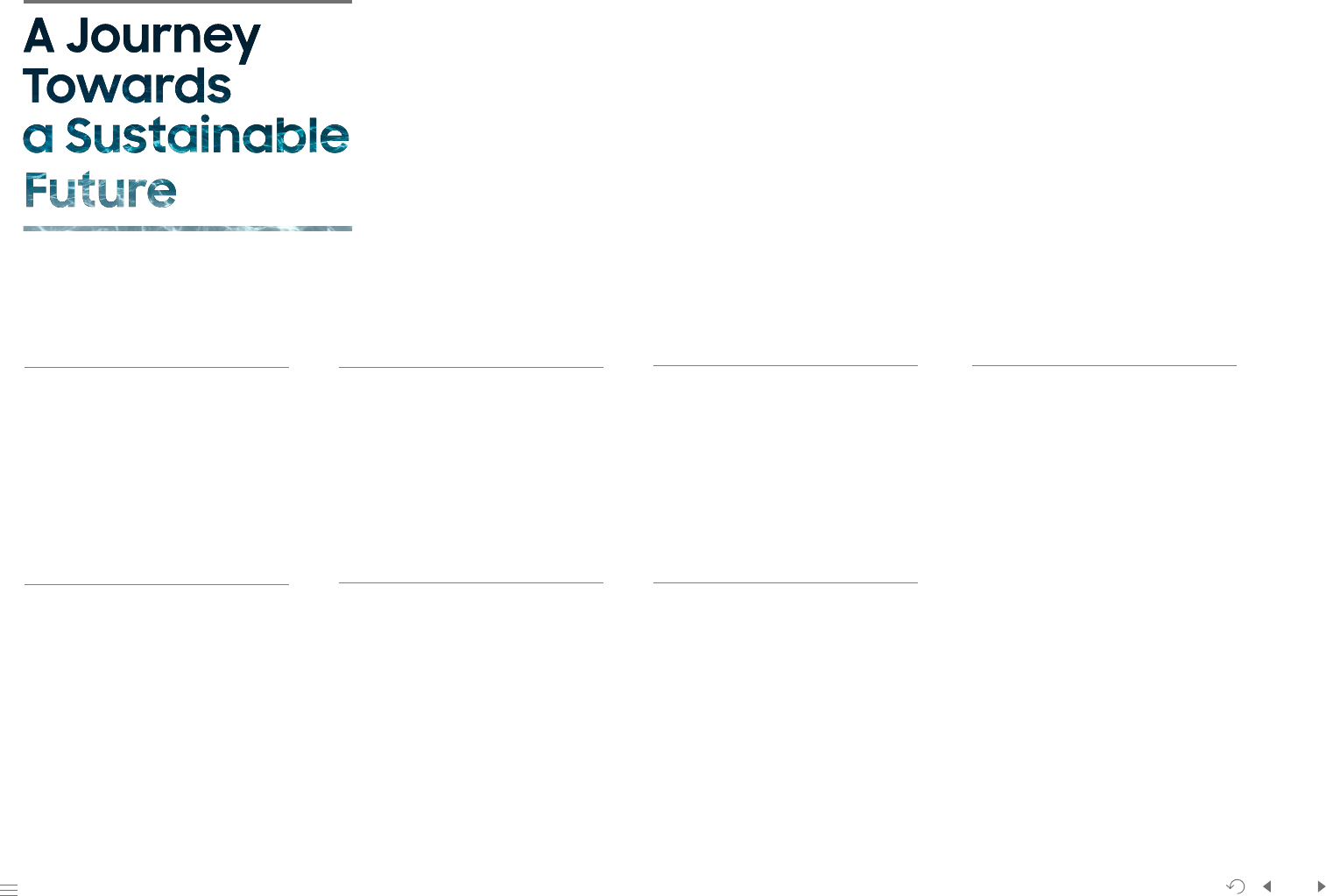
Our Company
Message from Our CEO
Company Overview
Global Network
Stakeholder Engagement
04
05
06
07
Planet
New Environmental Strategy
Climate Action
Circular Economy
Clean Tech Ecosystem
Sustainability in Operations
15
20
25
30
32
People
Human Rights
Human Resource Management
Diversity, Equity, and Inclusion
Tech for All
Sustainability in Supply Chains
Empowering Communities
40
54
59
64
74
87
Principle
Corporate Governance
Compliance & Ethics
94
97
Facts & Figures
Economic Performance
Social Performance
Environmental Performance
Performance by Division
Sustainability Value Creation
Materiality Assessment
Alignment with UN SDGs
101
102
108
112
113
114
116
Appendix
Independent Assurance Report
Verification Statement on Scope1,2
Greenhouse Gas Emisson
Verification Statement on Scope 3
Greenhouse Gas Emisson
GRI Index
TCFD Index
SASB Index
About This Report
118
119
120
121
124
126
128
Approach to
Sustainability
Business Sustainability
Highlights of Product Sustainability
Sustainability Achievements
09
10
13
Our Company AppendixApproach to Sustainability Facts & Figures PrinciplePlanet
02
People
Samsung Electronics Sustainability Report 2023

Our Company AppendixFacts & Figures PrinciplePlanet
03
People
Samsung Electronics Sustainability Report 2023
Approach to Sustainability
Our Company
04
Message from Our CEO
05
Company Overview
06
Global Network
07
Stakeholder Engagement
Our Company AppendixApproach to Sustainability Facts & Figures PrinciplePlanet
03
People
Samsung Electronics Sustainability Report 2023

Our Company AppendixFacts & Figures PrinciplePlanet
04
People
Samsung Electronics Sustainability Report 2023
Approach to Sustainability
CEO and Vice Chairman
Jong-hee Han
Dear Shareholders, Customers, Partners, and Employees,
Samsung Electronics is committed to embedding sustainability in our
business and product strategies while striving to play a leading role in
the global effort to build a sustainable future.
Growing environmental and socioeconomic risks coupled with
geopolitical uncertainties have reinforced our belief that sustainability
needs to be a key force for driving our competitiveness and technological
innovation.
To accelerate this drive, Samsung Electronics announced the New
Environmental Strategy on September 15
th
, 2022, and cemented our
resolve to address global climate and resource challenges in cooperation
with our stakeholders.
With this new strategy, we plan to achieve net zero for the DX Division by
2030 and company-wide, including the DS Division, by 2050.
As a global information and communication technology (ICT) company,
our responsibility is to make positive, lasting impacts throughout the
value chain and society. To this end, we aim to mitigate carbon emissions
by using our innovative technologies and maximizing resource circularity
across the life cycle of our products.
Tackling global environmental challenges requires concerted efforts
from a wide range of stakeholders. We are therefore continually
expanding our collaboration and partnership with various stakeholders
to explore technological breakthroughs and address systemic and
physical barriers.
Our involvement in the Asia Clean Energy Coalition (ACEC),
Semiconductor Climate Consortium (SCC), Decarbonizing the Use Phase
of Connected Devices (DUCD), and Platform for Accelerating the Circular
Economy (PACE) are good examples of such collaboration that strives
to work across value chains and with industry peers. Another notable
partnership is with Patagonia to address the issue of microplastic
pollution, which led to the introduction of new wash cycle and filter that
reduce the amount of microfiber released to the environment.
Samsung Electronics is also reinforcing compliance with human
rights principles while promoting sustainable management practices
throughout our supply chain, better serving local communities, and
enabling professional growth of our employees.
In February 2023, we announced our Global Human Rights Principles as
an extension of our commitment to protect human rights under the UN
Message from
Our CEO
Guiding Principles on Business and Human Rights (UNGP). Our Global
Human Rights Principles convey our will to engage employees, suppliers,
local communities, partners, and consumers in our pledge to uphold
fundamental human rights.
Regarding corporate social responsibility, our activities include diverse
training initiatives that focus on building technical capabilities of
future generations as well as donation programs that reach out to
the underserved. A prime example is our Kiosk of Sharing, a program
through which employees can donate to underprivileged children in the
communities we serve simply by tagging their employee ID card. This
program aims to foster a culture of giving among our employees, and it is
currently active at all of our business sites in Korea and at select sites in
Vietnam, Thailand, India, China, and the US.
In line with our longstanding emphasis on cultivating talent based on
our corporate philosophy of “People First,” we launched The UniverSE—
The University of Samsung Electronics—in 2023. This company-wide
leadership and vocational training platform is designed to help our
employees develop the skills required to achieve both professional and
personal growth.
We have also rolled out a data science course for our employees and
suppliers to equip them with the necessary skills to excel as the future
workforce in the digital transformation era.
Furthermore, we are pleased to mark 2023 as the initial year of our
support to strengthen ESG performance of our suppliers. In this context,
we expanded our supplier training programs to bolster their compliance
with the Supplier Code of Conduct and relevant laws, support climate
action and resource-circularity initiatives, and adhere to labor and
human rights policies.
Samsung Electronics will continue to join hands with diverse
stakeholders and seek innovative technology-based solutions to tackle
pressing environmental and social challenges. Despite many obstacles
that may lie ahead, we will move forward steadily to fulfill our goals
toward a sustainable future one step at a time. We look forward to your
continued support and partnership in this journey. Thank you.

Our Company AppendixFacts & Figures PrinciplePlanet
05
People
Samsung Electronics Sustainability Report 2023
Approach to Sustainability
About Our Organization
Our organization is divided into the two main divisions of DX (Device eXperience) and DS (Device Solutions), and we ensure that each division operates independently. DX took a new leap forward with the integration of the CE
(Consumer Electronics) Division responsible for, among others, TVs, monitors, air conditioners, refrigerators, and IM (IT and Mobile) Division, responsible for mobile devices and network systems. DS consists of the Memory,
System LSI, and Foundry businesses.
Company Overview
We aim to bring positive change to the everyday lives of people around the world by offering top-quality products and services created with innovative technologies and talented workforce. We also developed our Global Code
of Conduct, which articulates our commitment to helping the world move forward based on our five Key Values
. We will incorporate the Key Values into every aspect of our business operation and ensure compliance with the
Global Code of Conduct
to achieve our ultimate goal of sustainable growth.
* The sales and operating profits above are based on 2022 figures, excluding the performance of Harman and SDC (Samsung Display Company).
Sales
KRW
182,489.7
billion
Sales
KRW
98,455.3
billion
Operating Profit
KRW
12,746.1
billion
Operating Profit
KRW
23,815.8
billion
Major Business Units
Device eXperience
DX
DS
Device Solutions
Networks
Mobile eXperience
Visual Display
Digital Appliances
Health & Medical Equipment
System LSI
Memory
Foundry
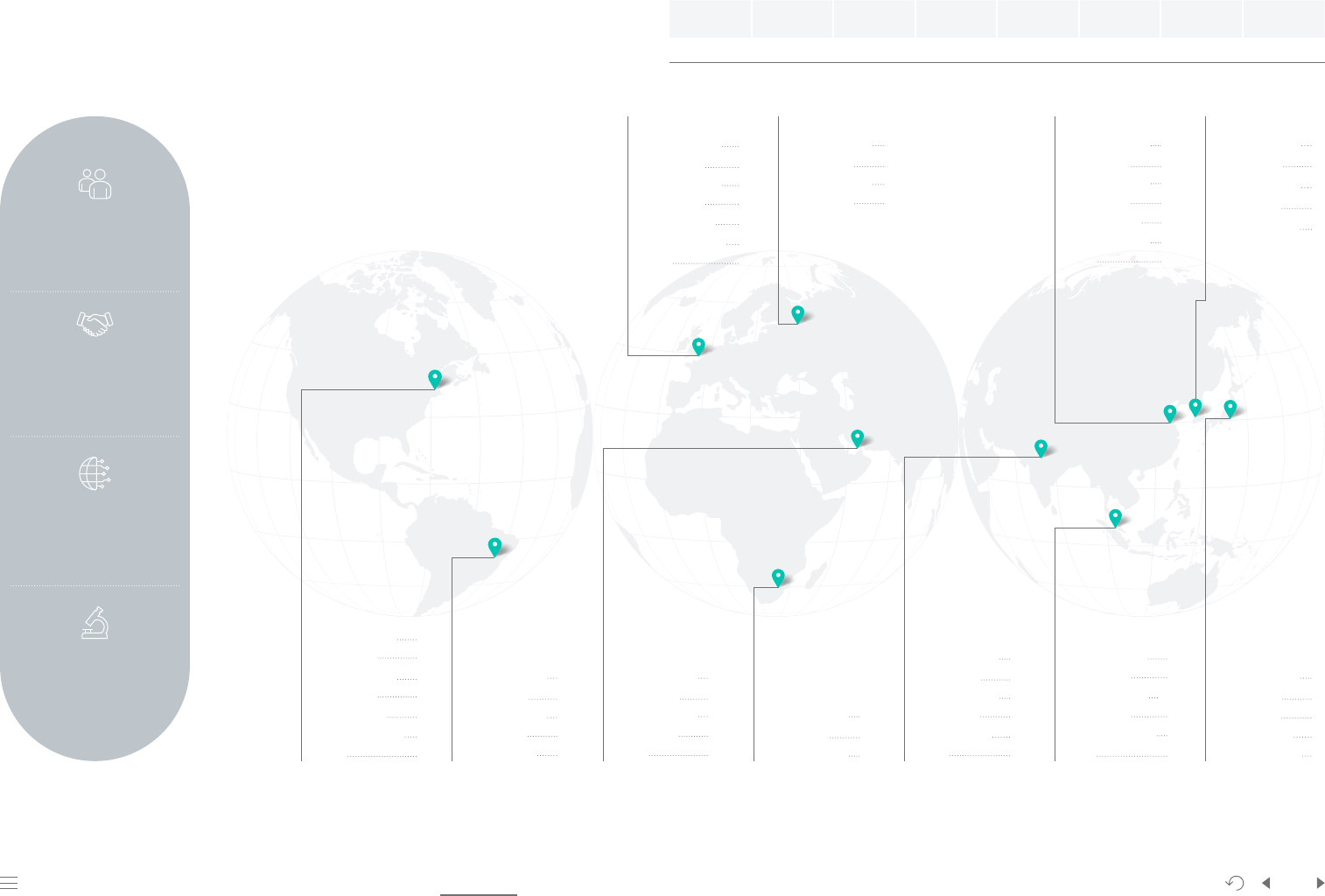
Our Company AppendixFacts & Figures PrinciplePlanet
06
People
Samsung Electronics Sustainability Report 2023
Approach to Sustainability
Global Network
As of the end of 2022, our global business network consists of 232 production sites, sales offices, R&D
centers, and design centers. With global headquarters in Korea, we have 15 regional offices including
in North America, Southeast Asia, Europe, and Africa
1)
.
North America
Regional Offices
Sales Offices
Production Sites
R&D Centers
Design Centers
Purchase Centers
Others
2
5
3
8
1
1
8
Regional Offices
Sales Offices
Production Sites
R&D Centers
Design Centers
Central and
South America
1
20
3
1
1
Europe
Regional Offices
Sales Offices
Production Sites
R&D Centers
Design Centers
Purchase Centers
Others
2
24
3
4
1
1
9
CIS
Regional Offices
Sales Offices
Production Sites
R&D Centers
1
7
1
1
Regional Offices
Sales Offices
Production Sites
1
8
1
Africa
Regional Offices
Sales Offices
Production Sites
R&D Centers
Others
Middle East
1
17
2
4
1
Regional Offices
Sales Offices
Production Sites
R&D Centers
Design Centers
Purchase Centers
Others
2
4
4
8
1
2
2
China
Regional Offices
Sales Offices
Production Sites
R&D Centers
Purchase Centers
Others
Southeast Asia
2
15
6
3
1
2
Regional Offices
Sales Offices
Production Sites
R&D Centers
Design Centers
1
1
6
5
1
Korea
Regional Offices
Sales Offices
R&D Centers
Design Centers
Purchase Centers
Japan
1
1
2
1
1
Regional Offices
Sales Offices
Production Sites
R&D Centers
Design Centers
Others
Southwest Asia
1
6
2
5
1
2
R&D expenditure
KRW
24.9
trillion
Operations in
74
countries
Suppliers
4)
2,131
Employees
270,372
Regional
Offices
Sales
Offices
2)
Production
Sites
R&D
Centers
Design
Centers
Purchase
Centers
Others
3)
Total
15 108 31 41 7 6 24
1) Regional classification is based on Samsung Electronics’ internal management criteria. 2) Sales Subsidiaries and Branches 3) Distribution Subsidiaries, IP Offices 4) Suppliers of parts used in the manufacturing of Samsung products
* As of 2023, the number of purchase centers previously included in “Others” is disclosed separately. In addition, the number of sales branches previously included in "Others" has been included in "Sales Offices."
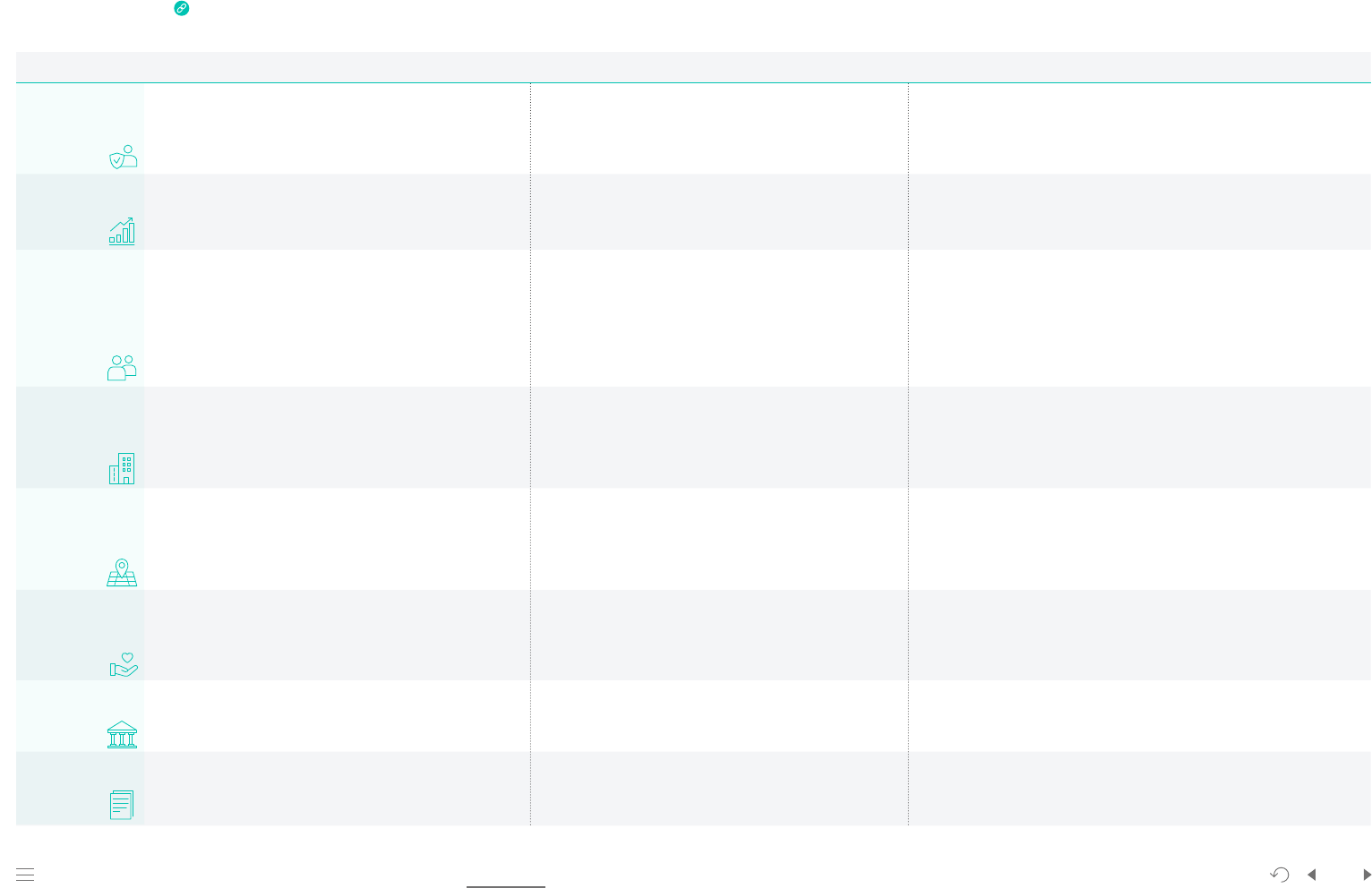
Our Company AppendixFacts & Figures PrinciplePlanet
07
People
Samsung Electronics Sustainability Report 2023
Approach to Sustainability
Stakeholders Key Interests Communication Channels Major Activities
Customers
(B2C & B2B)
· Quality of products and services
· Safety in product use
· Environmental impact of products
throughout their life cycle
· Accurate product information
· Transparent communication
· Customer satisfaction surveys
· Contact centers and
service centers
· Samsung Electronics Newsroom
· Samsung Semiconductor
Newsroom
· Sustainability Website
· Sales Channels
· Product Environmental Report
· Reinforcing quality and safety
management systems
· Offering product information via country-
specific websites
· Resolving issues identified through VoC
(Voice of the Customer)
· Staffing sustainability specialists at the
subsidiary and business levels
Shareholders and
Investors
· Economic performance
· Risk management
· Information-sharing
· Sustainability agenda, including
environmental, social, and
governance issues
· Annual General Meeting
· Non-Deal Roadshows, Investor
Meetings
· Earnings Releases
· Investors Forum
· ESG Roadshow
· IR Website
· Forecasting business environment and
performance
· Updating shareholder return policy
· Disclosure of information on corporate
governance
· Collecting views of shareholders and investors
Employees · Safe and healthy work environment
· Diversity and inclusion
· Training and career development
· Employment and benefits
· Labor relations
· Organizational culture
· Labor unions, work councils
· Counseling centers
· Satisfaction surveys on organizational
health, work concentration, and
employee experience
· Sustainability Website
· Communication with the
executive management
· Online communication platform,
including Samsung NOW
· Compliance and ethics
whistleblowing channels
· Offering tailored career development
programs
· Town hall meetings hosted by individual
businesses
· Mentoring for the executive management
by Millennial and Gen Z employees
· Managing work environments at our
business sites
· Fostering a culture of trust and communication
· Employer Branding Activities
Suppliers · Partner collaboration
· EHS(Environment, Health & Safety)
performance
· Fair trade
· Protection of workers' human rights
· Environmental and social issues
· Global Supplier Relationship
Management System
· Hotline, online whistleblowing channels
· Partner Collaboration Day, supplier
dialogues
· Partner Collaboration Academy
· Sustainability Website
· Funding and technology support
· Employee training and innovation support
· GHG emissions reduction management
· Responsible management of suppliers’ work
environments
· Grievance resolution
Local Communities · Local employment, local
economic development
· Indirect economic effects, including
investment and employment
· Conservation of local
environment
· Philanthropic activities including
donations and volunteer work
· Local volunteer centers
· Sustainability Website
· CSR Website
· Local community councils · SME support programs, including Smart
Factory
· Conservation of river ecosystems near
our business sites
· Community outreach programs on education
and employment
International
Organizations, NGOs,
Associations, Specialized
Organizations
· Social responsibility for local
communities and the
environment
· Contributions to climate action
and other UN SDGs
· Transparent and timely information
disclosure
· Corporate dialogues
· NGO meetings
· Stakeholder forums
· Meetings between civil society
organizations and executive
management
· Sustainability Website
· Collecting views of global NGOs
· Engagement with RBA
1)
, RMI
2)
, and BSR
3)
1) Responsible Business Alliance
2) Responsible Minerals Initiative
3) Business for Social Responsibility
· UNGC
1)
activities
· Engagement with ACEC
2)
and SCC
3)
1) United Nations Global Compact
2) Asia Clean Energy Coalition
3) Semiconductor Climate Consortium
Government · Indirect economic effects, including
investment and employment
· Fair trade
· Occupational health and safety
· Compliance
· Business ethics
· Policy conferences
· National Assembly
· Public hearing for policymaking
· Policy advisory bodies
· Sustainability Website
· Supporting SMEs in collaboration with
the government
· Operating joint venture investment windows
in collaboration with the government
Media · Business strategy for major products
· Progress on implementation of New
Environmental Strategy
· Investment strategy
· Press releases
· Sustainability Website
· Samsung Electronics
Newsroom
· Supporting media coverage of global
IT exhibitions and unpack events
· Media days
· Press conferences
· Interviews
· Planning and promotional activities
Stakeholder Engagement
Active communication with our stakeholders is an important part of fulfilling our responsibility as a global company. We disclose relevant information in a transparent manner and continually update contents year-round on
our Sustainability Website
. We seek to strengthen our relations with our stakeholders and align ourselves with them on issues regarding sustainability through active communication via multiple channels, including forums,
surveys, and on-site visits.

Our Company AppendixApproach to Sustainability Facts & Figures PrinciplePlanet
08
People
Samsung Electronics Sustainability Report 2023
Approach to
Sustainability
09
Business Sustainability
10
Highlights of Product Sustainability
13
Sustainability Achievements
Our Company AppendixApproach to Sustainability Facts & Figures PrinciplePlanet
08
People
Samsung Electronics Sustainability Report 2023

Our Company AppendixApproach to Sustainability Facts & Figures PrinciplePlanet
09
People
Samsung Electronics Sustainability Report 2023
Mobile Devices TVs and Audio Systems
Home Appliances Semiconductors
Business Sustainability
We pursue sustainability throughout the product's life cycle, from design and development to manufacturing, usage, takeback, and recycling.
At the Device eXperience (DX) Division, we develop environmentally responsible materials and energy efficient solutions and collect and recycle e-waste globally. In addition, we continuously enhance the accessibility features of
our products and provide upgrades to improve user experience.
At the Device Solutions (DS) Division, we strive to minimize greenhouse gas emissions in the manufacturing of semiconductor products, including memory, image sensors, and driver integrated circuits (ICs). In addition, by
enhancing the energy efficiency of semiconductor products we are reducing the amount of energy consumed by data centers and IT devices, such as smartphones and laptops. We also seek innovations from the product design
stage all the way through production with the aim of transforming end-of-life products into resources.
Recycling of discarded fishing nets
Discarded fishing nets that destroy
ocean ecosystems are transformed
into parts for our smartphones, earbuds,
tablets, and PCs.
Galaxy Upcycling
Galaxy smartphones not in use
are transformed to serve new
purposes through the Galaxy
Upcycling program.
SolarCell Remote
SolarCell Remote can be charged
with natural light or indoor
lighting in lieu of disposable
batteries. It is compact-
designed, slim and light.
Eco-packaging
In 2020, we introduced eco-
packaging that enables consumers
to easily upcycle TV packaging into
a book shelf, object for a pet, or
small piece of furniture.
Lifetime warranty for key parts
We design key parts
1)
of home appliances to last longer
and provide free repair services for home appliances to
reduce e-waste.
1) Free repair services for digital inverter motors and compressors
- Korea: Unlimited service for models released since 2021 (Bespoke
refrigerators and kimchi refrigerators, washers, dryers, air
conditioners, etc.)
- Other regions: 20-year warranty for models released since 2022
(refrigerators, washers, and dryers), applicable to select countries
and models
Accessibility features of
TV products
We have focused on enhancing
the accessibility features of our TV
products since 2014 as an extension
of our efforts to realize our vision of
“Caring for All”.
Samsung Global Goals
We support to achieve UN
SDGs in cooperation with
UN Development Program
(UNDP).
Less microfiber cycle in washer
We developed a cycle that reduces
the release of microplastics that are
damaging to ocean ecosystems and
our health.
Water resource saving and reuse
We develop technologies to enhance
the reusage rate of used water.
GHG emissions reduction in the
production stage
We have focused our resources
on mitigating GHG emissions
generated in the semiconductor
manufacturing process.
SmartThings Energy
SmartThings Energy enables users
to monitor the power consumption of
individual devices and project their
energy bills on a monthly basis. Its
AI Energy Mode helps save energy.
Business site waste management
We began to pursue zero waste to landfill goal
from 2018 and sought ways to recycle different
types of waste generated on-site. This resulted
in receiving the "Resource Circularity Quality
Mark" from the Korea Ministry of Environment.
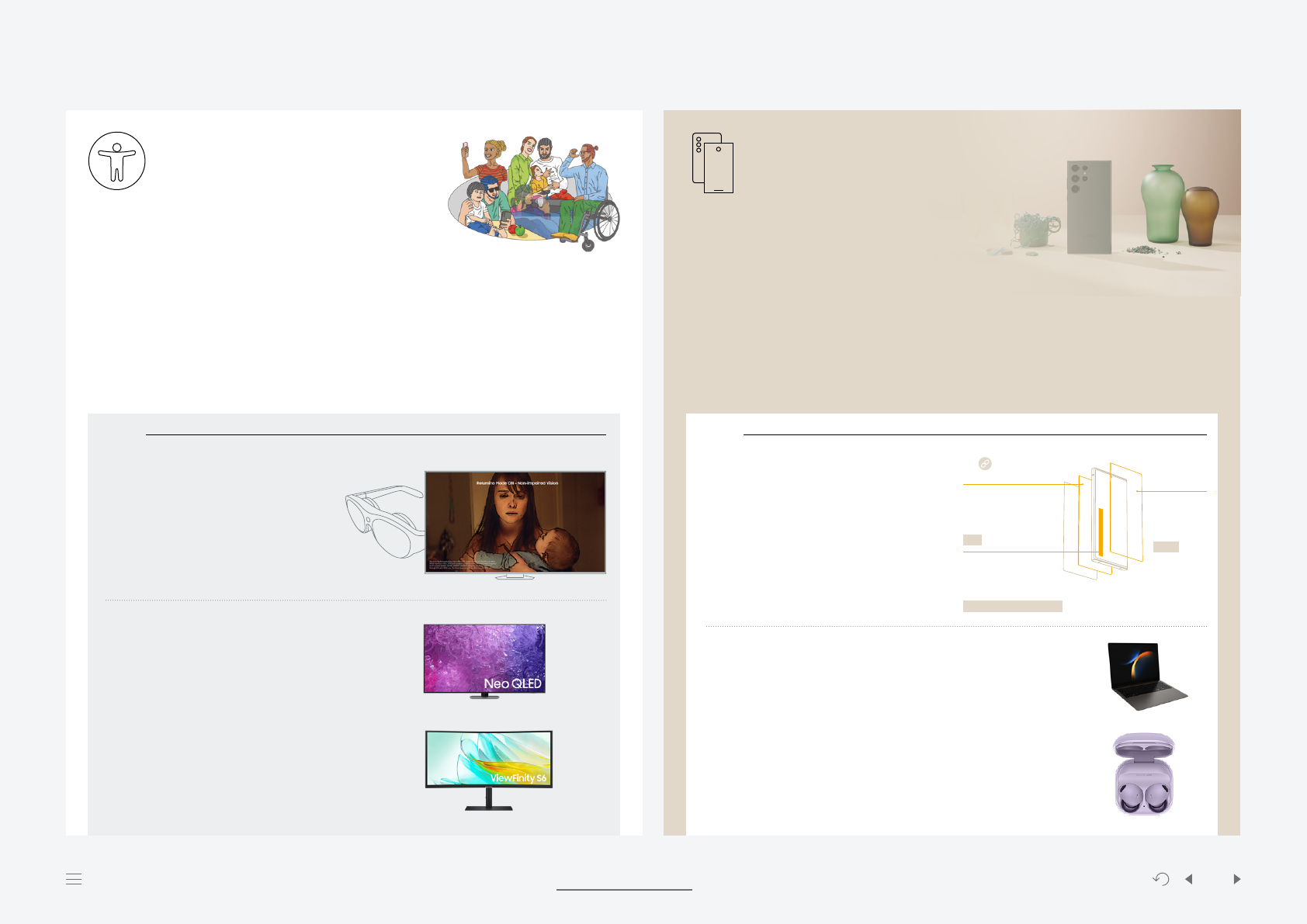
Our Company AppendixApproach to Sustainability Facts & Figures PrinciplePlanet
10
People
Samsung Electronics Sustainability Report 2023
Highlights of Product Sustainability
Accessibility Recycled and Recyclable Materials
We strive to design products that are accessible for people with disabilities. We offer visual, auditory,
cognitive, and motion accessibility features such as the Relumino mode (a quality correction mode for
people with low vision), the SeeColors mode for people with color weakness, sign language guidance,
and TalkBack.
We develop recycled and recyclable materials in collaboration with various partners and apply these
materials in our products. We ensure that product quality is maintained while striving to minimize their
environmental impact.
Relumino Mode
Galaxy S23 Series: Designed with the Planet in Mind
Outlining objects, enhancing contrast, and
adjusting brightness, color, and sharpness
to highlight content for people with low
vision
In the Galaxy S23 series, we incorporated
recycled materials in more device components
than in any other previous Galaxy smartphone.
Back Glass Deco Film
80
%
Recycled
S pen inner cover
20
%
Recycled
Front Screen
22
%
Recycled
Story Story
PET
Ocean-Bound Plastic
Glass
Neo QLED TV (QN90C)
· Relumino mode for low-vision users
· Improved vision accessibility (e.g., magnification,
high contrast display, SeeColors mode)
· Hearing accessibility features (e.g., auto caption position,
sign language guide)
· Slow Button Repeat
ViewFinity S6 Monitor (S65UC)
· SeeColors mode for people with color vision deficiency
· High Contrast, black and white, color inversion
Galaxy Book3 Ultra
· Plastic recycled from discarded fishing nets applied to the bottom inner case
· Plastic recycled from discarded water bottles applied to the rear inner case
and cover foot
· Display that attained UL’s Greenguard gold certification
Galaxy Buds2 Pro
· Plastic recycled from discarded fishing nets applied to the battery bracket, cradle
PCB bracket, and protective brackets for the interior parts
· Plastic recycled from discarded water bottles applied to the lid, interior of the lid, base,
and interior parts of the cradle case, as well as the front and back covers of the earbuds
· Expanded use of recycled paper in packaging
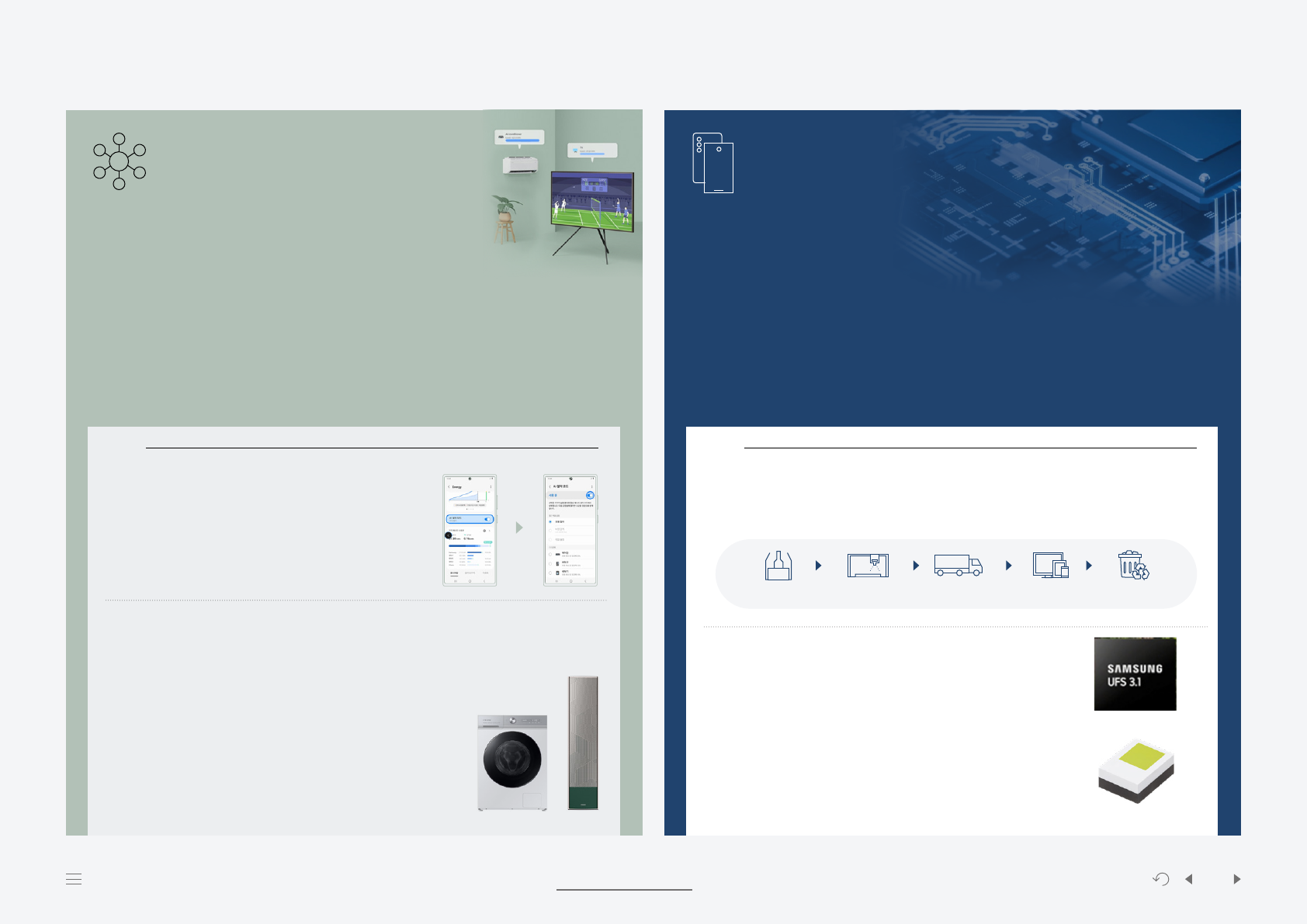
Story
Carbon Footprint
In 2019, we obtained the industry’s first Carbon Footprint certification from the Carbon Trust for the
Universal Flash Storage (UFS). Since then, we have been Carbon-Footprint certified across a wide
range of products – including eight in DRAM/SSD/memory card (2020), four in system semiconductor
and twenty in DRAM/SSD/memory card (2021), four in system semiconductor, and 15 in DRAM/SSD/
memory card (2022). Moreover, we achieved Carbon Reduction certifications for one UFS (2020) and
five DRAM/SSD/UFS/memory card (2021).
Reducing carbon emissions throughout the product life cycle
Our Carbon Footprint-certified products reduce carbon emission by approximately 680,000
tonnes.
Vehicle Headlamp Solution (C-Series Gen3)
· Industry’s first to obtain Carbon Footprint certification by Underwriters
Laboratories (UL)
· Reduced vehicle energy consumption, improved fuel efficiency,
and reduced carbon emissions
· Best-in-industry lamp efficiency with vehicle energy consumption
reduced by over 10%
UFS 3.1(512GB)
· Recognized with the industry’s first ‘Reducing CO
2
’ label by Carbon Trust
· Carbon Footprint certification by Carbon Trust
Our Company AppendixApproach to Sustainability Facts & Figures PrinciplePlanet
11
People
Samsung Electronics Sustainability Report 2023
Highlights of Product Sustainability
Sourcing Use Recycling∙DisposalDistribution Production
Story
Energy Efficiency
Our latest products outperform their predecessors in terms of energy efficiency, exceeding the first
grade energy efficiency rating by the Korean government. The Bespoke Grande AI washer (25kg) and
Bespoke Wind-Free Air Conditioner both exceed this rating by 20% and 10%, respectively.
1)
By using the SmartThings AI Energy Mode, energy consumption of washers, air conditioners, and dryers
can be further enhanced by up to 60%, 20%, and 35%, respectively.
2)
1) Applicable models: washers (including WF25CB8895BW) and air conditioners (including AF17CX936AFN)
2) Test models: washer (WF25B9600**), air conditioner (AF25BX934WAR), and dryer (DV20B9760ME)
SmartThings Energy
SmartThings Energy recommends ways
for you to be more energy efficient and
lets you easily monitor and manage the
energy usage.
Bespoke Grande AI Washer
· Obtained first grade energy efficiency rating by the Korean government
· Using SmartThings AI Energy Mode reduces energy consumption by up to 60%
1)
1) Test model: WF25B9600**
Bespoke Wind-Free Air Conditioner
1)
· First grade energy efficiency rating by the Korean government
· SmartThings AI Energy Mode for energy consumption reduction by up to 20%
2)
1) Applicable models: AF17CX936AFR, AF18BX836NFR, AF20BX936SFR,
AF23BX939VSR, F25BX934WAR
2) Test model: AF25BX934WAR

Our Company AppendixApproach to Sustainability Facts & Figures PrinciplePlanet
12
People
Samsung Electronics Sustainability Report 2023
Highlights of Product Sustainability
Profilers
The AMIGO solutions is equipped
with profilers that collect CPU, GPU,
MIF, FPS, DTM data.
DVFS Drivers
When an IP is identified, the main
controller changes the frequency of the
selected IP using the DVFS (Dynamic
Voltage & Frequency Scaling) driver.
Main Controller
The main controller analyzes the collected
data and determines which IPs to raise or
suppress in order to achieve the target FPS
or reduce power.
Main Profiler
It collects the active ratio, frequency,
and temperature of each IP as well as
the frames-per-second (FPS) and screen
refresh rate.
Brains of a smartphone with eyes on a better life
The Exynos mobile processor has an integrated form of various features that reduces the
space and costs of parts and enhances their respective energy efficiency compared to that of
individual parts.
Story
Mobile AP
1)
(Exynos 2200)
Optimizing energy efficiency through AMIGO solution
Integrated premium single SoC
2)
for 5G modem
Enhanced computing core (CPU
3)
, GPU
4)
, NPU
5)
)
1) Application Processor
2) System on Chip
3) Central Processing Unit
4) Graphic Processing Unit
5) Neural Processing Unit
Low-Power Processor
Samsung Exynos Processor is integrated with a variety of functions, including the CPU, GPU, Multi-
format Codec (MFC), Image Signal Processor (ISP), Display, and Security — along with an NPU and
Digital Signal Processor (DSP) for AI in addition to the 5G modem. Furthermore, our proprietary
Advanced Multi-IP Governor (AMIGO) solution dramatically reduces battery consumption.
Story
DDR5 SSD
Energy
saved
7
TWh per year
Low-Power Memory
In the future, the storage and processing of data will likely require more energy compared to energy
required for generating data
1)
.
Therefore, we offer high-performing, power-efficient, and secure solutions tailored to the needs of
data centers. These industry-leading solutions facilitate the reduction of power use and operational
costs at data centers.
1) According to IDC IGIS, a market research agency, an estimated 175ZB of data is projected to accumulate in 2025.
Power savings of Samsung SSD and DDR5
If we replace the world's Hard Disk Drives (HDDs)
with Samsung Solid State Drives (SSDs) and
Dynamic Random-Access Memory (DRAM) of
servers with Samsung Double Data Rate 5 (DDR5)
DRAMs, approximately 7TWh of energy can be
saved per year.
Mobile DRAM(LPDDR5X)
· Power consumption reduced by nearly 20% compared to the
previous products
· Ultra-high 8.5 Gbps data processing speed is 1.3 times faster
compared with previous LPDDR5 models of 6.4Gbps
DDR5 DRAM(12 nanometer)
· Productivity and low-power feature enhanced, compared to previous
DRAM (14 nanometer)
· Optimized for next-generation computing with productivity and power
efficiency enhanced by 20% and 23%, respectively
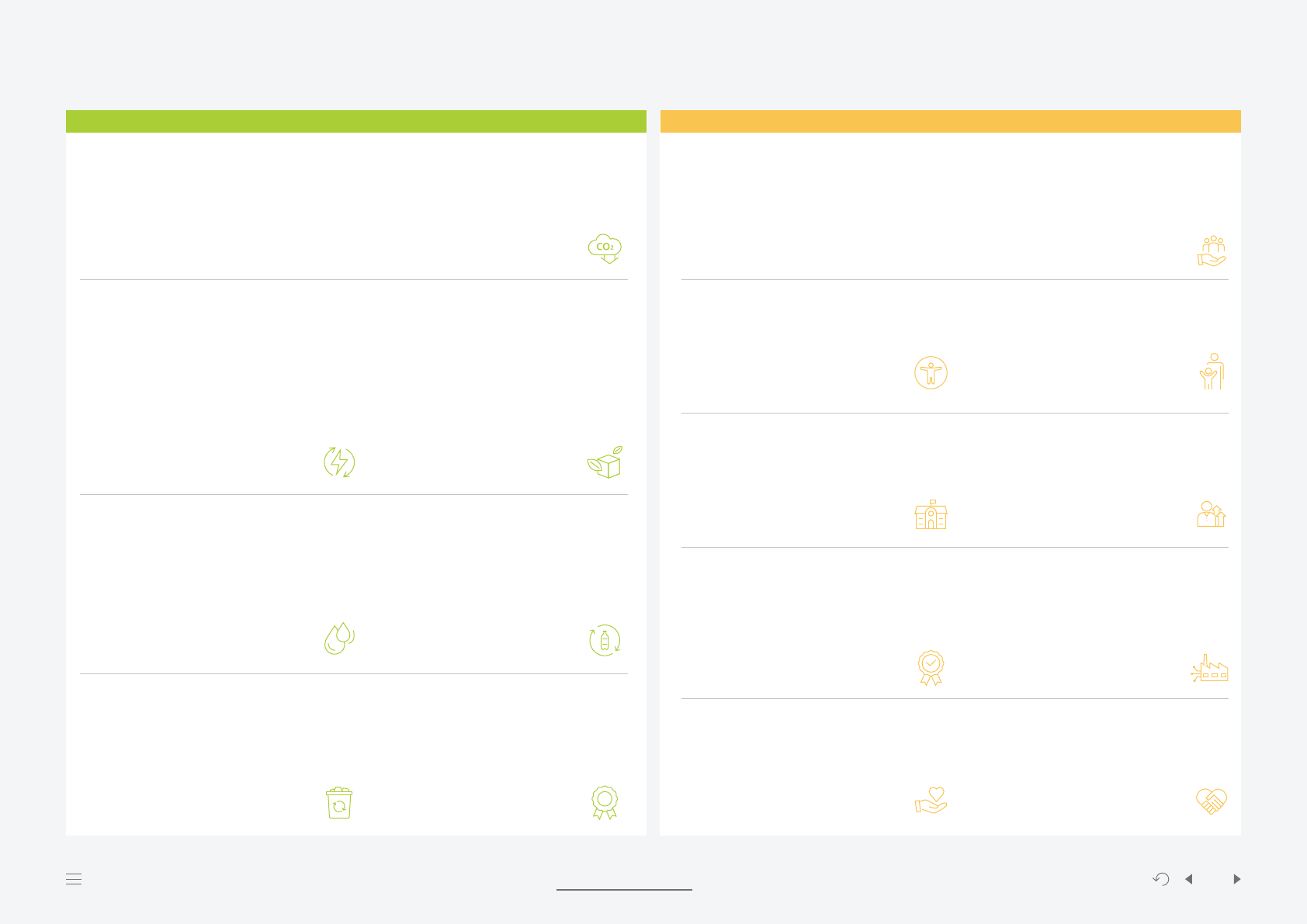
Our Company AppendixApproach to Sustainability Facts & Figures PrinciplePlanet
13
People
Samsung Electronics Sustainability Report 2023
Sustainability Achievements
Planet People
GHG Emissions Reduction Relative to BAU (Scopes 1 and 2)
10.16
million tonnes CO
2
e
*59% increase compared to 2021
Transition to Renewable Energy
31
%
* 11%p increase compared to 2021
** Transition complete at all DX business sites in Korea
and manufacturing sites in Brazil, India, and Vietnam
GHG Emissions Reduction in the Product Use Phase
914,000
tonnes CO
2
e
* 13 product categories in 2022 (refrigerator, air conditioner,
washer, dryer, microwave oven, vacuum cleaner, TV, monitor,
PC, HHP, tablet, wearable, and base station)
** Compared to BAU (baseline year: 2021)
Water Reuse
116.59
million tonnes
*29% increase compared to 2021
Use of Plastic with Recycled Resin
98,826
tonnes
* 200% increase compared to 2021
** Cumulative amount from 2009 to 2022
409,000 tonnes
E-Waste Collected
600,502
tonnes
* 9% increase compared to 2021
** Cumulative amount from 2009 to
2022 5.69 million tonnes
Zero Waste-to-Landfill Mark (Platinum)
12
business sites
WBA
1)
Corporate Human Rights Benchmark in 2022
Ranked
2
nd
(among ICT manufacturers)
1) World Benchmarking Alliance
Suppliers Rated as Outstanding
62.1
%
* Based on results of the annual comprehensive
supplier evaluation
Smart Factory Project Beneficiaries
277
companies
* A total of 3,087 companies from 2015 to 2022
WBA Digital Inclusion Benchmark in 2022
Ranked
7
th
Employee Training Sessions
9.14
million sessions
Employee Volunteering
1.02
million hours
* A total of 10.97 million hours from 2012 to 2022
CSR Program Beneficiaries
660,761
individuals
*A total of 22.77 million individuals from 2012 to 2022
GCF
1)
Children’s Rights Benchmark in 2022
Leader
(highest rank)
1) Global Child Forum
Launching of The UniverSE
1)
3
academies &
11
schools
1) The University of Samsung Electronics

Our Company AppendixApproach to Sustainability Facts & Figures Principle
Planet
14
People
Samsung Electronics Sustainability Report 2023
Planet
15
New Environmental Strategy
20
Climate Action
25
Circular Economy
30
Clean Tech Ecosystem
32
Sustainability in Operations
Our Company AppendixApproach to Sustainability Facts & Figures Principle
Planet
14
People
Samsung Electronics Sustainability Report 2023

Our Company AppendixApproach to Sustainability Facts & Figures Principle
Planet
15
People
Samsung Electronics Sustainability Report 2023
New Environmental Strategy
Samsung Electronics announced the New Environmental Strategy
in September 2022 with the aim of addressing global environmental
issues through our innovative technologies. This paradigm shift is
essential for our sustainable growth and will serve as an important
momentum to reinforce our competitiveness.
The New Environmental Strategy was developed based on our
commitment to achieve net zero by 2050 joining the world’s drive to
combat climate change; maximize resource circularity to advance
towards a circular economy; and continuously address environmental
challenges through technological innovation. This effort is expected to
bring positive change to the broader ecosystem of the ICT (information
and communications technology) industry as we engage in the
manufacturing and supply of an extensive range of products and
services.
We plan to invest over KRW 7 trillion* by 2030 in environmental
management activities (including semiconductor process gas
reduction, e-waste collection and recycling, water resource
preservation, and pollutant minimization) by 2030 and transparently
disclose the progress and results of the implementation of the
Strategy regularly via our Sustainability Report and Website.
*Excluding renewable energy purchasing costs
Achieving Net Zero by 2050
We are a vertically integrated ICT manufacturer involved in all
electronics sectors from semiconductors to smartphones, TVs, and
home appliances. As a company of vast scale responsible for the
supply of an extensive range of products and services, we are faced
with significant obstacles in meeting our net zero targets including
the transition to renewable energy. However, we have taken up the
challenge to contribute to resolving one of the most pressing issues
threatening humanity: climate change.
We plan to achieve net zero in Scopes 1 and 2 by 2050. Net zero will
be achieved first by the DX Division by 2030, followed by the company
level including the DS Division by 2050 or sooner.
Reducing Scope 1 Emissions through Technological Innovation
We are concentrating our resources on carbon emissions reduction
technologies that reduce Scope 1 emissions generated from our
operations. Direct carbon emissions from our operational sites are mostly
process gases from the semiconductor manufacturing process and
emissions from the use of fossil fuels such as LNG(Liquefied Natural Gas).
We plan to develop new technologies for improving process gas treatment
efficiency by 2030 and expand carbon emissions reduction facilities across
all of our manufacturing lines. In order to reduce the use of LNG-fueled
boilers, we will seek ways to utilize waste heat and introduce electric heat
sources. Moreover, we will switch all corporate vehicles – approximately
1,500 – to electric vehicles by 2027.
Joining RE100 for Scope 2 Emissions Reduction
We joined the RE100 initiative to reduce our Scope 2 emissions (indirect
carbon emissions from power consumption) and achieve the transition to
renewable energy for our electricity use by 2050. Despite the challenge of
being a large energy user with limited renewable energy supply – especially
in Korea – we are committed to transitioning to renewable energy by 2050.
We will first complete energy transition at all of our global operations sites by
2027 (Central and South America by 2025; and Southeast Asia, CIS member
states, and Africa by 2027). For our sites in the US, China, Europe, Vietnam,
India, and Brazil that have already reached this goal, we plan to expand direct
power purchase agreements (PPAs) centering on the regions equipped with
active renewable energy policies and systems.
Strengthening Stakeholder Collaboration
We are actively collaborating with various stakeholders, including industry
peers and civil society organizations, to increase the supply of renewable
energy. As part of this effort, we joined the Asia Clean Energy Coalition (ACEC)
as a founding member during the 27
th
Conference of the Parties (COP27) of
the UN Framework on Climate Change (UNFCCC). We are participating as a
member of the steering committee as well as country-working groups to
facilitate the supply of renewable energy in the region. Moreover, we joined
the Semiconductor Climate Consortium (SCC) as a founding member in
November 2022 and have been appointed as a governing council member
in January 2023. In this capacity, we aim to play an active role in collectively
addressing the climate challenges as an industry, including ways to facilitate
GHG emissions reduction through effective target and roadmap setting and
standardization.
In September 2022, we released our mid-to-long-term
environmental management strategy which specifies
our goals and action plans based on a vision that
the Environment is Our Future.
New Environmental
Strategy

Our Company AppendixApproach to Sustainability Facts & Figures Principle
Planet
16
People
Samsung Electronics Sustainability Report 2023
Ultra-Power-Saving Technology and Resource Recycling
We focus on developing ultra-power-saving technology to enhance the
energy efficiency of our products and reduce carbon emissions in the
product use phase.
We plan to secure ultra-low-power semiconductor technology
to drastically reduce the power consumption of memory used in
data centers and mobile devices by 2025. By breaking down the
semiconductor manufacturing processes and developing low-power
design technology, we will be able to reduce the power consumption
of IT products and data centers resulting in mitigating GHG emissions,
while rolling out products of the same performance using less
resources.
We also plan to apply the technology to the leading models of seven
major product categories (smartphone, TV, refrigerator, washer, air
conditioner, PC, and monitor) to improve power consumption by an
average of 30% by 2030 compared to that of models of equivalent
performance in 2019. To this end, we will apply high-efficiency parts
(compressors, heat exchangers, and semiconductors) and improve
energy efficiency in product algorithms through the introduction of
SmartThings AI Energy Mode.
Strengthening Scope 3 Emissions Management
In 2022 we launched a task force to facilitate emissions reductions of
Scope 3 emissions. In 2022, we improved the calculation methods for
applicable categories under Scope 3 and completed the third-party
audit on our calculation methods and measured emissions by the
Korean Foundation for Quality. We plan to continue to advance the
calculation methods to ensure accuracy in assessing our emissions.
Our Scope 3 emissions are verified by outside experts and are disclosed
to the public via our Sustainability Report and the CDP (Carbon
Disclosure Project) platform. We are also working to establish mid-
to-long-term targets and develop specific tasks across diverse areas
from supply chains to resource circularity and logistics. In this context,
we introduced 22 sustainability management courses (including GHG
emissions reduction, supply chain due diligence, fair trade) at our
Partner Collaboration Academy in Q4 of 2022 to help our suppliers
improve their understanding of relevant issues, while also offering
consulting services through our dedicated organizational unit to
improve their capacity for GHG management and emissions reduction.
Maximizing Resource Circularity across the Entire Product Life Cycle
We are undertaking a project to maximize resource circularity across
the life cycle of our products - from material sourcing and production
to disposal and recycling. We aim to complete the resource circularity
loop of producing electronics with recycled materials, collecting end-
of-life and discarded products, recovering resources, and applying the
recovered resources to new products.
Expanding the Application of Recycled Resin
We are expanding the use of recycled resin in plastic parts used in our
products. By 2030, recycled resin will be applied to 50% of our plastics
parts; by 2050, it will be applied to all of our plastic parts. We are also
expanding the use of plastic recycled from discarded fishing nets.
We established the Circular Economy Lab dedicated to developing
material recycling technology and applying recycled materials to our
products. The Lab aims to replace key materials used in our products
with more environmentally responsible materials through activities such
as recycled material development and research on recovering resources
from waste.
Recycling Discarded Batteries and Expanding E-Waste Collection
To address the e-waste problem that is threatening the environment, we
plan to expand our e-waste collection programs to all countries where we
operate (over 180) by 2030 from the current approximately 50 countries.
We plan to increase the cumulative amount of e-waste collected from
2009 to the industry’s largest amount of 10 million tonnes by 2030 and
25 million tonnes by 2050. We also plan to set up a system for recovering
and recycling minerals from collected waste batteries by 2030.
Addressing Environmental Challenges through
Technological Innovation
We will continue to mobilize our innovative technologies to address
environmental challenges. In particular, we will focus our resources on
developing carbon capture and utilization technology as well as fine
dust pollution mitigation technology.
Restoring Air and Water to Their Natural State Prior to Discharge
The DS Division aims to minimize the discharge of air and water
pollutants generated during the semiconductor production process
by developing and applying advanced treatment technologies. By 2040
the DS Division plans to treat air and water to their natural state with
minimal environmental impact prior to their discharge. By applying
advanced treatment technologies, we are treating effluent to the level of
upper stream water quality and emissions to the level of air quality.
Contributing to Mitigating Carbon Emissions and Fine Dust Pollution
In order to develop and commercialize carbon capture and utilization
technology for storing and recycling carbon emitted from our
semiconductor production sites, we established the industry’s first
Carbon Capture Research Institute (currently renamed as Air Science
Research Center) within Samsung Advanced Institute of Technology
(SAIT) in September 2021.
We plan to apply carbon capture technology to our semiconductor
production facilities from 2030 and expand its application company-
wide and to our supply chain. We expect that our carbon capture and
utilization technology will help the semiconductor industry effectively
address its main source of carbon emissions and improve the industry’s
overall sustainability.
In 2019, we established the Particulate Matter Research Institute
(currently Air Science Research Center) dedicated to developing
advanced filters and original technologies for air purification systems
to improve fine dust detection, analysis, and removal. We are in the
process of developing a ceramic catalyst filter that can be reused
after washing and which can simultaneously remove fine particles
and gases. From 2023, we will distribute the filter to our suppliers and
Samsung affiliates.
Technologies Contributing to a Circular Economy
We established the Circular Economy Lab, which specializes in research
on material recycling process and technology, and the application
of recycled materials to products to maximize resource circularity.
Through the Lab, we have collaborated with various research
institutions and corporations to research material recycling and waste-
to-resource technologies with the aim of ultimately manufacturing all
of our products with recyclable materials.
Monitoring Progress and Disclosing Information
In order to ensure the effective implementation of the New
Environmental Strategy including our net zero targets, we established
detailed implementation roadmaps for individual projects and regularly
monitor their latest developments through the Environmental
Management Task Force. All related data will be disclosed via our
Sustainability Website and official reports. Our climate change
response strategy and detailed information about GHG emissions will
continue to be shared via CDP.
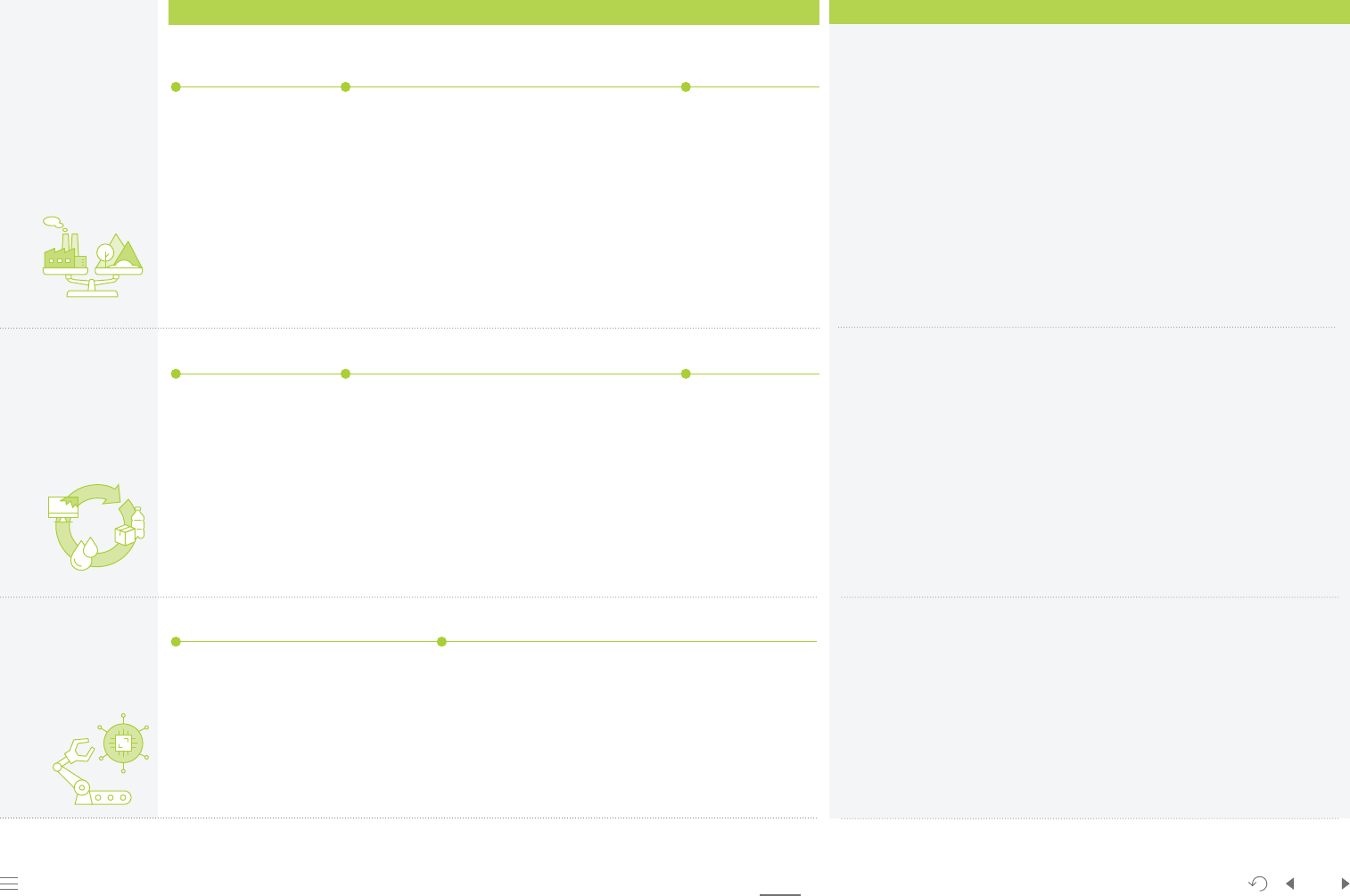
Our Company AppendixApproach to Sustainability Facts & Figures Principle
Planet
17
People
Samsung Electronics Sustainability Report 2023
Resource circularity
New Environmental Strategy Targets and Performance in 2022
* Smartphone, TV, refrigerator, washer, air conditioner,
PC, and monitor
** Compared to 2019
Addressing environmental issues through technological innovation
· Integration of Carbon Capture Research Institute and Particulate Matter Research Institute
into SAIT’s Air Science Research Center (ASRC)
· Currently conducting R&D projects in high-efficiency CCU technology and applying
advanced fine dust removal and air purification systems at our business sites, bus terminals,
and underground parking lots, among others.
· Establishment of Circular Economy Lab specializing in development and application
of material recycling technologies
Environmental Targets
Progress in 2022
2027
2025
2030
2030
2030
2040
2050
2050
· Achieve 100% transition
to renewable energy at our
global business sites and DX
business sites
· Replace all corporate
vehicles with EVs
· Attain Zero Waste-to-
Landfill certifications at all
of our business sites
· Apply carbon capture technology to
semiconductor production sites and expand
its application company-wide and in our
supply chain
· Develop and utilize fine dust pollution
reduction technology for local communities
from 2030
· Develop ultra-power-saving products and improving
power consumption of major models in seven product
categories* by 30%**
· Achieve net zero for DX
· Apply recycled resin to 50% of plastic parts used in our
products*
· Restore quality of 100% of water consumed by DX
· Expand e-waste collection system to all countries where we
operate and collect the industry’s largest cumulative amount
of e-waste of 10 million tonnes cumulatively since 2009
* Ratio of recycled content varies by plastic parts
· Remove pollutants generated during the semiconductor
production process and restore used water to its natural state*
with minimal environmental impact prior to discharge (DS)
· Net zero at all of our
global business sites
· Apply recycled resin to
all plastic parts*
· Collect 25 million
tonnes of e-waste
cumulatively
* Treating effluent to the level of upper stream water and emissions
to clean air quality meeting the national standards
Use of Recycled and Recyclable Materials
GHG Emissions Reduction
Net Zero
Technological
Innovation
·
10.16
million tonnes of COe reduced (Scopes 1 and 2) compared to BAU, a 59%
YoY increase in reduction amount
·
8,704
GWh of renewable energy consumed globally reaching a transition rate of
31
%
· Product energy use efficiency improved by
16
% compared to 2019 through applying high
energy efficiency technology to leading models of seven major product categories
· Transition to 100% renewable energy achieved at the DX Division’s business sites in Korea,
Vietnam, India, and Brazil.
· Partnership agreements for securing and expanding the use of renewable energy signed
with Jeju Energy Corporation, Korea South-East Power, and Korea Southern Power in
November 2022
·
98,826
tonnes of plastic with recycled resin used achieving an utilization rate of
14
%
·
600,502
tonnes of e-waste collected as of 2022 (Cumulative amount from 2009
to 2022 5.69 million tonnes)
· Highest grade in Zero Waste-to-Landfill certification attained for five of DX Division’s global
business sites and seven of DS Division’s global business sites
· Partnership agreements to promote the use of treated wastewater signed with Korea's
Ministry of Environment and relevant local governments in November 2022 (DS Division)
· Partnership agreement signed with Korea Rural Community Corporation dedicated to water
resource management in December 2022 (DX Division)

Our Company AppendixApproach to Sustainability Facts & Figures Principle
Planet
18
People
Samsung Electronics Sustainability Report 2023
Environmental Management Governance
We consider environmental issues including climate change as
factors that directly influence our business operations and financial
performance. These issues are overseen by the Board of Directors, our
highest decision-making body.
The Board of Directors approves all strategies and goals related to
environmental management, oversees their latest developments, and
regularly reviews our relevant activities through the Sustainability
Committee comprised of independent directors. Our corporate
environmental strategy encompassing mid-to-long-term climate
actions and resource circularity goals was passed by the Sustainability
Committee in September 2022.
The CEO has the responsibility and authority for establishing
environmental strategies, determining implementation tasks
and approving investments, among others. The CEO establishes
environmental management plans and reviews implementation
progress through a corporate consultative body comprising the top
executives of relevant units.
Corporate Consultative Body for Environmental Management
Responsible for supervising and
monitoring our climate actions,
GHG emissions status, and GHG
emissions reduction efforts.
EHS Council
Establishes environmentally
responsible product
development strategies.
Eco-Council
Sustainability Committee
Under the Board of Directors and fully comprised of independent
directors. Responsible for setting company-wide environmental
strategies and goals and overseeing related outcomes
Regularly held under the leadership of the CEO.
Responsible for reviewing the implementation status of
company-wide environmental management tasks and identifying
new challenges. Executives of all organizational units involved in
the environmental strategy participate in the discussion and
decision-making process on environmental issues.
Sustainability Council
Responsible for reviewing the implementation status of company-
wide environmental strategy tasks and updating them. Executives
of all organizational units involved in the environmental strategy
participate in the discussion and decision-making process on
environmental issues.
Environmental Management Task Force
Environmental Management System
We adopted the global standards for environmental management and
energy management systems and maintained ISO 14001 and ISO 50001
for all of our business sites as of 2022. We continue to reinforce our
environmental management capacity by strengthening environmental
indicators (GHG emissions reduction, environmentally responsible
material use, e-waste collection, energy efficiency improvement,
among others) in the performance evaluations of our business units.
To strengthen our employees’ awareness of environmental management
and effectively prevent relevant risks and accidents, we mandate that
our employees receive mandatory environment training as well as a
separate job-specific specialized training at least once a year.
Environmental Risk Management
Environmental risks and opportunities influence not only products
and services but also the manufacturing processes, supply chains,
R&D, and sales activities. We continually monitor risks at all of our
global business sites pursuant to our risk management manuals for
individual sectors, from environment and safety to climate change,
energy, and compliance. Our environment and safety guidelines and
policies are disclosed on our sustainability website. We are also taking
various initiatives to develop products with high energy efficiency, and
to reduce GHG emissions at our production sites, as well as minimize
waste to landfill, and preserve water resources.
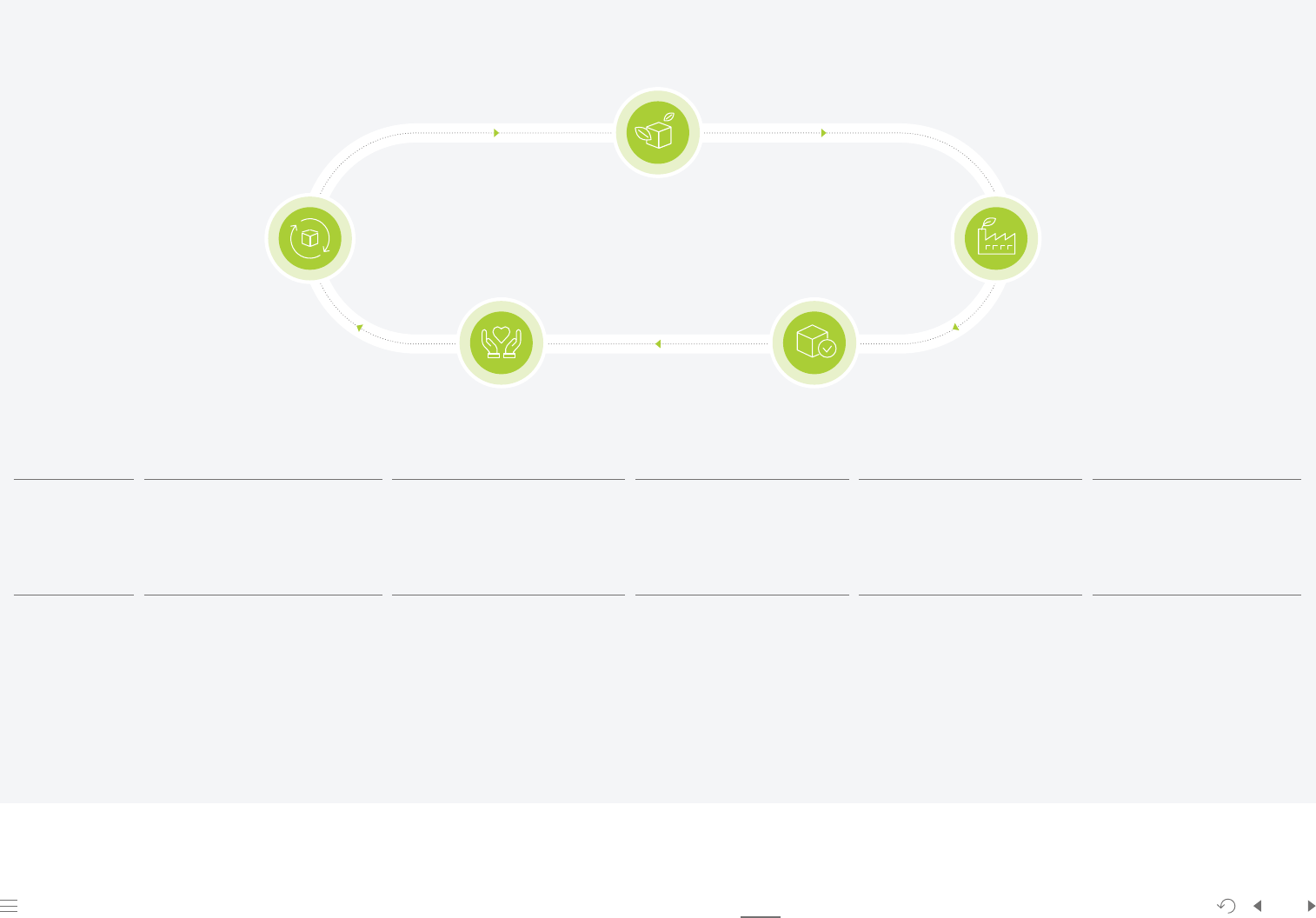
Our Company AppendixApproach to Sustainability Facts & Figures Principle
Planet
19
People
Samsung Electronics Sustainability Report 2023
Environmental Management Activities in Different Stages of the Value Chain
· Helping suppliers reduce GHG emissions and
expand the use of renewable energy
· Purchasing materials and parts with less
impact on the environment
· Operating the Eco-Partner Certification
Program
Materials
· Expanding the use of renewable energy and
reducing GHG emissions throughout the
manufacturing process
· Developing power-saving products
· Extending product life cycle and expanding
the use of recycled and recyclable materials
· Minimizing waste generation and expanding
the utilization of waste as resources
· Developing alternatives for chemicals
and designing products that can be easily
disassembled and recycled
Production
· Reducing fuel consumption and
GHG emissions through logistics
optimization
· Using recycled and recyclable packaging
materials
· Decreasing the volume and weight of
packaging
Distribution
· Reducing indirect GHG emissions through
product uses with high energy efficiency
· Improving product performance
· Upgrading firmware and extending
warranty periods
· Expanding global repair and service
centers
Use
· Monitoring GHG emissions in
the disposal stage
· Operating e-waste collection programs
in different countries
· Recovering and recycling resources
from e-waste
Recycling
Climate Action
Resource Circularity
Materials
Recycling
Use Distribution
Production
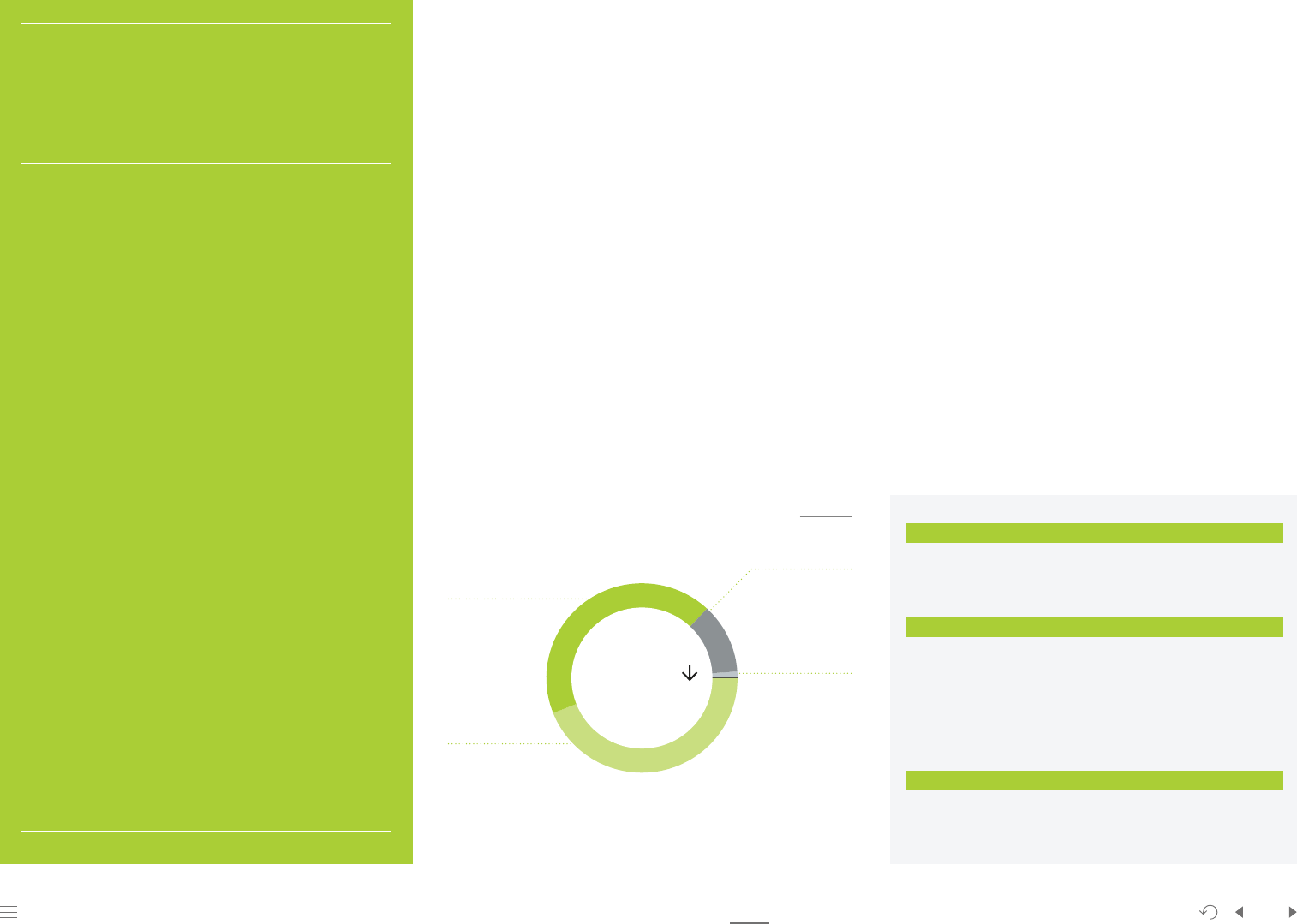
Our Company AppendixApproach to Sustainability Facts & Figures Principle
Planet
20
People
Samsung Electronics Sustainability Report 2023
Analysis of Climate Risks and Opportunities
We identify the financial and strategic impacts of climate change-related
risks, then establish response measures based on each risk’s magnitude,
and make decisions accordingly. Climate change-related risks include
global climate regimes, region-specific regulatory reinforcement, market
changes, stakeholders’ requests, and changes in physical environments.
Potential risks identified for the short term are an increase in investment
amount due to rising carbon credit prices and high-efficiency technology
development, investment in extreme weather response, and an increase in
restoration expenses, Meanwhile opportunities include an easing of carbon
credit price sensitivity due to the carbon credits acquisitions from various
sources and a reduction in energy expenses driven by development of high-
energy-efficiency technology. Changes in consumption patterns - driven
by increasing preference for environmentally responsible products - and
expanded renewable energy use are projected as mid-term opportunities,
while temperature increases and water resource depletion are identified
as long-term risks. As for long-term risks, we establish response measures
in line with Nationally Determined Contributions based on the Paris
Agreement and the Representative Concentration Pathways adopted by the
Intergovernmental Panel on Climate Change (IPCC) as well as the energy
technology outlooks by the International Energy Agency (IEA).
Our Response to Climate Change
Climate change is one of the most critical issues faced by humanity
and one of the most important considerations for any business
activity. In this context, we are expanding our use of renewable energy,
reducing process gases, and reinforcing process energy efficiency.
GHG emissions directly generated from our business sites and GHG
emissions generated due to our operations outside of our business sites
are both subject to our mitigation efforts. We are also moving forward
with various GHG emissions reduction projects across our entire value
chain from product development to manufacturing and logistics.
GHG Emissions Management
We continuously monitor GHG emissions generated from our global
business sites. Each site is required to enter GHG emissions data (e.g.,
power, fuel, semiconductor process gases) into the EHS system. Based
on the data, individual sites analyze the latest trends and the causes of
per-unit increases or decreases on a monthly basis. The relevant unit
in the company manages the integrated GHG emissions data globally
and verifies the credibility and accuracy of the data through the annual
third-party audit.
Results of 474 GHG emissions reduction projects
GHG Emissions Reduction Compared to BAU (Scopes 1 and 2)
Renewable energy
use expansion
47%
Process gases*
reduction 41%
* Resulting from both reduced use
as well as treatment of gases
Manufacturing
process efficiency
improvement
10%
Equipment
operation
efficiency
improvement
2%
Others
0.1%
A total of
10.16
million tonens CO
2
e
Climate Risk Management Process
Identify and assess risks
Risks in business operation, product planning, and external developments are
identified and assessed regularly by our relevant organizational units including
EHS, marketing, sales, and compliance, based on environmental management
systems (e.g., ISO 14001, ISO 50001).
Incorporate risks into the corporate risk management process
Risks related to individual countries’ climate change regulations are managed
in an integrated manner through the company-wide risk management system.
Risks include region-specific regulations and market changes that may affect our
business operations and reputation.
Manage risks and opportunities
Organizational units in charge of EHS monitor energy consumption,
GHG emissions, renewable energy use, and climate impacts
Issues related to our global business sites are discussed and managed by
consultative bodies such as the EHS Council.
Climate risks and opportunities are discussed and identified by the
Sustainability Council.
Business opportunities are discussed by the Eco-Council and operationalized by
our relevant organizational units.
As a global ICT manufacturer involved in a wide
range of electronics products and components from
semiconductors to smartphones, TVs, and home
appliances, we are taking climate action to work
towards achieving net zero.
Climate
Action
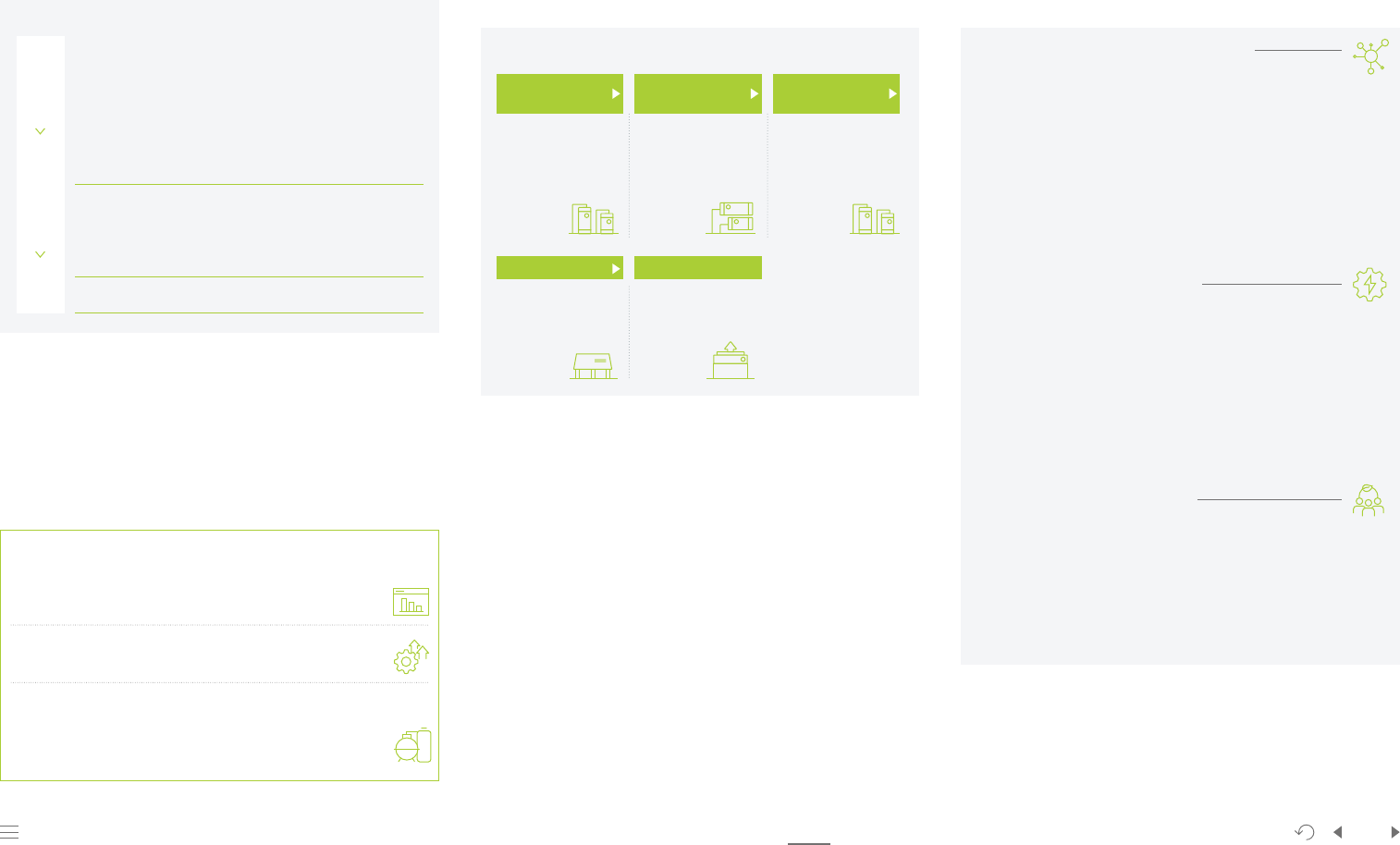
Our Company AppendixApproach to Sustainability Facts & Figures Principle
Planet
21
People
Samsung Electronics Sustainability Report 2023
Carbon Reduction Committee establishes GHG emissions
reduction projects for semiconductor production sites and
monitors performance on a quarterly basis
Implementation of GHG emissions reduction projects including
improving efficiency of process gas treatment facilities,
switching to high-efficiency equipment, and improving
manufacturing process efficiency
Achieve net zero for the DX Division
Improving efficiency of process gas treatment efficiency and
expand processing facilities
Reduce boiler use by recovering waste heat
Achieve net zero across all of our business and production sites
2030
Direct GHG Emissions Reduction Roadmap
Present
2050
RCS Treatment Process
Pre-treatment
scrubber
Treatment of high-
concentration
corrosive gases
RCS equipment
Catalytic
decomposition of
pre-treated gases
Post-treatment
scrubber
Post-treatment of
hydrogen fluoride
PFC scrubber
Retreatment of
decomposed residual
gases
Acid scrubber
Treatment of final
residual gases and
odor
Applying IoT Technology to Business Sites
IoT- and AI-based air conditioning solution
Analysis of operating data of the central air conditioning system
Setting automatic control for optimal efficiency
Automatic adjustments by AI algorithms
Application to our business sites in Korea, Vietnam, and North America
Average energy savings of 11-14% per year
Planned to be applied to our business sites in Europe, Southwest Asia,
and Central and South America
Reviewing potential application at our major suppliers
Improving Operational Efficiency
LNG use reduction
Recovering waste heat through coolant system and heat exchanger
Adjusting the air temperature and flow of the outdoor air control unit
Reduction of power consumption in the semiconductor manufacturing
process
Reducing equipment testing time through process optimization
Temperature management of supplementary equipment
Applying high-efficiency equipment and neutralizing wet scrubbers
Engaging Employees in Everyday
Energy Saving Activities
Encouraging employees at our global manufacturing sites to
take part in energy-saving activities
Monitoring energy consumption
Switching off equipment when not in use
Energy-saving activity patrols
Reduction of Direct GHG Emissions
We are committed to reducing direct carbon emissions even as
semiconductor production increases through solutions based on our
innovative and new technologies that improve the efficiency of process
gas treatment.
Regenerative Catalytic System (RCS)
RCS is an integrated large-capacity greenhouse gas treatment facility
developed by Samsung – the first of its kind in the semiconductor
industry. The facility outlets are linked to the rooftop where the process
gas are treated with catalysts at a low temperature. By doing so, less fuel
is consumed and fewer air pollutants are emitted in the process.
Reducing Energy Use in Manufacturing Processes
To reduce LNG consumption at our business sites, we recover and reuse
waste heat generated on site. The waste heat generated from facility-
cooling water and wastewater effluents at our Giheung, Hwaseong,
and Pyeongtaek sites is recovered and reused as a heat source for
process water and HVAC systems. We expect to enhance waste
heat recovery rate through new technologies and install facilities
Semiconductor Process Gas Reduction
To reduce semiconductor process gases, we focus on improving the
efficiency of process gas treatment, reducing overall process gas use,
and developing GHG alternatives. In 2022, we expanded installations of
Regenerative Catalytic Systems (RCSs) in our facilities to treat process
gas more efficiently and reduce direct greenhouse gas (GHG) emissions.
that can replace LNG-based heat sources in our business sites. In
addition, we are reducing power consumption in the semiconductor
manufacturing process through optimization, reducing equipment test
time, temperature management of auxiliary equipment, applying high-
efficiency equipment, and neutralizing wet scrubbers.
Reducing process gas use
Optimizing treatment time, process, and clean recipe
Developing alternative gases
Developing alternative gases with low global-warming
potential – replacing PFC gases in select products e.g., G gas
developed as an alternative to CF
8
Our Efforts to Reduce Process Gases
Minimizing process gas input
Expanding the use of Regenerative Catalytic System (RCS)
Development and application of new catalysts for RCS with
up to 95% processing efficiency
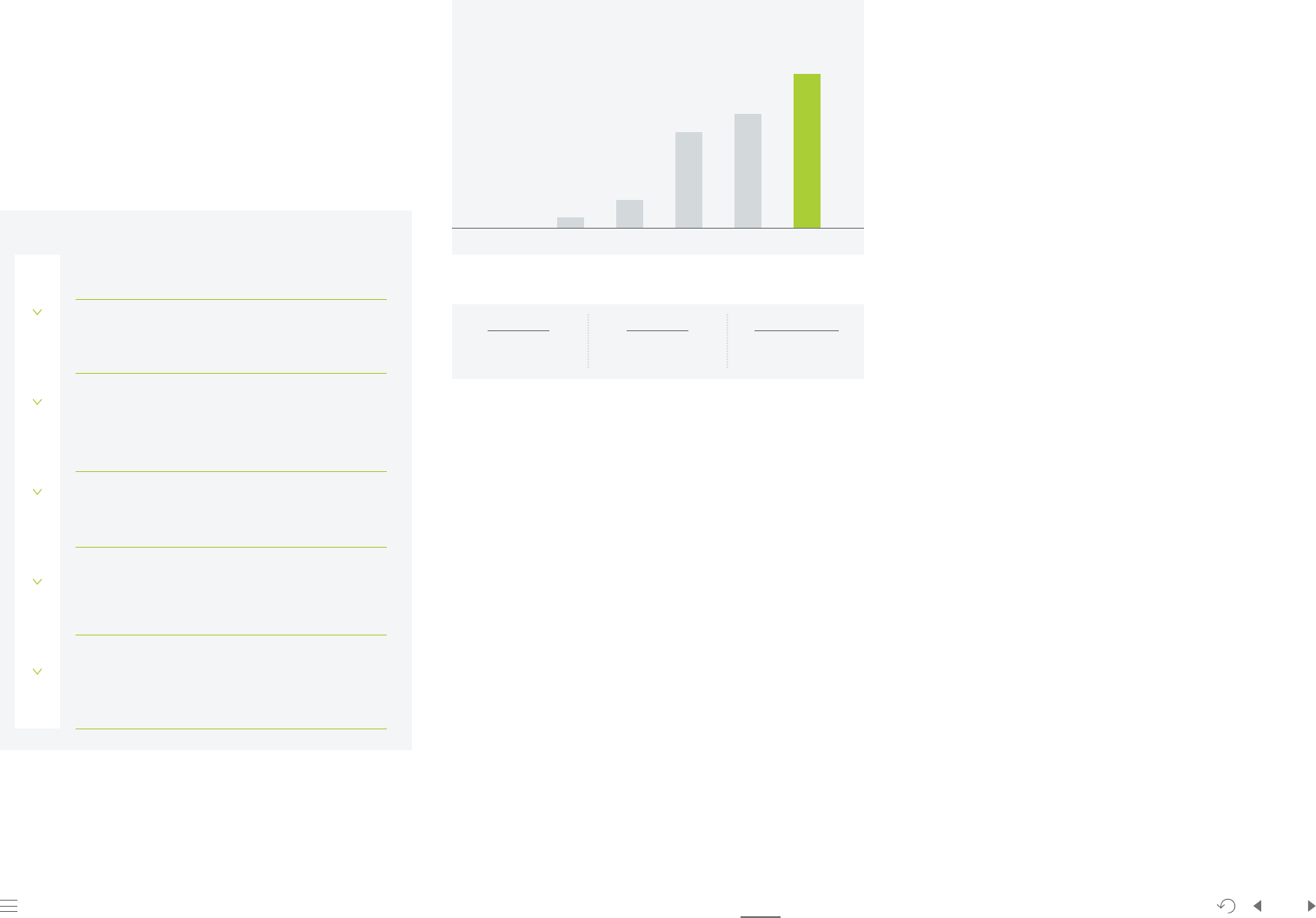
Our Company AppendixApproach to Sustainability Facts & Figures Principle
Planet
22
People
Samsung Electronics Sustainability Report 2023
Use of Renewable Energy
(unit: GWh)
Average annual increase in the use of renewable
energy (2018-2022)
8,704
2022
3,220
1,356
20192018
4,030
2020
5,278
2021
59
%
DX Division
93
%
DS Division
23
%
Company-wide
31
%
Renewable Energy Transition Rate
Renewable Energy Expansion Roadmap
Declared plan to expand renewable energy use
(beginning with 100% in the US, Europe, and China)
Completed the transition to 100% renewable energy in the
US, Europe, and China
Completed the transition to 100% renewable energy at all of
DX Division’s business sites in Korea and manufacturing sites
in Vietnam, India, and Brazil.
Transition to 100% renewable energy in Central and
South America
Transition to 100% renewable energy at all of our global
business sites
2018
2020
2022
2025
2027
2050
Transition to 100% renewable energy at all of our business
sites around the world
Expansion of Renewable Energy Use
We engage in diverse activities to transition to 100% renewable energy
at all of our business sites by 2050. In 2022, DX Division's business sites
in Korea as well as manufacturing sites in Vietnam, India, and Brazil
completed their transition to renewable energy use.
The total amount of renewable energy use in 2022 stood at 8,704 GWh –
a 65% increase from the previous year – reaching a 31% transition rate.
RE100 and ACEC
As part of our commitment to transition to renewable energy, we
joined RE100 (a global initiative that drives energy transition) and
continuously seek to develop competitive renewable energy projects.
We are a founding member of the Asia Clean Energy Coalition (ACEC),
working with the Climate Group that leads RE100 and the World
Resources Institute (a global think tank focused on environmental
issues).
ACEC, which consists of corporations, renewable energy-based power
generators, and investors, aims to contribute to fostering a renewable
energy ecosystem for Asian countries that serve as the global
manufacturing hub.
Through these initiatives and collaborations, we strive to expand the
renewable energy markets in Asia including and advance the use of
renewable energy in the region.
Renewable Energy Transition Status by Region
US
As part of efforts to expand renewable energy use, our US
subsidiaries installed photovoltaic power generation equipment
and a wind power station, while also purchasing renewable energy
certificates (RECs) between 2017 and 2018. In November 2019, our
semiconductor manufacturing site in Austin, Texas, concluded a PPA on
a 75MW-capacity wind power generation project with Apple, eBay, and
Sprint and is gradually expanding PPA contracts. Based on such efforts,
the US subsidiaries achieved the transition to 100% renewable energy in
2020, received the 2019 Green Power Leadership Award for Excellence
in Green Power Use from the US Environmental Protection Agency (EPA)
in September 2019. Samsung Electronics ranked 15
th
among more than
700 participating companies, 7
th
in the Tech and Telecom sector, and
11
th
among companies sourcing 100% renewable energy in the US EPA’s
Green Power Partnership program in June 2023.
Europe
Our manufacturing sites in Hungary, Slovakia, and Poland completed
the transition to 100% renewable energy for their electricity use in
2020 by adopting the Green Pricing System and purchasing RECs.
India
Our manufacturing site in Chennai completed the transition to 100%
renewable energy by signing renewable energy supply contracts with
local photovoltaic power, wind power, and biomass power stations and
by purchasing RECs. Our business site in Noida also completed the
transition by installing photovoltaic power generation equipment of
0.8MW-capacity at parking lots and pedestrian paths and purchasing
RECs.
Vietnam and China
Our manufacturing sites in Vietnam and China completed their
transition to 100% renewable energy as of 2022 through the purchase
of RECs. We plan to utilize PPAs as well, according to developments in
the local renewable energy policies and supply plans.

Our Company AppendixApproach to Sustainability Facts & Figures Principle
Planet
23
People
Samsung Electronics Sustainability Report 2023
Value Chain Carbon Reduction Roadmap
Present
2030
Energy efficiency of leading models of seven major product
categories* improved by 16% compared to 2019 using high
energy efficiency technologies
Improve energy efficiency of leading models of seven major
product categories* by 30% compared to 2019
* Smartphone, TV, refrigerator, washer, air conditioner, PC,
and monitor (with equivalent performance)
Brazil
Our manufacturing site in Campinas completed the transition to
100% renewable energy in 2021 by signing renewable energy supply
contracts with local wind power, photovoltaic power, and hydropower
stations. Our business site in Manaus completed the transition in 2022
based on RECs that involve local renewable energy suppliers.
Mexico
Our manufacturing site in Mexico expanded its share of renewable
energy to 73% in 2022 from 4% in 2020 through diverse measures
including purchasing RECs. It is seeking additional renewable energy
suppliers and plans to achieve the transition to 100% renewable energy
by 2025.
Korea
Our Suwon and Giheung business sites are equipped with
1.9MW-capacity and 1.5MW-capacity photovoltaic power generators,
respectively. Our Pyeongtaek business site is equipped with a
0.4MW-capacity photovoltaic power generator and a 738RT-capacity
geothermal power generator. At the Onyang business site, we installed
a 0.08MW-capacity photovoltaic power generator in 2021 as well as
a 0.2MW-capacity generator in 2022. All of the DX Division’s business
sites achieved the transition to 100% renewable energy using the
Green Premium program initiated in 2021. We will continue to install
photovoltaic power equipment and expand renewable energy supply
contracts, including PPAs, at our domestic business sites.
Activities to Reduce Global GHG Emissions
Our priority projects for reducing GHG emissions center on in-house
energy efficiency improvement, energy consumption reduction, and
energy transition activities at our business sites in Korea and other
regions.
We are participating in the Clean Development Mechanism (CDM)
initiative designed to help mitigate local communities’ GHG
emissions through the distribution of clean cook stoves in Kenya and
high-efficiency refrigerators in India. We distributed 3.64 million
high-efficiency refrigerators over eight years prior to 2020 and
contributed to the reduction of 550,000 tonnes of GHG emissions,
thereby obtaining Certified Emissions Reductions (CERs) issued by
the UNFCCC. We are exploring business opportunities based on our
voluntary reduction projects.
We will prioritize carbon dioxide removal (CDR) projects centered on
permanently removing GHGs and nature-based reduction projects
targeting countries where we operate that are particularly vulnerable
to the impacts of climate change.
Moreover, when deciding which project to pursue, we will also take
into account each project's expected contribution to the 17 Sustainable
Development Goals (SDGs) to ensure sustainability is driven in a
holistic manner.
Value Chain Carbon Reduction
Manufacturing is only one of many stages in the entire product life
cycle. We strive to reduce carbon emissions across all stages of the
product life cycle including distribution, sales, and use in collaboration
with our consumers, suppliers, and other stakeholders.
In particular, we plan to utilize ultra-power-saving technology for
semiconductors, which is expected to drastically reduce the memory-
related power consumption of data centers and mobile devices from
2025. We plan to apply the technology to the leading models of our
seven major product categories (smartphone, refrigerator, washer, air
conditioner, TV, monitor, and PC) and improve their power consumption
by 30% by 2030 compared to the 2019 models with equivalent
performance.
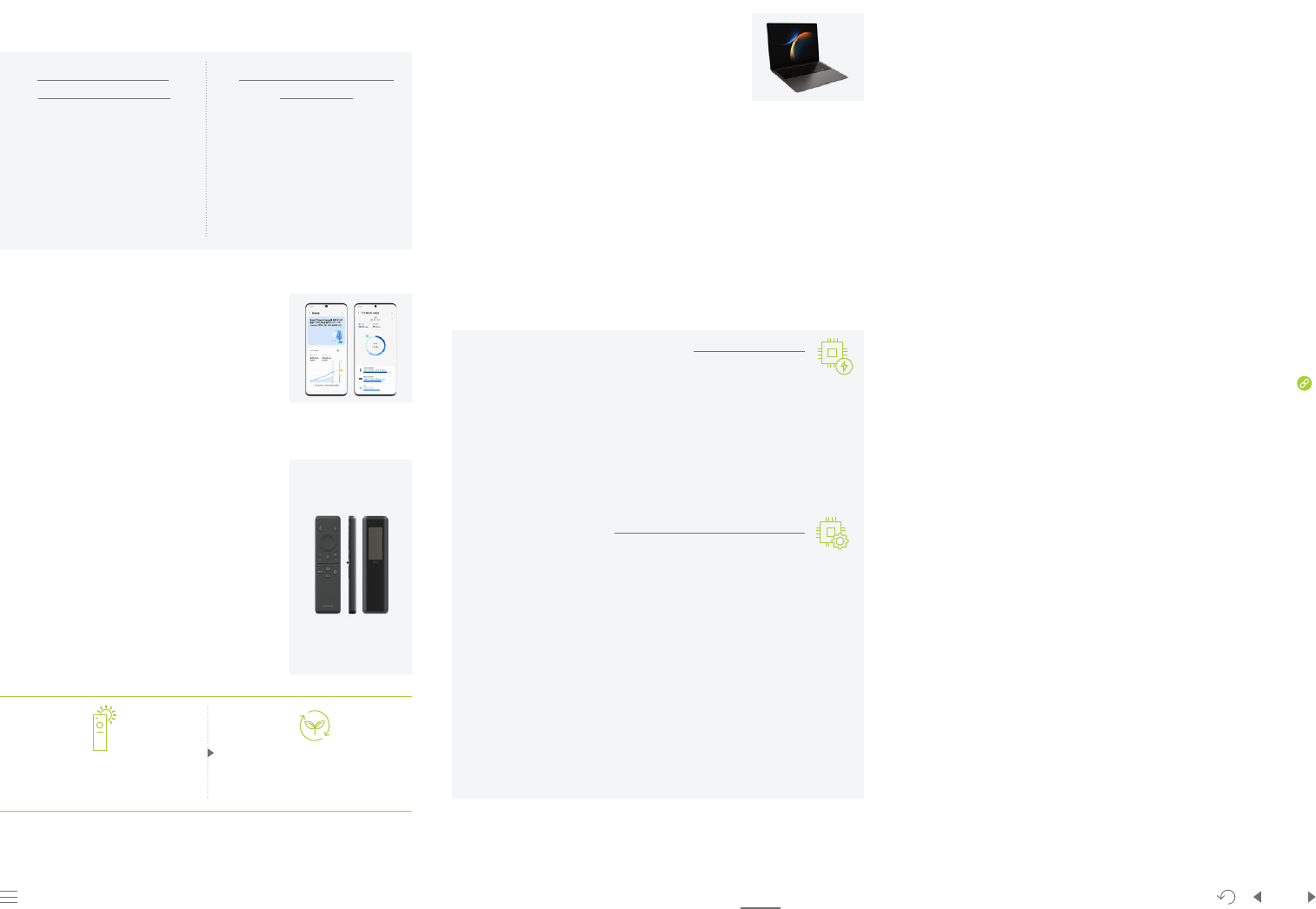
Our Company AppendixApproach to Sustainability Facts & Figures Principle
Planet
24
People
Samsung Electronics Sustainability Report 2023
Climate Action Together with Our Suppliers
As we are aware that it takes the entire supply chain to tackle
climate change, we strive to engage our suppliers in our journey.
We established a GHG emissions reduction system in 2022 and have
launched substantive reduction activities since becoming a CDP Supply
Chain member in 2019. We provide training for our suppliers to build
their GHG emissions management capacity based on our in-house
guidelines, helping them accurately assess their emissions and set
reduction targets. We have also developed reduction support programs
tailored to various stages and continue to update our GHG emissions
management policy.
More details about our efforts to ensure our suppliers’ GHG emissions
reduction can be viewed in sections, “New Environmental Strategy”
and “Sustainability in Supply Chain”.
Semiconductor Life Cycle Assessment (LCA) Process
We established the LCA process to accurately assess the environmental
impact and carbon footprints of our semiconductor products across their
entire lifecycles. Based on ISO 14040, 14044, and 14067, the operation
of this process was verified by a third-party organization to ensure the
credibility of all data produced.
To reduce the environmental impact of semiconductor products, we
plan to establish a comprehensive management system of their carbon
emissions and their use of water and other resources.
Semiconductor
Starting with the Green Memory Campaign in 2009, we have continued
to showcase memory solutions centered on low energy consumption
every year to help the industry contribute to the wellness of our planet.
Low-power semiconductors are essential to reducing GHG emissions
generated from data centers and diverse IT devices. We focus on
developing semiconductors that can reduce the carbon footprints of
our products.
PC
We enhanced the energy efficiency of our Galaxy
Book3 ultra by employing circuits designed to
prevent the energy loss of the display as well as
SOC.
SolarCell Remote
We continually seek ways to contribute to
environmental conservation through our
remote-control products as well. SolarCell
Remote was developed as an extension of our
efforts to reduce the number of disposable
batteries used in TV remote controls that were
being replaced about once a year. This low-
power remote control, which can be charged by
both natural and indoor lighting, continues to be
applied to a growing number of our TV models.
SolarCell Remote applied to all
TV models released in 2022
Equivalent to a reduction of
approximately 200 million
disposable batteries
GHG emissions reduction
in the product use stage:
914,000
tonnes CO
2
e
* 13 product categories (refrigerator,
air conditioner, washer, dryer,
microwave oven, vacuum cleaner,
TV, monitor, PC, smartphone, tablet,
wearable, and base station)
** Compared to BAU
(Baseline year: 2021)
Product energy consumption
improvement
2.6
%
* Compared to BAU
(Baseline year: 2021)
Carbon Emissions Reduction in the Product Use Stage
Our Product Energy Efficiency Achievements in 2022
Third-party LCA verification certificate
SmartThings Energy
SmartThings Energy is our AI-based solution
that enables users to maintain the optimal
energy efficiency of their home appliances via
the smartphone. It supports efficient energy
use based on the IoT platform.
Low-Power Memory Semiconductor
Reducing the power consumption of global data centers
Developed data center-exclusive high-performance SSD (PM9A3,
E1.S) with power efficiency improved by 50% compared to previous-
generation products
Application of advanced technologies of extreme ultraviolet (EUV),
high-K metal gate (HKMG), and through-silicon via (TSV) to improve
performance while minimizing power consumption
System Semiconductor
Developing energy-efficient high-performance semiconductors
Exynos Processor: Offering our exclusive Advanced Multi-IP Governor
(AMIGO) solution and improved processing units (e.g., CPU, GPU, NPU) to
enhance power efficiency when running high-definition, high-end games,
and programs
Image sensor: Realizing maximized per-inch resolution through advanced
ultrafine pixel technologies and minimizing the energy required for
product operation (e.g., preview movements) through design optimization
DTV SoC: Minimizing power consumption through the integration of high-
resolution upscaling ICs and combining two TCON chips used for 8K TV
models into one
Decarbonizing the Use Phase of Connected Devices (DUCD) Project
Led by the Carbon Trust, the DUCD project aims to develop a more
accurate method for measuring the carbon emissions and reduction
pathways in the use phase of connected devices. Since September
2022, we have been working with Amazon, Meta, Microsoft, and Sky
(Comcast) as a founding member of the DUCD secretariat.
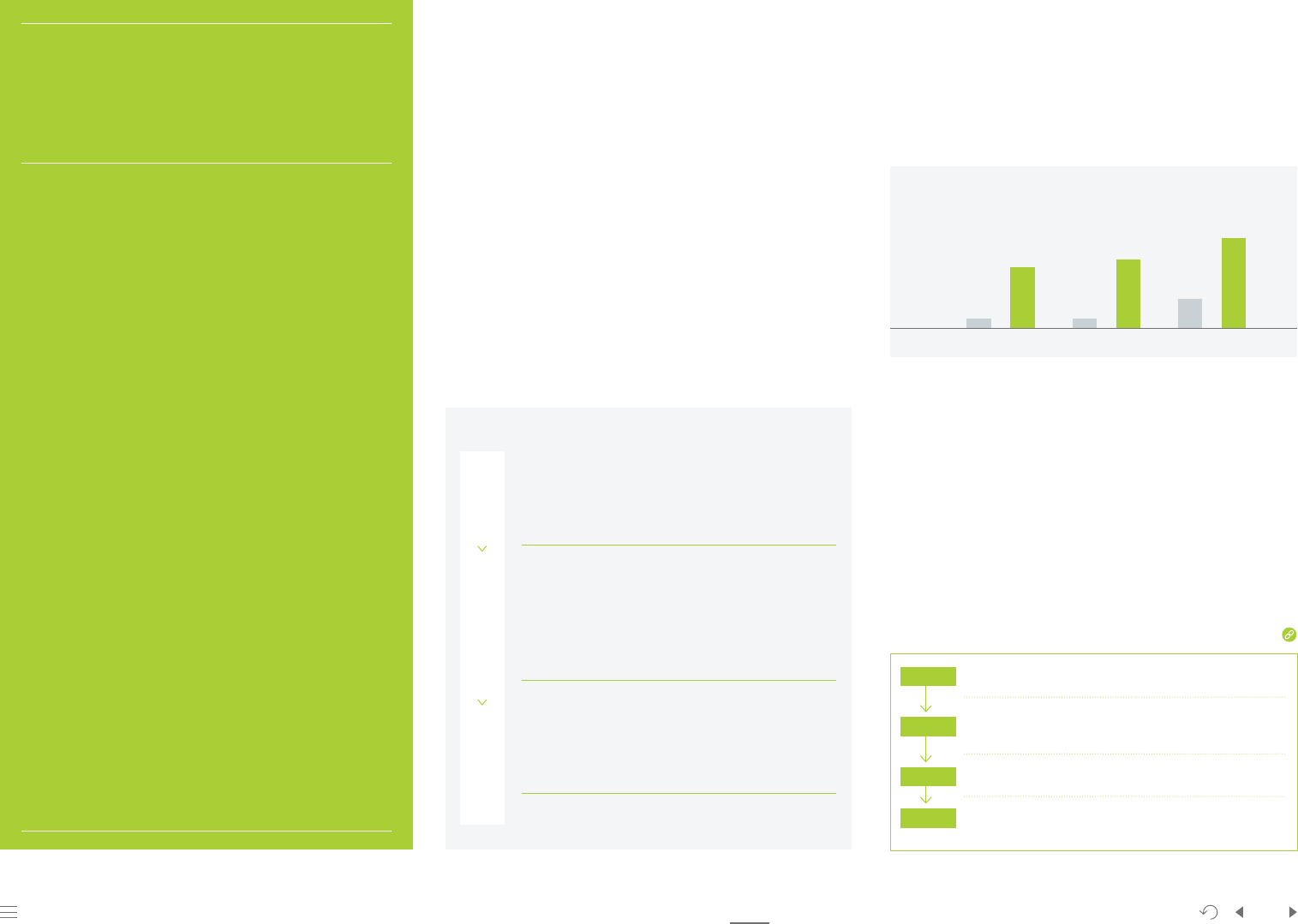
Our Company AppendixApproach to Sustainability Facts & Figures Principle
Planet
25
People
Samsung Electronics Sustainability Report 2023
Using Recycled and Recyclable Materials
Samsung Electronics continuously seek to expand the application
of recycled and recyclable materials to our products. We developed
innovative technology to recycle discarded fishing nets, a type of
plastic debris that threatens the marine environment, and continue
to diversify the types of recycled and recyclable materials used in our
products, including recycled aluminum and glass, to improve resource
circularity.
Plastic recycled from discarded fishing nets has been applied to
smartphones including Galaxy S22 series, S23 series, Z Fold4/Flip4,
Buds2 Pro, Galaxy Book3 series, remote control for our lifestyle TV
models (inner parts and bracket), Jet Cordless Stick Vacuum 4.0 series
(filter), and the attachable Less Microfiber Filter.
We also used recycled aluminum in the Galaxy S23 series and the
exterior of the Bespoke Infinite refrigerator line, while we continue to
expand the application of recycled glass.
Resource Circularity Roadmap
2030
Present
2050
Increasing the Use of Recycled Resin in Plastic Parts
We aim to drastically expand the use of recycled resin in plastic parts.
In 2022, we used 98,826 tonnes of plastic with recycled resin, which
marks a three-fold increase compared to the previous year and is
equivalent to 14% of our total plastic use. We will apply recycled resin
to 50% of plastic parts by 2030 and 100% of plastic parts by 2050.
Use of Plastic with Recycled Resin
(Unit: 1,000 tonnes)
310
2021
33
276
2020
31
409
2022
99
●
Annual amount
●
Cumulative amount from 2009
Applying recycled material to parts of Galaxy smartphones,
earbuds, tablets, and laptop
Producing pellets using exclusive formulation technology
Step 3
Step 2
Sorting
Cleaning
Recovering polyamide fishing nets discarded into the sea
Step 1
Step 4
View more
Expanding the Use of Recycled and Recyclable Materials
Sea-Driven Innovation – Discarded Fishing Nets Repurposed
into Galaxy Smartphones
Plastic pollution caused by fishing nets, of which approximately 640,000
tonnes are discarded into the ocean every year – poses a severe threat
to the marine ecosystems. We have joined hands with industrial experts
and mobilized our innovative technologies to seek solutions to this
problem. The high-performance polyamide resin recycled from ocean-
bound plastics has been applied to various parts of our Galaxy product.
We will continue to expand the application of such materials thereby
helping our users pursue sustainability in their everyday lives.
409,000 tonnes of plastic with recycled resin used
cumulatively since 2009
Ocean-bound plastic recycled and applied to DX products
Circular Economy Lab established
Application of recycled resin* to 50% of plastic parts
for DX products
Establishing a recycling system for minerals recovered
from all discarded batteries collected
Application of recycled resin* to 100% of plastic parts for DX
products
* Ratio of recycled content varies by plastic parts
Cutting
Extruding of the fishing nets
We are driving progress toward a circular economy
by using recycled and recyclable materials, as well as
recovering resources from discarded products. We are
creating a loop of resource circularity in collaboration
with customers, suppliers and various partners.
Circular
Economy
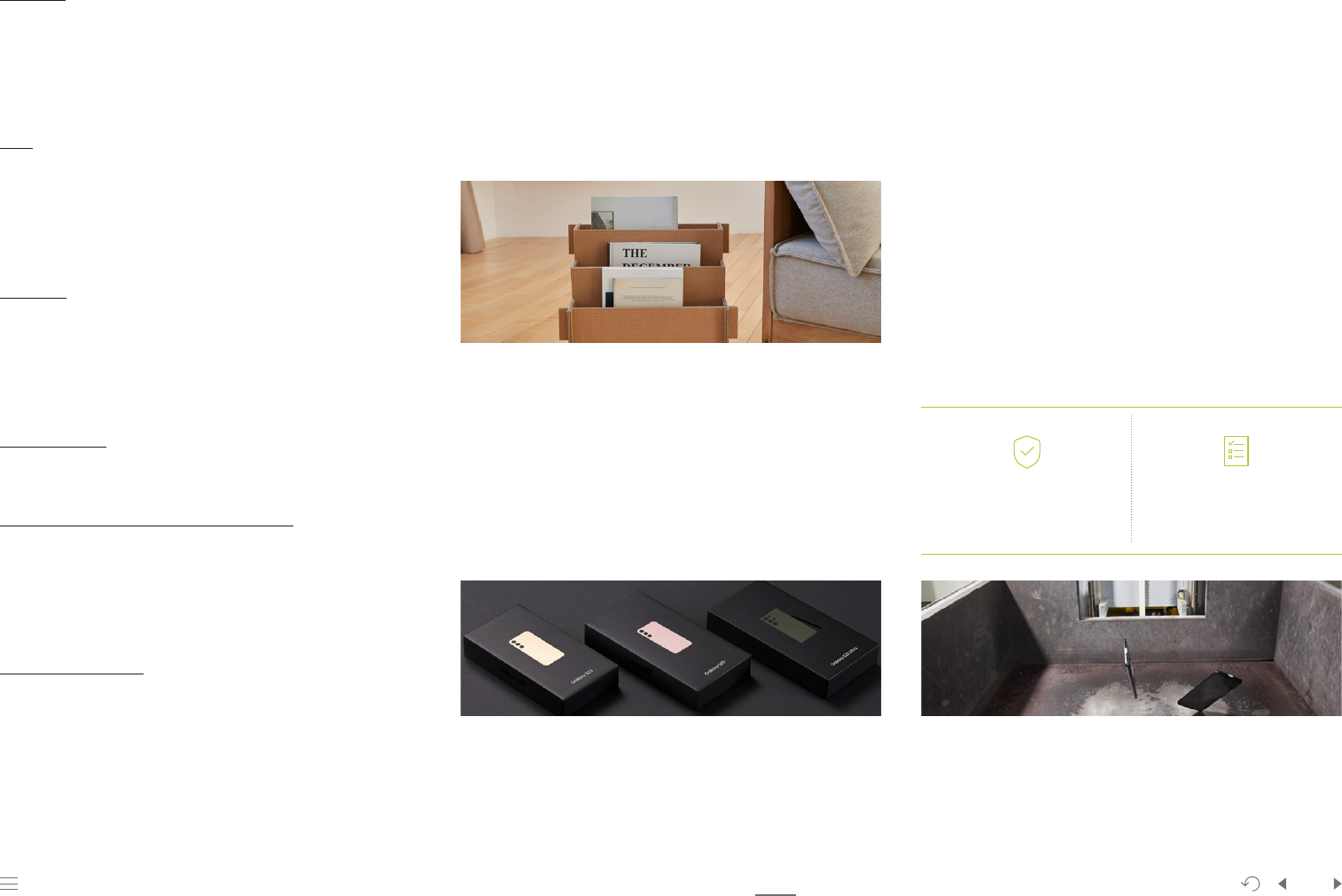
Our Company AppendixApproach to Sustainability Facts & Figures Principle
Planet
26
People
Samsung Electronics Sustainability Report 2023
Applications of Eco-packaging by Product Category
Displays and Home Appliances
We use recycled expandable polystyrene (EPS) cushions in the
packaging of our major TV models and are expanding their application
to all monitor and signage models released in 2023. In addition, since
2020 we have engaged our users in upcycling the packaging materials
of our TVs – repurposing them into small furniture and objects for pets-
and have expanded the scope to packages of all TV models and select
home appliances including air purifiers, etc.) released since 2021.
Mobile Devices
For the Galaxy S23 series released in 2023, 100% of the packaging box
was made from recycled paper. The plastic films previously attached
to the front and back of the product were fully replaced with 100%
recycled paper as well. We are continuing our efforts to minimize
our environmental impact by eliminating single-use plastic from the
packaging and reduce GHG emissions from product transportation by
making packages smaller and lighter.
Expanding the Scope of Recycled Material Use
Aluminum The exterior of the Bespoke refrigerator line released in
2023 is made with impurity-free and evenly colored aluminum in a
three-tier (new-recycled-new) structure using 37% recycled aluminum.
The volume keys, side key, and SIM tray of the Galaxy S23 series are
made with 28% pre-consumer aluminum scrap obtained from the
manufacturing processes.
Glass The Galaxy S23 series is the first device to use Corning
®
Gorilla
®
Glass Victus
®
2, which contains an average of 22% pre-consumer
recycled glass for front screen and back cover.
Our Efforts to Recycle Byproducts from Semiconductor
Manufacturing
Recycling Previously, end-of-life wafers were incinerated for
security reasons. However, we developed a way to recycle them into
supplementary materials for the production of aluminum bars. We also
introduced recyclable eco-drums designed to minimize the residue of
chemicals typically left behind in other chemical storage drums. This
eliminated the need for their neutralization.
Waste Reduction We recycle nonferrous metals such as aluminum,
copper, and titanium used in the manufacturing process into resources
of economic value.
Repurposing into High-Added-Value Materials As an extension of
our efforts to repurpose waste into resources, we utilize separation
and refinement technologies to turn waste dimethyl sulfoxide (DMSO)
generated during the manufacturing process into high-purity DMSO.
We also convert ion exchange resins into high-quality recycled
materials using our separation technology.
Discarded PET Bottles We use cleanroom supplies (e.g., clothing,
wipes) produced from discarded PET bottles that are collected on the
premises of our business sites in Korea.
Extending Product Lifecycles
We work to extend our products’ lifecycles to reduce the use
of resources and carbon emissions and thereby minimize our
environmental impact. In this context, we focus on enhancing their
durability, repairability, and upgradability. We also operate the
Samsung Care+ program to minimize burden on customers with regard
to maintenance and repair and help them use our products longer.
Durability
All of our products undergo testing under international standards
and also our exclusive in-house stress testing during the product
development stage to ensure that our customers can use the
purchased products for a longer period. Through these product tests,
we ultimately strive to help our users consume resources longer and
more efficiently.
International-standard testing
Strength, drop, water-resistance
and lifespan tests
In-house stress testing
Testing at different conditions and
for different environments
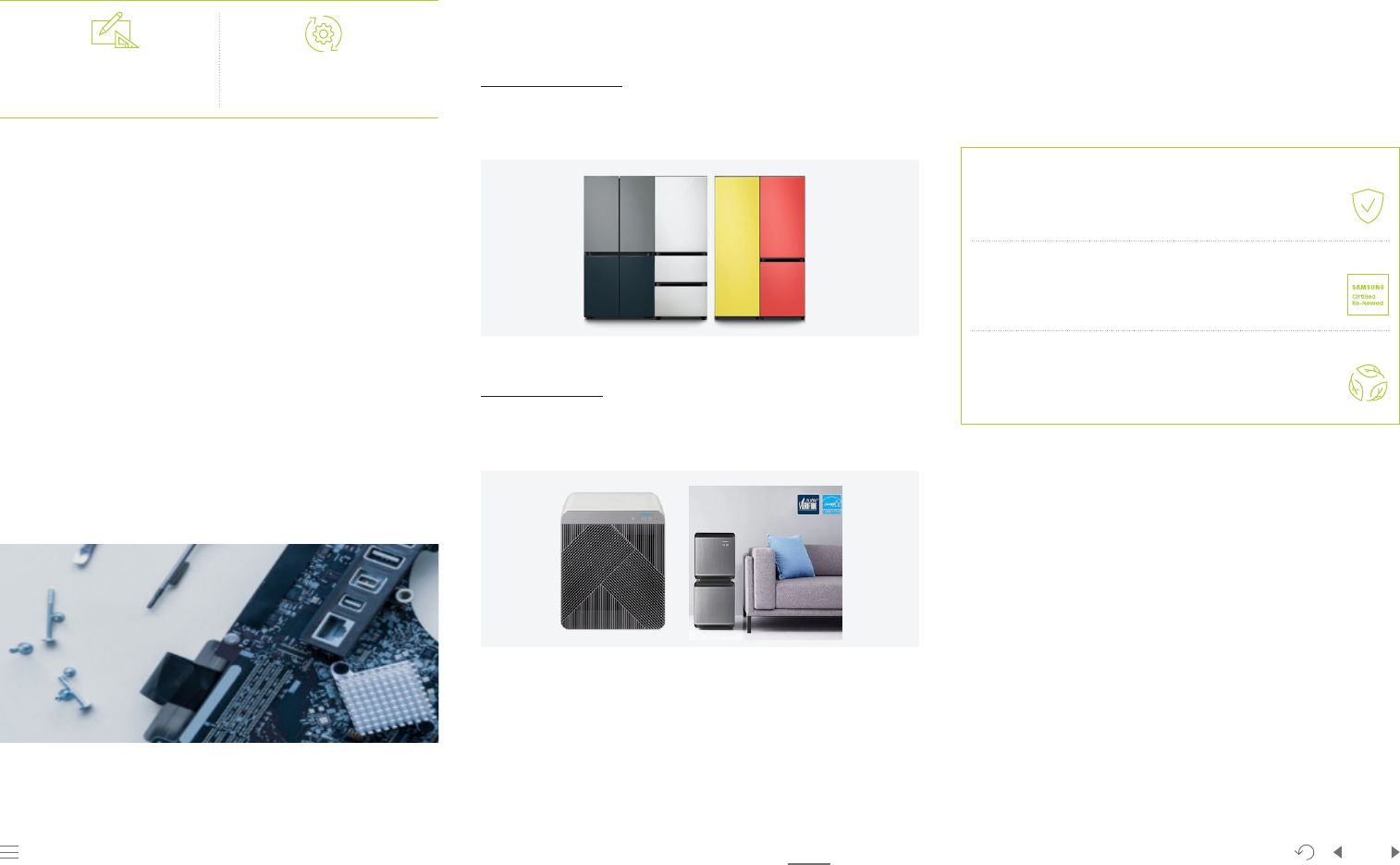
Our Company AppendixApproach to Sustainability Facts & Figures Principle
Planet
27
People
Samsung Electronics Sustainability Report 2023
Upgradability
Software Update
We provide four generations of OS upgrades and five years of security
updates for all Galaxy S23 series models. As a result, we anticipate
users will enjoy their Galaxy mobile devices more securely for a longer
period of time.
Samsung Certified Re-Newed Program in the US
The Certified Re-Newed program offers customers refurbished and
upgraded smartphones with a one-year warranty. Certified Re-Newed
devices start their journey as trade-in devices with new device
purchases. They then go through a rigorous quality inspection of more
than 100 points to ensure like-new quality. They are refurbished in a
Samsung facility where many of our new smartphones are also built,
and parts are replaced with 100% genuine parts quickly and easily.
Every Certified Re-Newed device gets a brand new battery which
ensures like-new long-lasting performance.
Repairability
We consider repairability at the product manufacturing stage. Our
research is focused on developing products that are easy to repair for
extended use.
Highest Grade by France’s Repairability Index
Since January 2021, all electronic goods marketed in France must
specify the repairability grade known as the Repairability Index (Indice
de Réparabilité). Our various products including smartphones such as
the Galaxy S23 series, Galaxy Book3, TV, front-load washer, dishwasher,
and vacuum cleaner obtained the highest grade of Dark Green. We
continue to keep consumers informed via repair manuals and other
channels and strive to ensure the affordability of materials and stable
supply of parts.
Efforts to Establish a Repairability Network in the US
We offer a vast network of repair options for our customers in the US,
including self-repair options, mail-ins, "We Come To You" van services,
and same-day repair for Galaxy devices in over 2,000 retail locations
across the country. Our network of mobile repair providers include
more than 700 Independent Service Providers (ISPs).
Modular Design for Resource Efficiency
Bespoke Refrigerators The modular Bespoke Refrigerator line enables
users to refresh their fridge exterior by changing the customizable door
panels, without having to replace the entire unit.
Bespoke Cube™ Air Bespoke Cube
TM
Air is our modular air purifier line.
It allows consumers to purchase and stack additional units of desired
capacity as needed, thereby enabling resource efficiency.
Designed to maximize
recyclability of parts
Designed for
easy disassembly
Samsung Certified Re-Newed smartphones pass a more
than 100-point inspection to ensure like new quality, and
are covered by a one year warranty
Every Samsung Certified Re-Newed smartphone is given a
brand new battery.
Our trade-in program collects used devices, giving them an
extended life cycle.
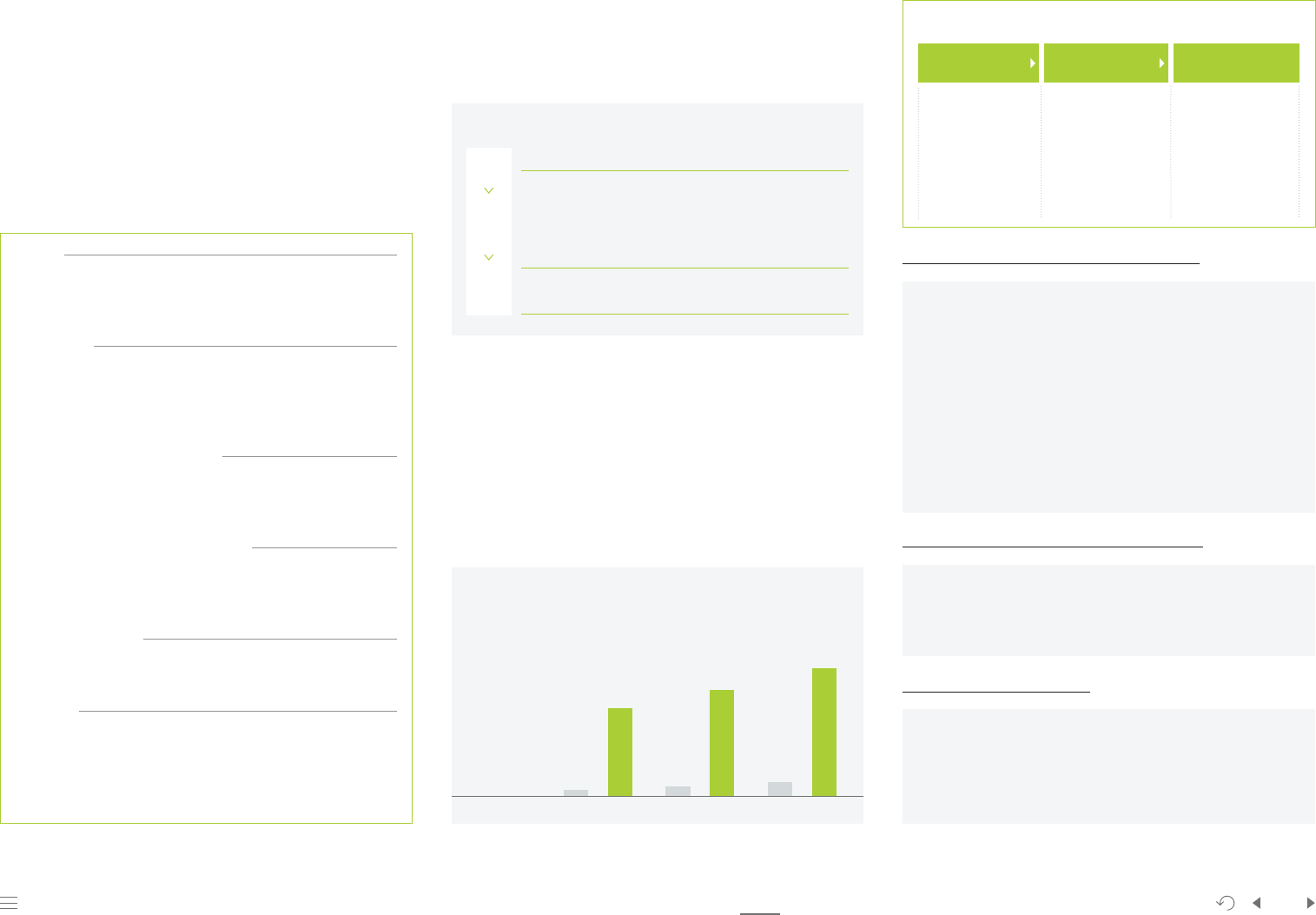
Our Company AppendixApproach to Sustainability Facts & Figures Principle
Planet
28
People
Samsung Electronics Sustainability Report 2023
Repair Services
Product lifecycles can be extended without compromising performance
by promptly diagnosing and correcting each product’s cause of
malfunction. To this end, we operate a total of 13,687 service centers
in 216 countries as of 2022. Our staff members and repair technicians
are trained to provide top-tier services pursuant to our service process
guidelines. We also offer various training programs including those on
product use and new product features.
Expansion of E-Waste Collection System
We have collected 5.69 million tonnes of e-waste in cumulative sum
from 2009 to 2022 through our e-waste collection system operated
in over 50 countries. We plan to expand the reach to more than 180
countries where our products are marketed by 2030 and increase the
cumulative amount of collected e-waste to 10 million tonnes by 2030
and 25 million tonnes by 2050.
Collecting and Recycling E-Waste
Individual products are made with a wide range of materials and can thus
be viewed as a combination of resources. We collect and reprocess e-waste
to ensure that valuable resources are recovered and given new life.
Amount of Collected E-Waste
(Unit: 1,000 tonnes)
5,099
559
5,699
600
4,540
506
2021 20222020
●
Annual amount
●
Cumulative amount (from 2009)
Asan Recycling Center, Korea’s first e-waste recycling center,
opened in 1998.
The e-waste takeback system was set up at regional logistics centers.
A cumulative total of 30,152 tonnes of valuable resources have been
recovered at Asan Recycling Center (as of 2022).
Requirements for Recycling Service Partners
→ We enacted the Requirements for Recycling Service Partners, which
mandate the adherence to environment, safety, and health laws and the
prohibition on the illegal export of waste.
E-Waste Takeback and Recycling Program in Korea
The voluntary drop-off program is in operation in all 50 states.
In partnership with uBreakiFix which specializes in mobile device repair,
we provide e-waste drop-off points at over 780 branches (from 2020).
E-Waste Takeback and Recycling Program in the US
Sustainability in Product Repair Services
Repair
We offer our repair service that minimizes parts replacement and reuses
existing parts as much as possible. As of 2022, this service is available for
smartphone repair in 38 subsidiaries including the US and Germany.
Paper-Free
We seek to minimize the use of paper for our repair services and issue
digital documents (e.g., submission slips, receipts) to save resources. As of
2022, this service is available in 49 subsidiaries including India, Germany
and Brazil.
Packaging for Repaired Products
We use environmentally responsible packaging materials when delivering
repaired products back to customers. As of 2022, this service is available
in 29 subsidiaries including the Netherlands and the UK.
Packaging for Repair Service Supplies
Repair service supplies are packaged with environmentally responsible
packaging materials. As of 2022, this is applied to our warehouses in Korea
and Europe and 12 global production sites.
Samsung Recycling
We have installed smartphone and accessory drop-off points at our service
centers in major cities including Paris and London to collect e-waste.
Delivery
We deliver repaired products back to customers using environmentally
responsible vehicles transportation such as bicycles and EVs. As of 2022,
this service is available in seven subsidiaries including the Netherlands
and Germany.
E-Waste Collection and Recycling Process
Collecting
e-waste
A total of 5.69
million tonnes of
e-waste collected
globally in
cumulative sum
(2009-2022)
Recovering
valuable resources
Recovering copper,
aluminum, steel,
plastics, among
others, through
pre-processing
such as sorting
and crushing
Recycling recovered
resources
Recovered resources
used in the production
of Samsung parts as
well as other branded
products
Present
E-Waste Collection and Recycling Roadmap
2030
2050
Operating e-waste collection programs in over 50 countries
Operating e-waste collection programs in all countries
in which our products are marketed
Collecting 10 million tonnes of e-waste cumulatively from
2009
Collecting 25 million tonnes of e-waste cumulatively
from 2009
E-waste takeback and recycling programs in 37 countries in EU
· E-waste takeback, recycling, and free door-to-door visits for e-waste
takeback programs in India
· Voluntary drop-off points at service centers in South Africa
Programs in EU, Asia, and Africa
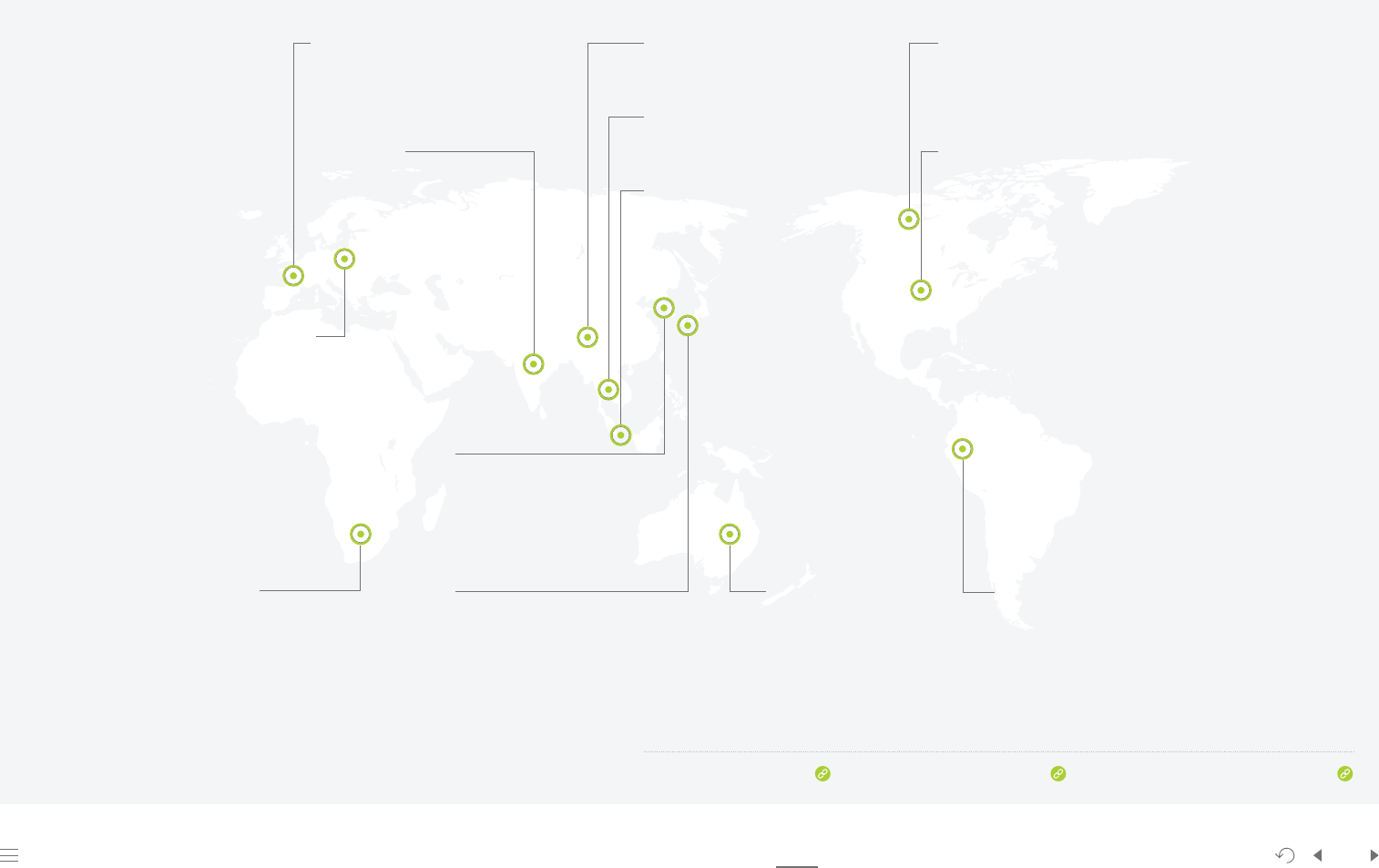
Our Company AppendixApproach to Sustainability Facts & Figures Principle
Planet
29
People
Samsung Electronics Sustainability Report 2023
Status of our E-Waste Takeback and Recycling Programs around the World
We operate diverse recycling programs in over 50 countries including Korea. Based on country-specific conditions, we either directly operate recycling centers or collaborate with relevant organizations or service providers to
collect and recycle e-waste.
Recycling program by country
E-waste collection system by region
Requirements for Recycling Service Partners
South Africa
Offering voluntary
drop-off points at
service centers
Europe
Operating a takeback and recycling
programs in 37 countries
Vietnam
Offering voluntary drop-off points at
service centers
Singapore
Operating a takeback and recycling
program
Canada
Operating a takeback program in all 10 provinces
US
Operating a voluntary drop-off program in all 50 states
Collaborating with uBreakiFix, a US-based chain of mobile
device repair shops
Australia
Operating a takeback and
recycling program for TVs,
computers, and printers
Participating in a voluntary
drop-off program for mobile
phones
India
Operating a takeback and
recycling program
Offering free door-to-door
visits for e-waste takeback
Korea
Operating a takeback network (dealerships
and logistics bases)
Asan Recycling Center
Offering free door-to-door visits for
e-waste takeback
Japan
Participating in takeback and recycling
consortium
Türkiye, Israel, Russia,
Belarus, Georgia
Participating in the
takeback and recycling
program
China
Operating a takeback and recycling
program
Colombia, Peru, Costa Rica, Brazil
Operating a voluntary drop-off program
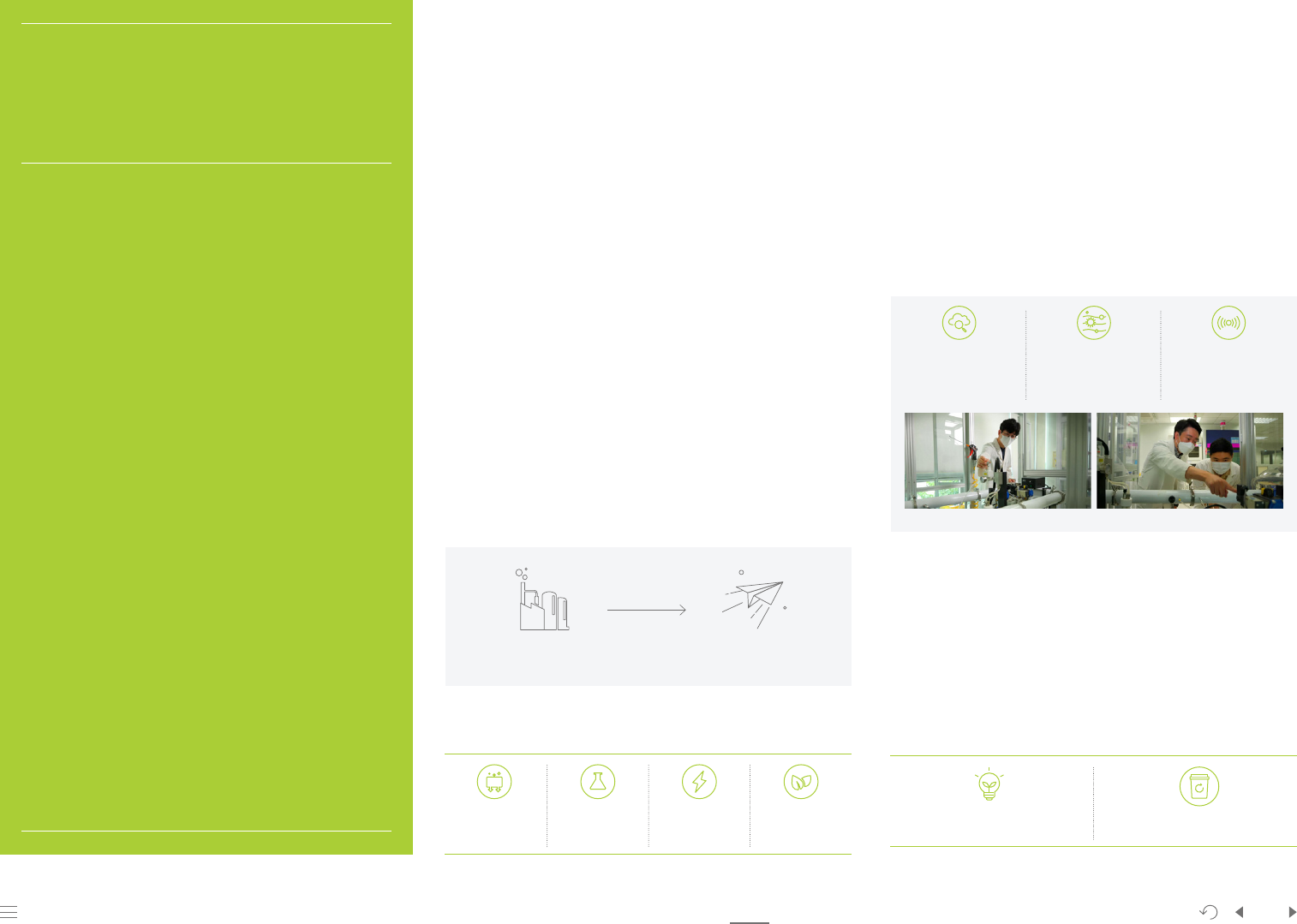
Our Company AppendixApproach to Sustainability Facts & Figures Principle
Planet
30
People
Samsung Electronics Sustainability Report 2023
Tackling Environmental Challenges with
Innovative Technologies
Carbon Capture Technologies
We established the semiconductor-industry's Air Science Research
Center (previously Carbon Capture Research Institute) in September
2021 to develop and commercialize technologies for capturing and
utilizing carbon emitted from our semiconductor manufacturing
sites. We have engaged in research on original technologies to
capture emitted carbon with greater efficiency and transform them
into resources. We are also pushing ahead with various joint projects
with universities and research institutes in Korea and beyond. Our
carbon capture technologies will be applied to our semiconductor
manufacturing sites starting in 2030, and their application will be
expanded to our suppliers and other Samsung affiliates.
Process Gas Emission Reduction Technology
We operate Point of Use (POU) scrubbers and Regenerative Catalytic
Systems (RCSs) optimized for individual semiconductor manufacturing
sites to reduce F-gases. Cheonan site with a low air volume installs a
POU scrubber at the end process of production to reduce F-gas while
Giheung, Hwaseong, and Pyeongtaek sites with a high air volume have
POU scrubbers as well as the RCSs installed on the rooftop.
Carbon Capture and Utilization
We strive to take the lead in developing
technologies that are environmentally
responsible while enabling an ecosystem
that fosters clean and responsible technology.
We collaborate with universities, research
institutes, and start-up communities to find
solutions for global environmental challenges
and invest in innovative ideas.
Clean Tech
Ecosystem
CO
2
Capture
Capturing GHG emissions
Useful Resource
Transforming them into resources
Particulate Matter Reduction Technologies
We established the Air Science Research Center (previously Particulate
Matter Research Institute) in January 2019, dedicated to developing
innovative filters and original technologies to detect, analyze, and
remove particulate matter. We successfully developed the world’s first
air purification filter capable of removing both fine particles and gases,
which can be easily cleaned with water and reused for up to 20 years.
We have developed a prototype product based on this technology
and are applying it to our semiconductor manufacturing sites, bus
terminals, and underground parking lots. From 2030, we will expand its
application to our suppliers and other Samsung affiliates.
Original Technology Research Areas
Technologies Contributing to a Circular Economy
We established the Circular Economy Lab in July 2022, which
specializes in research on material recycling process and technology,
and the application of recycled materials to products to maximize
resource circularity. Through the Lab, we have collaborated with
various research institutions and corporations to research material
recycling and waste-to-resource technologies with the aim of
ultimately manufacturing all of our products with recyclable materials.
* Testing of a particulate matter reduction system
Diagnosis of fine
particles and causative
gases
Analysis of the root
causes of air pollution
Development of
sensors, catalysts, and
systems for particulate
matter reduction
Developing recycled and
recyclable materials
Seeking ways to recover resources
from waste
Carbon Capture Technologies (Applicable Technologies)
Membrane gas
separation
Catalyst and
plasma
Direct
electrochemical
conversion
Biotechnology
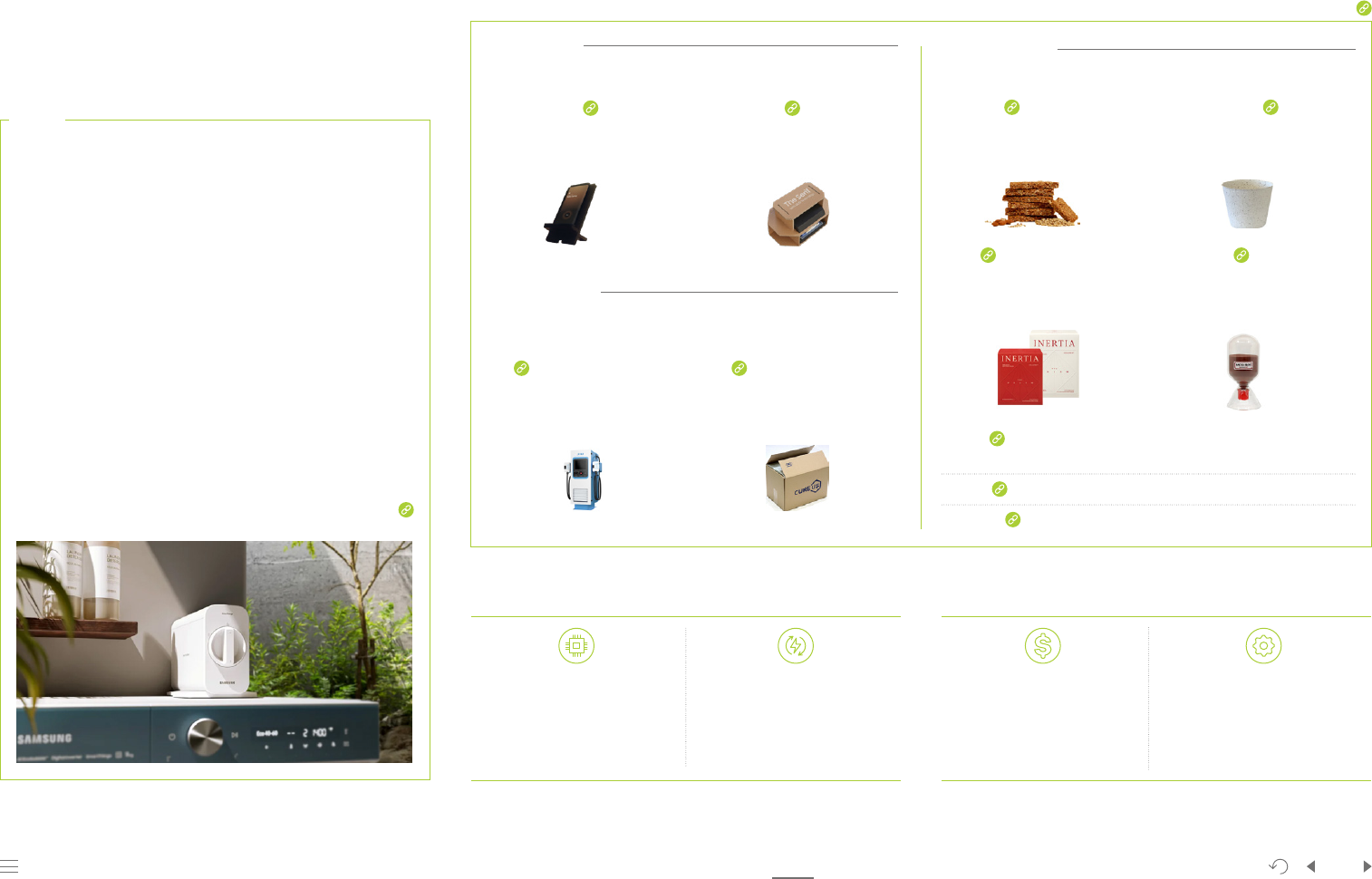
Our Company AppendixApproach to Sustainability Facts & Figures Principle
Planet
31
People
Samsung Electronics Sustainability Report 2023
Innovative Solutions for Environmental Challenges
C-lab Environmental Solutions
Through C-Lab, we discover and invest in innovative ideas inside and outside Samsung to tackle environmental issues.
Micro Plastic Reduction Technologies
To address the challenge of marine micro plastic pollution, we develop
technologies that can reduce the amount of microfiber released into
the ocean. In collaboration with Patagonia, we developed a wash
cycle that reduces microfiber emissions in our washing machines and
an external microfiber filter that can be applied to existing washing
machines.
C-Lab
Funding for Suppliers’ Net Zero Efforts and Investment
in Environmental Resources
Target Areas
· Zero emissions, renewable
energy, and resource circularity
technologies
Types of Support
· Funds for carbon emissions reduction
or environment and safety facilities
· Technological development funds
· Working funds
Expanding Investment in Prospective ESG Startups
Technologies related to zero
emissions, renewable energy, and
resource circularity
Technologies related to
high-efficiency, low-energy,
environmentally responsible
materials and parts
C-Lab Inside
Fostering creative ideas of our employees
Galaxy Upcycling
Recovering and upcycling unused
Galaxy smartphones
Eco-Packaging
Upcycling TV and home appliance
packaging into home decor items
C-Lab Spin-of f
Supporting the foundation of startups stemming from C-Lab Inside projects
EVAR
EV chargers using discarded batteries
and autonomous EV charging robots
AIMT
Insulators made with recycled PET
bottles
C-Lab Outside
Supporting growth of startups with potential for synergy with Samsung
60Hertz
:
Photovoltaic and wind power generation projection
technologies and virtual power station solutions
Bluelabs
:
Water purification agents made from oyster shells
Terra Block
:
Recycling solutions for waste plastic in lieu of incineration
Inertia
Biodegradable absorbers that do not
release micro plastics
QuantumCat
Catalysts for air purifiers and air
conditioning systems to remove
harmful gases
RE:harvest
Food upcycling solutions using
beer-brewing byproducts
Marine Innovation
Packaging solutions using marine
plant byproducts
In January 2023, at the Consumer Electronics Show (CES), Samsung
Electronics introduced a new washer with a Less Microfiber Cycle that
reduces emissions by 54 percent.
Samsung has now brought to market a Less Microfiber Filter that can
be attached easily to any existing front-loading washer. Ocean Wise has
verified that this filter reduces microfiber shedding by 98 percent. It has
been introduced into the Korean and European markets in June and will be
introduced in in North America in September 2023.
“We can’t thank Samsung’s people enough for the quality of both their
engineering and sustainability efforts, which have had support from
throughout the company—from the chairman to the seasoned engineers
to gifted younger employees who helped make this advance possible. A
collaboration between a global electronics giant and a company that touts
Earth as its sole shareholder may be an unlikely combination, but many
such collaborations are needed for the future.”
- Vincent Stanley, Director of Philosophy, Patagonia
CASE
See article
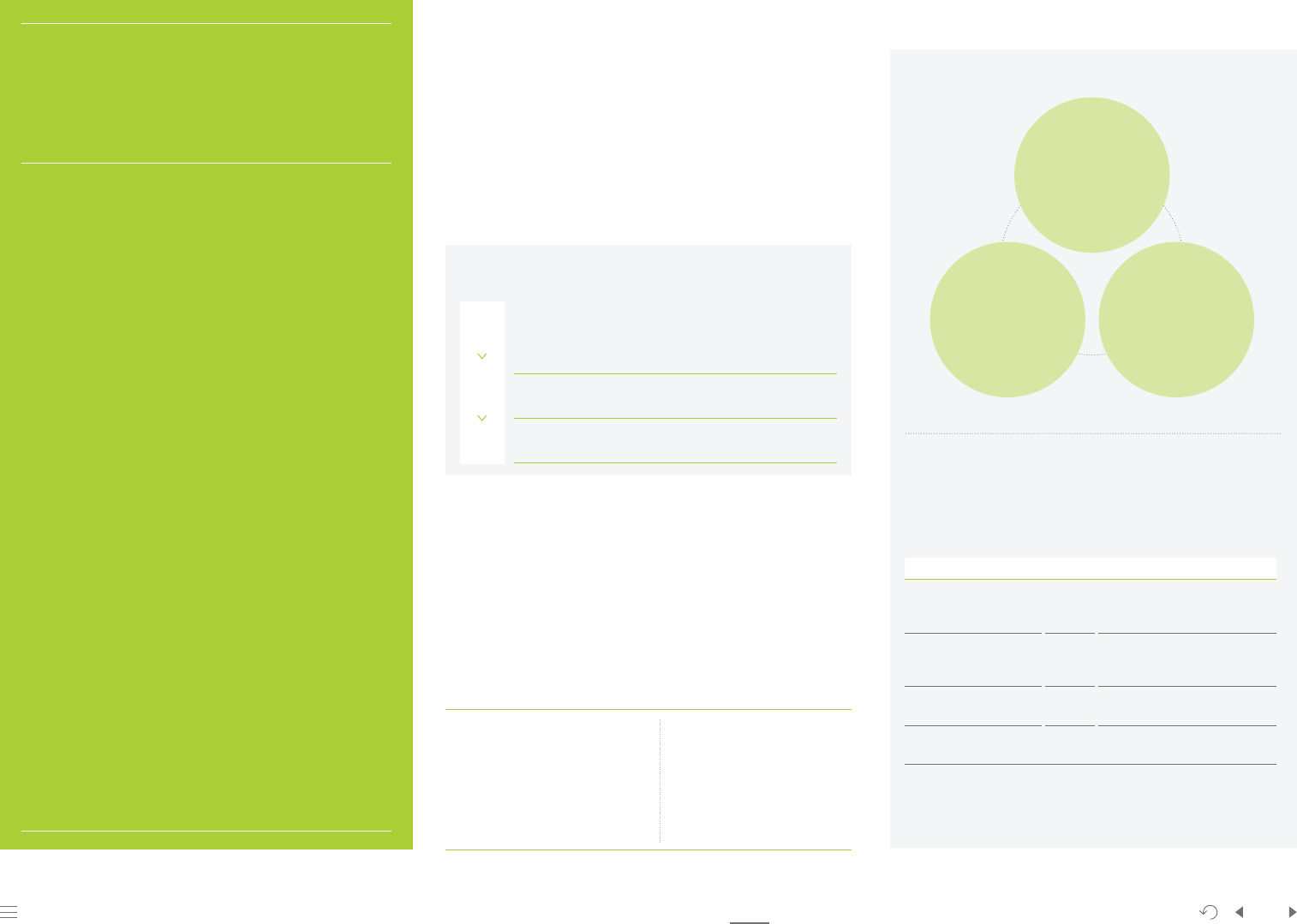
Our Company AppendixApproach to Sustainability Facts & Figures Principle
Planet
32
People
Samsung Electronics Sustainability Report 2023
Managing On-Site Waste
We strive to advance a circular economy by uncovering the added value
of waste and developing recycling technologies. By 2025, we aim to
attain the highest Platinum designation for all of our manufacturing sites.
We applied new technologies to our semiconductor manufacturing
sites to recycle Epoxy Molding Compounds (EMCs) and Clean Vacuum
(CV) dust, previously buried in landfills, to exceed the criteria for the
Platinum designation of Underwriters Laboratories (UL)’s Zero Waste-
to-Landfill program.
The planet’s resources are limited, and we cannot
afford to squander them. That's why we focus
on recycling resources throughout the product
development and manufacturing processes
as well as developing technologies that remove
pollutants. We endeavor to build a healthy and
safe working environment for all.
Sustainability in
Operations
Zero Waste-to-Landfill Mark
Our 23 manufacturing sites have obtained the Zero Waste-to-Landfill
mark* granted by Underwriters Laboratories. By 2025, we plan have all
of our manufacturing sites designated as Platinum.
* Zero Waste-to-Landfill program: This program assesses companies’ resource
circularity efforts and designates them in four grades: Platinum for 100% waste
diversion, Gold for 95-99%, Silver for 90-94%, and a Landfill Waste Diversion
Claim for 80% or higher. Decimals are rounded off to the nearest whole number
(99.5% recognized as 100%).
Platinum
Korea (Suwon, Giheung,
Hwaseong, Pyeongtaek, Onyang, and
Cheonan), China (Xian and
Suzhou(2)), Slovakia, Brazil (Campinas),
and India (Chennai)
Gold
Korea (Gumi and Gwangju),
US (Austin), Poland, Hungary,
Vietnam (Ho Chi Minh), Thailand,
Brazil (Manaus), and Mexico
Waste Recycling Goals and Status
Zero Waste-to-Landfill Mark and Waste Reduction Goals
Current Status
· Achieved Platinum of Zero Waste-to-Landfill at our semiconductor
manufacturing sites for the first time in the industry in 2021
· Reached 97% waste recycling rate at all semiconductor manufacturing sites
Before After
Discarded wood and outdoor
air control filters made with
complex materials
Incinerated
Recycling based on our material
separation and processing technology
Consumable wafer polishing
supplies contaminated with
potentially harmful substances
Incinerated
Recovering and recycling metals from
consumables
EMCs Buried
Recovering and recycling them into
new plastic materials
CV dust Buried
Recycling based on our metal recovery
technology for gold, tungsten, etc.
1) Epoxy molding compounds that are added in the final packaging stage to
protect semiconductor circuits from external shocks
2) Clean vacuum dust captured in semiconductor process equipment
Present
Roadmap for Obtaining the Highest Zero Waste-to-Landfill
Designation
Platinum designation of zero waste-to-landfill obtained by
DS manufacturing sites - first of its kind in the semiconductor
industry
* Excluding legally non-recyclable waste
‧
Zero Waste-to-Landfill mark to be obtained by all of our
manufacturing sites
‧
Platinum designation to be obtained by all of our
manufacturing sites
2023
2025
Attain Zero Waste-
to-Landfill mark for
all of our business
sites globally
Achieve 99.9%
waste recycling
rate by 2030 at our
semiconductor
manufacturing
sites
Reduce non-recyclable
waste to less than
2,000 tonnes by 2030
at our semiconductor
manufacturing sites
globally
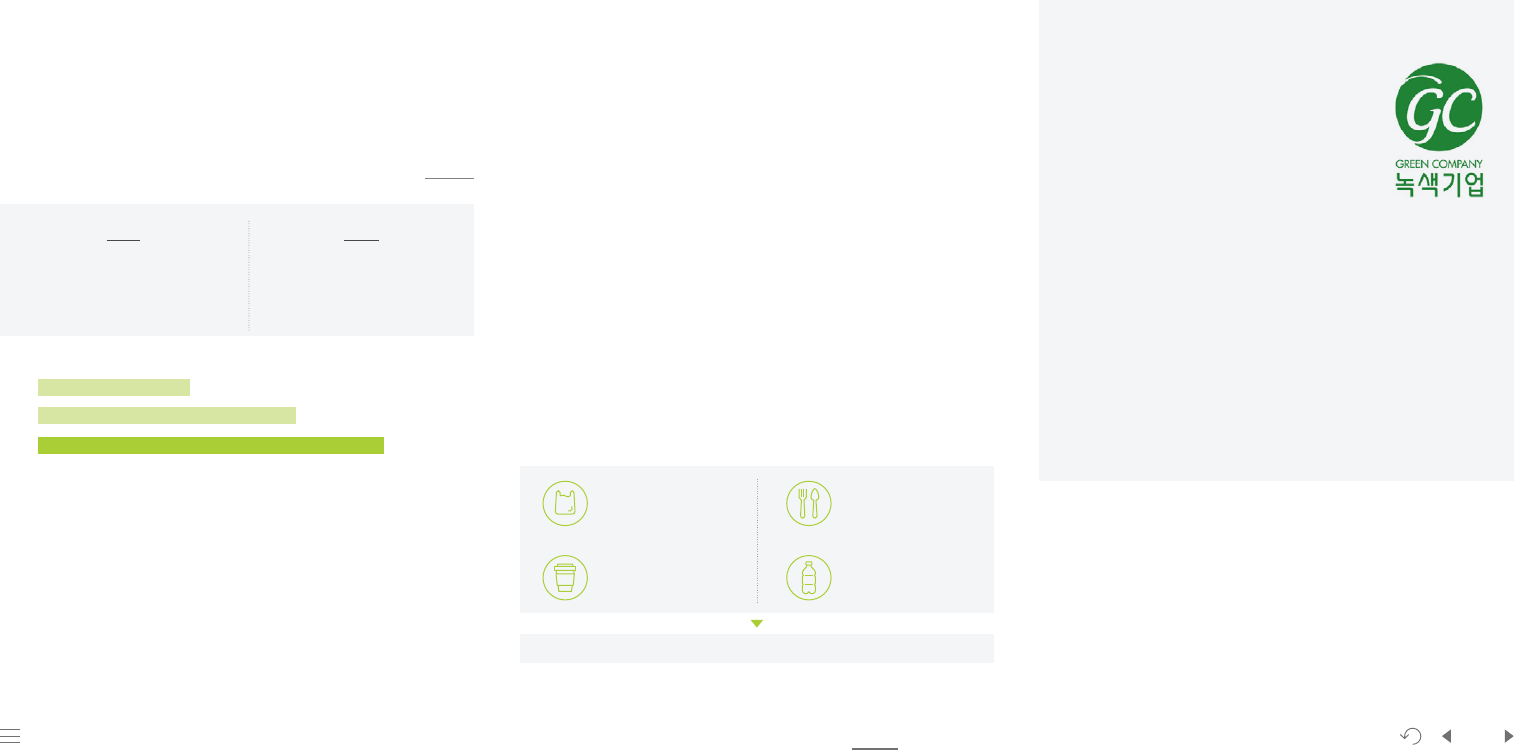
Our Company AppendixApproach to Sustainability Facts & Figures Principle
Planet
33
People
Samsung Electronics Sustainability Report 2023
Reinforcing Waste Sorting
We reinforced our waste sorting system to better recycle waste
generated from everyday activities on our premises in Korea. Since
2021, the Suwon and Gwangju business sites have installed 480 food
waste decomposing devices in the employee lounge to help recycle
both food waste and containers.
We have paper cartons collected on site recycled into toilet paper that
is donated to local welfare facilities. We encourage our employees to
take part in this activity by recognizing their participation as volunteer
work. We plan to engage more of our business sites in these activities
in the future.
Saving 36.0 million
disposable plastic
bags per year
Saving 53.7 million
pieces of disposable
tableware per year
Saving 5.0 million
disposable cups per year
Saving 10.5 million
PET bottles per year
Reducing the use of disposables by 866 tonnes per year
Recognition of Circular Resources
In December 2019, our Onyang business site became the first in the
industry to be granted the Recognition of Circular Resources by the
Geumgang River Basin Environmental Office. It also attained the
Quality Mark Certification for Circular Resources from the Korea
Environmental Industry and Technology Institute for the first time in
the industry in October 2020. The DS Division continues to expand the
range of certified items every year.
In 2021, the DS Division's business sites in Onyang (7), Cheonan (2),
Giheung (1), Hwaseong (1), and Pyeongtaek (1) were additionally
certified for recycled items including the 12-inch wafer box and three
nonferrous metals. This led to a reduction in waste generation by 2,227
tonnes per year.
In 2022, 14 items at the Onyang business site, including the cover tray,
and three items at the Cheonan business site, including paper tubes for
release film, were granted the Recognition of Circular Resources, which
contributed to reducing waste generation by 3,024 tonnes per year.
Sewage Sludge Recycling
In order to increase the added value of waste, we recover and recycle
copper from sewage sludge from the semiconductor manufacturing
process. We also developed technology to produce an alternative for
fluorspar required for steelmaking in collaboration with Hyundai Steel.
Sewage sludge, which used to be sent to cement factories, has now
become an important resource in many different areas.
Waste Reduction through Recognition of Circular Resources
* A type of film used for product protection
2020
1,351tonnes
2021
2022
2,227tonnes
3,024tonnes
2021
12-inch wafer box and three
nonferrous metals
2,227
tonnes
2022
Paper tube for release film*
and cover tray
3,024
tonnes
Suwon Business Site Recognized as an Outstanding
Green Company by Korea's Ministry of Environment
In December 2022, our Suwon business site received
the First Place Prize (Minister of Environment Prize)
for the Outstanding Green Company Awards in
recognition of its environmental practices.
Green Companies are designated among those
noted for their contribution to the environment after
a stringent review every three years, and among
the Green Companies, those with excellent performance is recognized as
Outstanding Green Company.
Our Suwon business site installed a photovoltaic power facility in
cooperation with Suwon City. We also try to minimize our environmental
impact and prevent accidents through establishing a chemicals
management system and air pollutant monitoring system, while focusing
on recycling waste and improving our suppliers’ ESG management
capacity.
We will continue to work closely with our suppliers and the local
communities to address climate change.
Raw Material and Energy Efficiency Improvement
We have introduced a more advanced injection molding process for
large-sized home appliances, thereby improving raw material use
and energy efficiency. The existing 12-plate mold for the rear parts
for 85-inch TV models and cover parts for 65-inch TV models was
simplified into a 6-plate mold, and this led to a weight reduction by
more than 18%. We also developed a cube mold for the door gasket of
our front-load washers. Whereas the manufacturing process previously
required eight 650-tonne injection molding machines, it now requires
only one 1,700-tonne injection molding machine, creating an effect
equivalent to reducing 785 tonnes CO
2
e per year.
In-House Waste Management System
Our in-house weighting systems (WMS and G-EHS) and legal system
(Allbaro) are interconnected for real-time data management. Alarms
for any errors are sent to the staff members in charge in real time for
an immediate response. We also introduced the Resource Circularity
Partnership Certification (Platinum, Gold, and Silver) that assesses
the environmental, safety, health, and financial performance of waste
disposal and processing companies. This led to the expansion of bidding
opportunities for more companies and improvement in performance
review efficiency.
Everyday Activities for In-House Waste Reduction
Eliminating the Use of Disposables at Our Business Sites
In order to bring the use of disposables on-premise cafeteria and cafés
in Korea down to zero by 2023, we distributed reusable bags to our
employees; started to replace disposable plates, bowls, and cups with
reusable ones; and began stocking beverage products in cans, glass
bottles, and paper packs instead of those in plastic bottles.
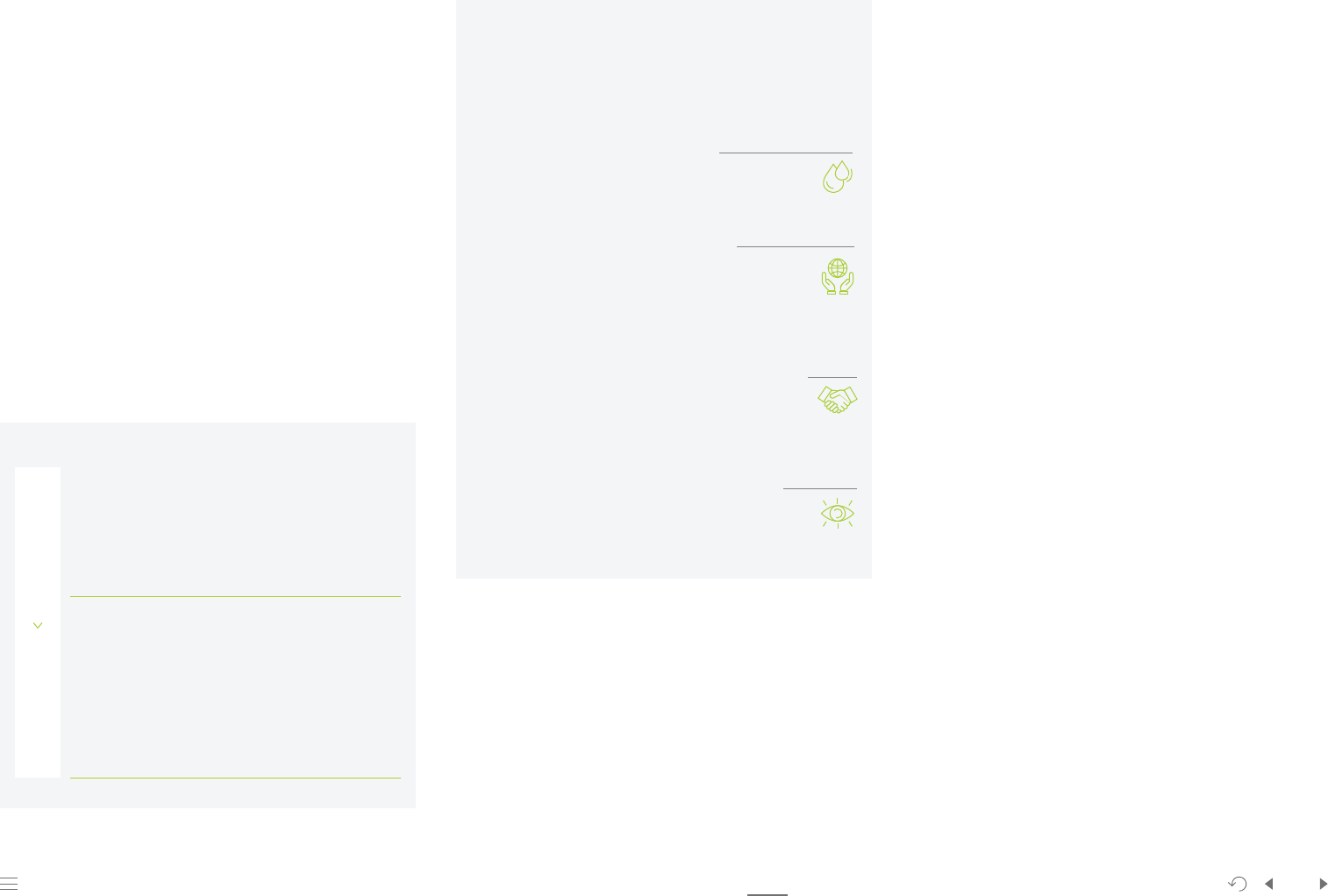
Our Company AppendixApproach to Sustainability Facts & Figures Principle
Planet
34
People
Samsung Electronics Sustainability Report 2023
Mission
We will recognize the importance of water resources in ensuring the
sustainability of our society and business operations and fulfill our
corporate social responsibility to preserve them.
Vision
We will strive to minimize water resource risks
in our business operations.
We will assess the impact of our business activities (production, etc.)
on water resources, minimize risks, and continually secure new technologies.
We will embed the importance of water resources
into our corporate culture.
We will uphold the conservation and sustainability of water
resources through our corporate culture so that our employees
responsibly manage them and give priority consideration to our
impact on the environment of the local communities we serve.
We will actively cooperate with external water resource policies.
Based on our relevant guidelines, we will actively cooperate with
the central and local governments and international organizations
to facilitate the establishment and implementation of their water
resource policies.
We will disclose our water resource policies and activities.
We will transparently share our policies and activities related
to water resources with our stakeholders, including local
communities.
Water Resource Conservation
Although most of our planet’s surface is covered with water, only about
1% is usable for humanity. The importance of water continues to grow
with increasing climate risks.
In this context, the DX Division set a goal of 100% water resource
restoration by 2030, returning the same amount of water consumed
back to local communities. Water is indispensable for many
manufacturing processes. While some amount is treated and returned
to nature, the rest is consumed. Water resource restoration is about
returning used water resources to local communities and minimizing
our environmental impact.
In December 2022, we concluded an MOU with Korea Rural Community
Corporation on securing water resources for rural communities
suffering from chronic water shortage and seeking solutions to the
climate crisis.
We plan to focus on minimizing the impact of over 20 manufacturing
sites around the world on water resources and thereby promote the
wellness of local communities.
Mission and Vision of Water Resource Management
Alliance for Water Stewardship (AWS)
We were rated the highest grade of Platinum by AWS. AWS is a
water management certification body established by international
organizations including the UN Global Compact Network and CDP.
AWS certification rates water-using sites as Platinum, Gold, or Core
based on assessment across 100 indicators including stable water
management, water pollutant management, water hygiene, domestic
impact of biodiversity, and governance. Our Hwaseong business
site was granted AWS certification after separately meeting the
highest Carbon Trust's standard by reducing water usage in 2020,
accomplishing the feat of being certified by the two most authoritative
initiatives for water management for the first time in the industry. We
plan to attain AWS certification for all of our major business sites in
Korea and other regions.
Water Resource Management Procedures
We categorize water resources into used water, wastewater, process
water, and ultra-pure water to increase the reutilization rate of water
used for manufacturing.
Each business site is required to calculate the amounts of reused
water in each category on a monthly basis and record them in the
Global Green Management System for company-wide environmental
information management.
Water Management of Our Suppliers
The DX Division focuses on water management within our supply
chains as well. We are pushing ahead with the plan to initiate a water
resource management improvement consortium that performs
RBA(Responsible Business Alliance) assessments of our suppliers,
reviews WASH (water, sanitation, and hygiene) services, and provides
consulting on water resource treatment facilities.
Cooperation with Our Stakeholders
We work to protect and improve the water resources near our business
sites in systematic collaboration with our stakeholders. Our Gwangju
business site formed a climate crisis response committee with the city
government of Gwangju to provide potable water to socially vulnerable
groups and support net zero activities across our supply chains.
Each business site communicates actively with local governments,
NGOs, and local residents for environmental conservation.
2030
Water Resources and Air Quality Management Roadmap
Achieve zero increase in the DS Division’s water intake
* Reuse effluent water from public sewage treatment facilities, etc.
Replenish water 100% for the amount used globally by
the DX Division
* Expand water reuse and operating projects to offset the amount
used
Treat pollutants from emissions and water discharged
from our semiconductor manufacturing sites to restore
them to natural level quality
* Develop new technologies required for such treatment and
restoration
2040
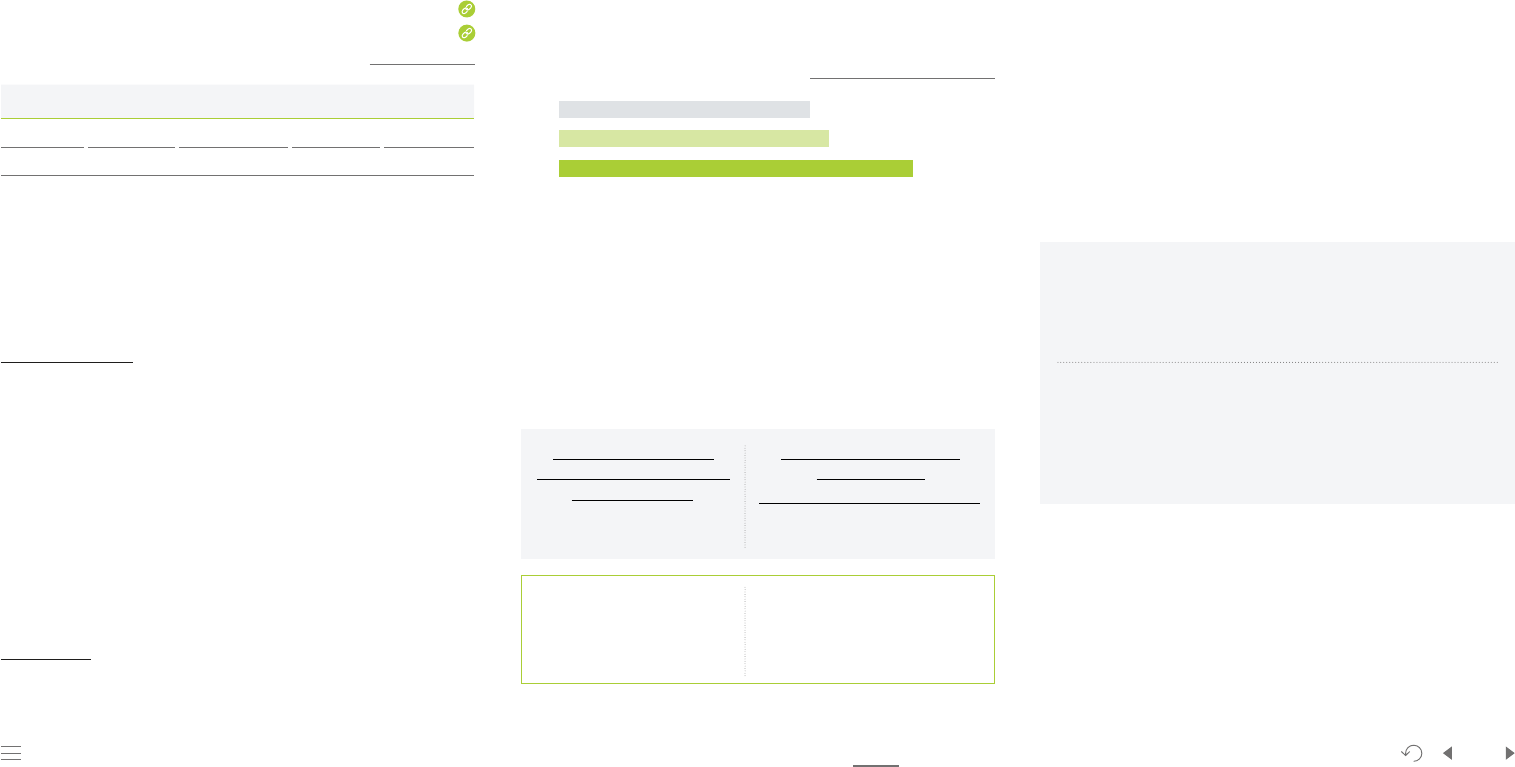
Our Company AppendixApproach to Sustainability Facts & Figures Principle
Planet
35
People
Samsung Electronics Sustainability Report 2023
Water Stress Management at Our Semiconductor Manufacturing Sites
We ensure optimal water resource management at our semiconductor
manufacturing sites, which require large amounts of water for their
operations, based on the analysis of region-specific water stress.
Site in China (Xian)*
L
ocated in a region with “extremely high” water stress (over 80%)
·
Categorizing wastewater into three categories - acidic, alkaline, and
fluoric - and reusing them separately
·
Water treated to meet internal standards through activated charcoal
filtering, acid-base neutralization, coagulating sedimentation, reverse
osmosis filtering, etc., to be reused for cooling towers, gas process
facilities, and plants
·
Most of the cooling water for equipment uses recycled water
* The Xian site was assessed to have low water resource risks based on our internal
standards but was categorized as “extremely high” in World Resources Institute
(WRI)'s water stress analysis.
Sites in Korea
Located in regions with “medium-high” water stress (20-40%)
Business Sites Facing Water Resource Risks (as of 2022)
Category
Unit Number of sites Water intake Outflow
All
1,000 tonnes 32 172,811 136,118
Sites at risk 1,000 tonnes 12
*
131,444 104,059
* Number of sites in countries facing water resource risks: 9 in Korea, 1 in India, 1 in
Poland, and 1 in Egypt
Minimizing the discharge of water pollutants
· Reducing the use of chemicals
· Developing alternatives for harmful substances
· Improving the efficiency of the wastewater treatment process
Reducing major ion chemicals (sulfuric acid, chlorine, and
fluorine)
· Developing chemical filters
· Improving the process
· Securing crystallization technology
Water Quality Management
Minimizing the Discharge of Water Pollutants
We apply our pollutant reduction technologies to all of our
semiconductor manufacturing sites and assess the quality of nearby
rivers at least six times a year. For the river water quality assessment,
we monitor both upstream and downstream of the outlet to ensure
accuracy. We perform analyses pursuant to the Process Testing Act of
the Ministry of Environment and apply our internal standards, which
are stricter than the legal requirements, to the quality of treated
wastewater when discharging directly into rivers.
We manage pollutant concentration, temperature, ecotoxicity, among
others, through our internal standards that are stricter than the legal
requirements. We disclose the discharge amounts of general pollutants
(COD, SS) and calculate the discharge amounts of sulfate ion, chlorine
ion, fluorine and T-N based on their real-time discharge concentration
levels and water analysis data. We share our technologies and activities
through the Environmental Conservation Committee held every two
months and aim to drive the concentration of pollutants in our effluent
water lower than that of the upstream by 2040.
CDP Climate Change Report
Water resource risk response strategy by region
Water Resource Risk Assessment
We annually assess whether the locations of our business sites are
within regions affected by water stress or water scarcity and develop
countermeasures.
We identify water-stressed regions using the tool developed by the
Food and Agricultural Organization (FAO) and assess the water stress
and ten-year water risks that water basins near our business sites
face using the tools developed by the World Business Council for
Sustainable Development (WBCSD), World Wildlife Fund for Nature
(WWF), and World Resources Institute (WRI).
We also establish and implement risk-specific response measures
based on CDP’s water security guidance.
Clean Water Supply and Management
We stringently manage the volume and quality of water supplied to
our business sites. Wastewater generated from our business sites is
monitored in real time, with regular composition analyses performed,
to ensure the supply of clean water for all stakeholders that share river
basins with us.
Our Efforts to Maximize Water Reuse
Our semiconductor manufacturing sites have succeeded in reducing
the amount of water used by altering process control values and
wastewater treatment methods and optimizing their operations.
We maximize water reuse by improving our overall manufacturing
processes and reuse systems and by reusing of low density waste
water at our Pyeongtaek site (UPW filtered water reuse). We also plan
to reuse water discharged from public sewage treatment plants.
Average daily reduction of
water use at our semiconductor
manufacturing sites
30,000
tonnes
Total amount of reused water
increased by 29%
compared to the previous year (2022)
116.59
million
tonnes
Everyday activities
· Optimizing site operation
· Replacing outdated equipment
· Improving operation standards
Structural improvement
activities
·
Improving manufacturing processes
· Establishing recycling systems
Amount of Reused Water (unit: 1,000 tonnes)
2020
70,181
2021
2022
93,949
116,590
·
Categorizing water used for manufacturing into six groups based on
our internal standards to purify each using the optimal technologies
·
Filtering pollutants through biological treatment, chemical treatment,
and physical treatment using filters and collecting purified water in a
tank for combined discharge
·
Assessing the quality of effluent water in real time prior to discharge
and reporting the results to the government
Reducing Water Consumption and Scaling Up Water Reuse
We continually reduce our water intake by maximizing the reuse
of water used for manufacturing. Due to the expansion of our
semiconductor manufacturing lines, the required amount of water
intake per day will more than double by 2030 compared to 2022.
However, we plan to maintain water intake at 2021 levels by expanding
water reuse.

Our Company AppendixApproach to Sustainability Facts & Figures Principle
Planet
36
People
Samsung Electronics Sustainability Report 2023
Surface water
172,113
Underground water
698
Discharged into river
Source of supply
Water Resource Flow Chart (2022) (unit: 1,000 tonnes)
Off-site treatment
facilities
72,176
Discharged into sewage
treatment plant
Manufacturing process
Multifaceted Defense against Water Pollution
We remain prepared for any possible accidents related to wastewater
treatment. We are equipped with triple-tier interlocks between the
infiltration, processing, and discharge stages at our wastewater
treatment facilities. Each interlock is activated to initiate an emergency
recovery of wastewater when the pollutant concentration is assessed to
exceed our standards.
Triple-tier interlock
system for each stage
at our wastewater
treatment facilities
Infiltration
stage
Processing
stage
Discharge
stage
Stakeholder Engagement
We organize events that engage stakeholders of
the river basins nearby our business sites in Korea
and other regions every year. We conduct basin
area cleaning campaigns in collaboration with
local governments, NGOs, and local residents
and provide potable water to socially vulnerable
groups with limited access to clean water. We have
engaged in MOUs with local governments and
NGOs to conserve rivers, analyze risks related to
the nearby river basins, and seek solutions.
Supporting Access to Clean Water
Clean water is essential to ensuring the quality of
life. This is why we engage in a range of activities
to improve access to clean water around the world.
Our subsidiary in Indonesia installed a water
purification facility in a remote village with poor
access to clean water. The village is considerably
distant from the nearest river, which is not suitable
for drinking. Our subsidiary’s support contributed
to enhancing the health of the village residents.
Improving Awareness on WASH*
We
strive to improve all stakeholders’ awareness
on the importance of water and hygiene. We
offer training on water, hygiene, and health for
our employees, their families, students of nearby
schools, and local residents and engage them in
relevant activities.
*Water, sanitation, and hygiene
Communication with Community Stakeholders
On-site treatment
facilities
63,942
Reuse
116,590
Samsung Electronics

Our Company AppendixApproach to Sustainability Facts & Figures Principle
Planet
37
People
Samsung Electronics Sustainability Report 2023
Improving Ecosystem Health
We regularly measure key indicators of water quality - including
chemical oxygen demand (COD), biochemical oxygen demand (BOD),
and potential hydrogen (pH) - at our manufacturing sites in Korea to
manage the potential impact of our operations on nearby freshwater
ecosystems. We also monitor wildlife inhabiting the region and take
steps to ensure wildlife conservation.
Monitoring Freshwater Ecosystems
To protect biodiversity, we regularly monitor and identify our impact
on nearby freshwater ecosystems, terrestrial ecosystems, ecotoxicity,
and wildlife habitats pursuant to the Guidelines on the Examination
of Current Status and Health Assessment of Aquatic Ecosystems
1)
.
We perform diverse ecosystem improvement activities based on the
findings.
1) National Institute of Environmental Research Notification 2019-52 (enacted on
December 1, 2019)
Woncheon-ri Stream near Hwaseong
Measured by
Kyung Hee University
Fishes
14 species of 3 families (high dominance of Freshwater
minnow and Goby Minnow)
Freshwater Benthos
24 species of 16 families (high dominance of aquatic
insects)
Birds
29 species
Mammals
8 species (traces of Eurasian Otter [Endangered Species
level I] and leopard cat [Endangered Species level II]
observed in the downstream of the effluent water outlet)
Osan Stream near Giheung
Measured by
Korea Ecology and Environment Institute and Osan office
of the Korean Federation for Environmental Movement
Fishes
16 species of 8 families (high dominance of crucian carp
and bluegill [invasive alien species])
Freshwater Benthos
54 species of 37 families (high dominance of aquatic
insects)
Birds
65 species (including 8 legally protected species of
long-billed ringed plover [Endangered Species level II],
Eurasian spoonbill [Endangered Species level II], and
Common Kestrel [natural monument], etc.)
Ecotoxicity
Effluent water found to have no ecotoxicity on the stream
based on the results of acute toxicity testing on water fleas
Air Pollution Management
Reducing Air Pollutants
By 2040, we aim to restore air to their natural state with minimal
environmental impact prior to their discharge.
We apply the best available technology to treat pollutants generated
during manufacturing and manage emissions using our multi-tier
treatment system. In addition, we develop and employ technologies
to further advance our treatment system to reduce NOx emissions –
including installation of De-NOx facilities, introduction of ultra-low NOx
burners, and replacement of steam-producing equipment in boilers.
To strengthen our emergency response capabilities, we have installed
preventive facilities and operate real-time monitoring systems at our
manufacturing lines.
Managing Seasonal Fine Dust
As part of a voluntary seasonal fine dust management program –
from December 2022 to March 2023 – hosted by Korea’s Ministry
of Environment, we strengthened our target for nitrogen oxide
concentration by 10% compared to the national standard and optimized
the operations of preventive facilities. We continue to manage the air
quality of our surrounding environment to ensure the health of our
employees and local residents.
Biodiversity Restoration and Conservation Activities in the
Osancheon Stream
We discharge 45,000 tonnes of purified effluent water per day into
Osan Stream, which has contributed to improving the local ecosystem.
As evidence of these improvements, it is now inhabited by Eurasian
Otters (Endangered Species level I and and natural monument). In 2022,
we performed an extensive examination of the habitat distribution
of otter near Osan Stream and Woncheon-ri Stream and discovered
the habitats of other wild animals including leopard cat (Endangered
Species level II) raccoon dog, and water deer.
In addition to water quality and ecosystem monitoring, we conducted
campaigns to release endemic fish species, eliminate invasive species
in the local ecosystems, and remove water pollutants. We also
sponsored the creation of the Osan Stream Butterfly Path aimed at
protecting the endangered dragon swallowtail.
Wildlife near Osan Stream Wastewater Outlet
Eurasian Otter Leopard cat
Water deer
Seojeong-ri Stream near Pyeongtaek
Measured by
Pyeongtaek University
Fishes
16 species of 6 families (high dominance of Freshwater
minnow and crucian carp)
Freshwater Benthos
30 species of 22 families (high dominance of aquatic insects)
Ecotoxicity
Effluent water found to have no ecotoxicity on the stream
based on the results of acute toxicity testing on water fleas
Gokgyo Stream near Onyang and Cheonan
Measured by
Kyung Hee University
Fishes
19 species of 6 families (high dominance of Freshwater
minnow and crucian carp)
Freshwater Benthos
49 species of 36 families (high dominance of aquatic insects)
Birds
38 species (long-billed ringed plover [Endangered Species
level II])
Mammals
8 species (traces of Eurasian Otter [Endangered Species level I]
and leopard cat [Endangered Species level II] observed)
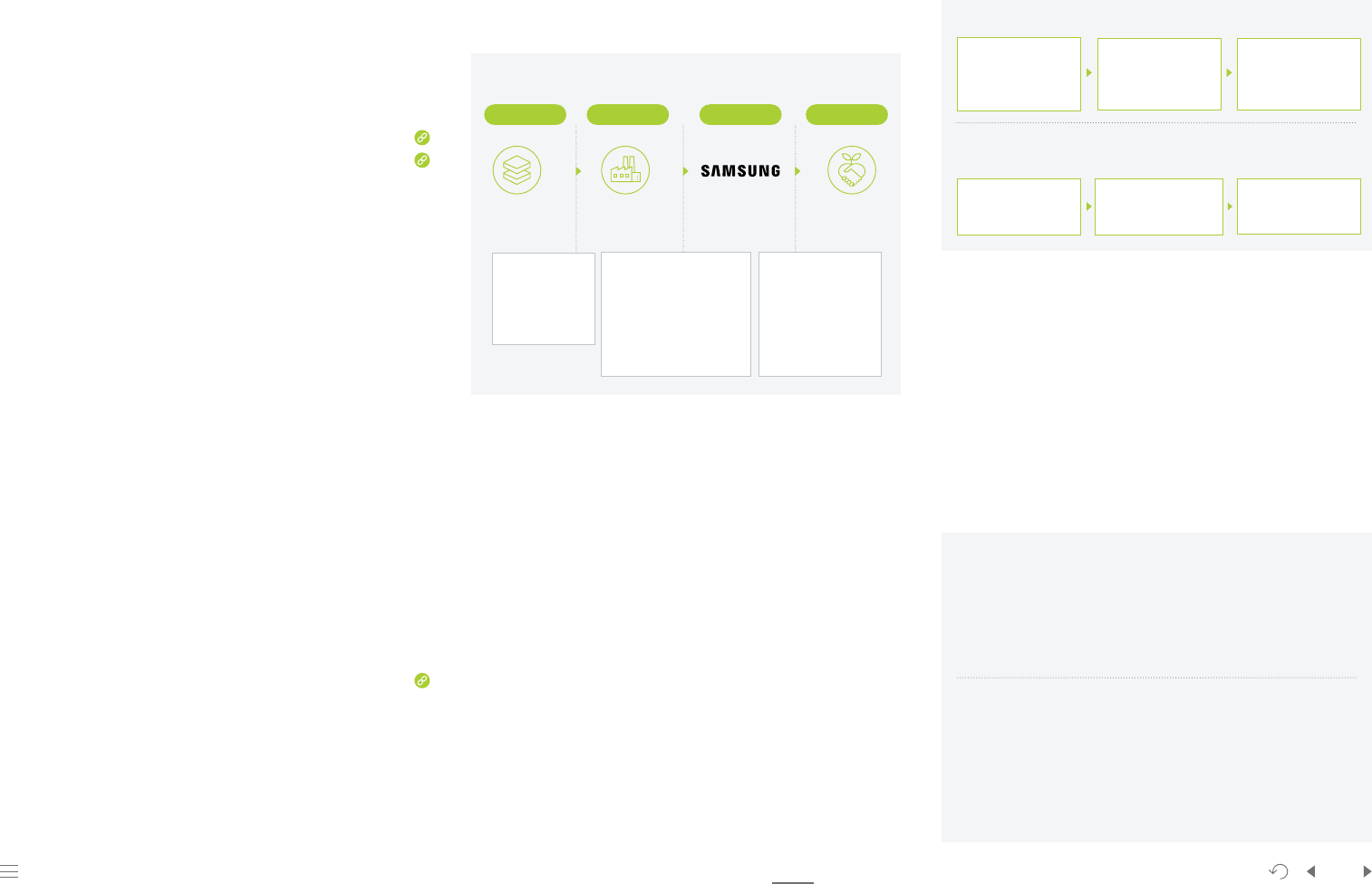
Our Company AppendixApproach to Sustainability Facts & Figures Principle
Planet
38
People
Samsung Electronics Sustainability Report 2023
Reinforcing chemical control
· Automating chemical injection
· Securing firefighting and disaster prevention equipment
· Installing discharge walls
· Conducting extensive equipment inspections
· Establishing a system for early detection of and response to leakage
Minimizing leakage risks
· Establishing a system to detect and respond to leakage at different points
including building interiors and exteriors, rainwater drainage pipes, and
outer fences
·
Focusing on research related to chemical mixing risks to prevent relevant accidents
· Establishing a chemical mixing prevention system
· Reinforcing standards of construction and work with respect to chemicals
Managing Potentially Hazardous Substances in Our Products
We are equipped with a rigorous pre-inspection and follow-up
management system for parts and raw materials. We established the
Standards for the Control of Substances Used in Products based on global
standards and voluntarily perform plans to reduce the use of potentially
hazardous and legally regulated substances such as polyvinyl chloride,
brominated flame retardants, beryllium, and antimony.
Eco-Life Lab
We opened the Environmental Analysis Lab in 2004, which was initially
dedicated to monitoring six substances regulated by the EU’s RoHS
1)
and continued to expand its range of potentially hazardous substances
subject to monitoring. The Lab was expanded into the Eco-Life Lab in
2020 to further reinforce this system, with additional test chambers and
cutting-edge equipment introduced for microorganism analysis.
The Eco-Life Lab engages in diverse research projects aimed at identifying
the fundamental causes of odors that may occur while using our products
and seeking improvement measures. The Lab’s expertise and credibility
have been recognized by attaining certifications from Korea Laboratory
Accreditation Scheme (KOLAS) and TÜV Rheinland, Germany’s renowned
testing service provider.
1) EU RoHS: EU Restriction of Hazardous Substances Directive
Our Chemical Substances Management History
Chemical Substances Management
We strive to minimize the impact of harmful substances that may enter
our products, as well as chemicals used in the frontlines of manufacturing,
on the health of our customers and employees. Our internal regulations
are stringently managed according to global standards, including
the Restriction of Hazardous Substances (RoHS) Directive and the
Registration, Evaluation, Authorization, and Restriction of Chemicals
(REACH) Regulation of the EU and the Toxic Substances Control Act (TSCA)
of the US.
Standards for the Control of Substances Used in Products
REACH Declaration for Substances of Very High Concern
Managing Harmful Substances in Our Supply Chains
Our supply chain review and management systems are designed to help
our suppliers actively engage in responsible substance management
practices. All of our product and parts suppliers are subject to Eco-
Partner Certification evaluations. Each supplier is required to submit
data obtained from its raw material providers and product environment
reports that guarantee the credibility of potentially hazardous substance
information. We provide certifications to those companies evaluated to
have complied with the Standards for the Control of Substances Used in
Products and possess an advanced environment and quality management
system. Only the certified companies are included in our supply chains.
Eco-Partner Certification Process
Step1
Raw
materials
Step3
Samsung
Electronics
Step4
Eco-Partner
certification
Step2
Suppliers
1. Extensive
data analysis
2. Chemical
composition
table (MSDS)
1. Product environment
warranty
2. Extensive data analysis
(ICP and GMS data)
3. Chemical composition
table (MSDS)
4. Samples for approval
1. Review of
submitted
documents and
samples
2. Environmental
management
system evaluation
Pre-inspection
An expert group
is commissioned
to perform a pre-
inspection.
The expert group
gives approval.
Chemicals are
purchased.
Chemicals are
brought in.
The amount used
and inventory are
identified.
Used chemicals are
discarded.
Tracking the Entire Process
Used chemicals are safely discarded through our preset
procedures.
Chemicals Management Process
We manage all chemicals-related activities from purchasing to disposal
via our strict system to ensure safety.
Reinforcing Chemical Control at Our Semiconductor Sites
To minimize any damage from potential accidents, we reinforced the
chemical control at all facilities on the premises of our semiconductor
sites. Each site is required to monitor environmental regulations by
conducting assessments of the impact of legal regulations and pre-
inspections of chemical substances. All tasks are assessed in advance
for any potential risks and applied with differentiated on-site safety
management levels accordingly. Automated and unmanned systems
were introduced for tasks that deal with chemicals and require working
at heights to eliminate safety risks. The content of harmful substances in
raw materials (wafers) and supplementary materials (PCB, EMC, etc.) are
also strictly managed in compliance with international standards.
On-Site Chemicals Management
Improving Preparedness for Chemical Regulations
As chemical regulations and standards vary by country and continue to
be reinforced and updated, we are required to take a more systematic
approach to effectively manage chemicals. In 16 countries in which
we have manufacturing sites, including China, Vietnam, and India,
we regularly review the relevant laws and reflect the findings in our
chemical substances management standards and database to minimize
related risks.
We have also enhanced our system to readily identify whether internally
regulated substances are contained in any chemical products that our
employees intend to use and perform testing on such chemicals.

Our Company AppendixApproach to Sustainability Facts & Figures PrinciplePlanet
39
People
Samsung Electronics Sustainability Report 2023
People
Our Company AppendixApproach to Sustainability Facts & Figures Principle
Planet
39
People
44
Human Rights
54
Human Resource
Management
59
Diversity, Equity,
and Inclusion
64
Tech for All
74
Sustainability
in Supply Chain
87
Empowering
Communities
Samsung Electronics Sustainability Report 2023
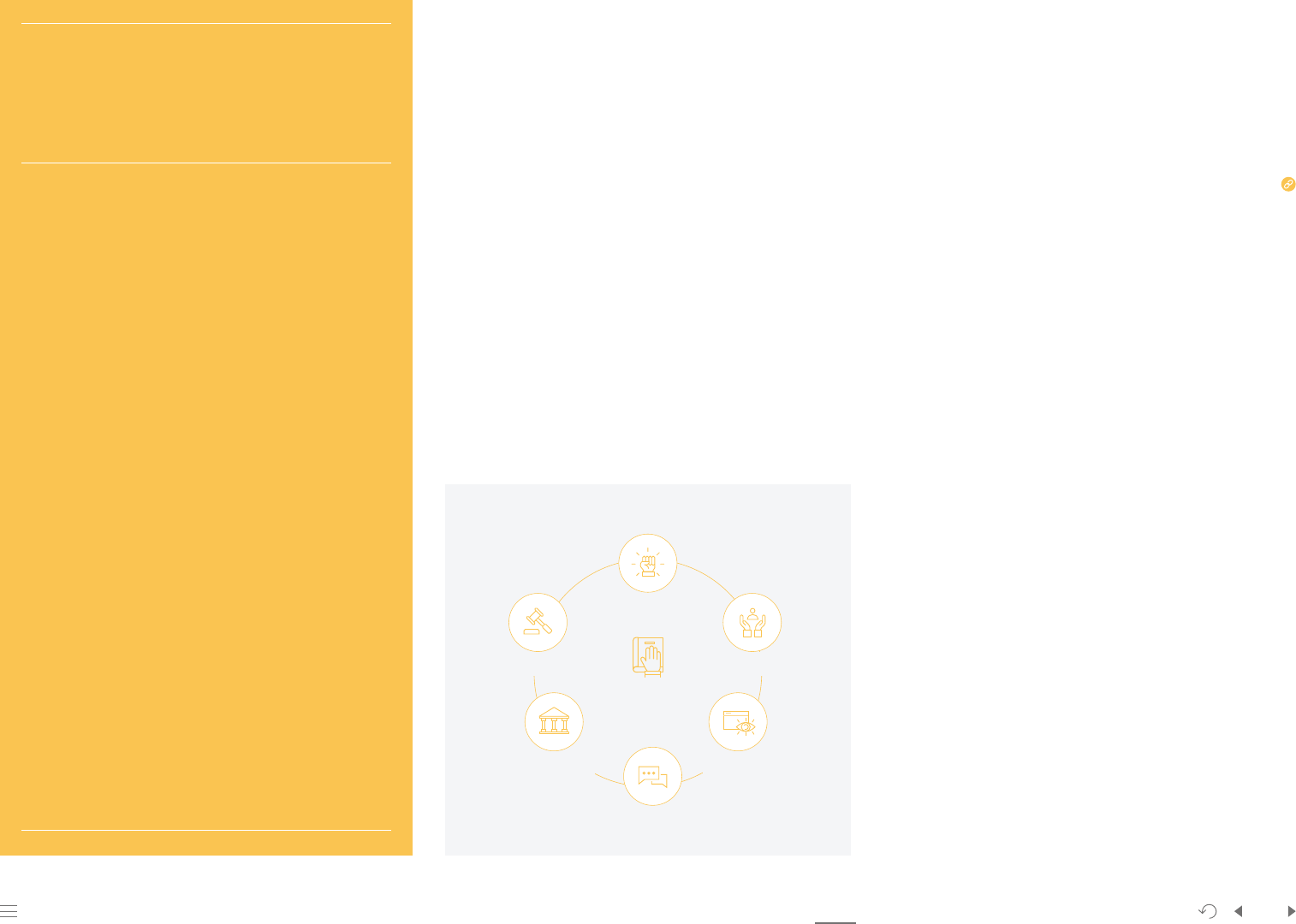
Our Company AppendixApproach to Sustainability Facts & Figures PrinciplePlanet
40
People
Samsung Electronics Sustainability Report 2023
Commitment to Respect Human Rights
We are committed to respecting the human rights and freedom of all.
We endorse the principles enshrined in with the Universal Declaration
of Human Rights; International Covenant on Civil and Political Rights;
International Covenant on Economic, Social and Cultural Rights; ILO
Declaration on Fundamental Principles and Rights at Work; United
Nations Guiding Principles on Business and Human Rights; and OECD
Guidelines for Multinational Enterprises, while also practicing respect
for human rights in our everyday business activities based on the
Convention on the Rights of the Child and Protocol to Prevent, Suppress
and Punish Trafficking in Persons, Especially Women and Children, and,
at a minimum, the laws of the countries in which we operate. Where
Samsung faces conflicts between internationally recognized human
rights and national laws, including in cases where national law does
explicitly prohibit adherence to core labour standards, we seek ways to
respect the higher standard.
Our Labor and Human Rights Framework consisting of policies, due
diligence, access to remedy, stakeholder engagement, transparency &
reporting and governance is the foundation of our approach to respect
human rights.
Human Rights Policies
We have a range of human rights policies in place, which reflect our
organization’s commitment to fulfilling our responsibility to respect
and support internationally recognized human rights standards. These
policies stipulate how we realize our commitment to respect human
rights and what our expectations are of our employees, suppliers,
partners, and other stakeholders.
Global Human Rights Principles
In February 2023, we announced our Global Human Rights Principles
(the Policy) that highlight our respect for human rights in line with
international standards such as the UN Guiding Principles on Business
and Human Rights (UNGPs). The Principles consolidate all of the
commitments made in our existing policies and reaffirm our promise to
prevent human rights abuses and to take effective remedies for those
affected if and where our business activities caused or contributed to
any harm.
Through the Policy, we disclose our salient human rights risks for
the first time, which have been identified through our continuous
engagements with internal and external stakeholders, internal
assessments, third-party audits, human rights risk assessments,
human rights impact assessments, and grievance channels. Through
these Principles, we also enhance commitments in the areas of product
responsibility; freedom of expression; and the recognition of a clean,
healthy, and sustainable environment as a universal human right.
We expanded the scope of our commitment to human rights to
encompass the wider set of rights-holders, who are potential and
actual affected individuals and groups, including local communities,
partners, consumers, and external stakeholders, in addition to the
employees of our own operations and the workers in our supply
chains. The Principles was informed by internal experts and external
stakeholders such as nonprofit organizations and intergovernmental
organizations to remain comprehensive and align with international
standards and principles.
We will strive to raise awareness and promote the proper implementation
of the Principles through the provision of relevant guidelines, training,
and other capacity-building activities.
Samsung Human Rights Principles
Labor and Human Rights Framework
Governance
Stakeholder Engagement
Transparent
Disclosure
Remedial Action Policies
Due Diligence
Rights and
Implementation
Principles
Respect for human rights is embedded in our business
operations based on our business philosophy “People
First.” We also continue to take steps to build a safer and
healthier work environment.
Human Rights
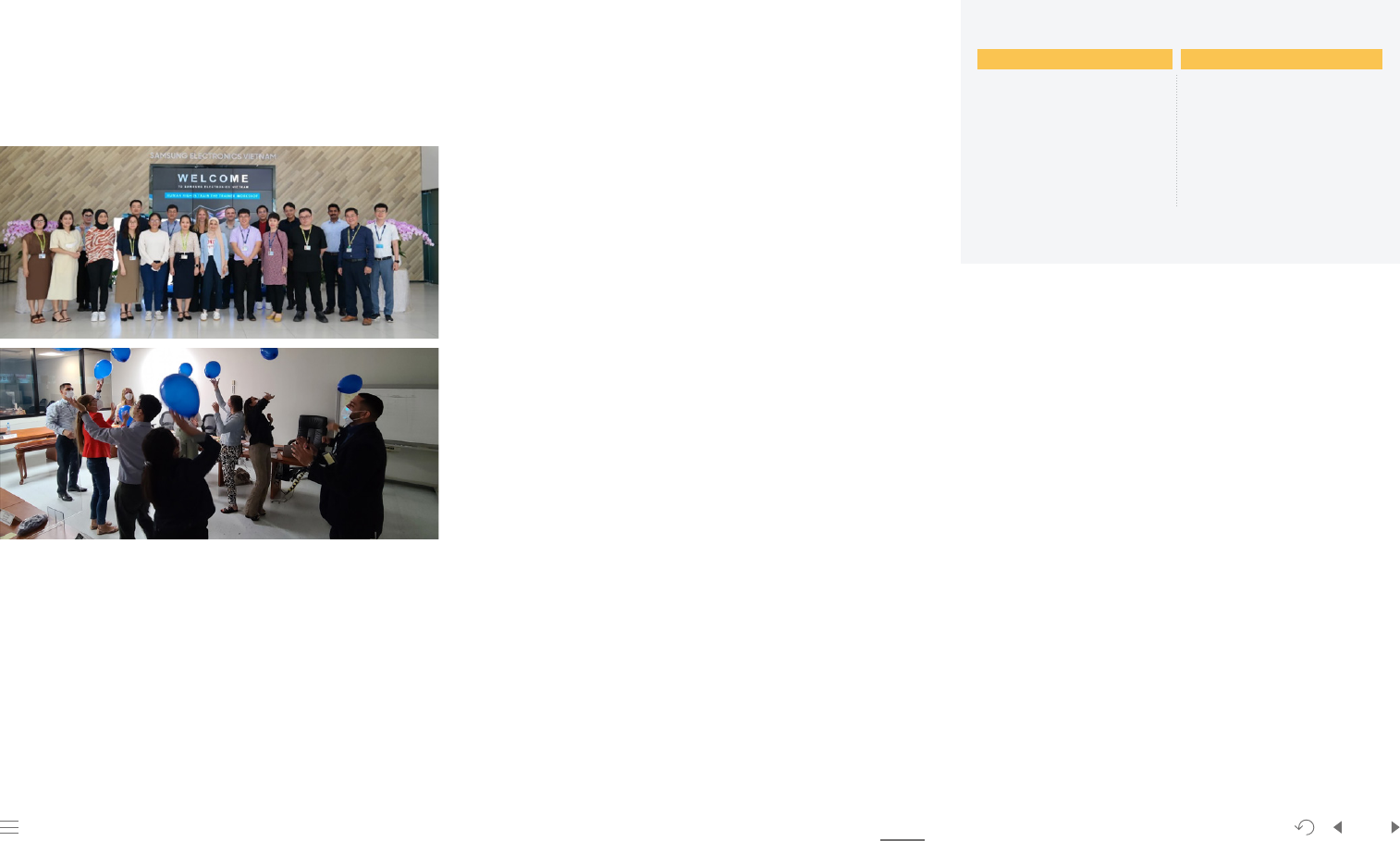
Our Company AppendixApproach to Sustainability Facts & Figures PrinciplePlanet
41
People
Samsung Electronics Sustainability Report 2023
Capacity-Building
To help our employees understand their rights and implment respect
for human rights in their everyday activities, every year we conduct
labor and human rights training tailored to different target groups.
We launched a specialized human rights training for our employees
in 2018 and, in collaboration with Business for Social Responsibility
(BSR), developed it into a comprehensive program that offers targeted
training for different employee groups in 2020.
The program consists of training for all employees, training for those
responsible for human rights-related tasks, and training to develop
Human Rights Champions.
Train-the-Trainer Workshop
Our train-the-trainer workshop is a training and peer learning platform
designed to help our human rights trainers expand their knowledge
base, learn best practices from their peers in other regions, and
improve their capacity to deliver training.
In July 2022, we held two train-the-trainer workshops in Mexico and
Vietnam transferring knowledge and training techniques to 22 trainers
from 15 subsidiaries. Each workshop dealt with companies’ duty to
ensure respect for human rights, relevant legal requirements and
stakeholders expectations, our Labor and Human Rights Framework
and activities in each area, an in-depth analysis of our salient human
rights risks, and the approach to human rights due diligence over the
course of two days. In addition to the theoretical contents, practical
discussions took place to share implications of previous human rights
impact assessments and human rights risk analysis and best practices
regarding the responsible employment practices of migrant workers,
grievance channels, local capacity-building initiatives, stakeholder
engagement, mental health services, and employee engagement.
The trainers who participated in the workshops then delivered human
rights trainings for production workers as well as other in-house
trainers. These in-house trainers will, in turn, share their knowledge
with production workers at large sites.
Human Rights Training for All Employees
We develop and offer human rights training for manager-level
and working-level employees. The manager-level training in 2022
was organized for those in leadership roles at our regional offices,
production sites, R&D centers, and sales offices. It dealt with the
updates on global laws and regulations in relation to companies’
responsibilities to respect human rights, stakeholders’ expectations,
our commitments and practice on human rights, and access to the
grievance channels. The working-level training delved into our
commitments on human rights, their significance for our employees,
and accessibility to our grievance channels with a focus on our
employees’ rights. Employees at our production sites received offline
Human Rights Champion Training
We have Human Rights Champions at our subsidiaries, who act as
human rights trainers and help to further integrate a human rights lens
into our daily business activities. In order to highlight the importance
of respect for human rights and share local best practices, we have
designated more than 50 employees in human resource management,
employee relations, compliance, and training as Human Rights
Champions in 2020.
In 2022, we organized on-line deep dive sessions for Human Rights
Champions in addition to the train-the-trainer workshops. The
intensive training dealt with the developments of the UNGPs over
the past decade, internal and external expectations of our efforts to
further align our business activities with the UNGPs, and updates on
legal requirements to enhance the participants’ expertise.
training from local trainers in their local languages with local case
studies, while office workers received training online. The overall
training completion rate for 2022 reached 96.6%. The offline training
completion rate and online training completion rate stood at 95.0%
and 97.6%, respectively.
Level-Specific Training Details
Manager-level training
· Updates on global laws and reg
-
ulations in relation to corporate
responsibilities to respect human
rights
· Stakeholders expectations
· Our commitments and practices
to respect human rights
· Access to our grievance channels
Working-level training
· Our commitments to respect
human rights with a focus on our
employees’ rights
· Human and labor rights of
employees
· Access to our grievance channels

Our Company AppendixApproach to Sustainability Facts & Figures PrinciplePlanet
42
People
Samsung Electronics Sustainability Report 2023
Human Rights Due Diligence
In line with the UNGPs, we work proactively to identify, prevent, and
mitigate actual and potential adverse human rights risks across our
business operations, supply chains, and business relationships. Our
due diligence includes engagement with various right-holders and
stakeholders. We integrate the findings and implications from our
due diligence in our internal processes to ensure that our policies and
management systems remain aligned with the latest developments.
We monitor the outcomes of the measures taken and report them to our
internal and external stakeholders. We adjust the frequency and nature
of assessment as deemed necessary based on changing conditions such
as entry into new markets, onboarding of new suppliers, and newly
identified human rights challenges in certain markets.
Identification of Actual and Potential Human Rights Risks
We identify actual and potential human rights risks through diverse
channels: internal audits by in-house experts, assessments of specific
human rights areas by regional employee relations experts, human rights
risk analysis and human rights impact assessments by third-party human
rights experts, reports of intergovermental organizations and civil society
organizations on geopolitical situations and the human rights landscape,
media reports, third-party audits based on the RBA protocols, grievances
and complaints filed by our employees and other right-holders, and
dialogues with human rights experts and external stakeholders including,
but not limited to, customers, investors, and industry associations.
Salient Human Rights Risks
We define our salient human rights risks as those human rights at
risk of the most severe negative impacts to rights-holders through
our business activities and relationships. We disclosed our salient
human rights risks in February 2023 as a part of our Global Human
Rights Principles (the Policy). Our human rights due diligence is
performed with a focus on these salient human rights risks identified
through continuous stakeholder engagement, internal assessments,
external audits, grievance channels, and human rights risk and impact
assessments. Centered on these risks, we prioritize our efforts and
determine activities to prevent, mitigate, and address human rights
impacts and enhance capabilities to provide access to remedy. The
following are our salient human rights risks and some of the related
measures we have taken to address them.
Prevention of Forced Labor
There are many drivers of forced labor and the payment of recruitment
fees by workers – especially migrant workers – for them to obtain and
retain jobs is one of the most widespread factors. We regularly monitor
the overall working conditions at our production sites through internal
audits and third-party audits aligned with the RBA Code of Conduct,
in which “freely chosen employment” is a core indicator. We also pay
closer attention to our production sites in Malaysia, Poland, Hungary,
and Slovakia which employ migrant workers.
From 2019 to 2021, we organized workshops with the International
Organization for Migration (IOM) for the executive management and
HR staff of our production sites, suppliers employing migrant workers,
and recruitment agencies. The training aimed to raise awareness on
the importance of the protection of migrant workers’ rights within our
supply chains and to provide pratical knowledge on the implementation
of responsible recruitment practices.
In addition, we revised our Migrant Worker Policy in 2020 to better
protect the rights of migrant workers. To facilitate the implementation
of this policy, we developed the Internal Guide for Migrant Worker Policy,
which consist of 14 sections from recruitment to employment contract
termination, based on the guidelines of RBA, BSR, and the Institute for
Human Rights and Business (IHRB). We require our production sites,
suppliers, and recruitment agencies to monitor the ILO forced labor
indicators and faithfully implement our Policy and Guide.
In 2022, we performed our own on-site audits on four production sites
staffed by migrant workers to verify their compliance with the Policy
and Guidelines. These audits were based on the RBA methodology
centering on the needs and rights of migrant workers and key industry
references. We conducted interpreter-supported interviews with
migrant workers, their families, and other vulnerable workers – such as
employees from Ukraine who joined our facilities after February 2022
– in addition to interviews with the HR managers of the production
sites and staff members of the recruitment agencies. These interviews
were complemented by document verification and inspections of
dormitories and off-site residential facilities for migrant workers.
The audit results showed that most practices of the production
sites were in compliance with the Policy and Guides. However, it
was discovered that 307 migrant workers hired by one of the four
production sites in Hungary had paid for part of the transportation
expenses incurred while moving from their homes to the location
to meet with the recruitment agency in their home country. The
amounts paid by the workers (approximately USD 9,876* in total) were
reimbursed after the audit.
* Based on average currency exchange rate in 2022 USD 1 = 299.25 HUF
To prevent the recurrence of similar incidents, we have continued
to engage in activities to raise the awareness of local HR managers,
recruitment agencies, and workers on our internal standards for
migrant workers’ rights, including the prohibition of recruitment fees.
The four production sites developed corrective actions for minor non-
compliance with the Internal Guide for Migrant Worker. Local employee
relations experts are monitoring the follow-up steps taken by the sites.
Through the audits, we confirmed that the total amount of outstanding
reimbursements decreased by 88.6% since the introduction of the
revised Migrant Worker Policy in 2020 compared to the 3-year period
of 2017 to 2019.
Reimbursement of Transportation Expenses
Upon employement
· Migrant worker’s residence in
home country → Workplace
· Transportation receipts submit
-
ted within 90 days from the start
of employment
· Transportation expenses
reimbursed in lump sum amount
(standard amount reimbursed if
no receipts available)
Post-employment
· Workplace → Migrant worker’s
residence in home country
· Prior notice by worker in accor
-
dance with corporate policy, evi-
dence of termination and return to
home country submitted by worker
(photos of transportation receipts
and entry stamp on passport sub
-
mitted via text message or email)
· Transportation expenses reim
-
bursed in lump sum amount
(standard amount reimbursed if no
receipts available)
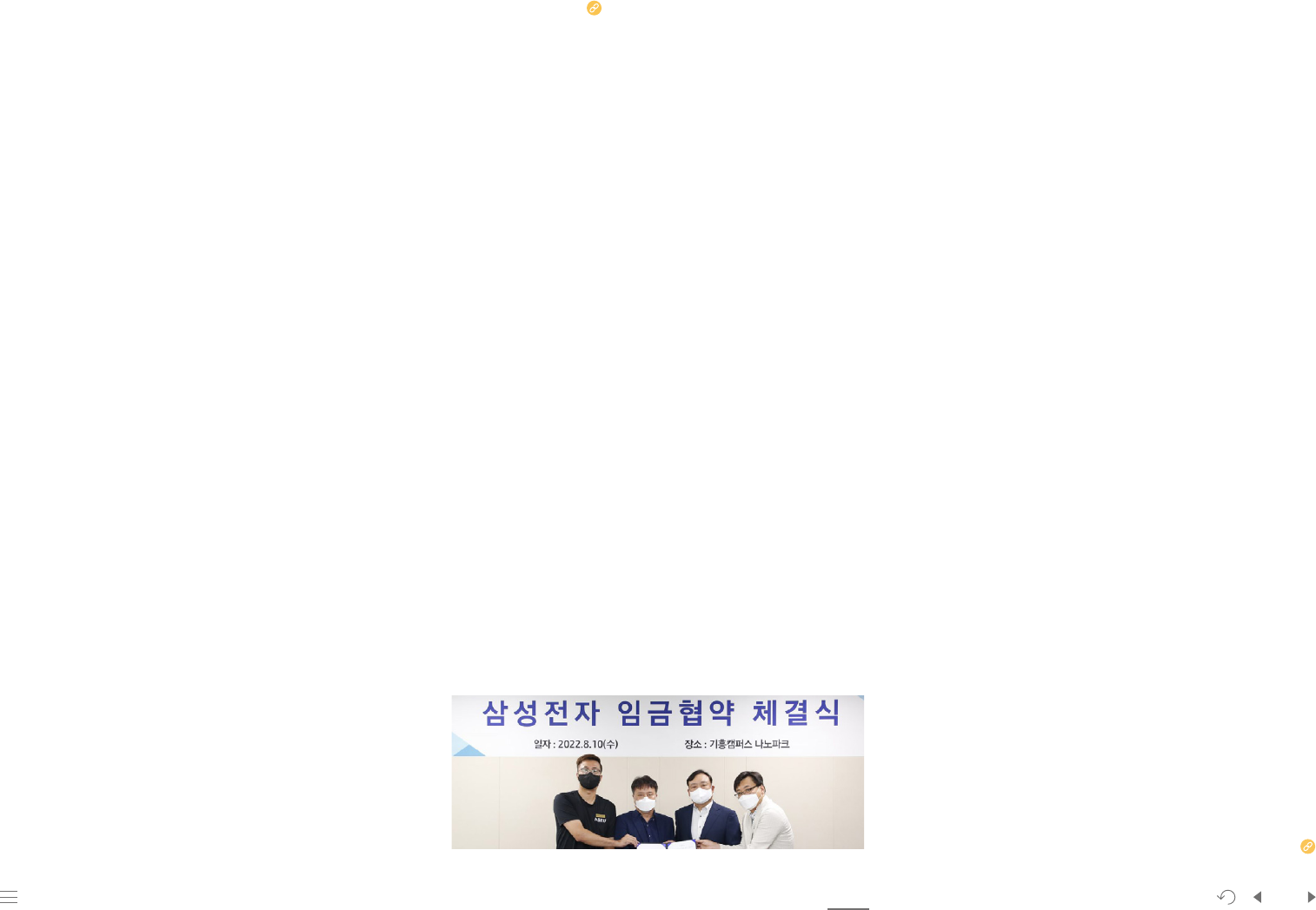
Our Company AppendixApproach to Sustainability Facts & Figures PrinciplePlanet
43
People
Samsung Electronics Sustainability Report 2023
Right to an Adequate Standard of Living
The payment of living wages is essential to guarantee an adequate
standard of living, resolve inequality, and ensure decent working
conditions such as decent working hours. Although universal consensus
on the definition and calculation method of a living wage has yet to be
reached, the term is generally understood as the level of remuneration
a worker receives for a standard workweek in a particular place which
is sufficient for the worker and dependent family members to afford a
decent standard of living. We remain committed to ensuring an adequate
standard of living for our employees and providing remuneration for a
regular workweek, which satisfies the basic needs of workers and their
dependent family members.
We have collaborated with BSR to calculate living wages. In 2018, we
began conducting research to estimate living wages in countries where
our production sites are located. In 2022, we assessed the impact of the
economic recession and inflation amid the pandemic on the basic living
conditions of our employees.
To ensure the accuracy of the estimates, we used the widely accepted
Anker methodology and identified diverse items such as food and non-
food expenditure per household and the number of employed and
dependent family members in each household by referring to economic
indicators released by credible organizations such as the OECD, UN, and
Eurostat. In 2022, we performed an internal living wage gap analysis
targeting production workers at 20 global business sites. Based on the
findings, we are making improvements to the wage and benefits of some
of our production sites to align them with the living wages calculated in
accordance with the Anker methodology.
We are currently recalculating living wages in collaboration with BSR
based on the figures updated in 2023. To enhance the understanding
of living wages within our organization, we leverage our human rights
training to help our employees in key roles such as HR and procurement
recognize human rights risks related to excessive overtime and failure
to provide adequate wages. We also engage in industry-led living wage
discussions and task forces to learn from our peers and work with the
wider industry to establish a more effective approach.
Non-Discrimination and Diversity
Discrimination is defined by ILO as any distinction, exclusion, or preference
made on the basis of race, sex, religion, political opinion, national extraction,
or social origin that has the effect of nullifying or impairing equality of
opportunity or treatment in employment or occupation.
Given the large share of female workers in the global electronics industry,
gender shall be considered when it comes to the working environment. As
a member of the RBA we comply with the RBA Code of Conduct and thus
prohibit discrimination in hiring and employment practices – including
wage, promotion, reward, and access to training – based on gender and and
pregnancy among others. We exempt pregnant and nursing employees
from potentially harmful tasks and conditions, take appropriate measures to
eliminate or reduce workplace health and safety risks related to the tasks of
pregnant and nursing employees, and provide spaces that meet the needs of
nursing employees.
We developed the Anti-Harassment Guidelines in collaboration with BSR in
2018 and revised them into the Anti-Discrimination and Harassment Policy in
March 2022. This Policy reflects our commitment to respect our employees’
right to work in an environment free from discrimination and harassment
and to build an environment where our employees are respected, equal
opportunities are guranteed, and their full potentials are realized.
In 2022, we developed the gender equality self-assessment toolkit with
144 indicators – in areas including policy, grievance mechanism, audit
and due diligence, capacity-building, and communication – based on UN
Women’s Women Empowerment Principles, RBA's VAP protocols, World
Benchmarking Alliance's Gender Benchmark methodology, and a set of
questionnaires from NGOs to further integrate a gender lens into our due
diligence work. Assessments performed at 20 of our global production sites
indicated that we require improvement in the areas of women leadership,
gender-related internal audit, gender equality training, and local stakeholder
engagement. Based on the results of the assessments, we developed
and distributed the Essential Guide on Gender Equality, which includes
best practices in the areas of policy, training, infrastructure, and maternity
support. We will continuously monitor the implementation of the Guide at
our global business sites and review its application in our supply chains.
Moreover, we strive to prevent incidents of discrimination by raising
awareness of our employees through continuous training. In 2022, a total of
seven cases were reported – six of which were resolved to take the meausres
of suspension or warning and one of which was found to be a case for another
Samsung affiliate company.
Freedom of Association and Collective Bargaining
Freedom of association is the right of workers and employers to form
and join organizations of their own choosing or not to engage in any of
those activities. Collective bargaining, closely related to freedom of
association, is one of the key vehicles that help employers and workers'
legitimate trade unions jointly work toward fair working conditions,
equal opportunities, and sound industrial relations.
We respect the activities of trade unions and other forms of employee
representation. We ensure that no workers are discriminated against,
retaliated against, harassed, or adversely affected due to their
joining or forming of a labor union, request for collective bargaining,
participation in collective bargaining, and exercise of the right
to organize or bargain collectively. We engage in open collective
bargaining based on mutual trust and strive to resolve issues through
good faith and constructive discussions, taking into account the labor
practices of the respective region.
In Korea, the executive management and the joint bargaining group of the
labor unions concluded their first collective agreement in 2021 and the
first wage agreement that encompasses wages, leaves, and performance
evaluations in August 2022, laying a foundation for constructive relations.
Employees of our production site in Türkiye, established in 2021, are under
the collective agreement reached by the local employers’ federation and
the trade union of the sector in early 2022.
In 2020, we established the Labor Relations Advisory composed of four
external experts under the Board of Directors to enhance our industrial
relations practices. The advisors review our labor relations issues
through meetings with management and executives from the People
Team and make recommendations for our practices in the mid-to-long
term. In addition, as part of our human rights training for all employees,
we reiterate the freedom of association and right to collective
bargaining and provide hands-on guidance on how to exercise these
rights. For executives, we outline the dos and don’ts to ensure that
these worker rights are duly protected and practiced.
Our efforts to enhance Diversity, Equity, and Inclusion

Our Company AppendixApproach to Sustainability Facts & Figures PrinciplePlanet
44
People
Samsung Electronics Sustainability Report 2023
Salient
human rights
risks
Function
in charge
Actually or
potentially affect-
ed stakeholders
Activities to prevent, mitigate, or address
human rights risks
Working
hours and
adequate
standard of
living
· People
Team
· Partner
Collabora
-
tion Center
· Our employees
· Workers in the
supply chain
· Internal monitoring and third-party audits
· Industry network engagement
Working hours
· Pre-building of new products prior to their official release
· Regular review of working hours at our production sites and suppliers
· Review of shift patterns, in compliance with our internal standards, at
our production sites
Standard of living
· Calculation of living wage based on Anker methodology with
third-party experts
· Gap analysis between wages paid at our production sites and living wages
Forced labor
and
child labor
· People
Team
· Partner
Collabora
-
tion Center
· Our employees
· Workers in the
supply chain
· Internal monitoring, including of government and NGO reports, and
third-party audits
· Industry network engagement
Forced labor
· Development of tailored audit tool for our production sites employing
foreign migrant workers
· On-site audits of our production sites and dormitories
· Face-to-face interviews with foreign migrant workers on their working
and living conditions
Child labor
· Employment management system
· Age verification process
· Capacity-building and training
Freedom of
association
and collective
bargaining
· People
Team
· Partner
Collabora
-
tion Center
· Our employees
· Workers in the
supply chain
· Internal and third-party audits
· Reinforcement of relevant provisions in Code of Conduct
· Labor and Human Rights Council overseen by the Board of Directors
· Capacity-building and training
· Dialogues and collaboration with employee representative bodies,
including labor unions and Works Councils
Occupational
health and
safety
· Global EHS
Center
· Partner
Collabora
-
tion Center
· Our employees
· Workers in the
supply chain
· Internal and third-party monitoring
· Acquiring and retaining internationally recognized EHS certifications at
all of our business sites
· Establishing a monitoring system for all of our global production sites
· Development and adoption of new protective gear
· Safety capacity-building and training, fostering experts
Salient
human rights
risks
Function
in charge
Actually or
potentially affected
stakeholders
Activities to prevent, mitigate, or resolve
human rights impacts
Non-
discrimination
& diversity and
inclusion
· People Team
· Partner Collaboration Center
· Our employees
· Workers in the
supply chain
· End users/ Consumers
· Local communities/
Society
· Internal and third-party audits
· Internal DEI network
· Capacity-building and training
· Annual Employee Surveys (Samsung Culture Index)
· Industry network engagement
Anti-
harassment
· People Team
· Partner Collaboration Center
· Our employees
· Workers in the
supply chain
· Internal and third-party audits
· Capacity-building and training
· Annual Employee Surveys (Samsung Culture Index)
Product
responsibility
including AI
ethics
· Corporate Sustainability
Center
· R&D Teams at each
Business Unit
· Samsung Research
· End users/Consumers · AI Ethics Principles of fairness, transparency, and
accountability
· Guidelines on AI Ethics
· Provision of AI models and data card templates
· Online training
Digital
responsibility
including privacy
and freedom of
expression
· Information Security Center
· Global Privacy Office
· Communications Team
· Partner Collaboration Center
· Our employees
· Workers in the
supply chain
· End users/Consumers
· Local communities/
Society
· Provision of products and services in compliance with
Samsung Privacy Protection Principles including
transparency, security, and choice
· Enabling freedom of expression in products and
services
Environmental
responsibility
· Global EHS Center
· Partner Collaboration Center
· Corporate Sustainability
Center
· Our employees
· Workers in the
supply chain
· End users/Consumers
· Local communities/
Society
· Announcement of the New Environmental Strategy
incorporating emissions reduction, new sustainability
practices, and innovative technologies and products
· Acquiring and retaining internationally recognized
environment and energy certifications
Supplier
responsibility
· Partner Collaboration Center
· Purchase Teams
· Global EHS Center
· Workers in the
supply chain
· Responsible purchasing practice requirements in
contracts and evaluations of suppliers
· Self-assessments, internal and third-party monitoring
· Regular verification of supplier data
· Capacity-building and training
Responsible
minerals
sourcing
· Partner Collaboration Center
· Purchase Teams
· Corporate Sustainability
Center
· Workers in the
supply chain
· Local communities/
Society
· Participation in grassroots projects
· Capacity-building and training
· Industry network engagement
Salient Human Rights Risks and Related Actions

Our Company AppendixApproach to Sustainability Facts & Figures PrinciplePlanet
45
People
Samsung Electronics Sustainability Report 2023
2022 Areas of Findings
RBA Validated Assessment Program
As a member of the RBA, Samsung adheres to the RBA Code of Conduct,
which is in alignment with the UN Global Compact, ILO Declaration
on Fundamental Principles and Rights at Work, and UN Universal
Declaration of Human Rights.
We annually complete the RBA Self-Assessment Questionnaire and
follow the RBA Validated Assessment Program (VAP) to conduct
on-site audits of our production sites. VAP provides a comprehensive
assessment of a site’s level of compliance with the RBA Code of Conduct
and local laws and regulations in the areas of labor, health and safety,
environment, ethics, and management system. VAP is conducted by
independent third-party auditors specially trained and certified by the
RBA. When any case of non-compliance is uncovered, the production
site in question is required to establish corrective action plans and
initiate the system to prevent recurrence, which is to be implemented
within a preset time frame. In 2022, we had VAP audits at 14 of our global
production sites of which eight were assessed as fully compliant and six
have findings in the areas of labor and health and safety. Some findings
were immediately addressed on site during the audits; corrective actions
requiring longer-term measures are currently in progress, in line with the
VAP standards.
Human Rights Impact Assessment and Saliency Analysis
A human rights impact assessment (HRIA) analyzes the impact of
business activities on right-holders such as employees, workers
within supply chains, local community members, and consumers.
HRIA typically involves more in-depth consultations with potentially
affected stakeholders than other forms of human rights assessment.
In turn, a Human Rights Saliency Analysis (HRSA), a type of human
rights due diligence, prioritizes actual and potential human rights
impacts based on the severity (scale of affected people, scope of the
impact, remediability, among others) and the probability of occurrence.
HRSA helps companies focus their resources on managing human
rights risks that are likely to have an adverse impact and is concluded
with the identification of salient human rights risks. The first HRIA
was carried out from 2018 to 2019 at our Vietnam production site.
Supported by BSR, we conducted employee interviews, document
review, labor union member interviews, and external stakeholder
interviews and identified potential labor and human rights risks. While
no human rights abuses that require immediate action were detected,
we identified 41 action items based on BSR's recommendations related
to labor rights, discrimination, protection of vulnerable groups, local
communities, and supply chains. As of December 2022, 38 out of 41
actions were completed, and some items such as local CSR activities,
Multi-Stakeholder Forum, among others have taken root as regular
events. The recommendations that have yet to be completed will
undergo an effectiveness review. In 2021, we performed a human rights
saliency analysis of a new business site prior to their start of operation.
We performed a HRSA at our Türkiye production site and identified
potential human rights risks posed by its operation on our employees,
supply chain workers, and local communities in the macro-context of the
country’s human rights status. Supported by the expert consultancies
Enact and twentyfifty, we identified our potential salient human rights
risks including decent working conditions, health and safety, supplier
responsibility, freedom of expression, and respect for human rights
of vulnerable groups. We received 21 recommendations to align the
site’s operation with the UNGPs, 20 of which have been implemented
and completed as of December 2022. In 2023, we plan to develop and
introduce our internal semi-HRIA, based on communications with our
internal and externalstakeholders on their grievances, to assess how
our production sites resepct for human rights.
2022 RBA Audit Summary: Audit Compliance Rates (Number of Findings)
*Based on initial audits
Production site
RBA Audit
Compliance rate
Labor Health and safety Environment Ethics
Management
system
Vietnam (SEHC) 98.7%(1) 100% 95.2%(1) 100% 100% 100%
Vietnam (SEVT) 100% 100% 100% 100% 100% 100%
Egypt (SEEG-P) 100% 100% 100% 100% 100% 100%
Brazil (SEDA-P(C)) 100% 100% 100% 100% 100% 100%
Mexico (SAMEX) 100% 100% 100% 100% 100% 100%
Mexico (SEM-P) 97.6%(2) 92.3%(2) 100% 100% 100% 100%
Malaysia (SEMA) 100% 100% 100% 100% 100% 100%
Korea (Cheonan) 100% 100% 100% 100% 100% 100%
Korea (Giheung) 100% 100% 100% 100% 100% 100%
Korea (Hwaseong) 100% 100% 100% 100% 100% 100%
Korea (Onyang) 98.7%(1) 96.1%(1) 100% 100% 100% 100%
Korea (Pyeongtaek) 98.7%(1) 96.0%(1) 100% 100% 100% 100%
China (SCS) 97.5%(2) 95.8%(1) 95.2%(1) 100% 100% 100%
China (SESS) 96.3%(3) 96.0%(1) 91.3%(2) 100% 100% 100%
Classifi-
cation
Sub-section Finding(s)
Corrective
action(s)
completed
Corrective
action(s)
in progress
Labor
Freely chosen employment
0 - -
Young workers
0 - -
Working hours
2 0 2
Humane treatment
0 - -
Wage and benefits
4 2 2
Non-discrimination /
Anti-harassment
0 - -
Freedom of association
0 - -
Health
and
safety
Occupational safety
0 - -
Emergency preparedness
2 1 1
Occupational injury and illness
1 1 0
Industrial hygiene
0 - -
Physically demanding work
0 - -
Machine safeguarding
1 1 0
Food, sanitation, and housing
0 - -
*As of December 2022
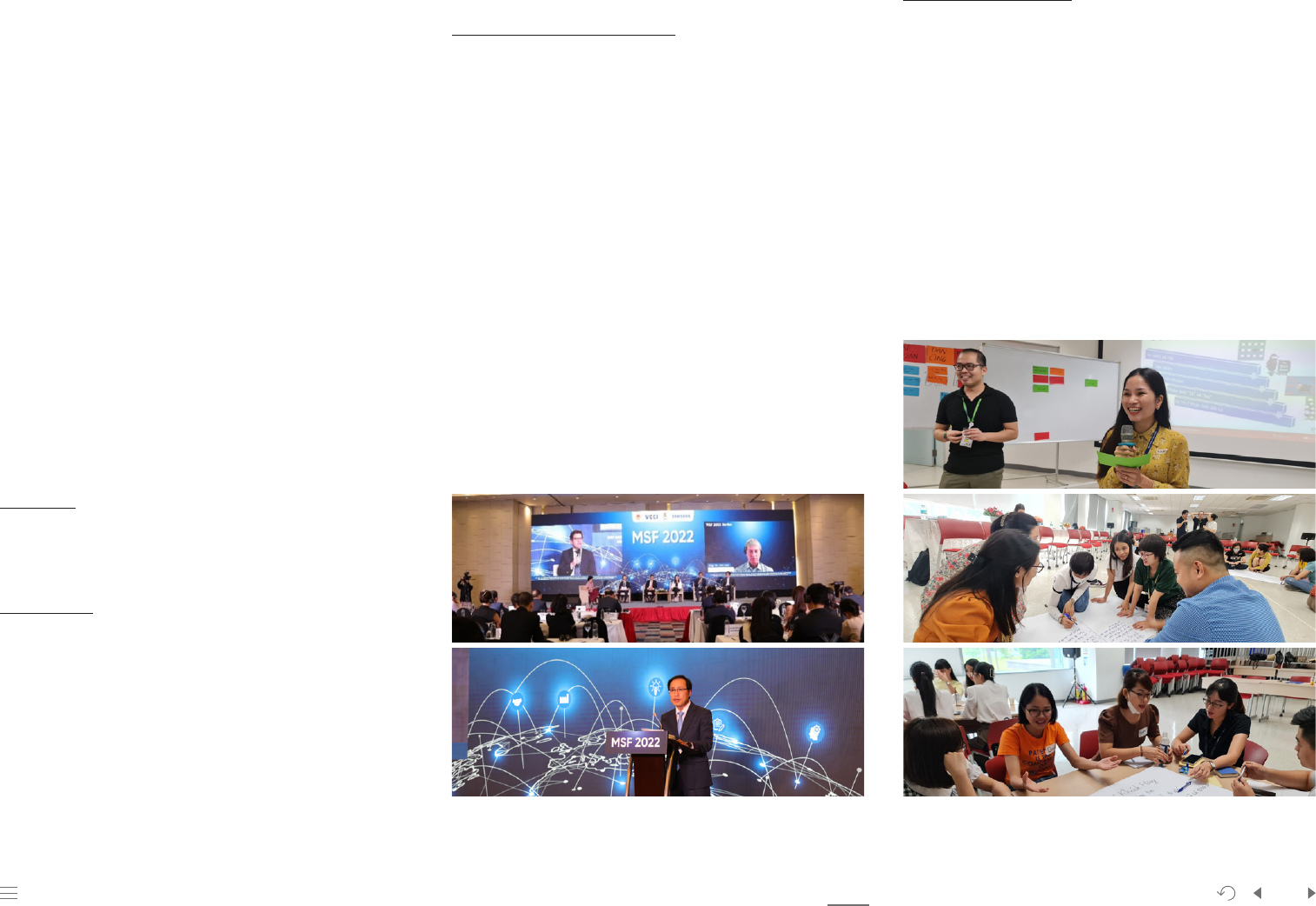
Our Company AppendixApproach to Sustainability Facts & Figures PrinciplePlanet
46
People
Samsung Electronics Sustainability Report 2023
Stakeholder Engagement
Stakeholder engagement is one of the core pillars of our Labor and
Human Rights Framework. It is a company-wide effort integrated into
our business activities and an important element of our human rights
due diligence process.
We recognize that we are part of a broader ecosystem and that our
activities may have a far-reaching impact on the individuals within
our supply chains and local communities. As part of our commitment
to respect human rights, we strive to engage in open, active, and
direct communication with our stakeholders. We communicate with
diverse stakeholders, including right-holders who may be affected by
our activities, to listen to their voices and reflect their insgihts in our
operations.
Different forms of our stakeholder engagement range from informal
dialogue to strategic partnerships. Our stakeholders include our
employees, business associations and industry initiatives, civil society
organizations, international organizations, benchmarking agencies,
human rights experts and consultancies, customers, suppliers,
investors, and governments.
Employee Representative Bodies
Labor Union We have 32 labor unions representing our employees
at our business sites around the world. We negotiate employment
conditions with them and conclude collective agreements accordingly
pursuant to the laws of the respective countries.
Works Councils We have Works Councils at 46 of our business sites
around the world based on the respective countries’ laws and individual
sites’ conditions. Our employees elect their representatives through
direct and anonymous voting. The Works Councils convene regularly to
discuss various agenda items to improve working conditions, including
wages and benefits.
MSI Reproductive Choice In 2022, we joined forces with MSI
Reproductive Choice through one of our production sites in Vietnam
to promote the health of our employees. As an international NGO
dedicated to providing contraception and safe abortion services in
37 countries in accordance with those countries' national laws, MSI
Reproductive Choice conducted a four-day train-the-trainer program
covering discrimination, sexual harassment, reproductive health,
and mental health at the workplace. A total of 39 in-house trainers
participated in the program which centered on developing practical
problem-solving skills at the workplace and highly appreciated
the training module on the gender equality. After completing the
training program, these in-house trainers then held two on-site
training sessions on sexual harassment prevention and pre-/postnatal
healthcare, both of which were attended by more than 33,000
employees.
CSOs and NGOs
Multi-Stakeholder Forum in Vietnam The Multi-Stakeholder Forum
(MSF) is an initiative led by Samsung, which has been staged annually
since 2018 to bring together our stakeholders, from policymakers
to NGOs, CSOs, labor and human rights experts, academics, and
businesses, to create synergy. The latest iteration of the Forum was
held jointly by Vietnam’s Ministry of Trade and Industry, Vietnam
Chamber of Commerce and Industry (VCCI), Vietnam General
Confederation of Labor (VGCL), and Samsung in October 2022 in Hanoi
under the theme “Moving Up the Global Value Chains in Vietnam: Multi-
Stakeholder Partnership on Capacity Development and Due Diligence.”
In addition, the results of two collaborative studies by VCCI, VGCL, and
Samsung were shared – which focused on the dynamic capabilities
of Vietnamese businesses in the global supply chain and the role
of labor unions in reinforcing labor rights due diligence in Vietnam.
Samsung presented its efforts to foster the local parts-manufacturing
industry; expand local supply chains; and maintain workplaces that
ensure respect for human rights, gender equality, and safety. The
number of attendees in 2022 reached approximately 500, including
representatives from over 60 global and local NGOs and due diligence
leaders and experts.
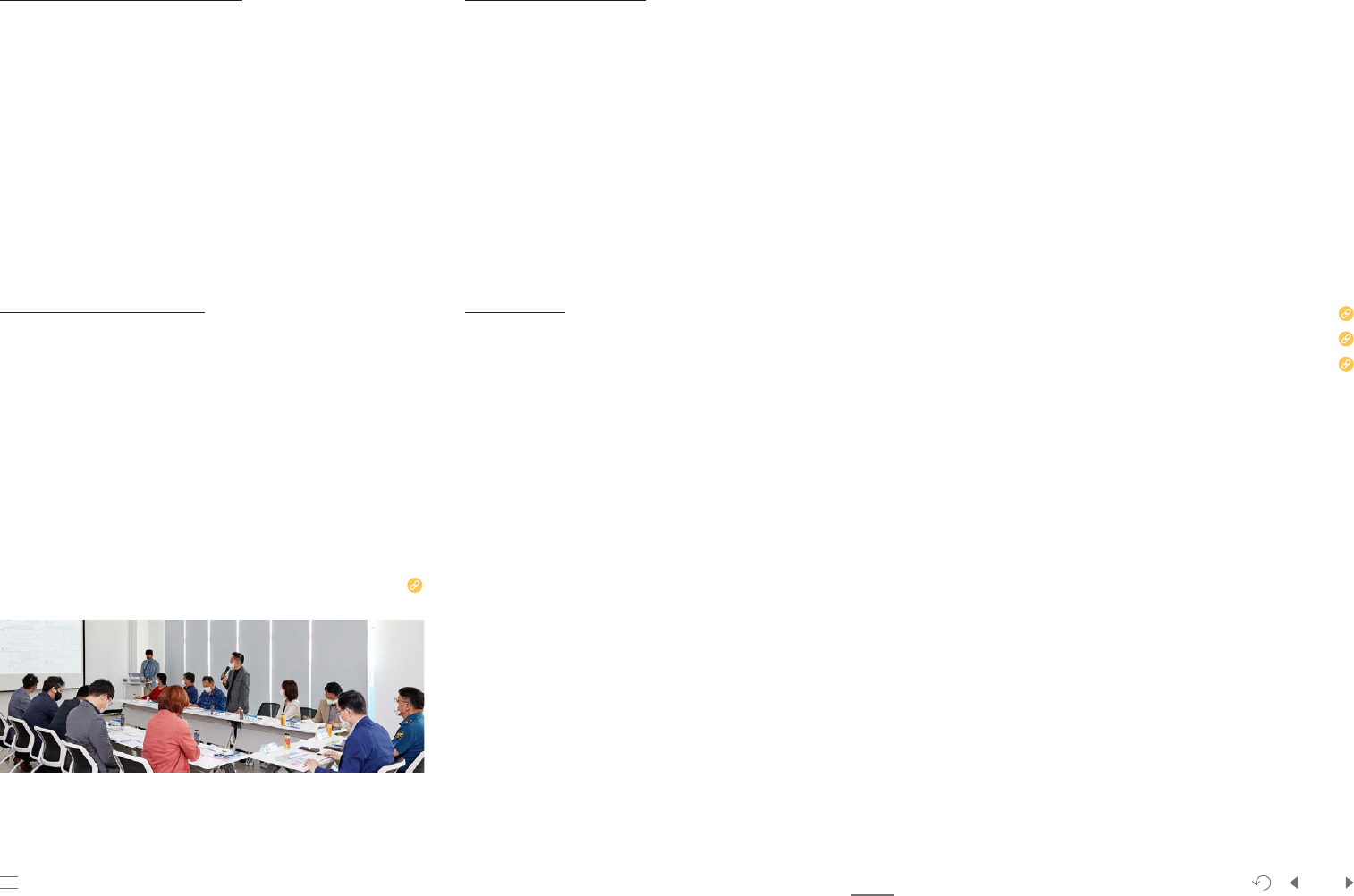
Our Company AppendixApproach to Sustainability Facts & Figures PrinciplePlanet
47
People
Samsung Electronics Sustainability Report 2023
Benchmarking Institution
Global Child Forum (GCF) GCF is a Sweden-based nonprofit
organization that assesses the integration of children’s rights in the
business practices of some of the world’s most influential companies. In
2022, we were invited to take part in the GCF Business Academy as the
industry leader selected through GCF’s most recent benchmarking. We
participated in diverse programs targeting companies in the ICT sector
over the past year, discussed challenges and best practices, and sought
ways to better protect children’s rights across our business operations.
The peer-to-peer networking and cooperation activities arranged
through this program were guided by GCF and other organizations
dedicated to children’s rights.
Investors
ESG Roadshow We hold annual ESG Roadshows to update our
investors on our sustainability activities including those related to
human rights. Since 2019, the Roadshow has facilitated communication
with our investors on our efforts to advance sustainability, including
new policy announcements and human rights due diligence results. It
also serves as a channel to resolve our investors’ inquiries on various
sustainability-related topics including on our efforts to enhance DEI;
our global supply chain management system; and our response to
evolving regulations of different countries. We continuously strive to
strengthen communication with our investors and actively reflect their
needs in our human rights management.
Our efforts to reach out to local communities
Our statement on UK Modern Slavery Act
Our statement on Australian Modern Slavery Act
Our commitments to respect human rights
Transparency & Reporting
We disclose our activities to respect human rights in our annual
Sustainability Report based on the Global Reporting Initiative (GRI)
Standards. The annual disclosure is also an extension of our efforts to
comply with the UK Modern Slavery Act, Australian Modern Slavery
Act, and Norwegian Transparency Act and to fulfill the evaluation
criteria of the Corporate Human Rights Benchmark – assessing human
rights management levels of global companies – and KnowTheChain
– assessing companies’ actions to address forced labor in their global
supply chains. We also disclose official statements on relevant human
rights issues via the online platform operated by the Business and
Human Rights Resource Center, a UK-based nonprofit organization
dedicated to research in the human rights impacts of corporate
activities, as well as in response to customer requests on dedicated
human rights issues.
Business Associations and Industry Initiatives
Responsible Business Alliance (RBA) We are a member of RBA,
the world’s largest industry coalition dedicated to corporate social
responsibility in global supply chains. In addition to the RBA VAP
program based on the RBA Code of Conduct, we regularly conduct
internal audits by RBA-trained in-house experts as well as regular third-
party audits by independent auditors. We are actively participating in the
Responsible Labor Initiative (RLI), a multi-stakeholder initiative focused
on respecting and promoting labor rights. We are also engaging in
dedicated working groups and task forces concerning our salient risks to
discuss mutual challenges, share best practices, and raise the awareness
of our employees on relevant issues.
Local Communities
Community Engagement Council We launched our first Community
Engagement Council at our Yongin business site in 2013, followed by
our Pyeongtaek and Onyang sites. This initiative provides a platform
to exchange views with local community members on the potential
impact of our operations on the local environment and current and
potential grievances of local community members. Each Council is
composed of representatives of the respective business sites and local
residents and convenes regular meetings as agreed to by both parties.
The details of each meeting are disclosed on the Samsung Semiconstor
website. In addition, we invite local residents and students to special
events organized at our business sites to provide an opportunity to
experience our sites first-hand.

Our Company AppendixApproach to Sustainability Facts & Figures PrinciplePlanet
48
People
Samsung Electronics Sustainability Report 2023
Grievance Cases
per Channel
Grievance Cases
per Type
Grievance Cases
per Channel
23,840
cases in
23,378
cases in
2022
2021
Hotline
45%
Online
24%
Offline
18%
Employee
representative bodies
14%
Interpersonal
relations 7%
Safety and
health 5%
Organizational
reshuffling 1%
Job change 3%
Harassment 0.3%
Discrimination 0.1%
Work environment
47%
Employment
conditions
36%
Hotline
36%
Online
28%
Offline
23%
Employee
representative bodies
14%
Grievance Cases
per Type
Interpersonal
relations 6%
Safety and
health 5%
Organizational
reshuffling 1%
Job change 1%
Harassment 0.2%
Discrimination 0.0%
Work environment
50%
Employment
conditions
37%
Access to Remedy
We remain committed to thorough due diligence to prevent our business
operations from causing or contributing to any adverse impacts on human
rights or engaging in human rights abuses. All complaints or grievances
filed by individuals or groups that are adversely affected by our business
operations are promptly investigated to seek effective and satisfactory
remedies. Upon detecting human rights abuses, we investigate their
root causes and change our systems, processes, and practices if deemed
necessary to prevent the recurrence of similar cases.
The scope of our grievance encompasses any incidents that may adversely
impact or result from an adverse impact on human rights as specified in the
UNGPs, in addition to complaints, requests, and suggestions about working
conditions. We ensure our employees are informed of and have an access to
the grievance channels and resolution process by including these topics in
our annual human rights training for employees.
We also have the process in place to take prompt follow-up actions and
update grievants on the progress in line with the effectiveness criteria from
the UNGPs. We make sure that filed grievances are handled promptly in
accordance with our internal procedures and that follow-up actions, such
as training and policy revisions, are taken to address the root causes. We
interview all relevant parties involved in a case – the grievant, accused,
potential witnesses – and keep in touch with grievants to monitor whether
their grievances have been properly resolved and remedied. Te prevent
reoccurrence, we establish preventive measures and change our business
practices, as needed, to address identified risks.
Our grievance channels which are a combination of anonymous and direct
channels are open to internal and external stakeholders including workers
in our supply chain and civil society organizations. While most of our
channels are operated at the corporate level, we also partner with third-
party organizations in select countries to provide additional channels for
our employees. Samsung prohibits the use of retaliation of any form against
workers or stakeholders, and is committed to cooperating with and not
obstructing participation (of workers or other stakeholders) in or the outcome
of judicial and non judicial mechanisms.
The total number of grievances filed and the breakdown of grievance types in
2022 were found to be similar to those of the previous year. Several notable
changes include: an increase in grievances filed offline by 5%p, a decrease in
grievances filed via hotline by 9%p; and an increase in grievances related to
work environment by 3%p. The return to physical workplaces following the
lifting of travel restrictions post-pandemic is believed to a contributing factor
to this trend.
Grievance Filing Status
Third-Party Grievance Channel in Latin America
Our Latin America Office introduced a third-party grievance channel
in Brazil as allegations and complaints related to moral harassment
had increased. The new independent channel was aimed at
providing an additional safeguard, in combination with the existing
internal grievance channels, for employees highly sensitive about
confidentiality. As a result, there was a marked increase in grievances
concerning subjects that had not been filed via the internal channels,
which brought positive change to our site in Brazil.
To meet the needs of employees under different conditions, we strive
to improve the reliability of the available channels. We conducted
training concerning the issues identified through the filed grievances
as a preventive measure. We also focused on preventing any form of
retaliation against grievants through the Compliance Team’s leadership
role in the investigation, resolution, and follow-up management of
grievances.
Given the successful implementation of this approach in Brazil, the third
party grievance channel was expanded to all of our business sites in Latin
America as of October 2022. Upon verifying its efficiency, we will review
the introduction of third-party grievance channels in other regions.
Our grievance channels Our grievance resolution process
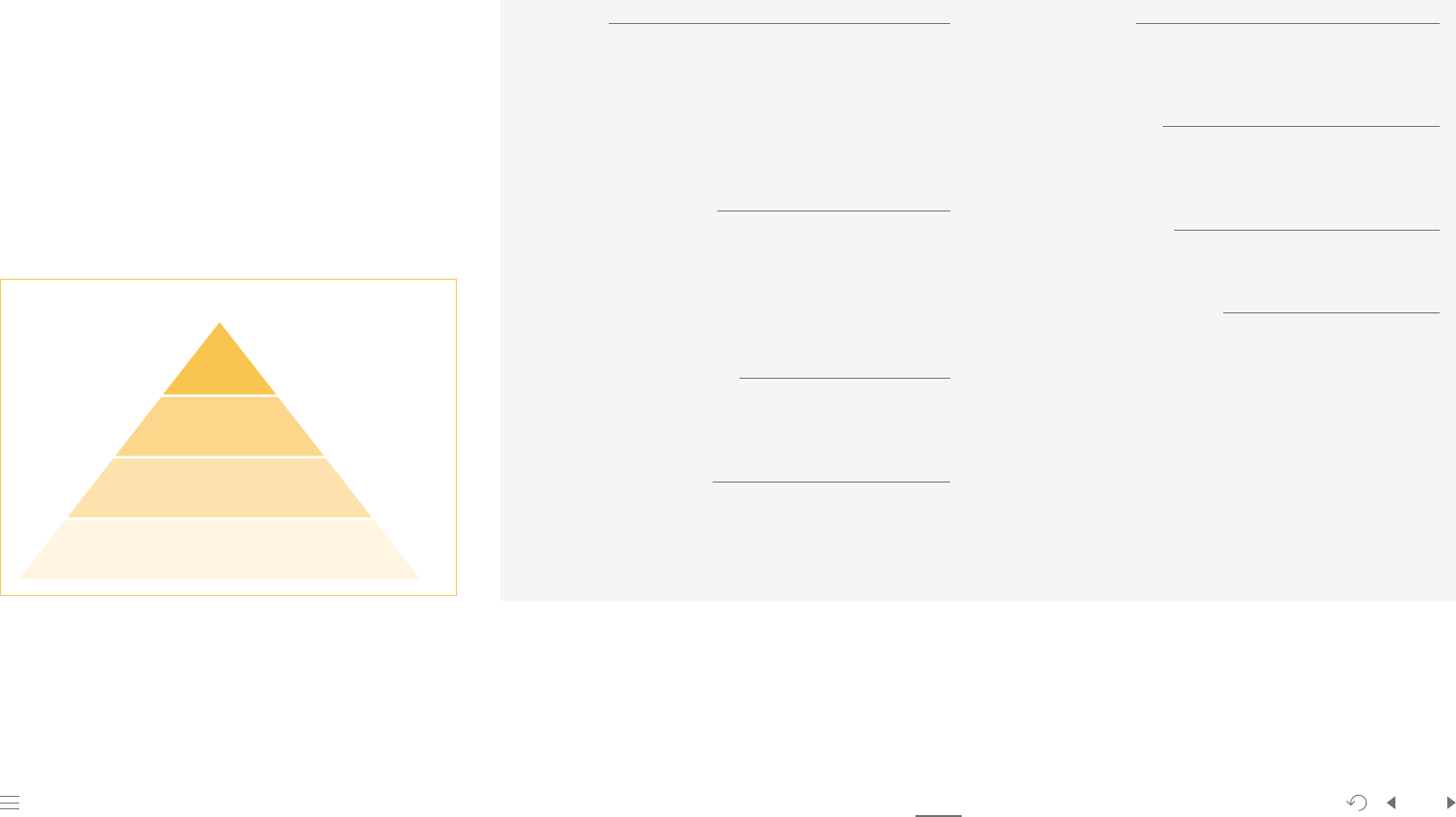
Our Company AppendixApproach to Sustainability Facts & Figures PrinciplePlanet
49
People
Samsung Electronics Sustainability Report 2023
Human Rights Governance
We believe strong governance is essential to successfully embed
respect for human rights in our business operations. Our human rights
governance is centered around the Sustainability Committee under
the Board of Directors and the Labor and Human Rights Council. This
structure facilitates the supervision and management of labor human
rights conditions at various levels. The Sustainability Committee is
in place to enable the Board of Directors to closely monitor relevant
company-wide issues. The Committee plays an instrumental role in
determining our strategic priorities concerning sustainability and
incorporates human rights and other sustainability issues into the
business decision-making.
The Sustainability Council, headed by the CEO, reviews and manages
company-wide sustainability issues with those in charge of
sustainability in individual businesses.
The Labor and Human Rights Council, one of our cross-functional consultative bodies, discusses and coordinates global labor and human rights issues
at our business sites and across our supply chains. This Council is composed of executives and working-level staff members of the People Team, Partner
Collaboration Center, Vendor Improvement Task Force, Global Technology Research, Global EHS Center, Corporate Legal Office, Investor Relations Team,
and Corporate Sustainability Center and serves as our secretariat for human rights issues. It shares information on the global human rights landscape,
potential human rights risks, and stakeholder feedback and discusses ways to integrate new findings into our due diligence approach.
The Council convenes on a monthly basis and reports human rights issues identified to the corporate risk management body which in turn reviews them
as a potential risk to our business. A brief description of the units participating in the Council and their respective responsibilities are provided below:
People Team
The People Team establishes policies for human rights activities and DEI
programs and monitors relevant procedures at our business sites. It develops
employee training programs to ensure respect for human rights in our
everyday business activities, while also taking the lead in the implementation
of due diligence, including third-party audits by RBA-approved auditors and
the Human Rights Impact Assessment, to prevent, mitigate, and remedy our
human rights impacts.
Partner Collaboration Center
The Partner Collaboration Center supervises the establishment of human
rights standards and implementation of due diligence by our suppliers and
offers training and capacity-building programs to ensure their responsible
purchasing practices including responsible minerals sourcing. The Center
also regularly monitors our suppliers’ compliance status through a dedicated
organizational unit.
Vendor Improvement Task Force
The Vendor Improvement Task Force monitors our business partners
stationed at our production sites on their implementation of our human
rights commitments and audit programs.
Global Technology Research
Global Technology Research monitors our suppliers’ compliance with the
Supplier Code of Conduct and our human rights commitments.
Global EHS Center
The Global EHS Center establishes standards related to occupational health
and safety and environment and supports their implementation in our
business sites and supply chains.
Corporate Legal Office
The Corporate Legal Office shares the latest global legislation trends and
requirements concerning respect for human rights and due diligence in
business operations.
Investor Relations Team
The IR Team identifies and conveys our investors’ expectations of our human
rights commitments to the organizational units in charge.
Corporate Sustainability Center
The Corporate Sustainability Center communicates our stakeholders’
expectations of our sustainability efforts, including human rights activities,
to the organizational units in charge. The Center ensures close coordination
with our respective businesses through the Sustainability Council and
reviews and submits agenda items to the Sustainability Committee under the
Board of Directors.
Board of
Directors
Sustainability
Committee
Sustainability Council
Labor and Human Rights Council
Human Rights Governance
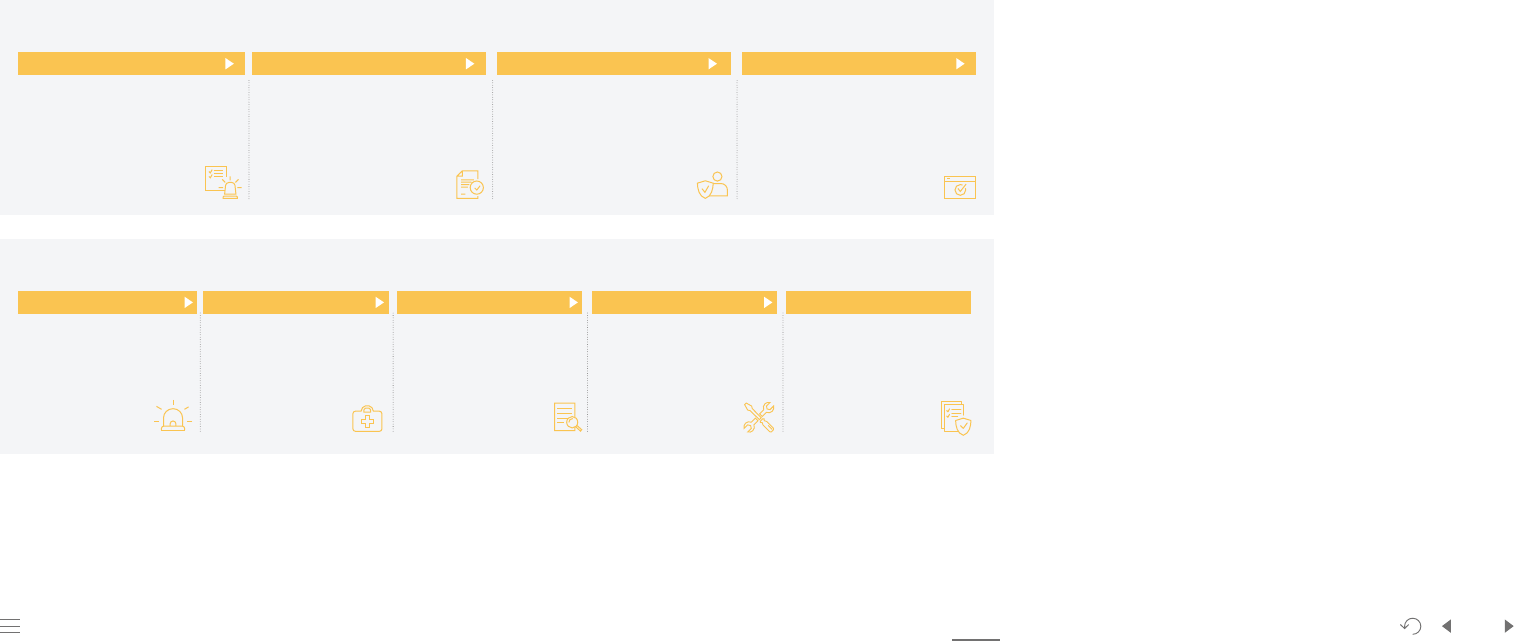
Our Company AppendixApproach to Sustainability Facts & Figures PrinciplePlanet
50
People
Samsung Electronics Sustainability Report 2023
Health and Safety
We have health and safety management systems in place for our individual business sites to ensure workplace safety and the health of our
employees. We also engage in diverse activities, from risk mitigation to relevant indicator management, safety-sensitive culture assessment, and
employee capacity-building.
Business Site Safety Management System
Health and Safety Management System Certification
Our operations are based on international health and safety management systems. The attainment of ISO 45001 is mandatory for all of our
manufacturing sites around the world. As of 2022, all of our production sites are 100% certified.
Integrated Assessment System
We identify potential risks through the annual environment and safety assessment by experts and review the compliance and equipment
management status of our business sites. In 2022, we introduced a serious accident risk assessment initiative that brings together internal and
external specialists to accurately diagnose the health and safety management status of our business sites, continually mitigating and removing
on-site risks.
Safety Management System
Our safety management system, encompassing hazardous machinery
management, on-site safety inspections, and safety monitoring, is
designed to help all employees efficiently handle related tasks.
Identifying and Mitigating Potential Risks
We are identifying potential risks and building a safer work environment.
DX operates the “No Safety, No Work” campaign designed to allow any
individual to immediately suspend work upon detecting risk factors
on site and rewards employees who make significant contributions.
It also holds “No Construction Work Day” to eradicate risks related to
construction work performed on site on holidays.
DS identified 31,502 potential risks in 2022 through the participation of
5,036 employees.
Managing Risks Related to Fire, Explosion, and Natural Disasters
DX collaborated with external specialists to perform a comprehensive
assessment of its business sites deemed to have potential risks related
to fire, explosion, and natural disasters. In Korea, the scope of this work
included inspections of firefighting and high-pressure gas equipment
and an analysis of natural disaster scenarios – including wildfire, storms,
and floods – and evacuation simulations. At DX's global business sites,
we identified and addressed gaps in the emergency response system –
including foam process fire risks and evacuation routes.
Accident Response Process
Occurrence of an accident
· Updates on the situation
· Identification of accident
type and crisis level
Emergency measures
· Formation of the Crisis
Management Committee
· Emergency evacuation and
action
Investigation
· Identification of causes
· Prevention of secondary
accidents
Remedial action
· Implementation of remedial
action
· Implementation of the
business continuity
plan
Prevention of recurrence
· Establishment of relevant
measures
· Review of the effectiveness
of our accident
response system
Accident Prevention Process
Identifying risks
· Outdated equipment
· Failure to comply with safety
regulations
· Insufficient on-site
management
Establishing response measures
· Equipment lifespan projection
· Promotion of safety regulation
compliance
· Establishment of on-site
management programs
Making improvements
· Equipment monitoring
· Safety training
· On-site inspections
Conducting monitoring
· Performance management
· Process correction and modification
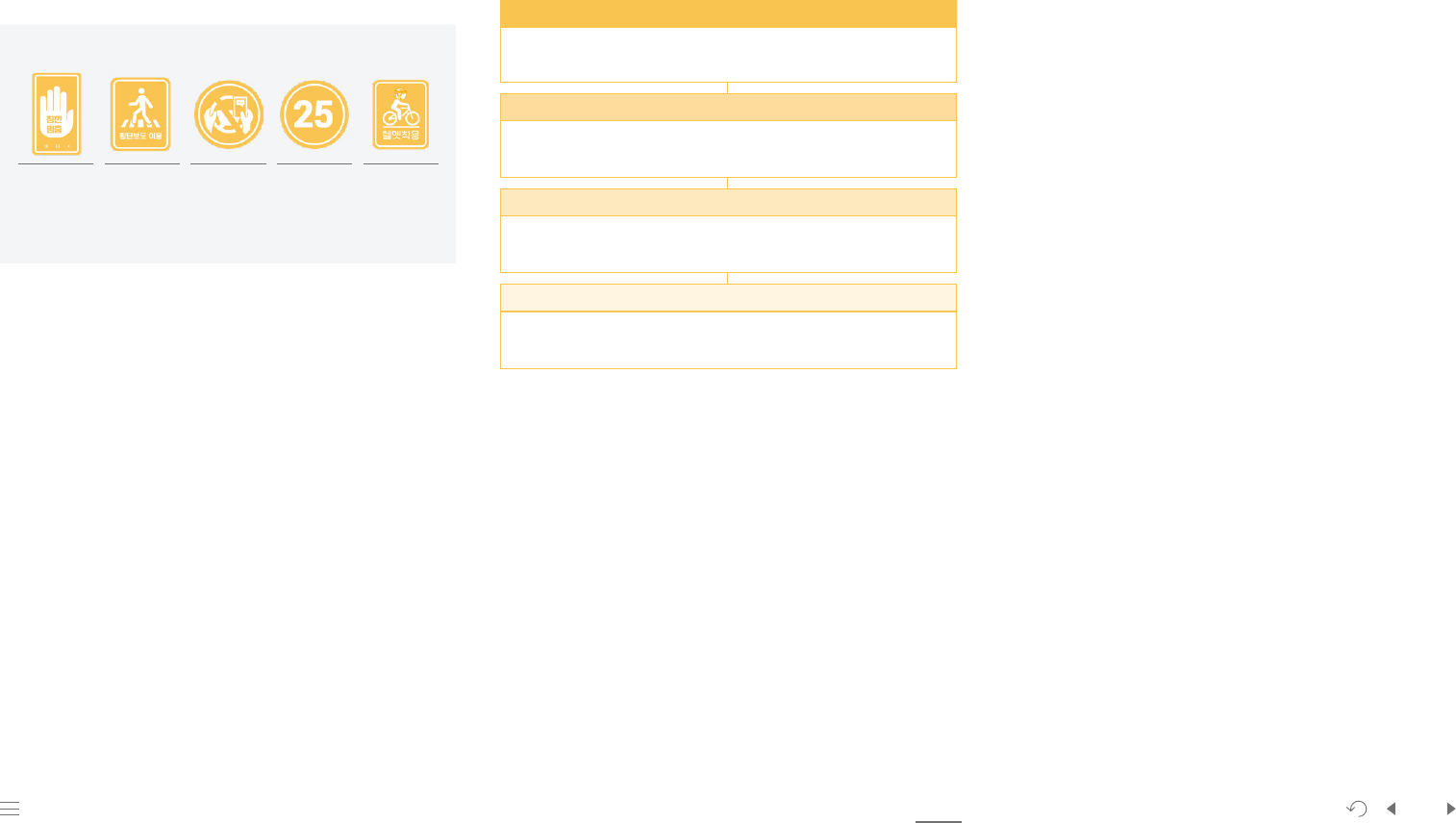
Our Company AppendixApproach to Sustainability Facts & Figures PrinciplePlanet
51
People
Samsung Electronics Sustainability Report 2023
Safety Capacity-Builing
Risk Assessment Expert Program
DS operates a risk assessment expert program to reinforce our
employees’ safety risk assessment capabilities. A total of 3,494 experts
(2,200 of our employees and 1,294 of our suppliers’ employees) have
completed this program as of 2022.
Safety-Sensitive Culture Promotion Group
DS participates in the Safety Culture Promotion Group led by
Korea Industrial Safety Health Headquarters under the Ministry of
Employment and Labor to prevent serious accidents. The Safety
Culture Promotion Group engages with diverse public and private
organizations including those in charge of safety from the perspective
of both labor and management. It collaborates with the Gyeonggi-do
branch of the Ministry of Employment and Labor to promote on-site
safety practices by producing and distributing relevant content,
creating slogans for safety-sensitive culture, and organizing a safety-
sensitive culture contest.
Reinforcing On-Premise Traffic Safety
DX performed a comprehensive traffic safety assessment in
collaboration with an external specialist to prevent accidents and
improve infrastructure on the premises of its business sites. Traffic
accident risks were identified at the production sites with high traffic
of large trucks, and improvements were made accordingly. DX also
requires compliance with the “5 Safety Rules” concerning pedestrians,
vehicles, and bicycles to ensure a safer workplace.
Our Explosion Protection Efforts Evidenced by IECEx CSF Certification
DS has established a safety management system to enhance
preparedness for possible explosions that may lead to serious
accidents. A dedicated organizational unit was formed to manage
the quality of explosion protection facilities and perform regular
inspections. It also attained IECEx
1)
and CoPC
2)
and cultivated 15
explosion protection experts. Based on such efforts, its Giheung and
Hwaseong sites attained IECEx CSF
3)
granted by IECEx in February
2022 in recognition of workplace safety, followed by its Pyeongtaek,
Cheonan, and Onyang sites. All of the DS Division’s business sites in
Korea are now IECEx-certified. IECEx CSF is a testament to workplace
operation in accordance with international explosion protection
standards. DS plans to continually elevate its explosion protection
capacity to new heights at all of its sites.
1) International Electrotechnical Commission Certification System for Explosive
Atmospheres
2) Certificates of Personnel Competence
3) Certified Service Facility
Attainment of risk assessment and safety/health qualifications
(FSE and NEBOSH), in-house Advanced Course lecturers
Expert
Advisor
In-house Basic Course lecturers, diverse
assessment techniques, case studies
Advanced
Leadership in risk assessments, risk assessment following
the occurrence of accidents, improper assessment cases
Basic
Risk assessment methodology (S-PHA and
SSRA) and major equipment, practical training
5 Safety Rules
No mobile
phone while
walking
No
jaywalking
No mobile
phone while
at the steering
wheel
No speeding
and
aggressive
driving
No bicycling
without a
helmet
Global Manufacturing and Workplace Safety Innovation Day
In order to enhance the safety of our business sites, we organize Global
Manufacturing and Workplace Safety Innovation Day each year to
share and encourage the application of best practices.
In 2022, DX held an event to share innovation cases of different
businesses in celebration of this initiative attended by over 100
employees from our sites in Korea, Vietnam, and Europe as well as
Samsung Group member companies.
DS also organized its 2022 celebration of the Day with over 250
participants, including the CEOs of five of our parts suppliers (DS, SDC,
Samsung SDI, Samsung Electro-Mechanics, and Samsung Biologics), at
its Giheung business site. “Realization of Environment Management with
Greater Value for Future Generations” was set as the objective for the
environment sector and “Creation of a Safe and Sound Workplace Driven
by Unprecedented Technologies” for the safety sector. A total of 33
tasks were identified to maximize the synergy of the five parts suppliers
through collaboration and technology exchanges for mutual business
modeling and implementation. We plan to capitalize on this initiative to
further reinforce our competitiveness in environment and safety.
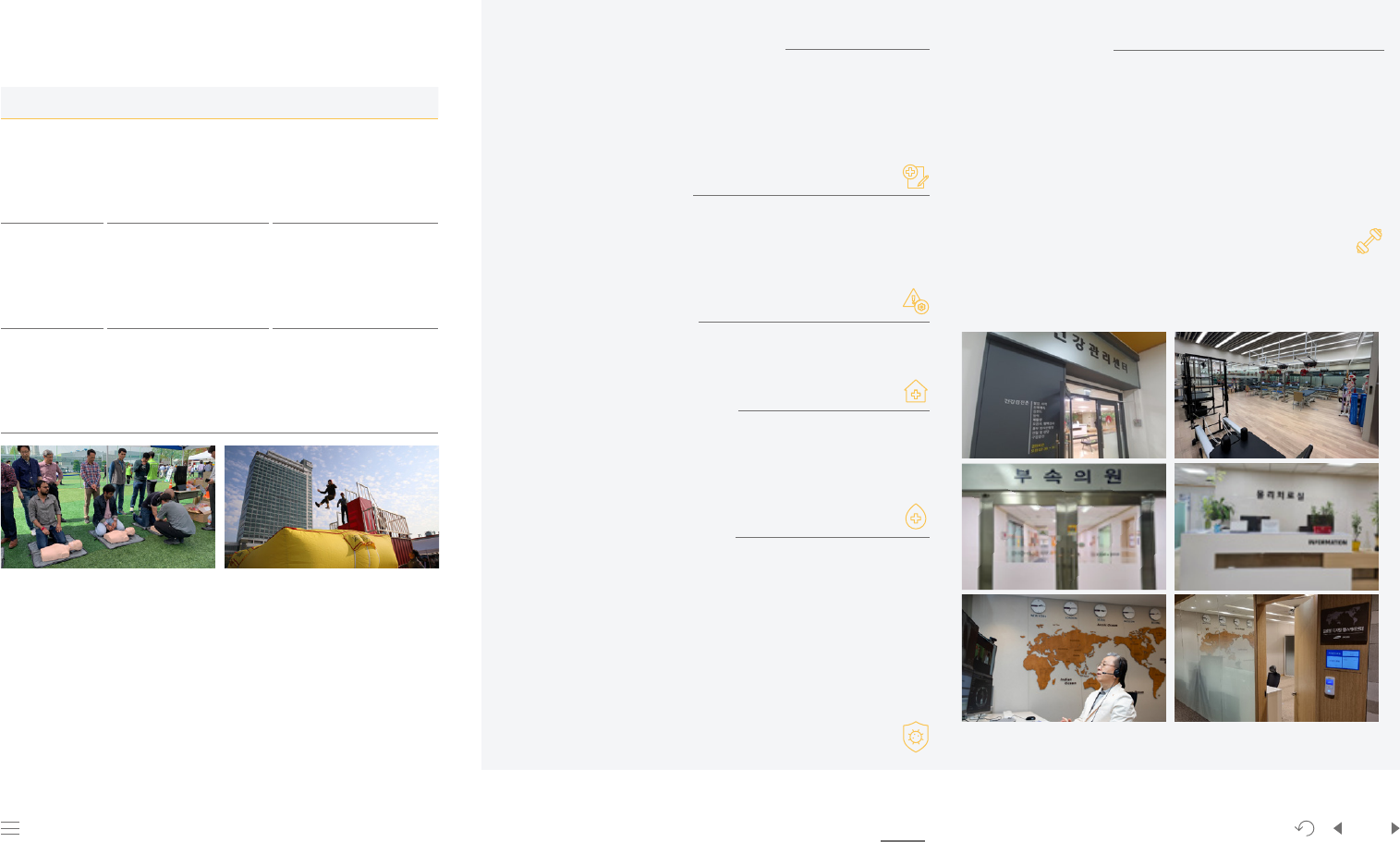
Our Company AppendixApproach to Sustainability Facts & Figures PrinciplePlanet
52
People
Samsung Electronics Sustainability Report 2023
Healthcare for Employees (Korea)
Physical Examinations and Follow-Up Management
· Annual physical examinations for all of our employees (standard, comprehensive,
and special)
· Comprehensive physical examinations a wide range of advanced health
assessments
· One-on-one consultation with a physician and healthcare programs for
employees diagnosed with special conditions
Focused Care for High-Risk Groups
· High-risk groups requiring focused care screened based on physical examination
results
· Integrated healthcare infrastructure provided (consultation with dedicated
physicians, attendance management, provision of blood pressure and blood
glucose meters, physical training support, etc.)
On-Site Health Promotion Facilities
· In-house clinics (physical therapy, diagnostic testing, diagnostic radiology, etc.)
· Musculoskeletal Disorder Prevention Exercise Center
· Health promotion programs of the in-house physical examination center
Contact-Free Medical Examination Service
· Contact-free remote medical examination service introduced for our employees
stationed globally and on business trips and their families (in connection with
locally-based general hospitals)
· Consultation available across 24 disciplines and detailed secondary examination
offered for local medical records
Infectious Disease Prevention and Control
· Integrated infectious disease control through the S-Care system (reporting
of confirmed and suspected cases, reservations with screening stations,
vaccination, patient screening questionnaire, etc.)
· Publication of the white paper on COVID-19 response and establishment of the
company-wide response system
· Operation of screening stations (PCR testing, rapid antigen testing, and
respiratory diagnosis)
· Disinfection and provision of infection control supplies for employees (masks,
diagnostic kits, thermal imaging tools, hand sanitizer, etc.)
Health Promotion Programs
· Moderate-intensity exercises including walking: Walking Challenge using the
Samsung Health app and group exercise programs in connection with on-site
health promotion facilities
· Anti-obesity: 12-week constitution-changing program based on diet therapy,
exercise, and weekly lectures by bariatricians
· Anti-smoking: Diagnosis and prescription by physicians of clinics collaborating
with National Health Insurance Service
· Chronic diseases: One-on-one tailored chronic disease control program
supported by health managers and our mobile app
Our Efforts to Promote Employee Health
In order to promote employee health, improve the work environment, and prevent occupational diseases, we are operating company-wide specialized
units as well as dedicated organizational units at individual sites. DS’s Samsung Health Research Institute has been in operation since 2010 as
the nation’s first corporate initiative specializing in the prevention of diseases and healthcare for frontline workers. DX is operating the Health
Management Office.
Category
Details 2022 Performance
Employees
Introductory training,
legally required basic
training, safety leadership
training for executives
· Conducted 746,057 hours
of training
· Training 172,510 employees
Staff in charge
of environment/
safety (Korea)
Internal auditor training,
specialist cultivation
training, legally required
continuing training
· Conducted 32,866 hours
of training
· Training 5,242 employees
Staff in charge
of environment/
safety (Global)
Training developed by
individual sites
· Conducted 1,123,484 hours
of training
· Trained 102,871 employees
Safety Training for Employees
In order to enhance the emergency response capabilities of all of
our employees and take full advantage of the AEDs installed at our
business sites, we made CPR and AED training regular. Health and
safety trainings, safety leadership training for executives, and seminars
for staff members in charge of safety are being conducted, as well as
safety events and safety campaigns to embed safety in all aspects of
our business operations.

Our Company AppendixApproach to Sustainability Facts & Figures PrinciplePlanet
53
People
Samsung Electronics Sustainability Report 2023
Musculoskeletal Disorder Prevention Exercise Center
We have operated the Musculoskeletal Disorder Prevention Exercise
Center to help our employees prevent relevant diseases and maintain
optimal health since 2010.
The Center offers examinations on basic body composition, sense
of balance, core muscle strength, etc., as well as somatotype
measurement, while also providing one-on-one expert consultation to
recommend appropriate programs.
In 2022, DS provided diverse programs including group exercises,
exercise therapy, and counseling and offered onsite kinesio-taping
trainings targeting frontline workers with a heavy physical workload.
Ergonomic Line Certification
We make continuous ergonomic improvements to our work
environment to ensure the wellness and comfort of our employees. In
this context, we operate the ergonomic line certification system based
on the Rapid Entire Body Assessment (REBA), which analyzes each
manufacturing process from an ergonomic perspective and provides
a quantitative evaluation. In 2021, we developed an ergonomic analysis
Work Environment Improvement
Work Environment Improvement
· Assessing working conditions (chemicals, noise, dust, etc.)
· Installing localized ventilation equipment and monitoring control flow
· Monitoring indoor air quality
Chemicals Management
· Conducting pre-inspections of chemicals and providing safety guidelines
· Performing chemical risk assessments (regular and special)
· Performing regular inspections of high-risk chemicals and replacing
them with alternatives
Mental Health Promotion for Our Employees
We are equipped with a network of 16 in-house Life Coaching Centers
and 13 Mental Health Clinics in Korea and operate the Life Coaching
Center at 20 production sites and 11 research institutes in other regions.
* Global sites and research institutes without an in-house Life Coaching Center utilize
external employee assistance program providers.
Life Coaching Center
The Life Coaching Center is staffed by certified counselors to provide
expert counseling services. Each location is equipped with a meditation
room to help our employees learn ways to effectively control everyday
stress through various programs (tension relief, meditation, color therapy,
pain relief, etc.).
Counseling Center
Psychiatrists are stationed at the Mental Health Clinic to provide one-on-
one consultation, medication and psychotherapy, and training for a wide
range of issues including work life, interpersonal relationships, stress, and
family life. Confidentiality is guaranteed for information obtained through
consultation pursuant to the code of ethics for counselors and the Medical
Service Act.
Online Counseling Channel
In Korea, we have operated an online psychotherapy program and diverse
counseling channels (video, telephone, and messenger) for our employees
since the outbreak of COVID-19 to ensure their wellness. We also set up a
hotline at our production sites and research institutes in India to provide
wider access to our services.
tool to automatically analyze the video-recorded motions of workers
and distributed it to all of our global business sites. This significantly
reduced ergonomic analysis time and improved the credibility on the
ergonomic analysis of workers. In 2022, we identified 561 improvement
points (2.4 times higher than previous year), including ergonomically
unreasonable posture, repetitive motions, and excessive strain through
the analysis of 565 manufacturing lines and took remedial actions
accordingly.
Samsung Artisan Certification Program for Environment and Safety
We have operated the Samsung Artisan Certification Program since
2019 to enhance our frontline competitiveness and foster top-tier
specialists.
This program certifies those employees who have at least two
decades of experience in the areas of equipment, instrumentation,
manufacturing, molding, instrumentation, equipment, and quality,
which require profound expertise and knowhow, and are noted for their
artisan-level prowess as specialists in their area.
The area of environment and safety was added to this program in
2022, and our first environment and safety artisan was selected. We
also newly set up the EHS Certification Office to utilize the artisan’s
experience and knowledge to build a safer workplace.
The EHS Certification Office plans to provide specific safety levels for all
types of manufacturing equipment and perform pre-inspection, on-site
verification, and improvement to ensure safety at work. It will also strive
to enhance workplace ergonomics. We will continue to focus on accident
prevention and maintain world-class safety at our business sites.
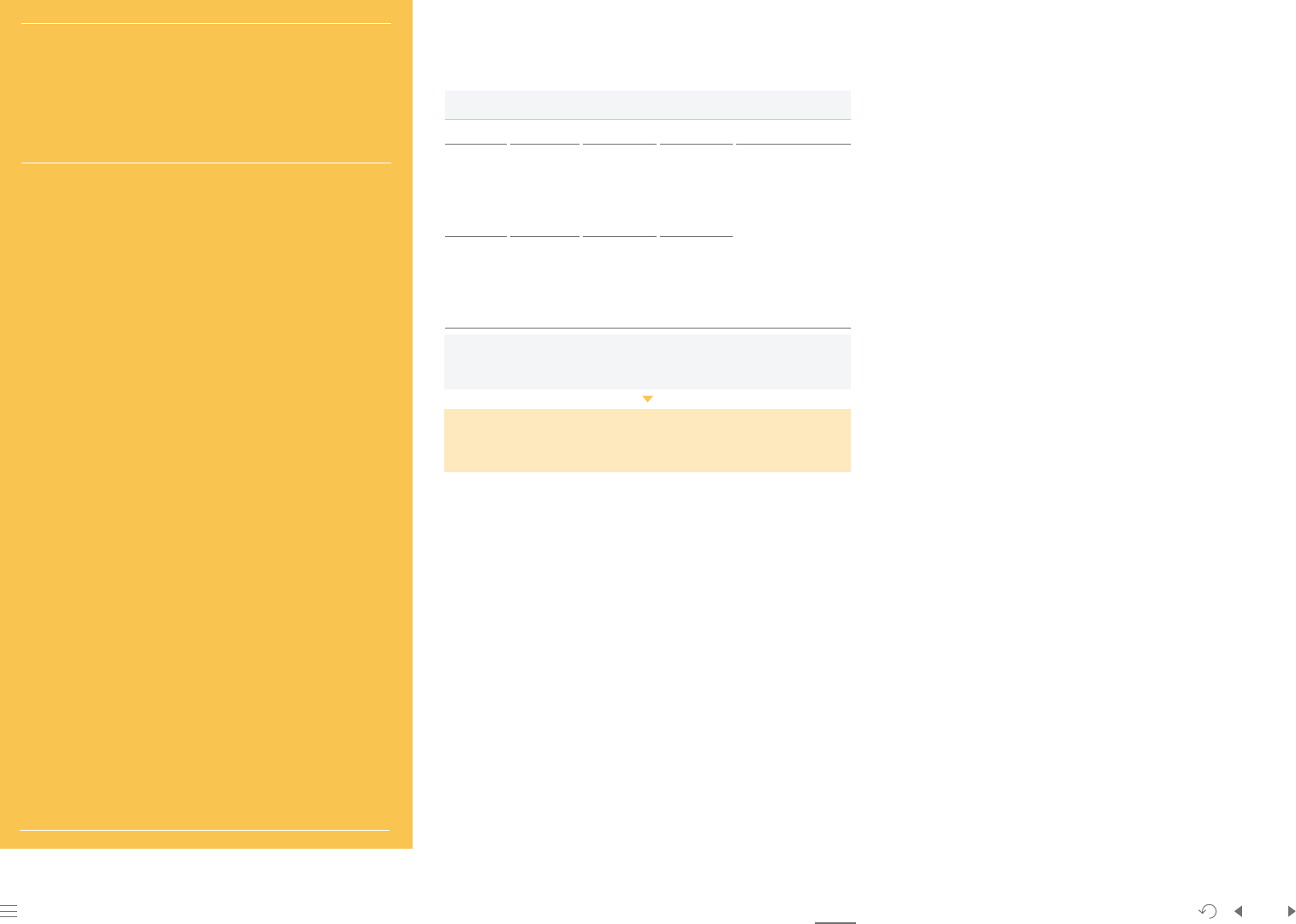
Our Company AppendixApproach to Sustainability Facts & Figures PrinciplePlanet
54
People
Samsung Electronics Sustainability Report 2023
Access to a Range of Capacity-Building Programs
Our employees participate in diverse external training programs in
accordance with their career stage and needs. We provide support
for MBA programs, master’s programs in HR and finance, and other
academic training programs.
The Samsung Semiconductor Institute of Technology (SSIT), which was
launched as an in-house semiconductor technology school in 1989
with the aim of enhancing the technological capabilities of frontline
workers, was officially acknowledged as a university in 2001 and now
offers four-year bachelor’s degree programs in the areas of equipment,
infrastructure, and display.
The Regional Specialist program introduced in 1990 is a self-led global
training program aimed at helping employees with at least three years
of experience in the company learn the language and culture of another
Talent Development
Talent Development Structure
Internal development
External development
Key areas
Key areas
Objective
Sharing
our vision,
values, and
culture
Fostering
future global
leaders
Fostering top-
tier experts
for different
functions
MBA
Regional Specialist
Academic training
In-house technology
school
Curriculum
Introductory
training
for new
employees
Training based
on our SELF*
leadership
model
Job-specific
expert
training
Workplace learning, mentoring, coaching,
on-the-job training
Knowledge Network (through Web 3.0, social media, and mobile platforms),
Samsung U Learning Portal, Software Expert Academy, Knowledge contents
country for one to two years. Over 3,500 regional specialists for 80
countries have been developed through this program.
In addition, we opened the Semiconductor Display Engineering
Department and DMC (Digital Media Communication) Engineering
Department at Sungkyunkwan University, which together function as
our in-house graduate school, to cultivate future technology leaders.
As of February 2023, we have nurtured 1,076 bachelors’, 816 masters’,
and 91 doctorate degree holders through SSIT and our in-house
graduate school.
Effective and Practical Training
In order to ensure the effectiveness and practical value of our training
programs, we offer key functional and leadership training programs
in conjunction with qualification programs of external accreditation
institutions. In 2022, 92% of our the course participants attained
relevant qualifications upon completion of their training including the
ISO 9001 Quality Management System Certification (95%), CPSM*
(88%), and KAC** (93%).
* Certified Professional in Supplier Management
** Korea Associate Coach
Opportunities to Switch Jobs Internally
The Job Posting platform provides opportunities for our employees
to switch jobs within our company. Over the past three years, 2,598
employees have transferred to their position of choice, which made a
positive impact on both the individuals and their organizational units.
We support their soft landing in the new position through mindset
training for changes, mentoring as well as job competency training.
In 2022, we introduced the Free Agent (FA) initiative and Samsung
Talent Exchange Program (STEP). FA allows employees who have
worked in the same function or organization for at least five years to
transfer to their position or organization of choice and offers capacity-
building opportunities before they take the new role. STEP is an
employee exchange program utilizing our global network, through
which outstanding employees at our Korea and global business sites
swap their positions for up to two years.
We foster a continuous learning and development
culture for our employees by actively supporting
their professional growth.
Human Resource
Management
* SELF: Samsung Electronics Leadership Fundamentals
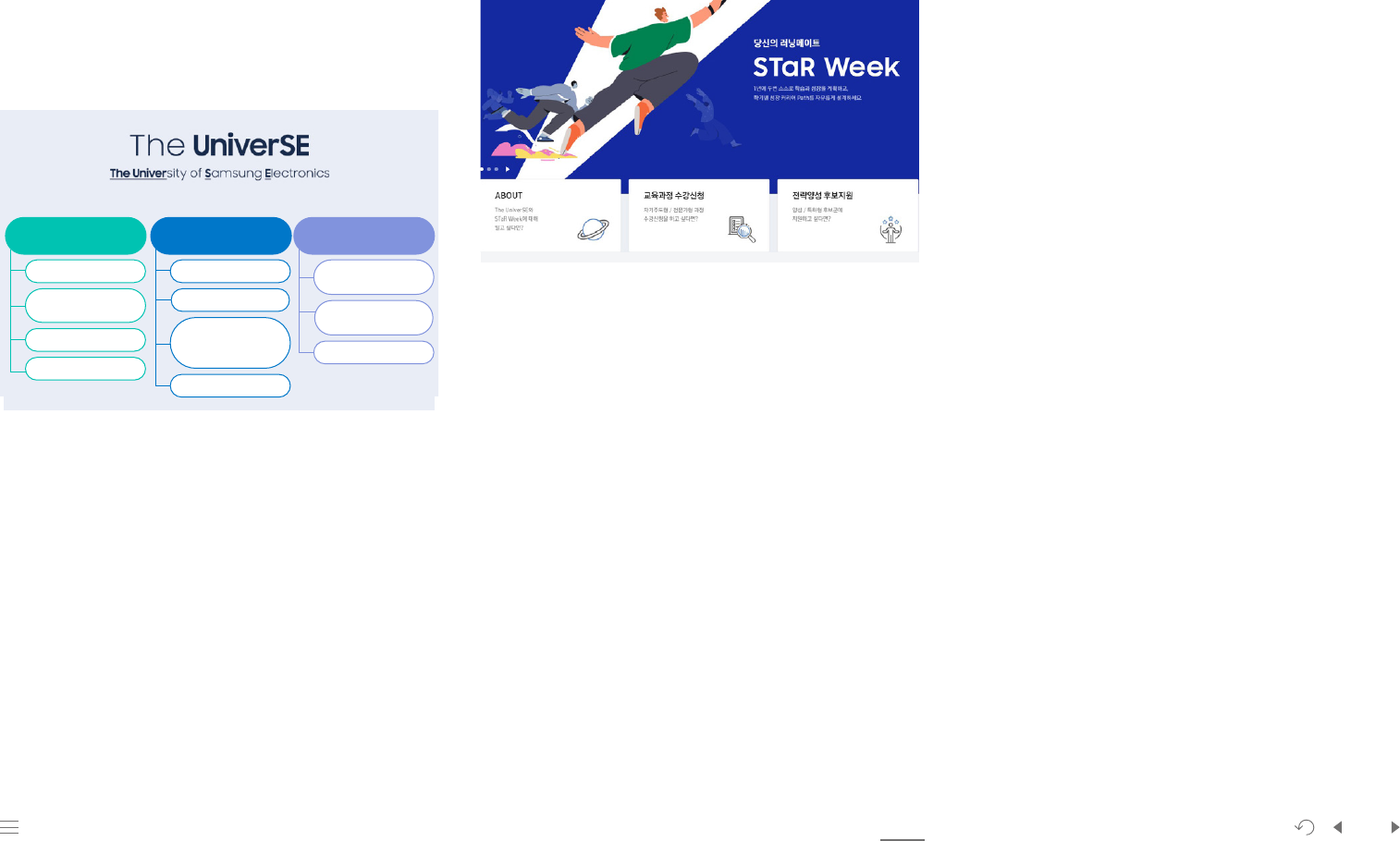
Our Company AppendixApproach to Sustainability Facts & Figures PrinciplePlanet
55
People
Samsung Electronics Sustainability Report 2023
Encouraging Self-Learning
Our employees are encouraged to explore and sign up for self-led
training courses offered by the company during the biannual STaR
Week. This system inspires our employees to push their limits and
proactively take part in courses beyond their current job functions.
The UniverSE
With the aim of providing a comprehensive platform for employees
seeking professional development, we integrated existing individual
training modules scattered across different functional roles into a
single body known as The University of Samsung Electronics or The
UniverSE. The UniverSE, which consists of 11 schools under three
academies, is designed to enhance job competency and leadership
of employees, foster a culture of self-learning, offer practical and
grounded training, and promote convergence among diverse functional
roles and thematic areas.
Employee Performance Appraisal and Feedback
We require our employees to establish their individual work goals at
the beginning of each year, for which the heads of their organizational
units provide one-on-one feedback throughout the year. Individual
performance appraisals based on these goals happen at the end of the
year. We continue to make improvements to this system to ensure that
it is fair and rational. As a part of the effort, we shifted from a relative
scale to an absolute scale in 2022 and we introduced a quarterly
feedback in 2023.
I n-House Professor Program for Knowledge- and
Experience-Sharing
The UniverSE appoints employees noted for their outstanding
performance based on their experience and knowledge as in-house
professors specializing in different job functions to share their
expertise. They are responsible for developing their own teaching
contents and delivering practical training that participants can readily
utilize at work. Currently, 42 in-house professors are teaching at The
UniverSE. We plan to expand our pool of in-house professors further.
Leadership Academy
Advanced-Tech
Academy
Global CX Academy
Sales and
Marketing School
Procurement
School
Design School
SW School
R&D School
Production and
Manufacturing
School
CS School
Leadership School
Management
School
Humanitas School
Onboarding School
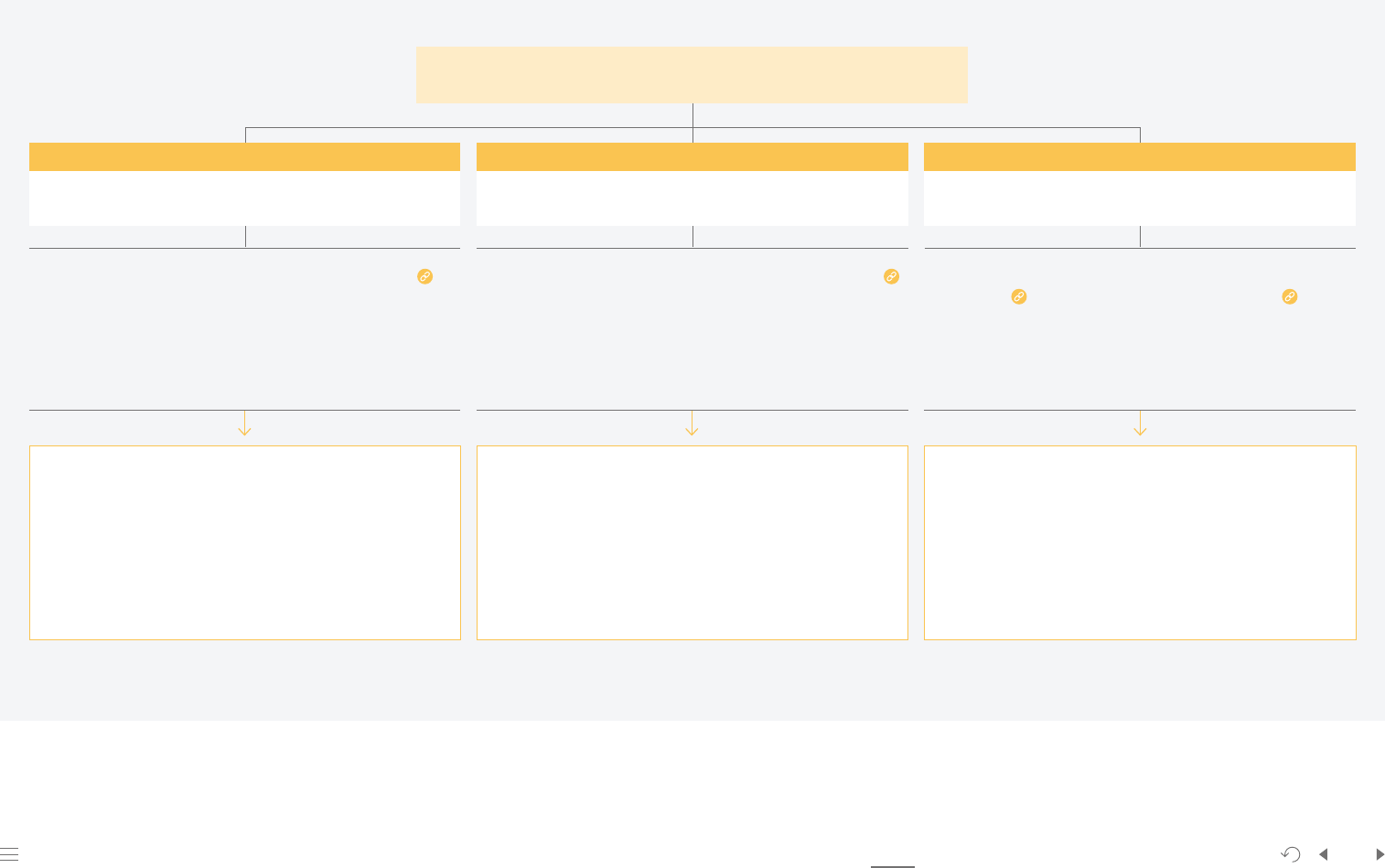
Our Company AppendixApproach to Sustainability Facts & Figures PrinciplePlanet
56
People
Samsung Electronics Sustainability Report 2023
Upskilling for Digital Transformation
With the aim of equipping our employees, suppliers, and local community members with the skills needed in the future workforce, we offer a comprehensive training structure encompassing digital and IT technology programs.
Upskilling for Digital Transformation
Data Science Capacity-Building
Employees
Big Data
Suppliers
Samsung SW Academy for Youth
Samsung Innovation Campus
Future generations
Data Science Capacity-Building is a training program available at
The
UniverSE’s High-Tech Academy. It provides theoretical knowledge, case
studies, and hands-on training in four different levels. Level 1, which is the
basic course, targets all employees to help them keep abreast of changes
related to data transformation.
[Interview with a trainee of Data Science Capacity-Building]
By applying the data analysis methodology that I acquired through Data
Science Capacity-Building, I am able to better define the data required for
each task, efficiently collect and pre-process the data, and establish an
analysis plan. I am keen on delving into more advanced analysis methods
through the data science training and apply them to real-world tasks.
[Interview with the Big Data course planner]
Suppliers often lack the infrastructure required to systematically collect
and analyze information on the ground. Nevertheless, their employees
are enthusiastic to learn about and utilize Big Data. Thus, we created a
curriculum offering theoretical basis as well as practical applications of Big
Data analysis at the workplace.
[Interview with a trainee of Samsung Innovation Campus in Indonesia]
I experienced some difficulties at first but was led to navigate all
those difficulties and develop capabilities in diverse areas including
programming. I learned how to seek acceptable solutions to diversifying
problems and create a plan to successfully implement those solutions
based on new knowledge and skills obtained at Samsung Innovation
Campus.
Big Data training
is offered by the Partner Collaboration Academy .
The Big Data course was established in 2023, with new subjects including
“Understanding Big Data through Case Studies” and “Easy-to-Learn Basic Big
Data Analysis” combined with AI programming, Python, R, and other existing
software subjects, to more effectively drive data capacity-building for our
suppliers’ employees.
We place a premium on capacity-building programs for youth among our CSR
activities. The
Samsung SW Academy for Youth (Korea) and
Samsung
Innovation Campus (global) are designed to help the young generations
grow into future leaders equipped with technical skills, including coding,
programming, Big Data, AI, and IoT, as well as soft skills.
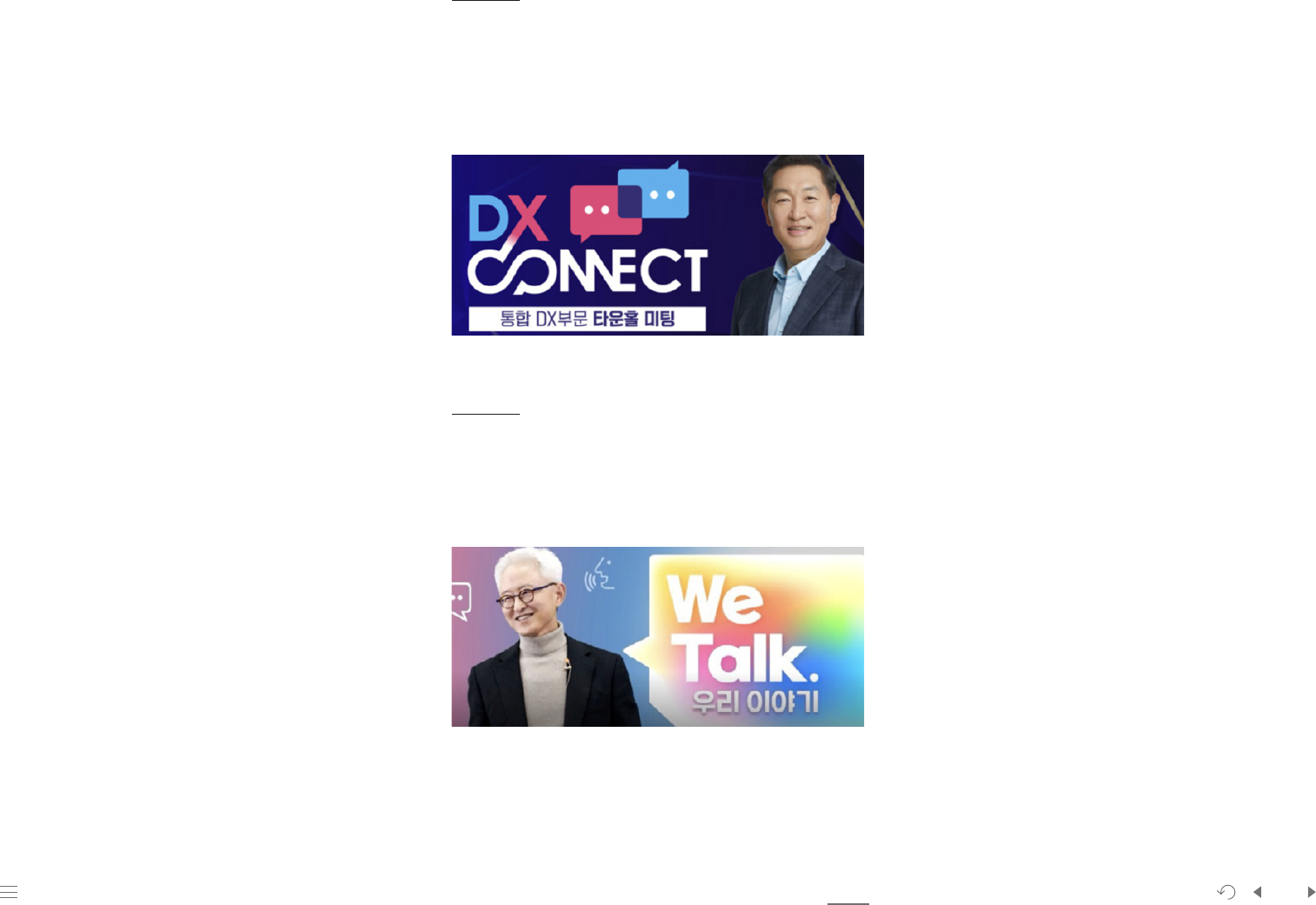
Our Company AppendixApproach to Sustainability Facts & Figures PrinciplePlanet
57
People
Samsung Electronics Sustainability Report 2023
Organizational Culture
Better Workplace, Better Life
We strive to foster a constructive organizational culture founded upon
the values of diversity and inclusion where employees are able to
immerse themselves and grow.
A Culture of Mutual Respect
We promote a culture of mutual respect and trust among employees of
all ranks, from working-level to executive management, by adopting
various communication methods and channels.
Horizontal Communication
In 2017, we reorganized the hierarchy of seven ranks into a more
horizontal structure of four Career Levels (CLs) and introduced equal
titles for addressing employees of all levels including “nim” (a gender-
agnostic title of respect), “pro” (short form of “professional”), and
English names, in pursuit of a more flexible and inclusive organizational
culture. In 2022, we made it mandatory to use the honorific form of
language at work at all times regardless of position, title, seniority, or
age, and removed information indicating the ranks and seniority of
employees from our internal system.
Communication with the Executive Management
Our town hall meetings, held regularly under the leadership of division
and business heads, are well-received among many employees. They
serve as an effective channel for executives to convey their business
philosophy, direction for the company, and current management
agenda and to communicate directly communication with employees
through real-time Q&A sessions.
Team heads and group heads also interact with staff members through
monthly meetings and team-building events and strive to build trust by
listening to the difficulties of staff members and offering solutions on
site through one-on-one as well as group meetings.
DX Division The DX Connect Town Hall Program hosted by the CEO
is a platform where the executive management and staff members
exchange their views on the corporate business strategy and priority
issues. Other channels organized by the DX division to strengthen
internal communication include CEO One Table, a smaller-scale tea
meeting for the CEO and staff members, and the DX Connect Bulletin,
an online space for open communication.
DS Division The DS division organizes WeTalk, a program led by the
division head and executive management and streamed in real time,
and TeaTalk, a small-scale meeting of the division head and staff
members, on a weekly basis. DS also shares the latest developments of
the executive management through the release of the CEO’s Message
and is further diversifying its communication channels.
Online Communication Platform
We first began to operate an anonymous online bulletin to help
our employees freely share their opinions and thoughts in 2009.
In December 2020, we upgraded it into a comprehensive online
communication and info-sharing platform, Samsung Electronics NOW.
Employee Experience Management
We conduct a monthly survey known as the EX Pulse Survey to collect
our employees’ views on the work environment. We collect and analyze
employee experiences and take remedial action for any inconveniences
detected to enhance our employees’ morale, work satisfaction, and
productivity. The survey themes change each month to identify and
cater to their needs in a preemptive manner.
Work-Life Balance
Programs to Ensure Work-Life Balance
We continuously make improvements to our work systems by adopting
flexible and efficient programs tailored to individual job functions.
We allow our employees to customize their working hours and annual
leave and have more control over their schedule to provide a truly
“work-smart” environment. We also opened D'light (our on-site and
off-site flexible work-spaces) in 2022 as an extension of our “work
from anywhere” policy focused on enabling our employees to perform
their tasks regardless of location. It consists of off-site office spaces
designed to increase the productivity and convenience of those who
opt to work remotely and on-site library or café-style work-spaces to
encourage autonomous and creative work.
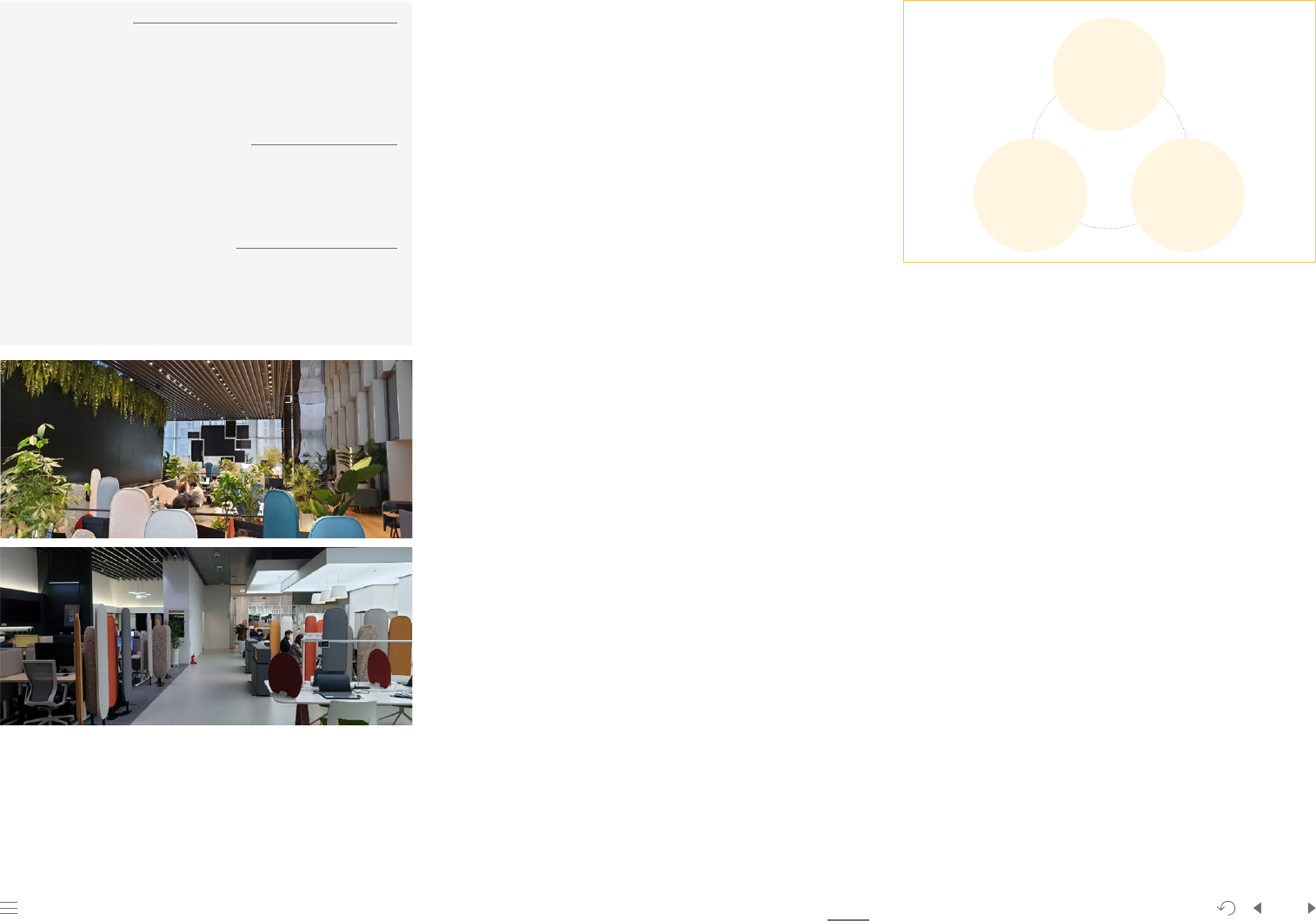
Our Company AppendixApproach to Sustainability Facts & Figures PrinciplePlanet
58
People
Samsung Electronics Sustainability Report 2023
Welfare Benefits
We strive to ensure better quality of life, enhance work satisfaction,
raise morale, and maximize work engagement for our employees
through a range of welfare programs. We help our employees remain
prepared for their post-retirement life through personal pension
support, while also covering educational and healthcare expenses for
their family members. We also offer physical examinations and group
insurance services to promote workplace health and safety, as well as
an array of selective welfare programs based on individual needs.
Work Satisfaction Improvement
Improving Our Organizational Culture
We conduct the Samsung Culture Index (SCI) survey each year for our
employees around the world to diagnose our organizational culture.
Until 2021, we conducted a workspace satisfaction survey, and in 2022,
we developed an organizational health diagnosis to focus on identifying
our strengths and to remedy our weaknesses. The target areas of SCI
diagnosis are work engagement, team collaboration, and company
pride. For each area, we include Outcome Questions to identify the
current status of the organization and Driver Questions to highlight
improvement points. In 2022, over 240,000 employees at 138 business
sites participated in the survey.
We offer organizational culture consulting for units with lower SCI
scores to identify improvement points and seek solutions. We engage
professional consultants if deemed necessary and encourage the unit
head and staff members to join hands and develop improvement plans
for problems detected through the survey and employee interviews.
We also check if the problems are properly remedied and receive
feedback through post-consulting satisfaction surveys.
New SCI Structure
Work
Engagement
Team
Collaboration
Company
Pride
Family Day (Korea)
In an effort to counterbalance the work-driven culture in Korea, we have
policies in place to encourage employees to spend quality time with
their family and friends. A case in point is the Family Day - or the monthly
payday - when employees leave work early. Some organizational units
have developed this program into biweekly or weekly short work days.
Remote Working for Work-Life Balance
We offer remote working options to help maintain a better work-life
balance. The percentage of those working remotely has continued to
increase post-pandemic. As of March 2022, 39% of our employees at
global sales offices and research institutes were telecommuting.
D’light (Korea) for Flexibility at Work
D’light, developed to promote flexibility at work, consists of two off-site
office spaces in Seoul (Seocho Building) and Daegu (ABL Tower) and four
on-site work-spaces in Suwon (Digital City), Seoul (Seoul R&D Campus),
Gumi (Smart City), and Gwangju (Green City).
Employer Branding Activities
Under the key message of "Diverse eXperience in Samsung", we value the
experiences of our employees and, by doing so, strive to remain relevant
and competitive as an employer. We work with "employeeners (employee
+ influencers)" who share their stories of working at the company with
internal and external audiences through self-made videos.
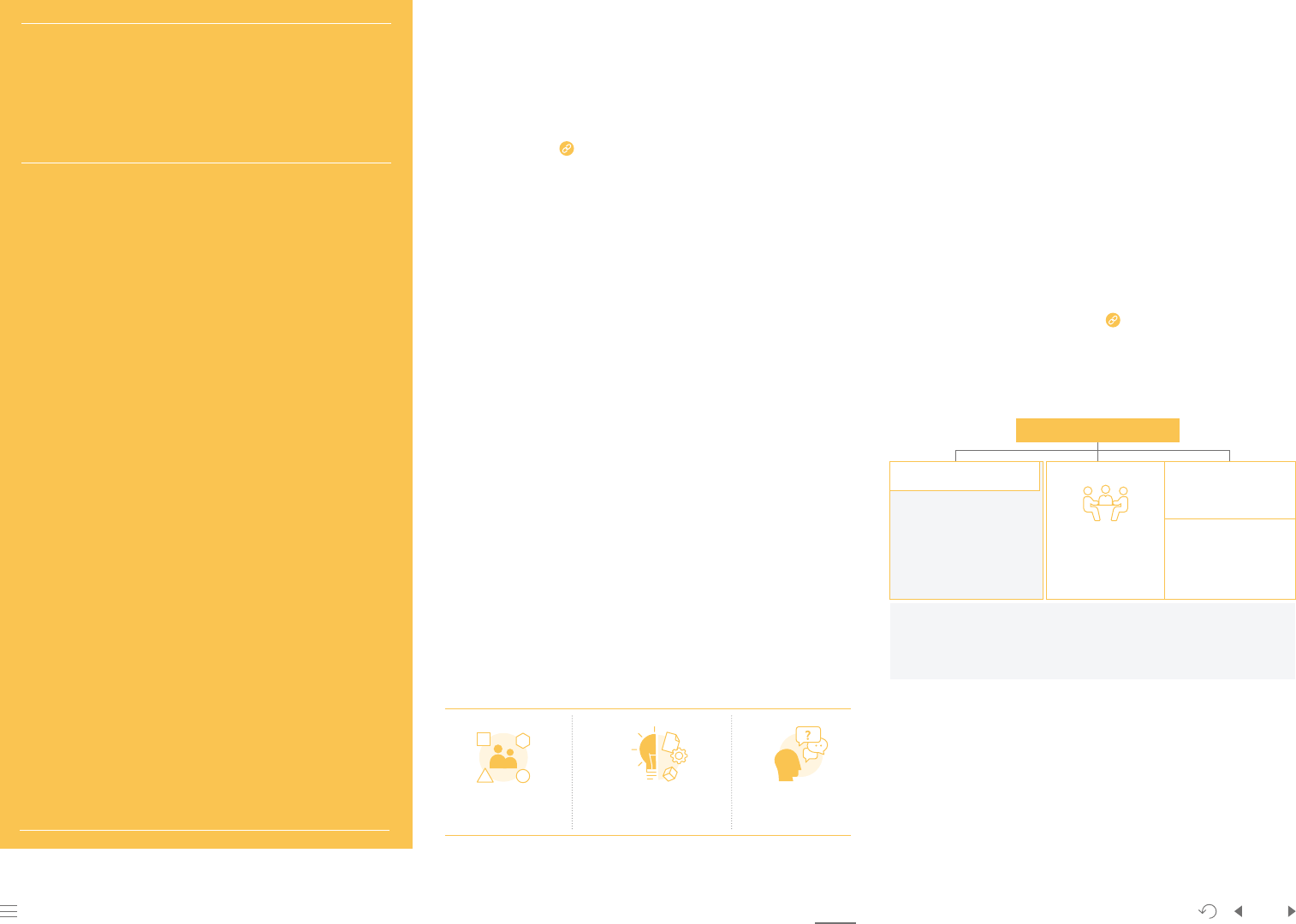
Our Company AppendixApproach to Sustainability Facts & Figures PrinciplePlanet
59
People
Samsung Electronics Sustainability Report 2023
Promoting Diversity, Equity, and Inclusion
Non-Discrimination Policy
We ensure that all of our employees, both our current and prospective
employees are given equal opportunities based on our non-
discrimination policy (Samsung Electronics Anti-Discrimination and
Harassment Policy
). We do not discriminate against any current
or prospective employees based on gender identity, race, ethnicity,
nationality, religion, age, marital status, sexual orientation, among
others or in HR matters such as job assignment, promotion or
compensation.
We also strive to respect and protect the human rights of workers
based on the UN Universal Declaration of Human Rights, OECD
Guidelines for Multinational Enterprises, and local laws of different
countries.
Our DEI Principles
In 2022, we established diversity, equity, and inclusion principles to be
taken into consideration in all of our business activities in collaboration
with UX experts and strive to apply them to the products and services
we offer.
As our products and services target the 8 billion potential users
around the world, it is imperative that we remain inclusive. We must
respect individuals’ traits and freedom of expression and not judge or
perceive them as stereotypes. To this end, we must continue to monitor
our actions and decisions throughout the entire process of product
planning, development, and release to check if any element is likely to
marginalize or cause harm to others.
We plan to conduct campaigns and trainings on the DEI Principles for
our employees around the world.
Governance
We established the DEI Office to develop company-wide DEI strategies
and implement diverse programs to enhance our DEI performance
in collaboration with relevant staff members of our businesses and
subsidiaries. The DEI Council joins hands with functional organizational
units including the Corporate Sustainability Center, Global Marketing
Office, Corporate Communications Team, and Corporate Design Center to
seek solutions to company-wide DEI issues.
In 2022, we worked with the council to establish our DEI Language
Guide, launched a social media campaign to celebrate International
Women's Day, and collaborated with external stakeholders. Over 200
DEI managers regularly share and distribute best practices identified
at our business sites around the world. In addition, we actively support
Employee Resource Groups (ERGs
) that voluntarily engage in
mentoring, cultural exchanges, and community outreach. More than
5,200 employees around the world are taking part in ERGs organized
under various themes.
Areas of Focus
We respect the unique cultures of individual regions and the beliefs
of individual employees. As we are present at over 230 locations in 74
countries, we respect each region’s autonomy and variations in their
approach to enhancing DEI. At the global HQ-level empowering women
and persons with disabilities are core focus areas and as such, diverse
strategies are in place at the regional level.
Celebrate diversity Challenge assumptions Stay curious
DEI Office
- Corporate
Communications Team
- Corporate Sustainability
Center
- Corporate Design Center
- Global Marketing Office
DEI Council
People Team for
each region
People Team at each
subsidiary
(production / sales /
research staff)
Employee Resource Groups (5,200 members in North America, Europe,
Southwest Asia, and Latin America)
* Women, persons with disabilities, race, inter-generation, LGBTQ+, veterans,
working parents, among others
Implementation
units
People Team within
each business
We believe in building a diverse, equitable,
and inclusive workplace that is key to innovation
and progress. We strive to nurture a corporate
culture that brings together people from different
backgrounds inspiring them to shape a better
tomorrow for our customers, partner companies,
and local communities.
Diversity, Equity,
and Inclusion
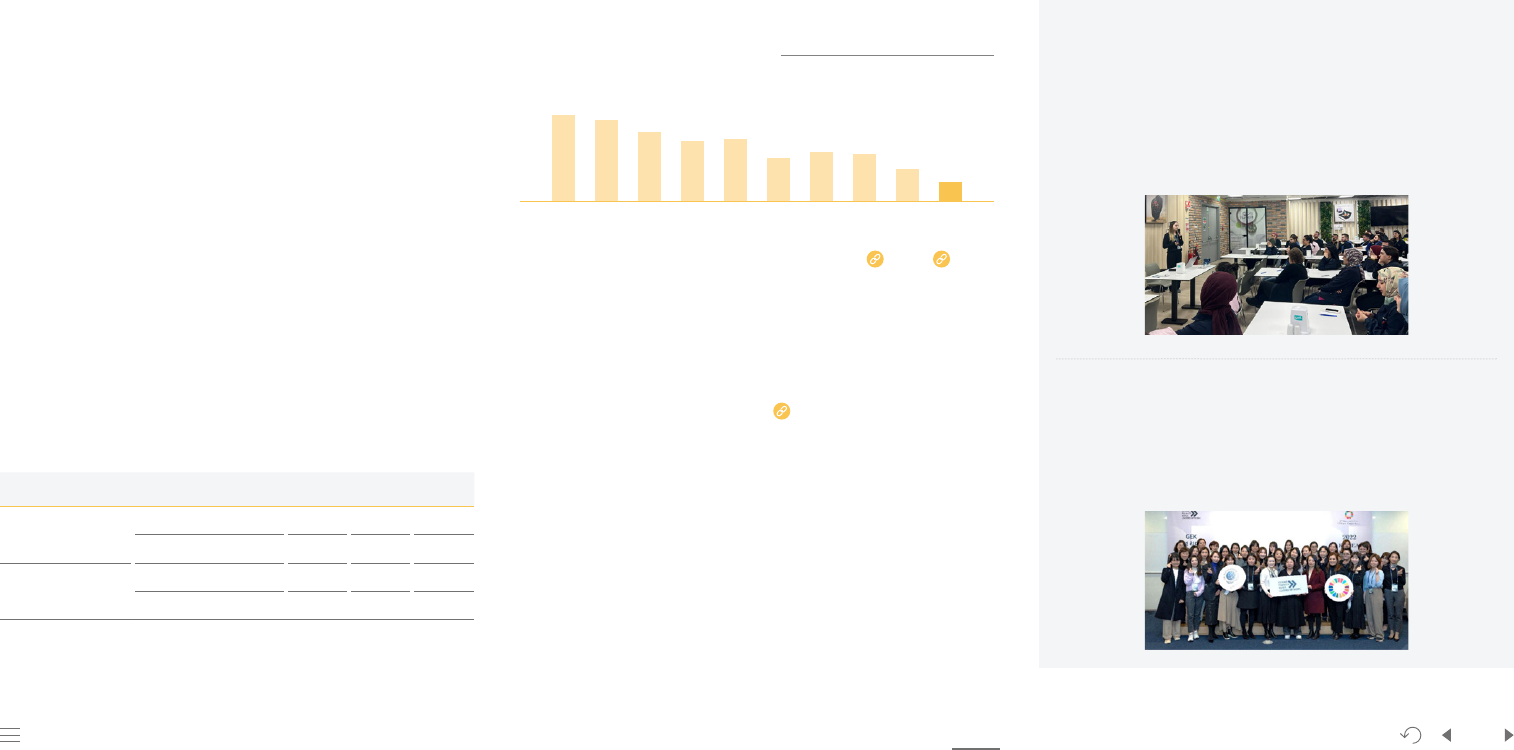
Our Company AppendixApproach to Sustainability Facts & Figures PrinciplePlanet
60
People
Samsung Electronics Sustainability Report 2023
Empowering Women in the Workplace
As part of our focus on building a culture centered on diversity, equity,
and inclusion, we strive to inspire our employees to reach their full
potential through access to equal opportunities. We operate a range of
programs and policies to ensure gender equality in recruiting new hires
and to help our female employees return to work and successfully build
their career after taking leave for pregnancy and childbirth. In Korea,
we made it possible for pregnant employees to apply for the reduced
working hour program across their entire pregnancy period from 2023
– well beyond the eligible period of “within 12 weeks or after 36 weeks
of pregnancy” set by national law. We also offer 15 days (20 days for a
multiple pregnancy) of paid childbirth leave for spouses and five days
of paid fertility treatment leave. We also strive to address gaps in the
national law through policies such as three days of paid stillbirth and
miscarriage leave for spouses.
We are operating the nation’s largest network of in-house daycare
centers for working parents and currently reviewing its expansion to
meet the needs of the increasing number of employees. We introduced
a reboarding program that offers training, mentoring, and remote
working options to employees returning to work after childcare leave
and operate snack corners for pregnant employees within in-house
cafeterias and reserved seats in commuter shuttles.
Women Leadership Targets
We strive to increase women in our leadership positions by setting
internal targets and closely monitoring the share of women in the
recruitment, promotion, and retirement of our employees. As a result,
within the last ten years the share of female executives grew from 2.4%
to 6.9% and that of female managers from 8.3% to 16.9%.
Gender Pay Gap in Korea
We are committed to a policy of equal pay for all employees with
equivalent levels of experience and performance, regardless of gender.
An analysis of gender pay gaps in 2022 in Korea based on our career level
(CL) system found that there was close to none among CL 1 employees,
1% among CL 2 professionals, and 5% each among the CL 3 and CL 4
groups. Nevertheless, an analysis of average wages of the workforce
in Korea found a notable gender gap of 23.1%. Although it is an 11.7%p
improvement from 2013, the gap remains relatively large which is mainly
due to the smaller share of women in leadership positions. As such, we
continuously strive to increase women in leadership positions though
internal targets and programs. Moreover, we are seeking ways to address
gender pay gaps within our global workforce.
We transparently disclose the gender pay gaps at our
UK and France
subsidiaries and foster women professionals and leaders.
Global Self-Assessment on Gender Equality
We assessed the status of gender equality and women’s empowerment
at our major global business sites using the Women's Empowerment
Principles Gender Gap Analysis Tool (
WEPs Tool) and took remedial
actions for the improvement points identified. As of this effort, we revised
the systems and trainings on gender equality at these sites and plan
to address additional room for improvement including strengthening
communication with local stakeholders. We also distributed the
guidelines on enhancing gender equality at our production sites and
research institutes with the aim of helping them establish relevant
policies. For example, tangible improvements have been made in terms
of infrastructure such as on-site nursing facilities, priority seats in
commuter shuttles, and priority parking spots, based on these guidelines.
Next-Generation Women Leadership Workshop
The Next-Generation Women Leadership Workshop has been operated
since 2021 in Korea to provide support for our female executive
candidates to take a successful leap from a working-level position to
an executive position. The Workshop offers participants mentoring
by female executives, coaching on leadership skills, and networking
opportunities with their peers. This Workshop helps participants
establish their own vision and goals and exchange valuable
experiences and knowledge with their seniors of the same gender. We
plan to continuously expand networking opportunities of this kind for
our female employees.
Gender Pay Gap in Korea (2013-2022)
34.8
33.9
31.8
30.2
30.7
27. 3
28.4
27.9
25.3
23.1
13 1714 1915 2016 2118 22
Gender Equality Training
Since October 2022, DX conducts specialized trainings to enhance our
employees’ awareness of gender equality at our global production sites
and R&D centers. Learning materials were developed in collaboration with
Business for Social Responsibility (BSR) with a focus on understanding
concepts such as gender differences and stereotypes. We are employing these
materials in our country- and culture-specific trainings on gender equality.
Participation in the Gender Equality Korea Leaders Network
Managers from the DEI Office participated in the Gender Equality Korea
(GEK) Leaders Network launched by UN Global Compact Network Korea in
2022 and exchanged benchmarkable cases in women’s empowerment and
cultivation of female leadership.
Category
2012 2017 2022
Women by job type
Development(%) 16.0 17.7 19.2
Sales and Marketing(%) 30.0 29.7 33.6
Women in leadership
Executives(%) 2.4 6.8 6.9
Managers(%) 8.3 13.2 16.9
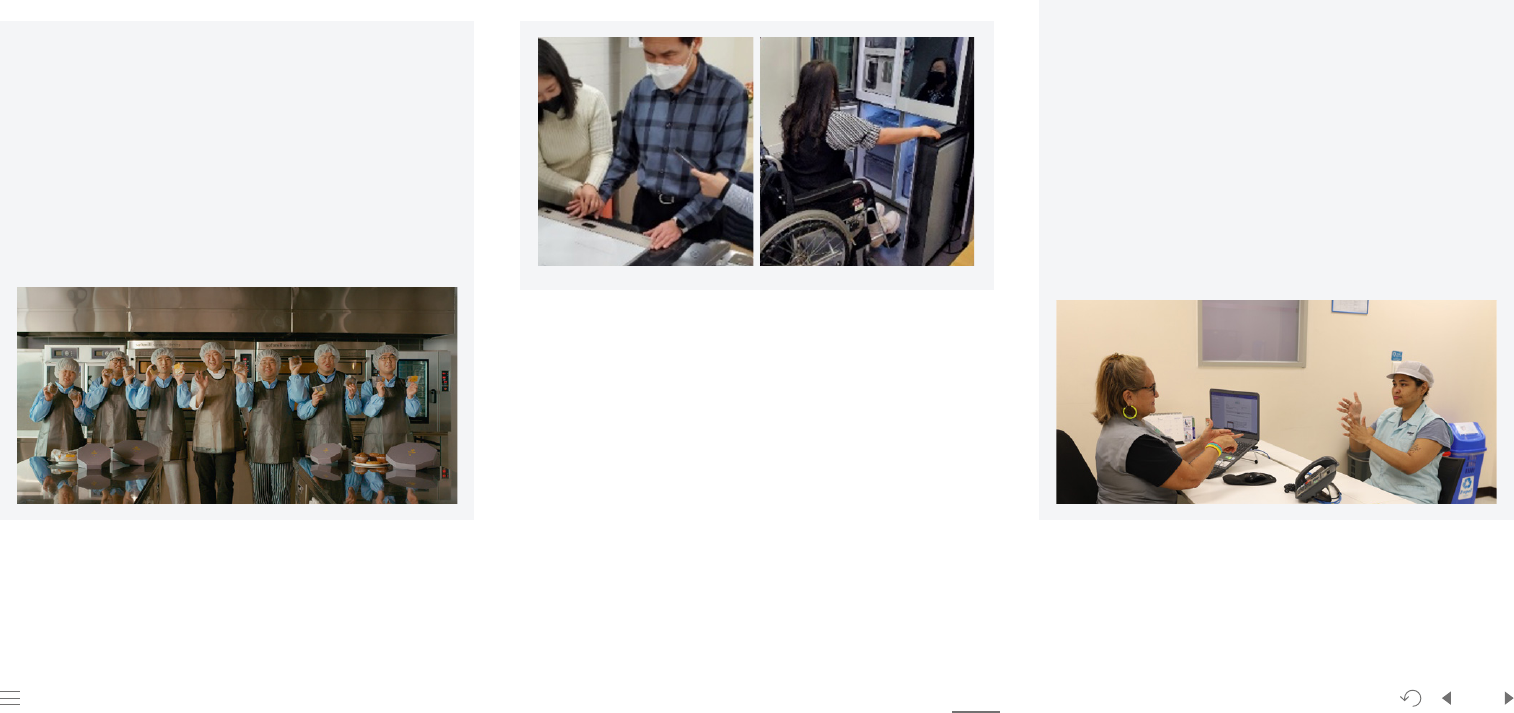
Our Company AppendixApproach to Sustainability Facts & Figures PrinciplePlanet
61
People
Samsung Electronics Sustainability Report 2023
Supporting Employees with Disabilities
Fostering an Inclusive Work Environment for
Employees with Disabilities
We strive to create an inclusive work environment and expand of
employment of persons with disabilities.
· Enhancing accessibility of facilities (e.g., low-floor buses, table bell
system at in-house cafeterias, installation of standing desks)
· Procuring services from companies registered as a standard
workplace for persons with disabilities (services include car wash,
laundry, printing, software verification, and florists)
· Identifying functional roles – such as user experience research and
accessibility features enhancement – that can benefit from the
experiences and perspectives of employees with disabilities
Stellar Forest*
We established Stellar Forest, a subsidiary-type standard workplace for
employees with disabilities, through a 100% equity investment as an
extension of our efforts to create jobs for persons with developmental
disabilities. Currently producing baked goods supplied to our in-house
cafeterias, Stellar Forest plans to diversify into other fields to create more
jobs for persons with disabilities.
* A business site equipped with accessible production, convenience, and auxiliary
facilities that has a workforce composed of employees with disabilities whose
percentage meet the national requirements
In-House Advisory Group of Employees with Disabilities
for Accessibility Enhancement
We continue to reinforce the accessibility of our products and services
based on our accessibility vision of “Caring for All.” In September 2022,
we launched Samsung Family Supporters, a voluntary advisory group
on product accessibility and usability comprised of our employees with
disabilities and our employees’ family members with disabilities. The
42 members with visual, hearing, and physical impairments participate
in the testing of developmental-stage products and provide their
feedback on accessibility features.
Improving the accessibility of our products and services to ensure
usability regardless of users’ disability continues to be a priority for us.
Participatory Development of Awareness-Raising
Training Materials
Since 2018, we have offered training modules to all employees to
improve their understanding of persons with disabilities and reached a
100% completion rate.
In 2021 and 2022, employees with disabilities participated in the
design and production of the contents, communicating the relevant
corporate policies and sharing their experiences first-hand through
video appearances. The course received positive feedback from many
employees who commented that the training motivated them to take
greater interest in relevant corporate initiatives, including Samsung
Barrier Free (SBF).
Support for Employees with Disabilities at
Our Production Sites in Brazil
As part of our efforts to provide an inclusive work environment for
employees in Brazil, we offer counseling services in sign language for
hearing-impaired employees as well as online and in-person sign language
courses available to all employees at the Manaus production site. At the
Campanas production site, we celebrate the Day of Persons with Disabilities
every year by hosting special events that are mindful of accessibility.
The average employment rate of employees with disabilities at our four
Brazil subsidiaries stands at 5.2% as of 2022. In 2018, they were selected
as an outstanding employer of persons with disabilities by the state
government of Sao Paulo.
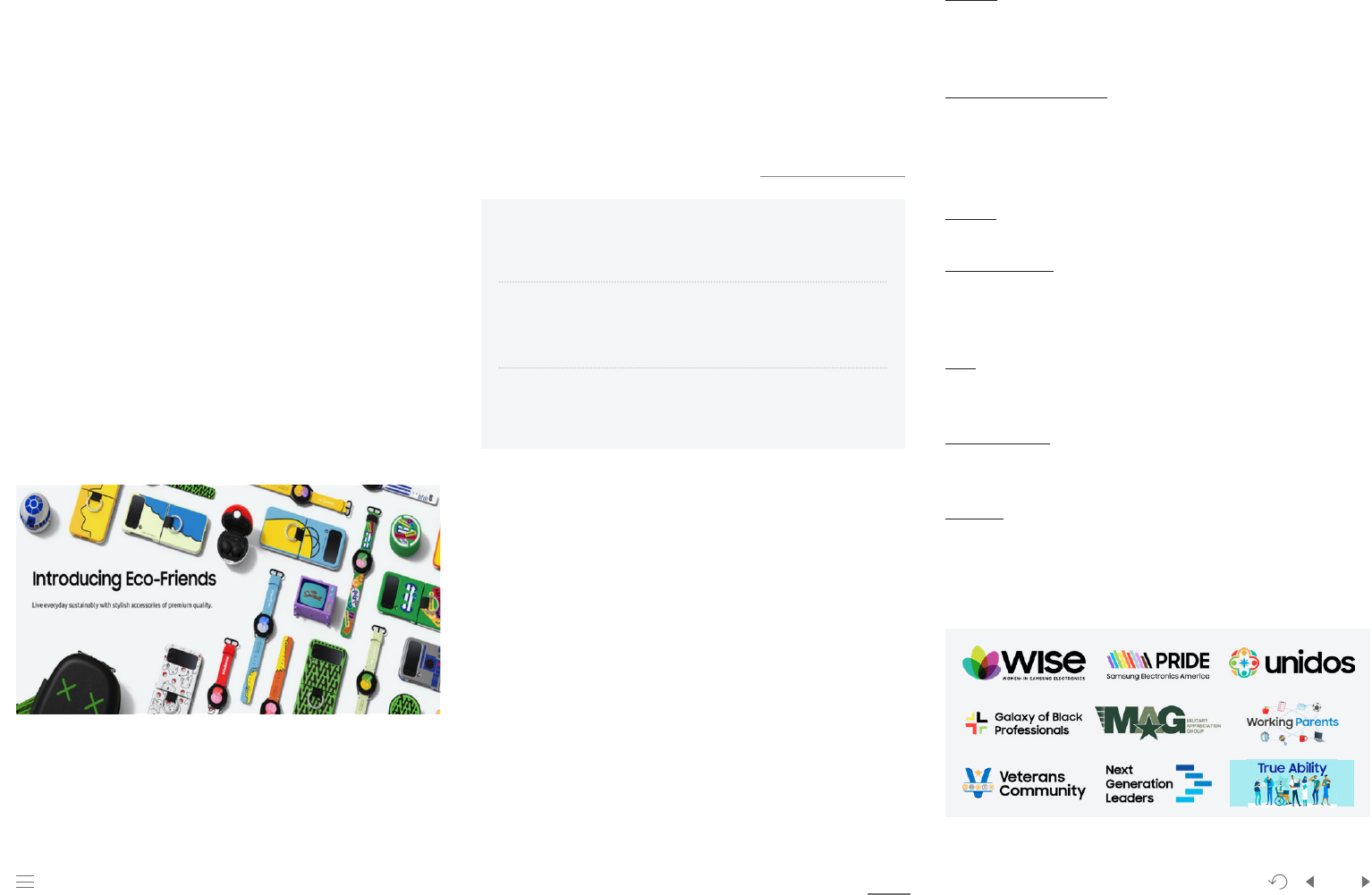
Our Company AppendixApproach to Sustainability Facts & Figures PrinciplePlanet
62
People
Samsung Electronics Sustainability Report 2023
ERG Objectives
Women
Our women ERGs strive to ensure equal opportunities
regardless of gender and empower women. They serve as an important
channel of communication and exchanges and support community
outreach activities promoting gender equality.
Persons with disabilities
Our persons with disabilities ERGs focus
on listening to the voices of employees with disabilities and ensure
that they are given equal opportunities. They also collect ideas and
opinions on the accessibility features of our products from colleagues
to enhance inclusion for customers.
LGBTQ+
Our LGBTQ+ ERGs work to raise awareness, provide support,
and create an inclusive workplace for LGBTQ+ employees.
Inter-generation
Our inter-generation ERGs strive to attract young
talent, promote communication between different generations and
build a forward-looking corporate culture through diverse networking
and outreach programs.
Race
Our race ERGs focus on promoting interaction among people of
diverse cultural backgrounds and creating an inclusive organizational
culture.
Working parents
Our working parents ERGs provide opportunities for
working parents to share their experiences and encourage one another
to lead successful professional and personal lives.
Veterans
Our veterans ERGs provide support for veterans and their
families through sponsorships and volunteer activities in collaboration
with government organizations for veterans and local communities.
They also seek ways to build a more inclusive corporate culture by
sharing issues concerning veterans.
Generation-Specific Activities
We established the Future Generation Lab in 2021 as an extension of
our efforts to actively reflect the opinions of our Millennial and Gen Z
employees.
Future Generation Lab, which consists of those in their 20s from our
global business sites, successfully released the Eco-Friends accessory
brand aimed at promoting environmentally responsible consumption
and expression of individual identity. The Eco-Friends products, made
with recycled plastic and vegan leather containing 40% post-consumer
materials (PCMs), have been well-received in 29 countries.
Meanwhile, since 2019 we have acknowledged employees with more
than two decades of experience in a manufacturing field which requires
technical expertise and knowhow as well as leadership as top-notch
experts through the Samsung Artisan Certification Program.
In 2022, we established the Senior Track program, which provides
outstanding employees with opportunities to continue their service
at work post-retirement. The candidates recommended by the heads
of respective organizational units are screened through a review of
their technical expertise. This program is expected to help retiring
employees’ transition to their post-retirement life and also benefit
others by sharing their skills and knowledge.
Inclusiveness of Organizational Culture
In 2022, items in the Samsung Culture Index (SCI) survey were revised
to include DEI-related questions. The survey is expected to serve as
a useful channel to collect our employees’ views on building a more
inclusive organizational culture.
The 2022 results showed that 93% of our global employees viewed
our programs and initiatives as being fairly operated regardless of age,
gender, race, or place of origin.
Employee Resource Groups
ERGs around the World
Employee Resource Groups (ERGs) are organized by our employees
with shared interests in diversity, equity, and inclusion and have been
active since 2013. Members engage in mutual mentoring, cultural
exchanges, and community outreach activities related to various
themes. Our ERGs not only contribute to enhancing our employees’
awareness of these subjects but also bring positive change to local
communities.
Over 5,200 employees in North America, Europe, Latin America,
and Southwest Asia are taking part in 33 ERGs. We encourage ERG
activities at the company-level and recommend that at least one ERG is
established in each region.
2022 SCI – Results of DEI Satisfaction Survey
90
%
My manager encourages open discussions and
dialogue with me.
91
%
My team members value diverse perspectives.
93
%
In this Company, I am treated fairly regardless of age,
gender, gender identity, race, sexual orientation, military
status, disabilities, religion and national origin.
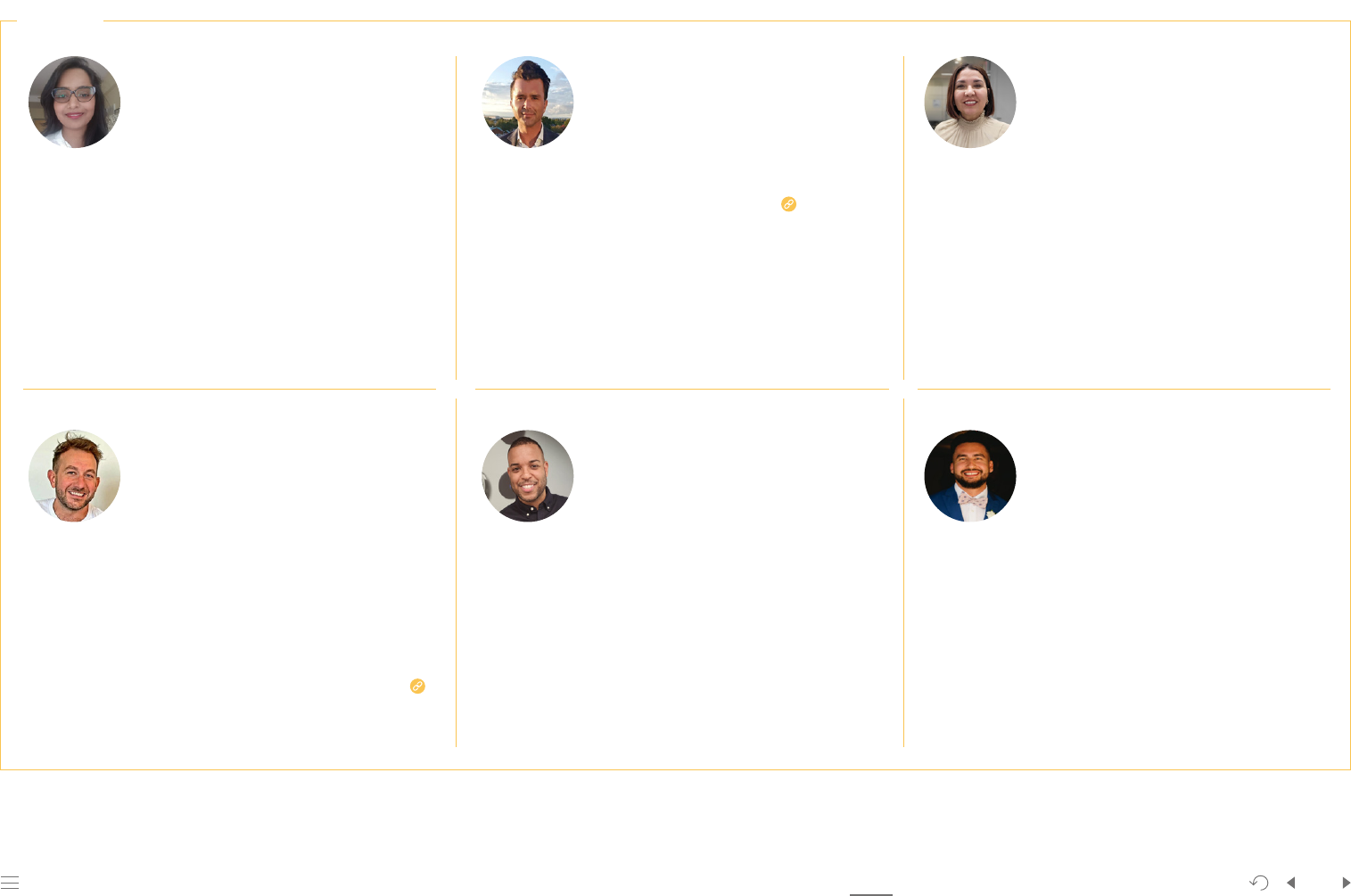
Our Company AppendixApproach to Sustainability Facts & Figures PrinciplePlanet
63
People
Samsung Electronics Sustainability Report 2023
Interviews with ERG Leaders
INTERVIEW
“WiSE is an ERG whose purpose is to empower and inspire women
to break the glass ceiling within the company and the wider group. I
believe in gender diversity and its benefits to an organization. 2022
was the start of the journey for WiSE, SIEL’s first ERG. We had an
education series focused on the what, why, and how of ERGs to allow
employees to understand the concept and the role they can play.”
“I see my invisible disabilities (dyslexia and dyspraxia) as superpowers
as I bid to apply creative thinking and problem solving to great
success. I want people to have confidence in their disabilities and see
them as their superpowers. True Ability has been planning activities
to raise awareness about disabilities and it is very much the start of
the journey to educate, influence and evolve.”
Steven Woodgate
SEUK, UK
Leader of True Ability
Karina Sudarsan
SIEL-S, India
Leader of Women in Samsung Electronics (WiSE)
“We did so much last year, from our first in-person LGBTQ+ Day of
Service events to our Pride event at Samsung 837
. I love leading
this ERG, but it wouldn’t be possible without the powerhouse team of
leaders and members I have worked with!”
“We have been pushing and partnering for positive change for all.
In 2022, we focused on expanding partnerships as a strategic pillar.
We connected with 8 other US-based companies to create a suite
of programs in honor of the Juneteenth celebration in 2022. This
partnership remains active today and the conglomerate is working on
the 2
nd
year of planning for our cross-company employees.”
* In collaboration with Microsoft, Verizon, Wyndham, Nike, State Farm, Sodexo,
Asurion, and LinkedIn
Nash Gammill
SEA, US
Leader of PRIDE
Seth Brown
SEA, US
Leader of Galaxy of Black Professionals (GBP)
“Being the National Leader of UNIDOS is a great honor as it allows
me to contribute to creating a welcoming and engaging environment
for our members and broader employee base. We established a
partnership with DePaul University in 2022, providing free seminars
to SEA’s employees focused on personal development. We offered
7 seminars delivered by DePaul professors on topics including:
Selling the Best Possible You, the Power of Introvert Leaders, and
Mindfulness@Work.”
Nora Lango
SEA, US
Leader of UNIDOS
“Building camaraderie and esprit de corps are key values in our
mission as MAG. We have hosted monthly meetings with informative
guest speakers, engaged in a couple of volunteering event, and
celebrated important milestones for the military. I am also excited
that we are including more than our employees at the Austin campus
and have focused on those working at our satellite office and the
Taylor construction camp.”
Mike Atencio
SAS, US
Leader of Military Appreciation Group (MAG)
Related article
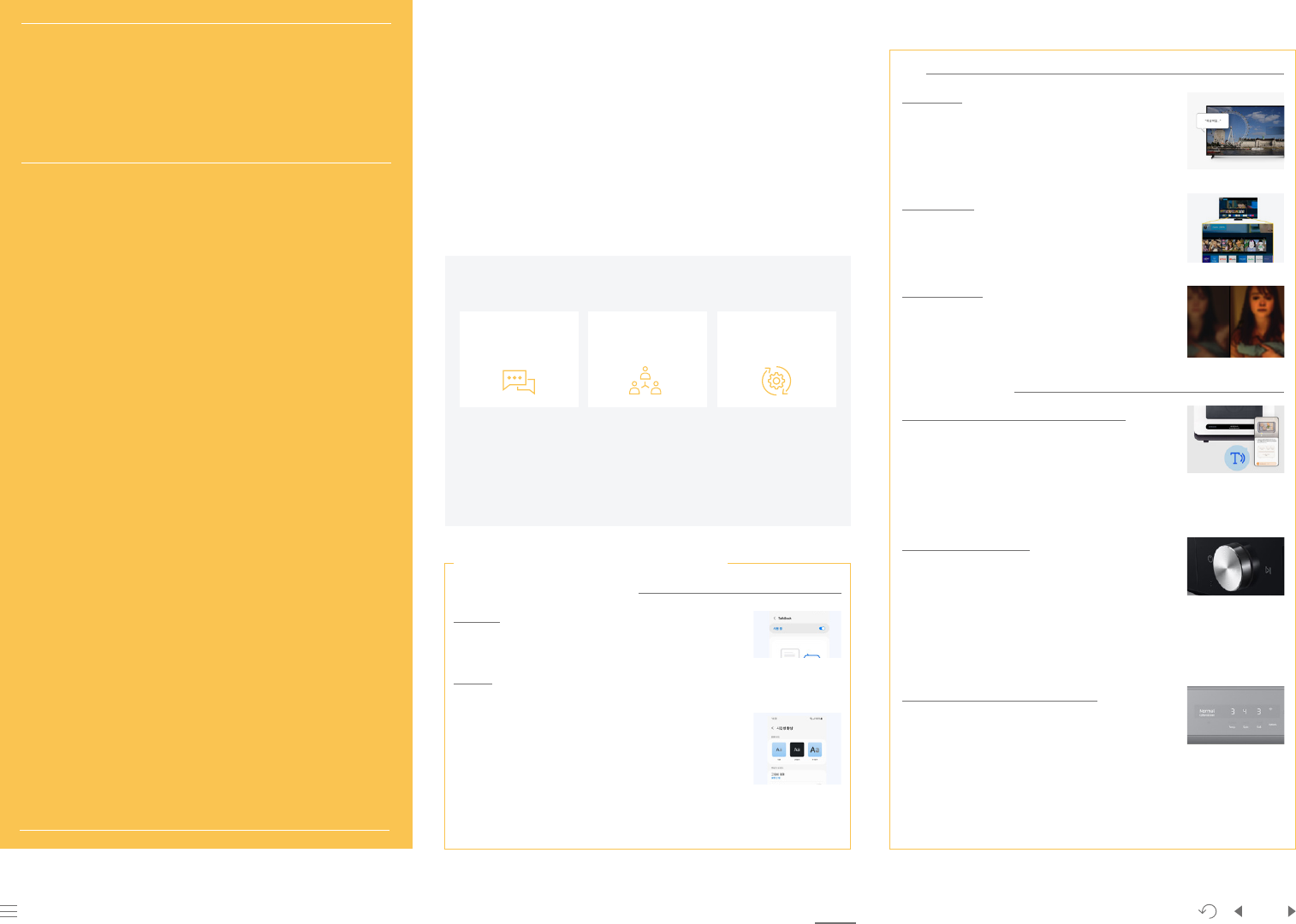
Our Company AppendixApproach to Sustainability Facts & Figures PrinciplePlanet
64
People
Samsung Electronics Sustainability Report 2023
Accessibility
Accessibility Council
Our Accessibility Council serves as a platform to bring together
planners, designers, and developers of different organizational
units to work on improving accessibility for all customers using our
products and services. The Council’s main focuses are enhancing
usability for customers with disabilities and advancing technological
competitiveness.
TV
Voice Guide
· Enabling smart TVs to read on-screen text
· Offering verbal feedback for basic features (channel,
volume, program information, etc.) and access to
smart services
Magnification
· Enabling users to enlarge on-screen text and images
up to 200% and zoom in on different parts
Relumino Mode
· Outlining objects, enhancing contrast, and adjusting
brightness and color to highlight content
Home Appliances
TalkBack for Home Appliances and Services
· Screen reader to enable users to identify features
and services of home appliances connected to
SmartThings
· Verified and enhanced by vision-impaired experts
to provide tailored user experiences
Braille and Tactile Points
· Providing easy access to the available cycles and
features by installing Braille or tactile points on
the main dial and buttons
· Available on selected washer models released
from 2019 and being applied to other home
appliances as well
Control Panel with Improved Visibility
· Control panel of washers and dryers, on which
cycle and feature names are typically printed,
replaced with an LCD panel with enlarged text to
ensure visibility even in dark environments
*Available on models released from 2020
Accessibility Vision
TalkBack
· Providing voice feedback to eliminate the need to look
at the screen for text and images
Display
· Enabling low-vision users to activate useful accessibility
features simultaneously
· Large Display mode to enlarge on-screen elements and
bold text
· High Contrast mode to activate an opaque black
background, high contrast fonts, high contrast keyboard,
and Remove Animations simultaneously
Our Vision
Creating Better Pathways for All
We bring meaningful
change by
interacting and
engaging with our
customers.
Engaging
Communities
We ensure access to
equal experiences for
all users.
Promoting
Equity
Lasting
Commitment
We remain committed
to continually building
an inclusive culture
and process to create
experiences that
benefit all.
We provide inclusive products and services that
enable users under diverse conditions to enjoy
a digital lifestyle that goes beyond convenience.
Tech for All
Features for Better Visual Accessibility
Mobile and Wearable Devices
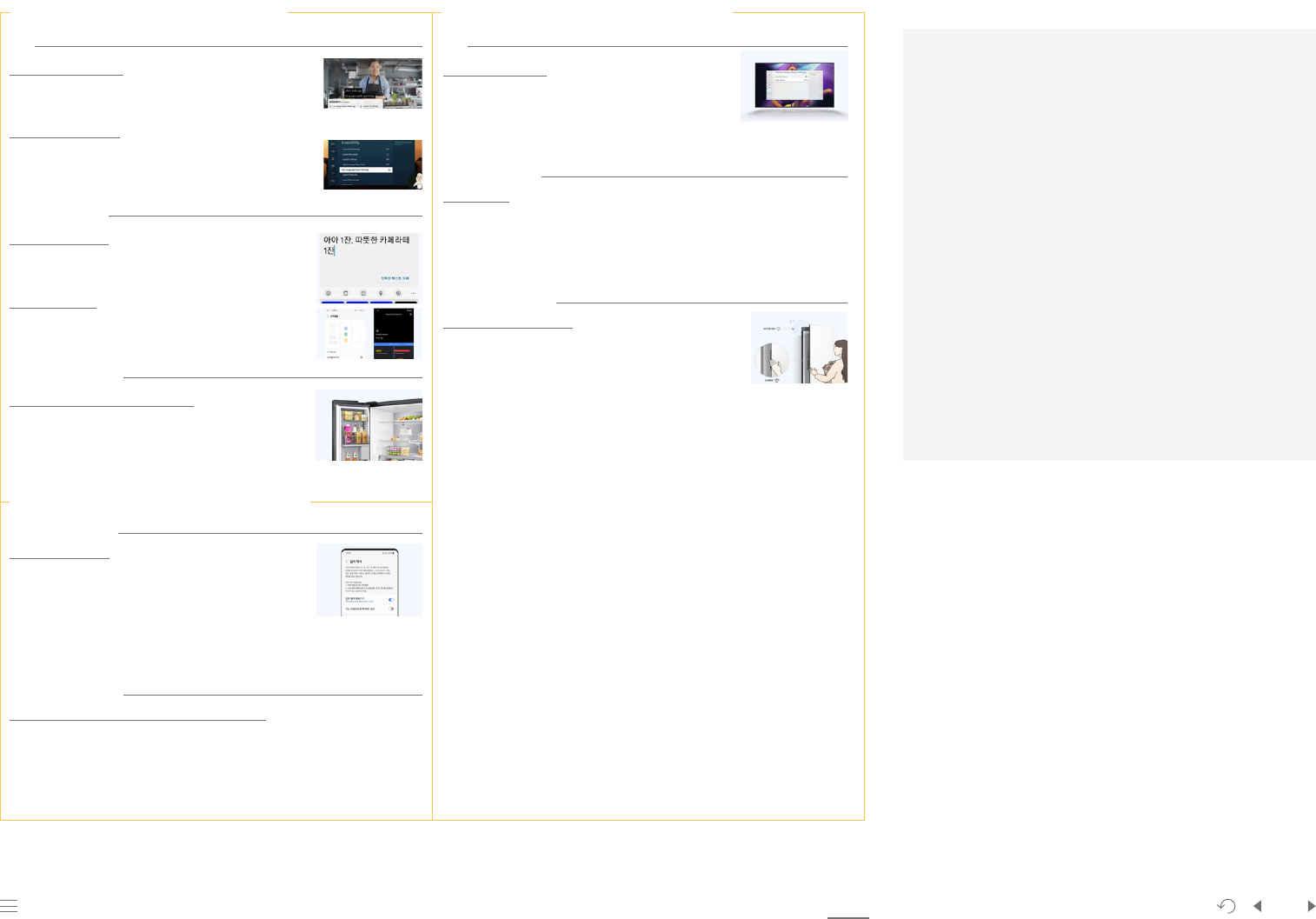
Our Company AppendixApproach to Sustainability Facts & Figures PrinciplePlanet
65
People
Samsung Electronics Sustainability Report 2023
TV
Auto Caption Position
· Automatically adjusting subtitle positions so as not to
interfere with text through advanced video analysis
Sign Language Guide
· An avatar describing features in the TV Menu
in sign language
Mobile Devices
Flash Notifications
· Using the camera flash or screen flash to alert
users instead of sound or vibration
Alerting hearing
· Impaired users of important noises such as a smoke
alarm or baby crying
Home Appliances
Blinking Light for Door Open Alarm
· Blinking light, in addition to a sound alarm, to indicate a
refrigerator door has been left open for more than five
minutes
Accolades
‧
TV, Winner of CES* Innovation Award for Accessibility (2015-2018, 2021, 2023)
‧ TV, Winner of CES* Best of Innovation Award (2016, 2021)
*CES: Consumer Electronics Show
‧ TV, Winner of U.K.’s RNIB* Inclusive Society Award (2016)
‧ Attained U.K.’s RNIB Tried and Tested Accreditation (2020-2022, 2022-2024)
*RNIB: Royal National Institute of Blind People
‧ TV& Mobile accredited for Accessibility Technologies by ONCE* (May 2021-
May 2023)
*ONCE: Organización Nacional de Ciegos Españoles
‧ Mobile awarded Thailand’s TAB*’s Honor Plaque (2021-2023)
*TAB: Thailand Association of the Blind
‧ Selected as supplier for Korea Communications Commission’s project to
distribute TVs for people with visual and auditory disabilities (2020-2023)
‧ Bespoke 1-Door Refrigerator, Grand Prix Winner of Ergonomic Design
Award hosted by the Ergonomics Society of Korea (2022)
‧ Bespoke Jet, Winner of Best of Best of Ergonomic Design Award hosted by
the Ergonomics Society of Korea (2021)
‧ Bespoke Jet Bot AI & Bespoke Qooker, Winner of Best Innovation of
Ergonomic Design Award hosted by the Ergonomics Society of Korea (2021)
Features for Better Visual Accessibility Features for Better Mobility Accessibility
Mobile Devices
Interaction Control
· Keeping the device focused on a single app by disabling
the Back, Home, and Recent buttons and alarms for
incoming calls and notifications, as well as the side key,
volume keys, and touchscreen function
Home Appliances
Displaying Frequently Used Cycles and Features*
· Remembering frequently used cycles of the washer
and dryer and frequently used features of the oven and
displaying them at the top of the list
*Applied to products with LCD screens
Features for Better Cognitive Accessibility
TV
Slow Button Repeat
· Performing a continuous operation while lowering
the speed by pressing and holding one button on
the remote control
Mobile Devices
Voice Access
· Providing voice commands to access and operate
diverse features such as apps, screen enlargement,
volume adjustment, etc.
Home Appliances
Automatic Door Opening
· Enabling mobility-challenged users to open the doors
of home appliances with ease
* Available on select models
·
Refrigerator: Doors automatically opened when
bringing a hand near the touch sensor or
when providing voice feedback (“Open
the refrigerator door”) via Bixby on the
smartphone
· Washer: Door automatically opened after the
completion of each cycle
· Dryer: Door automatically opened when switched on
or completing a cycle
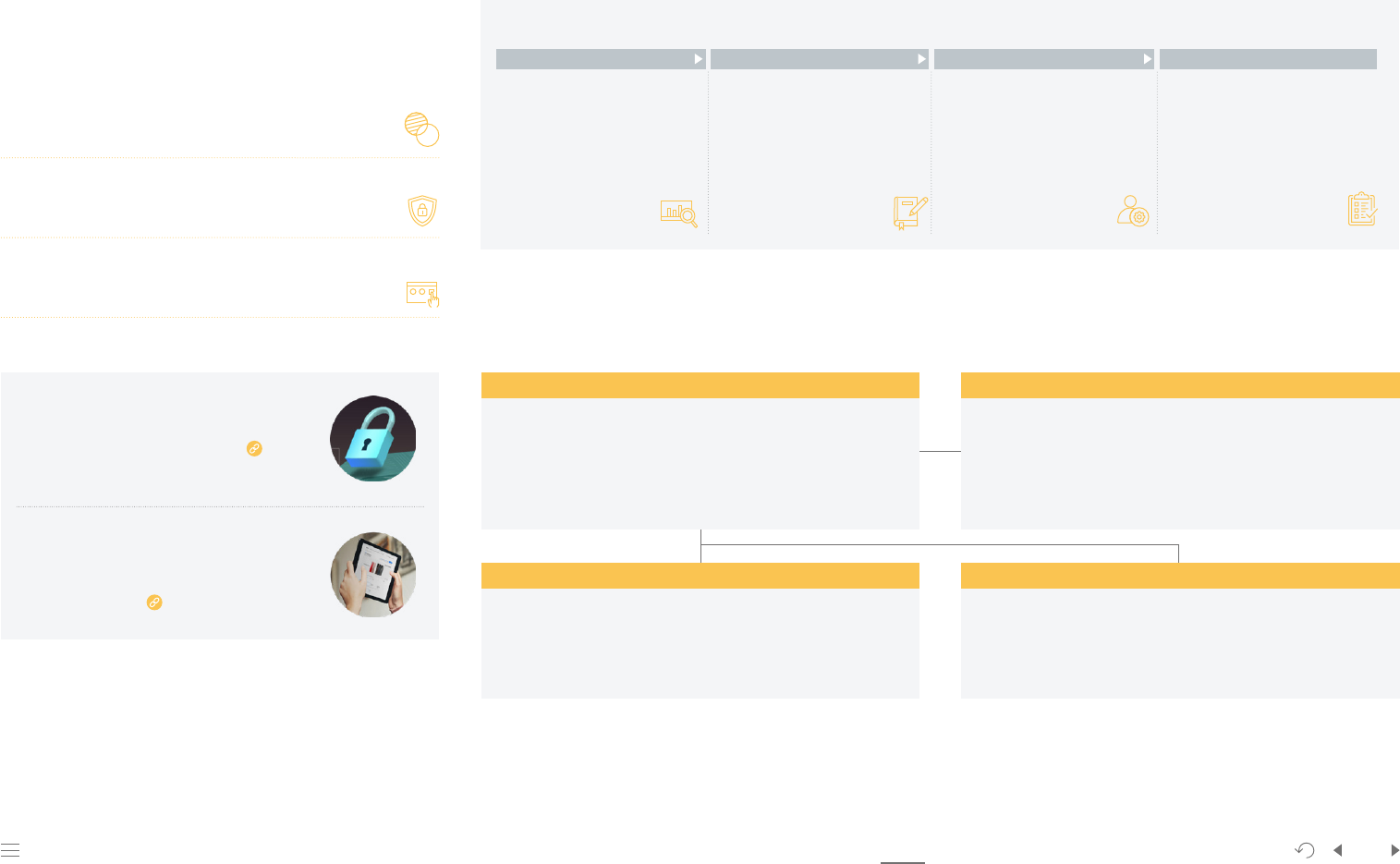
Our Company AppendixApproach to Sustainability Facts & Figures PrinciplePlanet
66
People
Samsung Electronics Sustainability Report 2023
Privacy Protection
We ensure that personal data is collected in a transparent manner and
that the collected data is handled safely. We respect each user’s choice,
remain prepared for relevant risks, and employ advanced security
technologies for privacy protection.for privacy protection.
Valuable personal data
Securely protected and easily managed
Managing all personal data connected to your
account at one time
Browsing the Samsung Privacy Policy at one time
Privacy Protection Management
We are operating a country-specific Global Privacy Policy, which reflects the respective country’s laws and regulations, to safeguard the privacy of
global customers in an optimal manner. The Privacy Protection Guidelines for Employees and Guidelines on the Third-Party Processing of Personal
Data are distributed to our employees along with related training to improve their awareness and understanding of the guidelines.
Our Visual Display Business attained both ISO/IEC 27701 (privacy information management system) and ISO/IEC 27001 (information security
management system) for digital signage for the first time in the industry.
Organizational Units in Charge
Establishing privacy strategies, policies, and related processes
Providing legal advice and support
Conducting regular audits
Conducting employee training to raise their awareness of privacy issues
Head of the Global Privacy Office serving as the Chief Privacy Officer (CPO)
Global Privacy Office
Making decisions regarding privacy policies and protection measures
Discussing privacy-related issues for different products and services with
relevant businesses and seeking solutions
Privacy Steering Committee
Reviewing the privacy protection status of the respective business and
conducting training
Ensuring the application and management of privacy protection
technologies
Privacy Protection Officers within Businesses
Reviewing the privacy protection status of the respective regional office
and conducting training
Responding to privacy-related issues
Privacy Protec
t
ion Officers at Regional Offices
Privacy Protection Management Process
Trend Monitoring*
Monitoring the enactment and
amendment status of related
laws and regulations and joining
relevant organizations*
* We joined the International
Association of Privacy Professionals
(IAPP) in 2015.
Policies and Training
Establishing relevant policies,
guidelines on third-party processing,
and response measures to personal
data leakage and conducting
employee training
Program Operation
Operating company-wide, business-
specific, and region-specific privacy
protection programs
Auditing and Remedy
Performing audits on the application
of the Privacy Policy and taking
remedial action accordingly
Our Three Privacy Protection Principles
❶
Transparency
We transparently disclose the details of how we collect and handle
personal data.
❷
Security
All of our products are designed to provide the best services and
securely protect users’ privacy.
❸
Choice
We enable users to choose the type and extent of personal data to
be collected, accessed, and shared.
Samsung Privacy Policy
Samsung.com Privacy Protection Features
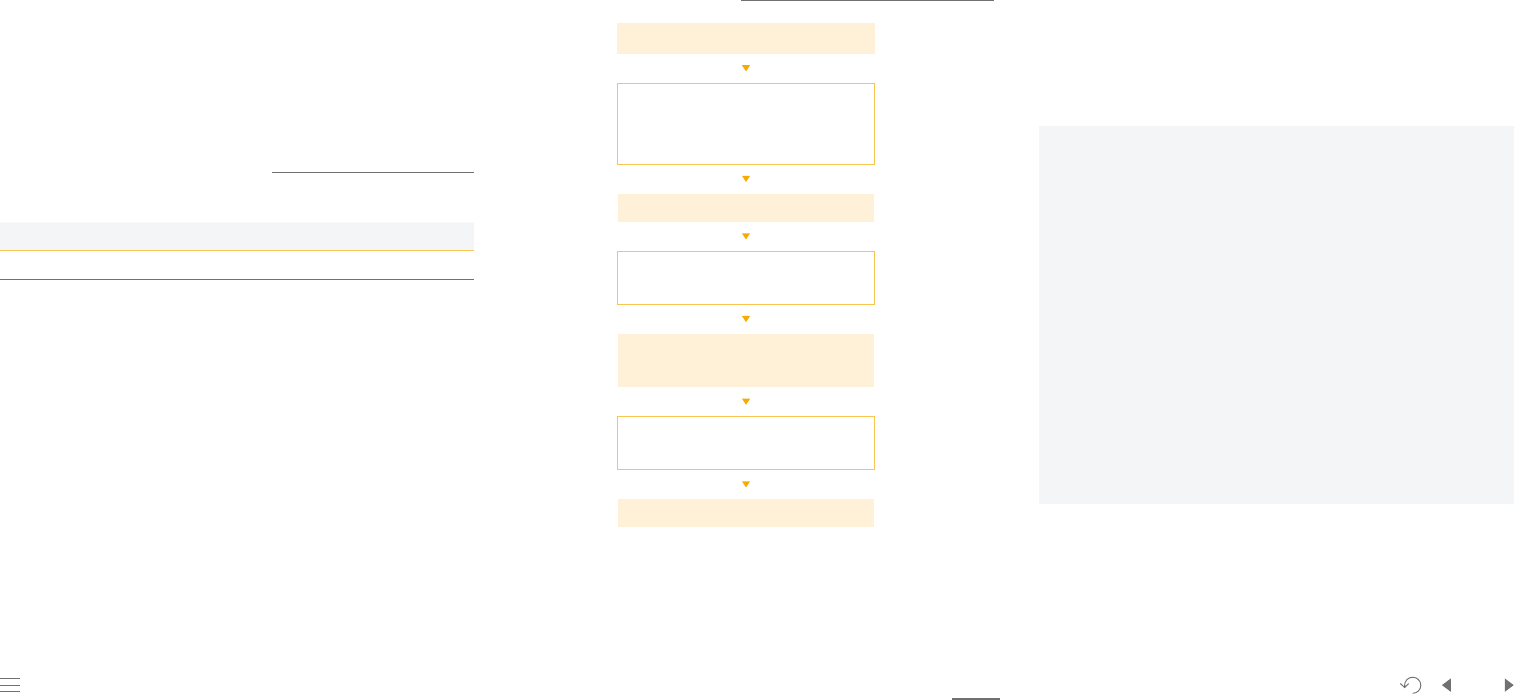
Our Company AppendixApproach to Sustainability Facts & Figures PrinciplePlanet
67
People
Samsung Electronics Sustainability Report 2023
Privacy Protection System Operation and Training
We operate in-house systems to reduce privacy risks and encourage all
employees to prioritize customer privacy through related training.
Privacy Legal Management System (PLMS)
PLMS is designed to ensure compliance with privacy-related laws and
regulations. It is connected to product R&D and the product Life cycle
management system to monitor privacy-related matters from product
and service planning to development, operation, and discontinuation and
thereby prevent risks. It also offers news and the latest developments
concerning privacy protection to keep our employees updated.
Privacy Protection Training
We strengthen the privacy protection capacities of our employees
through annual trainings - including a mandatory training for all
employees based in Korea as well as a targeted training for employees
in functions directly involved in handling personal data.
Since 2020, we provide a video guide on the collection, use, and
disposition of personal data in line with our Global Privacy Policy.
Data Breach Response Process
At Samsung, we have a data breach response process in place that
enables Samsung to assess a data breach incident and to take remedial
measures immediately upon detection of the incident. We promptly
notify and report to the affected users and the relevant authority
respectively in compliance with the applicable data protection laws.
Where a notification is provided to the affected users, the following
information are communicated via e-mail or a notice on our website;
the category of the breached data, when and how the breach occurred,
the measures that the affected users can take to minimize the damage,
the remedial measures taken by us and our point of contact for any
queries by the affected users to prevent data breach and to minimize
any damage to our users in the case of such an incident.
Our Efforts to Ensure Responsible Advertising
We strictly apply the Global Privacy Policy to advertisements that are
directly executed on mobile and IoT devices.
Enhanced Privacy Protection
When accessing a user’s information for targeted advertisements, a
separate randomly generated ID is used. The respective ID can be reset
at the request of the user. The use of information collected under the ID
prior to reset is immediately suspended.
We also enable users to opt out of receiving targeted advertisements
on their mobile and Smart Hub devices. To collect and use personal
data for targeted advertisements, we clearly notify our purpose and
obtain prior consent from users. The targeted advertisement option
can always be disabled in Settings. With this option disabled, only non-
targeted advertisements will appear.
Prohibited Content in Advertisements
We have defined the following contents, which may inflict harm on
users, and filtered them from advertisements.
Number of Employees Who Completed
Privacy Protection Training (Korea)
2020 2021 2022
No. of employees
86,455 90,281 96,459
Data Breach Response Process
Breach discovered
Report the breach
(e.g. Security/Service
Operation/Legal Team)
Access the breach
Establish and implement measures to
prevent recurrence of the incident
Case closed
Create a remedial plan and implement
emergency measure
Implement the remedial measures
(e.g. notification, security measures)
Content that incites violence against or advocates for certain groups,
including those defined by race, ethnicity, race, nationality, disability, age,
military service status, or sexual orientation or identity
All forms of illegal acts and acts that instigate illegalities; all forms of
illegal substances; and websites related to illicit, false, or exaggerated
investment advice and money-making proposals
Violence including the use of obscene or vulgar language, bullying,
physical harm, and injury to or killing of both people and animals
Religious and occult content, imagery, and symbols
Illegal drugs and drug paraphernalia
Tobacco and tobacco-related products
Firearms
Obscene and sexual materials
Alcohol and content related to online and offline marketing or
promotional activities that incite excessive alcohol consumption
(Prohibited both in online advertisements and broadcast commercials)
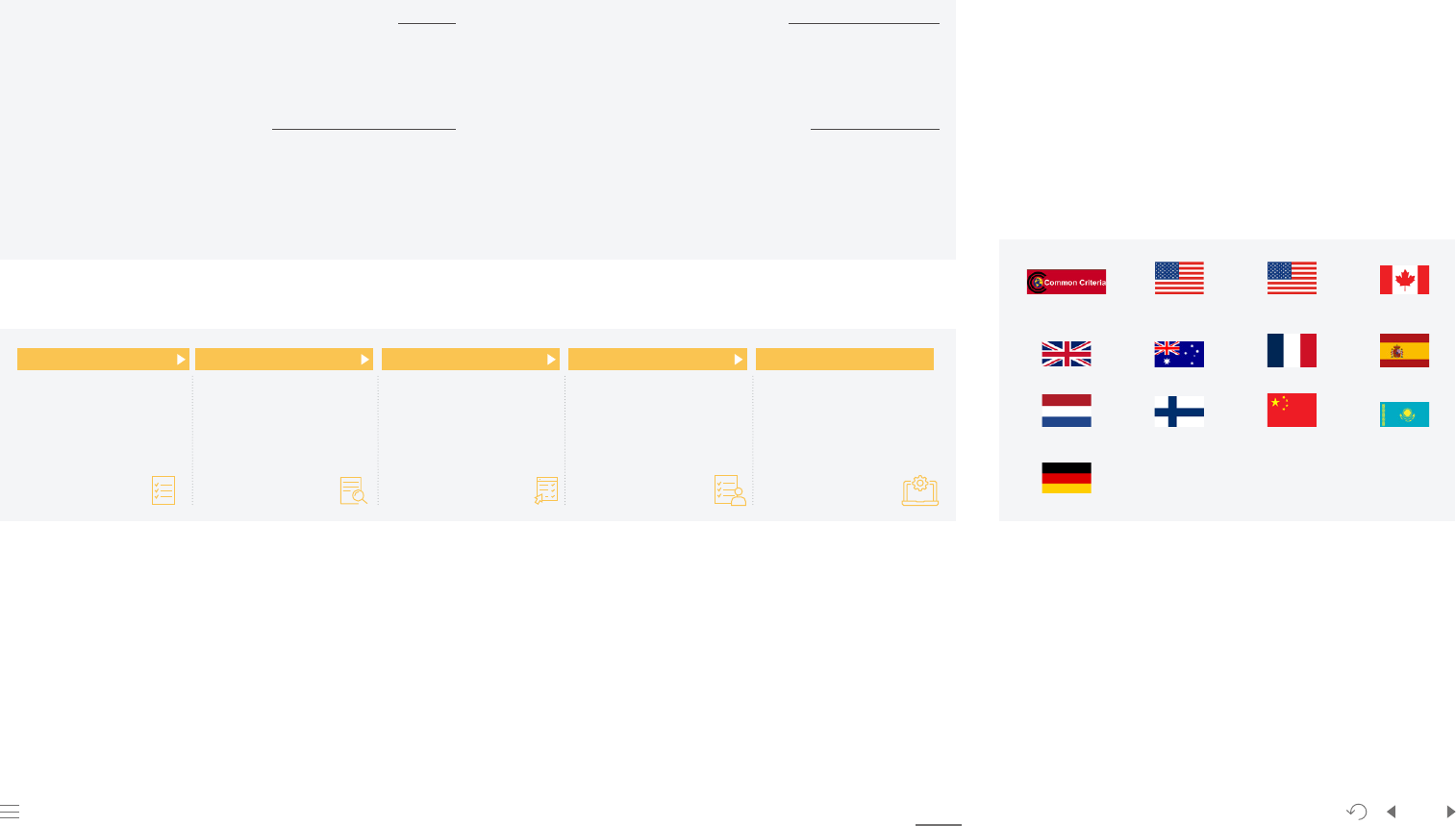
Our Company AppendixApproach to Sustainability Facts & Figures PrinciplePlanet
68
People
Samsung Electronics Sustainability Report 2023
Security
To ensure that users can enjoy their digital environment with their minds at ease, we continuously strengthen our security system against complex
and intensifying threats.
Samsung Knox
We take a holistic approach to the security of our products and services.
Samsung Knox is engineered to securely protect chipsets, operating
systems, and apps against hacking attempts and unauthorized access.
Saved user data are protected on a real-time basis while the device is
used or booted. Beyond smartphones, tablets, and smart TVs, Samsung
Knox continues to expand its integration with smart home appliances,
IoT, and 5G network devices.
Samsung Knox Security Principles
Samsung Knox offers advanced and targeted security solutions that
meet the evolving needs of corporate clients and have been certified
by the government in various countries.
Four Pillars of Our Cyber Security Control and Our Solution Development Process
Four Pillars of Our Cyber Security Control
Prevention and Hardening: Fulfilling stringent standards
Hardware chipsets using our proprietary technology in preparation for
cyberattack attempts
Separate security processors
Detection: Staying vigilant at all times
Monitoring incidents concerning digital devices and networks
Activating the defense system upon the detection of any possible malicious
intrusions
Detecting and blocking cybersecurity threats such as malware and phishing
Prediction: Preparing for possible incidents
Performing regular testing to verify the effectiveness of our solutions
Providing the optimal security system based on our expertise, big data
analysis, and AI technology
Response: Taking prompt and targeted actions
Accurately analyzing detected problems, vulnerabilities, and projected
damage
Promptly blocking cyberattack attempts detected through the security
control system
Offering optimized security patches and updated security solutions
Security Certifications for Samsung Knox
AIVD Traficom ISCCC STRK
ANSSI CCNNCSC ASD
Common Criteria DISA FIPS 140-2 FIPS 140-2
BSI
We are equipped with an internal development process to offer advanced security solutions.
Planning
Define and review
security requirements
Identify privacy and
security risks
Design and Analysis
Conduct threat modeling
Review security architecture
Implementation
Review security coding
Review open-source security
Reviewthreat modeling for
response
Testing
Diagnose vulnerabilities
Perform mock infiltration
testing
Operation and Maintenance
Monitor and respond to
incidents
Update security patches

Our Company AppendixApproach to Sustainability Facts & Figures PrinciplePlanet
69
People
Samsung Electronics Sustainability Report 2023
Samsung Knox Security Principles in Detail
Adopt Proven Cryptography Technologies
We adopt proven cryptographic algorithms and technology to offer
data protection solutions.
Samsung's products and services use internationally recognized
and standardized cryptographic technologies. We verify and certify
implementations of these cryptographic technologies through
certifications such as the Federal Information Processing Standard
(FIPS). Data is stored in encrypted form. Our data protection
mechanisms are applied to data-at-rest and data-in-transit.
Trust from the Hardware Up
We build our Chain of Trust from tamper resistant hardware Root of
Trust (RoT).
Our RoT is deeply embedded in our chips and not exposed to the
outside variables while accessible only to a limited set of applications.
We make sure our primary software functions are not tampered with
while offering end-to-end protection of personal data.
Provide Securely Protected Software Execution Environment
We provide a dedicated execution environment that processes
sensitive and confidential data while protecting against malware
attacks.
Protected video playback, user authentication and payment
applications run in our safe execution environment. For user
authentication apps, our safe execution environment blocks
unauthorized access to sensitive biometric information. For payment
apps, our safe execution environment ensures secure handling of
payment transactions.
Keep Sensitive Data in Fully Isolated Secure Storage
Highly sensitive data such as biometrics, PIN values or PII are stored
in fully isolated secure storage that is robust towards data leakage
threats. Our fully isolated secure storage is resistant towards physical
attacks.
Apply Stronger User Authentication Technologies
Apply strong authentication techniques that qualify only designated
users to access our devices and services.
A broad range of user authentication technologies such as PIN, pattern,
password, fingerprint, and iris recognition are used in combination to
offer strong user authentication. Our user authentication technologies
grant access to internet services controlled using Samsung Account,
and multi-authentication techniques.
Apply the Latest Security Updates
We apply the latest security updates and patches to combat attacks
from the ever-changing malware and hacking landscape.
Samsung products provide security updates through a variety of
channels. We offer online Over-the-Network updates as well as
periodic and urgent security updates to broadly and swiftly address
vulnerabilities.
Proactively Prevent Tampering of Code and Data
We deploy technologies that detect illegal tampering activities in
users' devices and services.
We proactively build mechanisms that notify and alert users of
these activities so they can mitigate adverse impacts. We verify the
integrity of the executed software at boot up time using secure boot.
Our software verification technology applies to software updates and
prevents unverified software installation.
Follow a Strict Security Development Process
From concept to end of life, we follow a strict security development
process that covers the entire lifespan of our products and customer
experience.
Our security policies extend out to classifying, handling and
processing how we protect personal data and other forms of
confidential data. We go through rigorous security design reviews that
consider all type of attack vectors. We constantly monitor the threat
landscape for emerging threats over our devices and services.

Our Company AppendixApproach to Sustainability Facts & Figures PrinciplePlanet
70
People
Samsung Electronics Sustainability Report 2023
Mobile Security
Samsung Knox Vault
Pre-installed in the Galaxy S21 and subsequent series, Samsung Knox
Vault combines a secure processor with a new Secure Memory Chip to
safely store and protect PINs, passwords, biometric information, digital
certificates, and security keys in isolated locations. Samsung Knox
Vault offers an operating environment independent from Android,
thereby effectively protecting apps and user information against
attacks based on Android security vulnerabilities.
Mobile Security Updates
We perform regular and prompt security updates.
In close collaboration with Android OS, our chipset partners, and
over 200 telecommunications operators around the world, we
update security patches for billions of Galaxy devices when security
vulnerabilities are detected. We work with over 1,000 partners to
establish security standards for all Android devices, as well as security
research communities to provide the most secure mobile experiences
for users. In February 2022, we expanded the security update warranty
for Galaxy mobile devices to up to five years.
* Supported devices: Flagship mobile phones, Tablets, and a part of A series mobile
phones released since 2021
· Industry’s best security chipset (CC EAL* 4/5+ certification)
· Secure processor that prevents hardware attacks
· Tamper-resistant security memory
* Common Criteria Evaluation Assurance Level (CC EAL) an international
standard for online security certification
Security Training for Employees
We offer a range of training courses to raise internal awareness of
cybersecurity, including an on-line course that informs employees of
the types of security risks and prevention measures.
Additionally, we provide tailored and technical courses to engineers
and developers in each business unit, such as security coding and
engineering, security software development process, and vulnerability
management.
Key Semiconductor Technologies and Customer Information
Protection
Semiconductor Technology Security
We continually strive to enhance protection measures for our
important information assets in recognition of the fact that enhanced
semiconductor technology security is imperative to preserve the
wellness at the national, customer, and user-level beyond our company.
Information Security Management System
We conduct regular audits* to prevent security system and product
security accidents. We also ensure that our suppliers’ security
management is being performed properly. We continue to enhance our
security management as evidenced by third-party certifications such
as the Common Criteria and ISO 27001.
* Regular audits: The security management system for internal document
management, network vulnerabilities, and infiltration threats was reviewed through
the 2021 regular audits and enhanced based on the findings.
Semiconductor Technology Security System
Our semiconductor technologies are acknowledged as Korea’s
National Key Technologies* and are protected based on the Act on
Prevention of Divulgence and Protection of Industrial Technology. We
have implemented security management guidelines and designated
executive-level managers for individual technologies. These managers
are responsible for examining technical security procedures and
approving measures to protect such technologies.
* National Key Technologies: Designated by Korea’s Minister of Trade, Industry and
Energy in recognition of their technological and economic impact on the domestic and
global markets or high industrial potential
1. Technology for the design, processing, devices, and 3D stacking of DRAM
of 30nm class or lower
2. Technology for the design, processing, devices, and 3D stacking of NAND
flash of 30nm class or lower
3. Technology for the 3D assembly and testing of DRAM
4. Technology for the 3D assembly and testing of NAND flash
5. Technology for the assembly and testing of advanced system
semiconductor package
6. Technology for the processing, devices, and 3D stacking of foundries of
30nm class or lower
7. Technology for the design and processing of mobile application processor SoC
8. Technology for the design of LTE, LTE advanced, and 5G baseband modems
9. Technology for the design, processing, and devices of image sensors with
pixels of 1m or less
10. Technology for the design of OLED display driver IC (DDI) for display
panel driving
10 Semiconductor Technologies of Samsung Electronics Designated
as National Key Technologies
Information Security for Our Clients
We conclude non-disclosure agreements (NDAs) with our clients to
allow only authorized employees to access relevant information. We
also employ an email filtering service (Compliance Guide Service)
to filter outbound email messages containing any of our corporate
customers’ information to ensure confidentiality.
Information Security Center and On-Site Activities
To safeguard our key technologies against the rapid changes in the IT
industry and internal and external security threats, we are operating
the Integrated Information Security Center dedicated to information
protection. We are also equipped with a specialized information
security system overseen by the executive vice president-level Chief
Information Security Officer.
Our frontline staff members are designated as Security Agents
empowered to protect the key technologies and intellectual assets
of their respective organizational units and foster an organizational
culture focused on information security. Our Security Agents are
responsible for carrying out security training, inspections, and the
identification of vulnerabilities, thereby raising internal awareness on
the importance of information security.
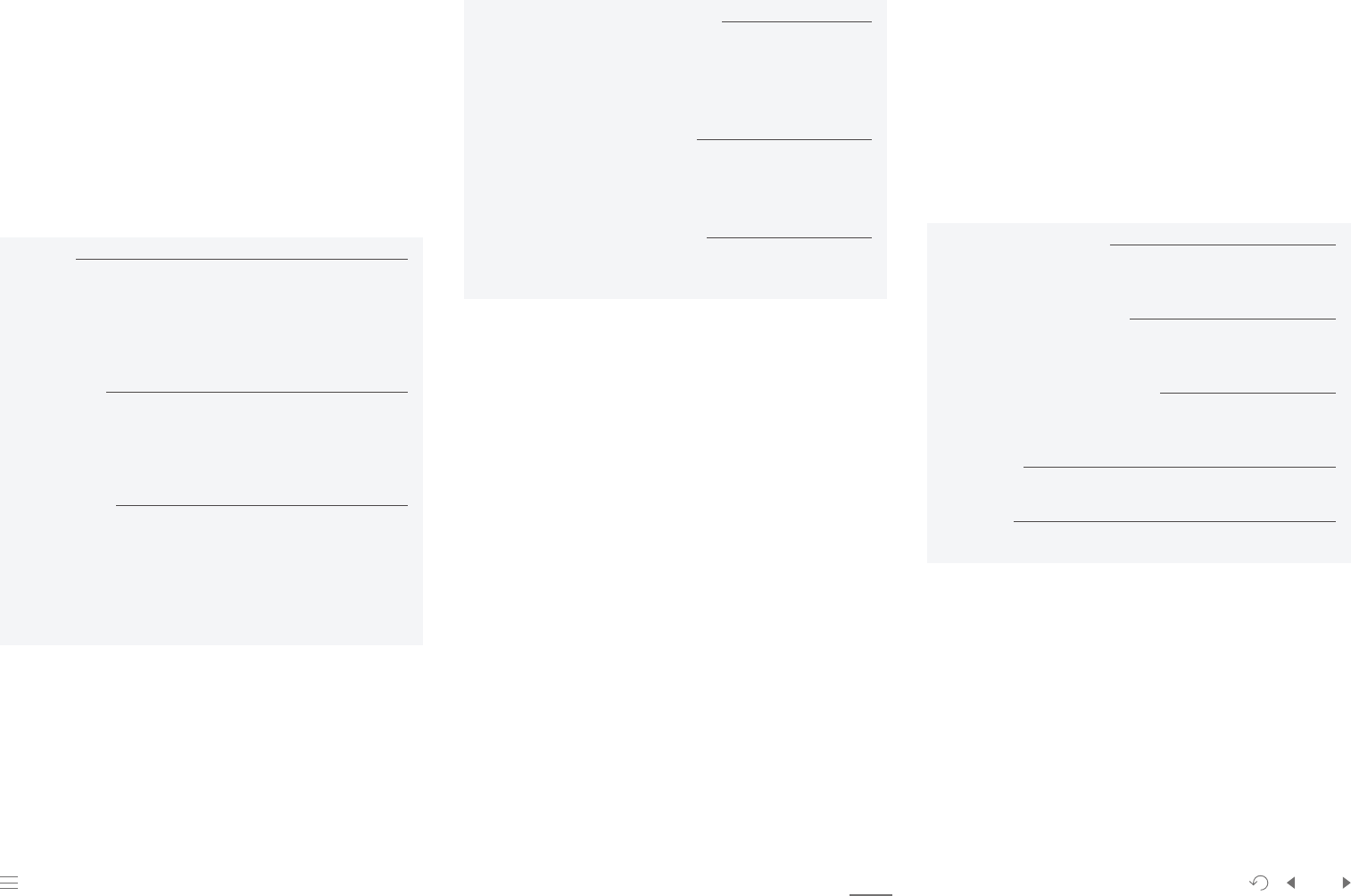
Our Company AppendixApproach to Sustainability Facts & Figures PrinciplePlanet
71
People
Samsung Electronics Sustainability Report 2023
AI Ethics
We seek to design user-centric products and services that are easily
accessible, safe, helpful, and continuously evolving through learning
based on AI technology.
Principles of AI Ethics
Under the aim of ensuring compliance with related laws and fulfilling
our corporate, social, and ethical responsibilities, we have set forth
the Principles of AI Ethics (fairness, transparency, and accountability)
that are reflected in development and operation of our products and
services.
Fairness
· The company will strive to apply the values of equality and diversity in
AI systems throughout their life cycle.
· The company will strive not to reinforce nor propagate negative or
unfair bias.
· The company will strive to provide easy access to all users.
Transparency
· Users will be aware that they are interacting with AI.
· AI will be explainable for users to understand its decision or
recommendation to the extent technologically feasible.
· The process of collecting or utilizing personal data will be transparent.
Accountability
· The company will strive to apply the principles of social and ethical
responsibility to AI systems.
· AI system will be adequately protected and have security measures to
prevent data breach and cyber attacks.
· The company will strive to benefit the society and promote the corporate
citizenship though AI systems.
AI Ethics Training and Partnerships
AI Ethics Training for Employees
AI Ethics for Bixby
We take necessary measures across the entire process of designing
and operating Bixby to remain prepared for and prevent any biases that
may be incurred.
We ensure compliance with the Sensitive Language Policy that reflects
individual countries’ laws, regulations, social norms, and customer
sentiment, while also developing and implementing the Sensitive
Language Database and Sensitive Recognition Engine. We continually
update the Sensitive Language Database to reflect evolving social
consciousness.
Sensitive Language Policy
· Laws, regulations, and ethics
· Customer sentiment
Sensitive Language Database
· Philosophy, religion, nationality, race, gender, crime, social issues,
emergency, etc.
Development and implementation
· Sensitive Recognition Engine
· Reflecting changes to the Sensitive Language Database in real time
Verification
· Searching and testing sensitive language
Operation
· Identifying and responding to issues
Distributing the Guidelines on AI Ethics
Encouraging our employees to comply with the guidelines throughout the
entire process of designing, developing, deploying, implementing, and
operating AI-based products and services and practice the Principles of AI
Ethics in their everyday activities
Providing AI Model and Data Cards
Providing templates designed for entering information about AI model and
service development and evaluation processes as well as relevant data to
ensure transparency and accountability
Conducting Online AI Ethics Training
Conducting online training on global regulatory trends and guidelines
concerning AI Ethics for developers to raise employee awareness
Partnerships for AI Ethics
We closely cooperate with various stakeholders to bring attention
to the social impacts of AI and seek ways to utilize AI technologies
in a responsible manner. We continue to participate in the Industrial
AI Standardization Forum organized by the Korean government and
collaborate with academic, research, and industrial experts to establish
effective policies. The Forum aims to accelerate standardization for
the establishment of AI credibility evaluation criteria and AI ethics
guidelines, accumulation of quality data, and enhancement of the
interoperability of AI-driven industries.
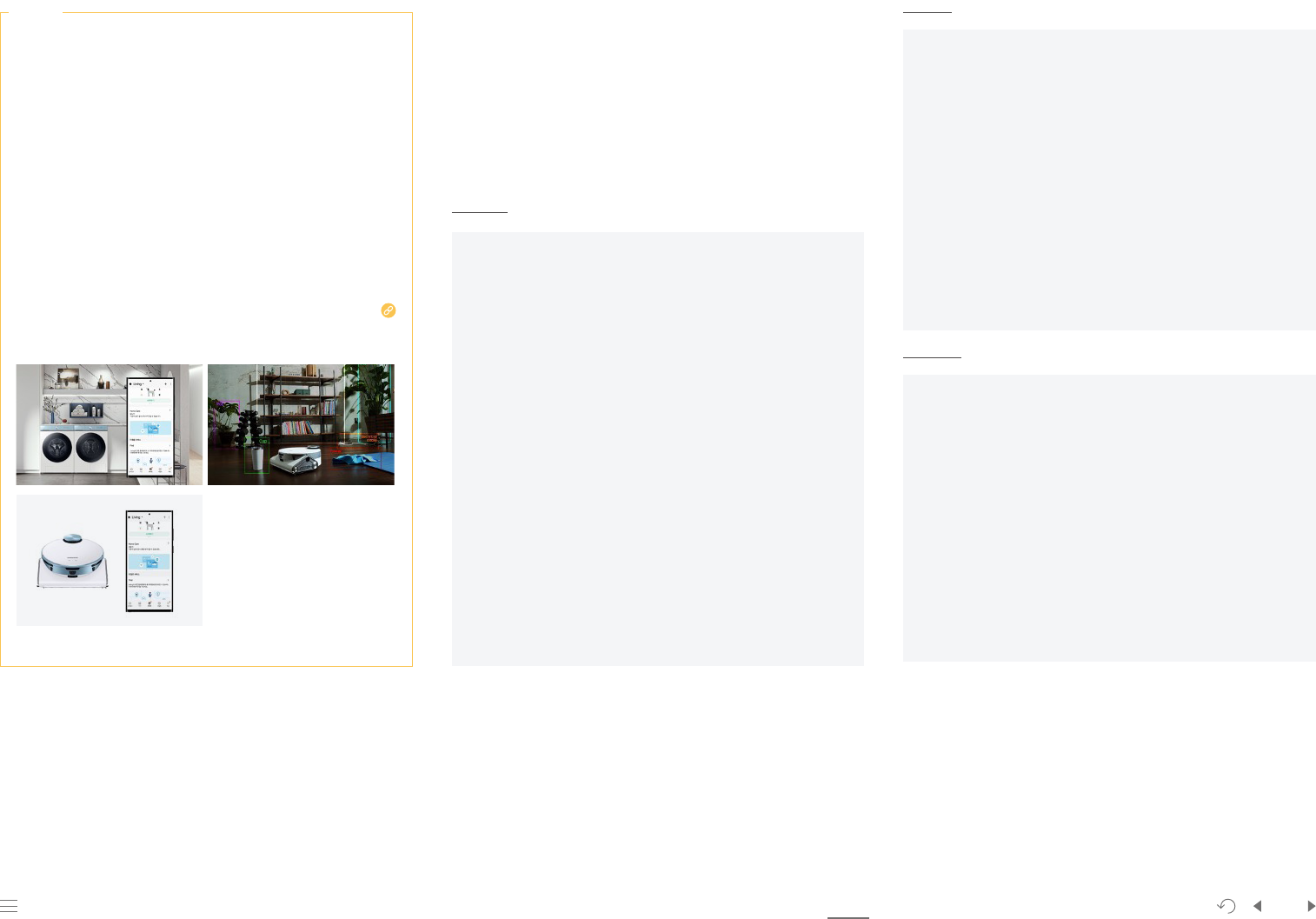
Our Company AppendixApproach to Sustainability Facts & Figures PrinciplePlanet
72
People
Samsung Electronics Sustainability Report 2023
Open Innovation
Transformative innovation cannot be achieved by a single company
alone. It requires open-minded collaboration with multiple partners.
Based on our 3P Open Source Strategy, we are focusing on taking the
lead in key “projects”, securing talented “people”, and pursuing a stable
development “process” to enhance our open-source competitiveness.
Expanding into New Areas including AI, IoT, Security, and Robot
(AI) NNStreamer
· Providing more advanced and efficient AI scenarios by connecting
different devices via neural network streamer technology
(IoT) Matter
· Expanding user experiences by connecting mobile devices, TVs, and home
appliances with IoT by applying the home IoT open standard protocol to
SmartThings
(Security) CredSweeper
· Preventing the leakage of personal data, tokens, passwords, API keys,
etc., using the credential detection tool
(Robot) ROS2
· De-facto open source in robotics used for over 90 types of robots and
deemed to be the most influential
Tizen
· Our OS for TVs and home appliances, which continues to evolve by
supporting IoT, On Device AI, robots, etc., and is used by more than 330
million users from 2012
Attaining AI Credibility Certification for Our Home Appliances
We became the first in the nation to attain AI Credibility Certification
granted by the Korean Standards Association (KSA) for Bespoke Jet Bot AI
and SmartThings Home Care.
AI Credibility Certification was established as a result of the Pilot Private-
Sector AI Credibility Certification Project launched in May 2022 by KSA.
This certification is granted to AI-based products and services verified for
their credibility and ethics. More specifically, they undergo verification in
the four areas of transparency, safety, accountability, and diversity.
For this certification, our products’ ability to recognize objects regardless
of brand, shape, type, etc., was statistically verified. Transparency and
safety concerning object recognition data collection and processing were
also reviewed. For more details, please click the link below.
CASE
* Bespoke Jet Bot AI and SmartThings
Home Care – the first to attain AI
Credibility Certification granted by
the Korean Standards Association
PEOPLE Open Source Specialists
Expanding Open Source Leaders
· Identifying key open source areas, expanding their scope, and fostering open
source leaders through diverse in-house support programs every year
Collaborating with External Developers
Expanding joint open source development projects engaging youth
and external developers
· Samsung Junior Software Cup
· Samsung SW Academy for Youth
· Samsung Open Source Influencer SOS Companions
Networking with diverse open source communities
· Samsung Software Developer Conference(SSDC)
· Global events including SOSCON-India and SOSCON-Russia
· Developer community meetup events, training, workshops, etc.
PROCESS Open Source Operation System
Promoting Open Development
Encouraging internal code-sharing and joint development
· Building in-house open source development infrastructure for software
collaboration
· Promoting participation through inner source project registration and
best practice contests
Operating Samsung Open Source Portal
· Serving as a gateway for external cooperation and communication
Obtaining International Certifications
OpenChain (ISO/IEC 52302020)
· Certification for companies equipped with efficient and consistent open
source systems for software development
3P Strategy to Enhance Open Source Competitiveness
PROJECT Open Source Projects
See article

Our Company AppendixApproach to Sustainability Facts & Figures PrinciplePlanet
73
People
Samsung Electronics Sustainability Report 2023
Samsung Software Developer Conference (SSDC)
The Samsung Open Source Conference, which had been held annually since
2014, was revamped into SSDC. SSDC gathers software developers from
around the world to discuss and collaborate on research and innovative
technologies such as AI, IoT, 5G, cloud computing, and Big Data.
It provides a platform for exchanges between our company and global
software developers centered on the theme of “Learn, Share, and
Network” and helps them build stronger bonds. It has brought together
over 13,500 participants through 360 sessions as of 2022.
Samsung Future Technology Development Initiative
We launched the Samsung Future Technology Development Initiative
in 2013 based on our strong belief that investment in basic science is
imperative for the long-term advancement of humanity and various
industries. This initiative prioritizes support for selected projects in
basic science, novel materials, and ICT based on the principle of “high
risk, high impact” aimed at encouraging researchers to pursue high-
impact projects without holding them responsible for failure.
To facilitate the commercialization of project results, we offer programs
such as the R&D Exchange Meeting, patent application mentoring, and
expert consulting for startup foundation and commercialization.
The Samsung Future Technology Development Initiative is evaluated
to have contributed to expanding the horizons of Korea’s R&D and
developing future technologies by remaining faithful to its principles.
On average, about 2,000 entries are submitted to the non-themed
contest and 200 entries to the themed contest.
Major Projects
Basic Science
261 projects
Tracking and
reconfiguring memory
traces, defining
the mathematical
principles of machine
learning acceleration
techniques, etc.
ICT
251 projects
Resolving biases
incurred by AI
technologies, defining
third-generation
software error
verification techniques,
etc.
Materials
252 projects
Treating hereditary
brain-nervous system
diseases, resolving
the heat generation of
electronic devices, etc.
774 research projects
KRW 996.6 billion in research grants
78
research institutes
Over 14,890
participants
* As of April 2023
❶
Ensuring expertise, fairness, and objectivity in the project screening stage
* With a panel of 1,300 international judges and 2,200 Korean judges
❷
Encouraging researchers to take take on new challenges and experience
trial and error
❸
Providing funding and other support to researchers
❹
Holding the Global Research Symposium to allow contestants to share and
discuss their findings and outcomes with preeminent scholars from around
the world
Operation System
Operation Process
❶
Proposal
Candidates screened by 80 judges
❷
Presentation and Q&A
Presentations for and discussions with 180 judges by screened candidates
❸
Support
R&D Exchange Meeting, patent application mentoring, and expert consulting for
commercialization
SSDC

Our Company AppendixApproach to Sustainability Facts & Figures PrinciplePlanet
74
People
Samsung Electronics Sustainability Report 2023
Open Sourcing Program
This program allows companies wishing to partner with us to submit
business proposals. Once proposals for parts and materials applicable
to our products are submitted, we perform evaluations based on our
internal standards to verify potential suppliers' qualifications. In 2022,
we reviewed a total of 592 proposals, accepted 96 among them, after
which we applied their parts and materials to our products.
Supply Chain Management
Supplier Selection
We thoroughly review potential suppliers' performance in five areas:
1)Purchase and Quality, 2)Environment and Safety, 3)Labor and Human
Rights, 4)Eco-Partner Certification, and 5)Finance. We also dispatch our
in-house experts in those respective areas to conduct on-site audits as
part of the selection of new suppliers.
Standard Supplier Contract
Our standard supplier contract mandates compliance with
internationally accepted labor and human rights standards (e.g.,
prohibition on forced labor, child labor, discrimination based on
ethnicity and gender) and with our in-house workplace safety
standards and corporate social responsibility requirements (e.g., codes
of conduct). It is written in the respective language of the individual
local supplier (English, Chinese, Malay, and other local languages).
Evaluation Areas for Screening New Suppliers
Supplier Selection Results in 2022
In 2022, we conducted additional surveys and interviews with prospective
suppliers to better evaluate their risks related to forced labor, inhumane
treatment, and discrimination. Through these surveys and interviews,
we were able to verify with greater accuracy their working conditions –
with regard to recruitment channels, recruitment fee payment, dormitory
allocation, non-discrimination, and working hours – and screen only the
qualified suppliers.
In 2022, such pre-registration evaluations were performed on 116
companies. While all of the candidates met the essential labor and human
rights standards, two companies failed to meet environment and safety-
related standards such as hazardous chemical management, which
resulted in their disqualification in the final selection.
❶
Purchase and Quality
Evaluation of each supplier’s quality competitiveness
❷
Environment and Safety
On-site audits of the 26 items based on the RBA* criteria (essential
items include fire extinguishing systems, hazardous materials and
waste, and wastewater treatment facilities)
* Responsible Business Alliance (RBA) is an industry coalition dedicated to
advancing corporate social responsibility in global supply chains
❸
Labor and Human Rights
On-site audits of the 19 items based on the RBA criteria (essential
items include prohibition on forced labor, prohibition on child labor,
compliance with regulations related to working hours, accurate
calculation and payment of wages, provision of wage statements
and prohibition on delay in the payment of wages, proper
payment of social insurance fees and other withholding taxes and
contributions, prohibition on inhumane treatment, and prohibition
on discrimination based on personal traits)
❺
Finance
Evaluation of each supplier’s credit rating and financial conditions in
consultation with external specialists
❹
Eco-Partner Certification
Certification issued by Samsung Electronics to those companies that
meet our standards for product environment policy, education and
training, and hazardous substance control (only certified companies
are qualified to register as our suppliers)
We closely cooperate with our suppliers to achieve
shared growth and build responsible supply chains. Our
supply chain operations aim to reinforce our suppliers’
capabilities while protecting labor and human rights
and enhancing their environmental, health, and safety
standards.
Sustainability in
Supply Chains
Open Sourcing Program
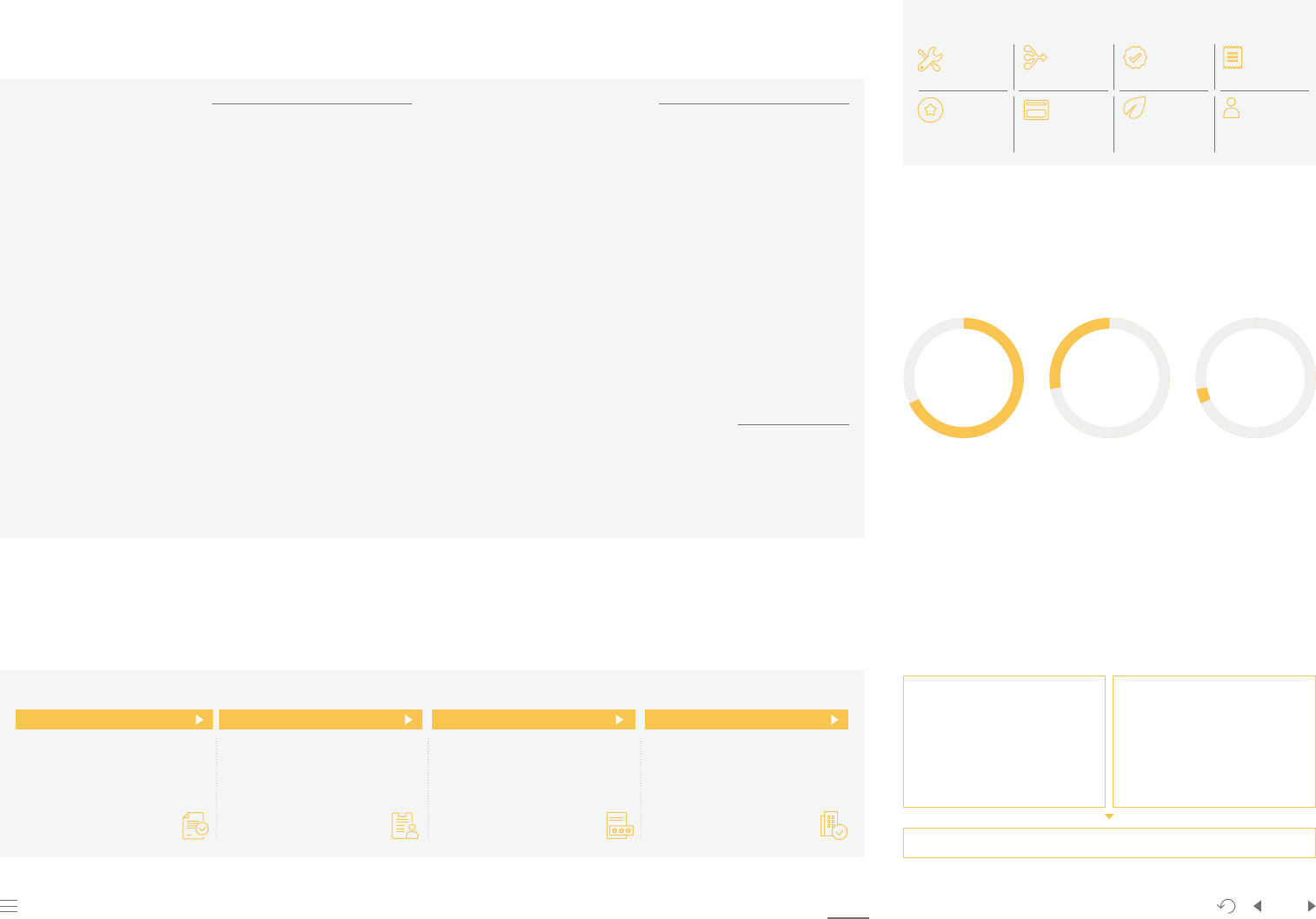
Our Company AppendixApproach to Sustainability Facts & Figures PrinciplePlanet
75
People
Samsung Electronics Sustainability Report 2023
Supplier Management System
We handle all supplier-related matters through our integrated purchase system based on the Global Purchasing Code of Conduct and operate an
organizational unit dedicated to comprehensive supply chain management.
Management System Certifications
We strive to ensure that our suppliers are equipped with robust
occupational environment and safety management systems. To
this end, we encourage them to get certified against international
standards, such as ISO 14001 and ISO 45001, and reflect related
outcomes in the comprehensive supplier evaluations.
We also provide consulting to help our suppliers attain certification
issued by a specialized agency. In 2022, 132 suppliers benefited from
this program.
Environment management
system (ISO 14001)
International specifications for an
environment management system
applicable to all industries and
operations
Safety and health management
system (ISO 45001)
International standards that
specify requirements for the
systematic management of safety
and health
Outcomes reflected in the comprehensive supplier evaluations
Global Purchasing Code of Conduct
The Global Purchasing Code of Conduct comprises the key requirements
from the regulations and guidelines on purchase-related tasks and ethical
obligations of employees in charge of purchasing. It takes precedence
over other regulations and manuals as far as purchasing is concerned.
The following are the key criteria and principles set up to ensure ethical
purchasing practices.
We select new suppliers only when we deem them highly competitive
compared to existing suppliers or when existing suppliers are no longer
capable of meeting our needs (average duration of transaction with
suppliers standing at 14 years as of 2022).
We finalize the unit price through the preset procedures – market research,
cost review, price negotiation, and price determination – based on mutual
consent.
We do not require suppliers to provide their technical data to us or a third
party for reasons regarding the transaction – price review – without
justifiable grounds.
We provide demand forecasts for materials required for mass production in
advance to allow suppliers to make necessary preparations.
We determine and deliver all payments in consultation with suppliers
pursuant to the terms and conditions specified in individual contracts. In
2022, we made full payments to 589 suppliers within 10 days.
Integrated Purchase System (G-SRM)
We manage diverse purchase-related tasks, from supply chain management
to risk management and integrated work environment management, through
the integrated purchase system (G-SRM).
We submit our requests for parts to our suppliers through an automated
system. We set the delivery date based on the lead time agreed by the two
parties and thus we cannot readjust it arbitrarily without the respective
supplier’s approval. Even with the respective supplier’s approval, the system
restricts the expedition of the delivery date. As of 2022, only 4.8% of all
supplier contracts were subject to delivery date changes based on mutual
consent after order placement. We continually strive to improve demand
projection accuracy and minimize delivery date readjustment.
In order to minimize risks related to business continuity, we operate a
supply chain risk management system designed to promptly obtain disaster
information in connection with relevant institutions and automatically
analyze the respective disaster’s impact on our supply chain.
Dedicated Organizational Unit and Support Program
We have an organizational unit dedicated to strengthening our suppliers’
competitiveness by means of on-site audits of their work environment as well
as R&D and employee training programs.
Major Evaluation Items
Technology Response Cost Finance
Quality Delivery
Environment
and Safety
Labor and
Human Rights
2022 Comprehensive Supplier Evaluation Results
We performed annual comprehensive evaluations on 89% of our
suppliers that have been in our supply chain for at least one year. As a
result, 62.1% were rated outstanding, and 3.5% required improvement.
* Suppliers registered for less than one year were excluded from the evaluation.
3.5%
Need for
Improvement
62.1%
Outstanding
34.4%
Other
Comprehensive Supplier Evaluation
We perform annual comprehensive evaluations on all of our suppliers. We provide benefits to those rated outstanding – such as the priority allocation
of supply volumes and extra points in the assessment for exemplary innovation cases – and honor them with Awards of Excellence. We reflect the
results of the evaluations in the following year’s purchasing policy to encourage our suppliers to improve their competence.
Major Evaluation Items
Regular Monitoring
Individual suppliers conduct self-led
monitoring based on the evaluation
criteria that we provide.
Voluntary Improvement
Individual suppliers identify and
remedy improvement points while we
provide risk monitoring and feedback.
Comprehensive Evaluations
We announce the final results of the
annual supplier evaluations at year’s
end.
Follow-Up Management
Individual suppliers establish and
implement improvement plans with
our support.

Our Company AppendixApproach to Sustainability Facts & Figures PrinciplePlanet
76
People
Samsung Electronics Sustainability Report 2023
ESG Audit and Capacity-Building
We require all of our suppliers to comply with the local laws of their
respective countries as well as the Samsung Supplier Code of Conduct
based on the RBA Code of Conduct in relation to human rights,
environment, health and safety, and ethics. To ensure compliance,
we operate an integrated work environment management process
consisting of self-assessments, on-site audits, and third-party audits.
We reflect the findings from on-site audits and third-party audits
in the annual comprehensive evaluations and policy improvements
for the following year, and provide benefits to those suppliers rated
outstanding, such as extra points in the comprehensive evaluations
and cash rewards. In 2023, we established a reward program to
acknowledge our suppliers with outstanding ESG performance.
Through this program, we gave incentives to two suppliers in
recognition of their performance and improvement efforts in the labor
and human rights and environment sectors throughout 2022.
The Partner Collaboration Center, Vendor Management Improvement
Task Force, Global Technology Research, and each branch’s dedicated
organizational unit are responsible for ensuring the day-to-day
implementation of the human rights policy within our supply chain.
The executives and working-level staff of the respective organizational
units are in charge of conducting compliance audits on suppliers,
promoting improvement efforts, and ensuring information disclosure
– which are linked to their performance and compensation. We
manage human rights risks at the company level through the Global
Labor Issues Council, a consultative body that meets monthly. This
council consists of executives and working-level staff of the eight
organizational units (People Team, Corporate Legal Team, Partner
Collaboration Center, Vendor Management Improvement Task Force,
Global Technology Research, Corporate Sustainability Center, Global
EHS Center, and Investor Relations Team). We discuss issues of greater
magnitude in the Sustainability Council.
We require our first-tier suppliers to manage the work environments of
their subcontractors in compliance with our internal work environment
policy. For subcontractors with issues deemed to be of serious concern,
we monitor via our first-tier suppliers whether they have successfully
implemented remedial actions and achieved the desired results.
Supplier Code of Conduct
We update our Supplier Code of Conduct to reflect revisions of the RBA*
Code of Conduct and other global norms, and require our suppliers to
comply with it. The standard supplier contract mandates compliance
with the Supplier Code of Conduct. We also require each supplier to
sign the Written Pledge for Compliance every year.
We provide the Supplier Code of Conduct Guide to help suppliers
follow the Supplier Code of Conduct more effectively and easily and
practice compliance management. Suppliers should cooperate closely
during on-site audits and upon request to compile the relevant data for
compliance assessment.
* We developed our code of conduct developed for our suppliers based on the Code of
Conduct of the Responsible Business Alliance (RBA), an industry coalition dedicated
to corporate social responsibility in global supply chains
Self-Assessment
We developed a self-assessment tool based on the RBA Code of Conduct
and distributed it to all of our first-tier suppliers to facilitate annual self-
assessments. We also encourage them to obtain certification related
to international standards in corporate social responsibility (SA 8000,
etc.) by including it as one of the self-assessment items. In 2022, we
reflected RBA’s updated criteria in this tool to facilitate self-assessment.
The updated criteria places greater weight on items of significance, such
as forced labor, child labor, and industrial accidents, to preemptively
identify potential risks of our suppliers.
We actively collect suppliers’ opinions and suggestions to establish
a more effective self-assessment system and make improvements
accordingly.
Self-
Assessments
On-Site
Audits
Third-Party
Audits
Monitoring
Progress on
Improvement
On-Site Audit
Our dedicated organizational unit consisting of RBA-certified auditors
conducts on-site audits of our suppliers. We review their documents
thoroughly, including wage information, contracts, and policies, and
perform interviews of their employees (a minimum of square root
of the total number of employees) engaging with both working-
level staff and managers during the audits. We manage all identified
improvement points through G-SRM. We register risk grades and
detailed violations on G-SRM once the participating employees of
the respective supplier confirm the results. We require each supplier
to submit its improvement plan and results, and our staff in charge
reviews them along with the supplier’s employees or representatives.
We guide suppliers to take immediate remedial actions on site if
possible and normally monitor whether they have taken remedial
actions within three months from the registration of the improvement
points. We monitor facility installation, certification, and other matters
that require extended time and significant expenses over a longer term
based on the respective supplier’s improvement plan. We demand
suppliers found to have committed violations in our priority areas,
including prohibition of child labor and forced labor, to take immediate
remedial actions and impose penalties in the comprehensive
evaluations. We also operate a working-hours monitoring program
through G-SRM to ensure that our suppliers comply with our work-
hours requirements. Through this program, we review the average
working hours and highest working hours of our suppliers’ employees
at different business sites on a monthly basis and rate them in
accordance with the seriousness of non-compliance. In 2022, we
performed on-site audits based on RBA’s criteria on all 329 high-risk
suppliers* and implemented remedial actions. As a result, the average
on-site audit compliance rate reached 95%.
* High-risk suppliers refer to companies considered to have high labor and human-
related risks or a significant impact on our business – in terms of transaction amount/
volume, low self-assessment scores, EHS issues raised by NGOs, among others. As of
2022, 18.5% of suppliers equipped with manufacturing facilities were assessed to be
in the high-risk group.
** At approximately 150 resident suppliers, we conducted a comprehensive evaluation
of their work environment in line with the RBA standards, identified areas of
improvement, and established a management system (from December 2022 to April
2023).
Supplier Code of Conduct Supplier Code of Conduct Guide
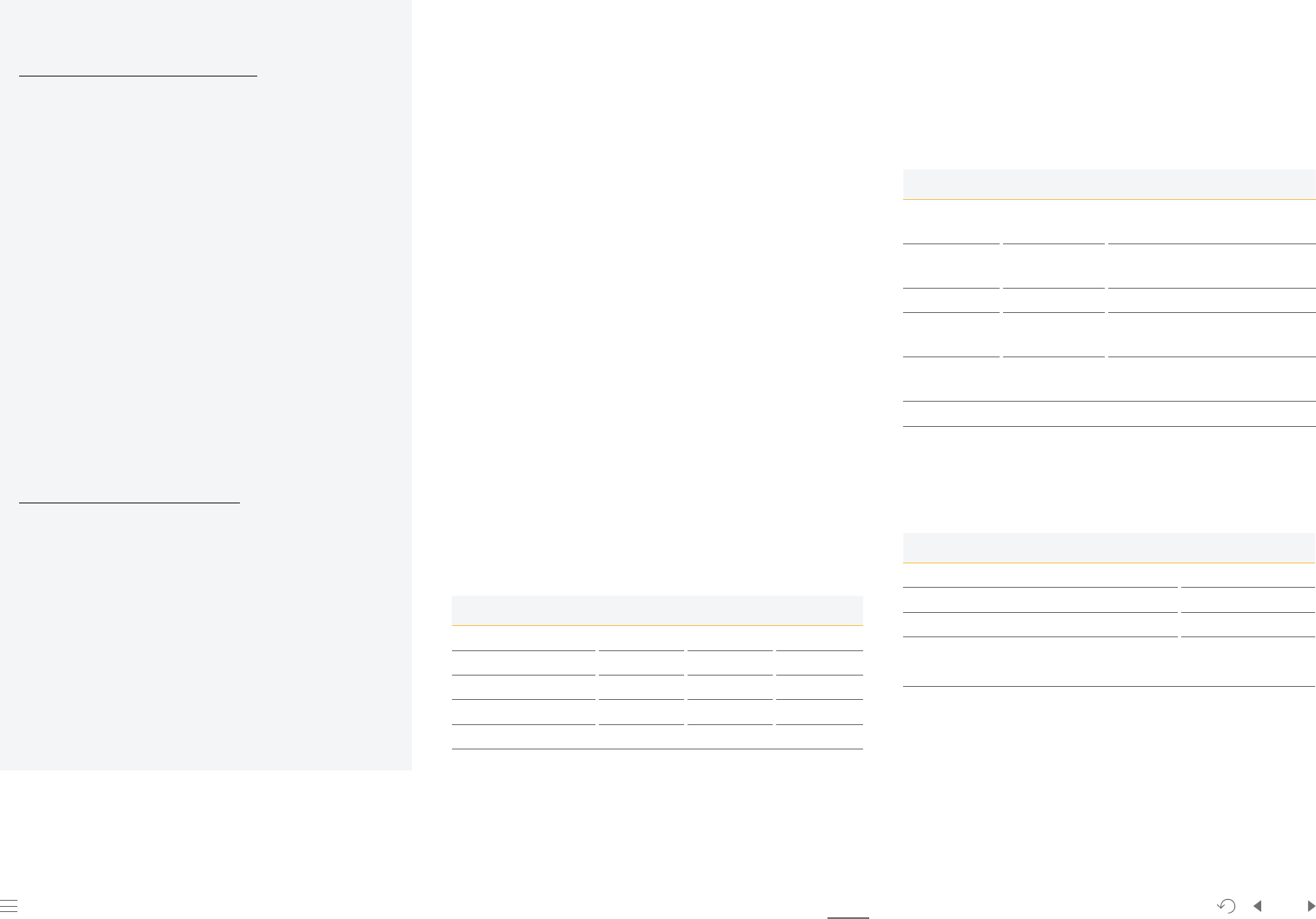
Our Company AppendixApproach to Sustainability Facts & Figures PrinciplePlanet
77
People
Samsung Electronics Sustainability Report 2023
Compliance Rate by Area*
Area
2020 2021 2022
Labor and human rights
92% 95% 97%
Health and safety 95% 97% 96%
Environment 99% 98% 98%
Ethics 98% 99% 99%
Management system 94% 99% 96%
* Post-closure-audit compliance rate (%)
Third-Party Audit
We conduct third-party audits every three years on the top 90% of
our suppliers selected based on annual transaction amounts. An RBA-
certified audit firm performs third-party audits in the form of Customer-
Managed Audits (CMA) based on RBA’s Validated Assessment Program
(VAP)*. Any improvements that can be made immediately after the
initial audit are corrected on site, and the results of improvement
implementation are confirmed through the closure audit.
In 2022, we conducted third-party audits on 121 suppliers. Although
we faced difficulties in conducting on-site audits due to the COVID-
19 pandemic, we ensured continuity through on-line meetings and
inspections.
We typically conduct worker interviews on the premises of the
respective suppliers based on mutual trust to minimize the possibility
of any production setback. However, we will perform them outside
of the company to increase transparency of the audit if there is a
perceived risk, such as intervention by managers of suppliers.
In 2023, we plan to conduct third-party audits on some second-tier
suppliers on a pilot basis. First-tier suppliers currently manage second-
tier suppliers in our supply chains, but we plan to gradually expand the
scope of suppliers under our direct management and share the audit
outcomes with them.
* Document review (employee wage information, contracts, policies), face-to-face
interviews of employees and managers (square root of the total number of employees
at minimum), on-site audits (initial and closure audits) and improvements
Cases of On-Site Audits
Special Audits to Eradicate Child Labor We maintain a zero-
tolerance policy for child labor at our suppliers and perform
special audits of their recruitment practices every year to
eradicate child labor. In 2022, we performed audits on 119 first-
tier suppliers and 31 second-tier suppliers during middle school
and high school vacation periods when the likelihood of the
employment of minors notably increases. Although none were
found to have recruited child workers, some failed to meet our
recruitment process standards (e.g., lack of a facial recognition
system for identity authentication, failure to include the child
labor prohibition provision in the employment contract). We
immediately had these suppliers establish improvement
measures.
We plan to distribute a compliance guidebook, which specifies
appropriate recruitment processes and country-specific legal
requirements, and ensure that our suppliers conduct regular
internal training for their working-level staff based on this
guidebook.
Support for Local Legal Requirements We require our suppliers
to comply with all local laws as well as the Supplier Code
of Conduct. To ensure compliance, we closely monitor any
changes made to such laws that may impact their operations.
For example, in May 2019, the Mexican government announced
the amendment of the Federal Labor Law that guarantees the
activities of labor unions and collective bargaining and allows
workers to select their labor unions through secret voting. We
conducted a presentation on the amended law scheduled to take
effect in 2023 for 34 staff members of 21 local suppliers. We also
plan to ensure their operations are in compliance with the law by
placing a focus on relevant items in the audits.
Monitoring Progress on Improvement
Based on the outcomes of the initial third party audits, we engage with
our suppliers to establish improvement measures and monitor their
implementation status through the closure audit. Compliance gaps that
require an extended period of time for improvement are constantly
monitored in collaboration with the respective suppliers.
* Improvement rate: (Number of non-compliance found in the initial audit – Number of
violations found in the closure audit) / Number of non-compliance found in the initial
audit
Improvement Rate by Area*
Area
Improvement rate Major gaps
Labor and
human rights
70% Working hours, etc.
Health and
safety
83%
Emergency response facility
inspection, etc.
Environment 79% Harmful substance control, etc.
Ethics 94%
Intellectual property protection policy,
etc.
Management
system
81% Internal assessment, etc.
Total 80%
Working-Hours Management Status
Items
Status
Working-hours compliance rate*
93%
Average working hours per week 45 hours
Highest average working hours per week No more than 47 hours
Compliance rate of guaranteeing at least one
holiday per week
97%
* Employees must not work for more than 48 hours per week or for more than 60 hours
per week even when including overtime (voluntary). They must be guaranteed at least
one day off per week.

Our Company AppendixApproach to Sustainability Facts & Figures PrinciplePlanet
78
People
Samsung Electronics Sustainability Report 2023
Findings in Major Labor and Human Rights Items
Item
Description No. of Findings Details
Freely chosen
employment
Prohibition of forced labor 3
Failure to reimburse recruitment fees, renew collective bargaining
agreements, and cover pre-employment physical assessment fees
Establishment of forced labor prohibition policies and
procedures
-
Employment contract signing in native language 5
Failure to include essential information in contracts and comply with
cap on temporary worker ratios
Prohibition of the storage of an original copy of ID 1 Failure to establish relevant policies
Guarantee of the freedom of movement -
Prohibition of
child labor
Prohibition of child labor -
Establishment of child labor prohibition policies and
procedures
-
Protection of
underage workers
Protection of underage workers 1 Failure to establish relevant policies
Protection of trainees and interns -
Wage and welfare
benefits
Accurate calculation and payment of wage 5
Failure to pay overtime work allowances and provide record of work
hours
Issuance of pay slips and prohibition on delay in wage
payment
4
Failure to adhere to company payout policy and comply with legal cap
on severance pay
Prohibition of unfair penalty imposition 1 Wage reduction as a disciplinary measure (e.g. product damage)
Humane
treatment
Prohibition of inhumane treatment 1 Failure to establish relevant policies and conduct trainings
Establishment of humanitarian treatment policies and
procedures
-
Recording and management of disciplinary measures
taken
-
Non-
discrimination
Prohibition of discrimination based on gender and other
personal traits
1 Hepatitis B screening for new hires
Establishment of discrimination prohibition policies and
procedures
-
Provision of space for religious activities -
Freedom of
association
Guarantee of the right to establish and join labor unions 6
Failure to provide record of worker representation elections and
recognize unionized workers
Guarantee of the right for collective bargaining 3
Failure to renew union activity agreements and recognize employees
participating in collective bargaining
Prohibition of discrimination against labor union
members
-
ESG Diagnosis and Consulting for Suppliers In order to help
reinforce ESG management performance in our semiconductor
supply chain, the DS Division has offered the ESG diagnosis
and consulting service for our suppliers in collaboration with
Ecredible, a corporate management assessment institution, since
2022. Our 95 small and medium-sized suppliers based in Korea
performed self-diagnoses as well as third-party due diligence. We
provided advanced ESG management consulting for the 25 lowest
rated suppliers after actual inspections.
[DS Division] ESG Diagnosis and Consulting Process for Suppliers
1. Basic and advanced ESG training for suppliers
2. Online self-diagnosis
3. Third-party due diligence
4. Diagnosis report issuance
5. Selection of the lowest 30% high-risk group
6. Advanced ESG management consulting
7. Improvement monitoring
8. Diagnosis result disclosure

Our Company AppendixApproach to Sustainability Facts & Figures PrinciplePlanet
79
People
Samsung Electronics Sustainability Report 2023
Prohibition on Forced Labor
During a third-party audit, we detected that a recruiting agency
hired by one of our local first-tier suppliers in East Asia was imposing
fees on migrant workers. Based on further inspection, we found
it is customary in the respective country for recruiting agencies
to collect recruitment fees from migrant workers. The agency
also lacked an understanding of our Supplier Code of Conduct. We
immediately took steps to return the paid fees to migrant workers
in collaboration with personnel staff of the respective supplier and
established the code of conduct concerning the prohibition on the
collection of recruitment fees to prevent its recurrence We had the
respective supplier conclude a new contract with the recruiting
agency to initiate a new migrant worker policy and stop collecting
recruitment fees from them. We also made it mandatory to perform
interviews of migrant workers and audit the performance on a
quarterly basis.
We found another one of our first-tier suppliers in the same region
to be withholding the cost of physical examination required during
the recruitment process from new recruits and returning the
amount only when they continued their service at the respective
supplier for more than 90 days. Upon further investigation, we
found that the supplier’s policy had been set intentionally to prevent
early retirement of new employees. We immediately took steps to
remove this unfavorable condition and return the amount to all new
recruits and fully update the relevant policy. We also made sure
that the updated policy was delivered to all employees to improve
transparency in the recruitment procedures.
Employment Contract Signing
We found one of our first-tier suppliers in East Asia failed to provide
an employment contract or to specify necessary information, such
as job descriptions, working hours, and holidays, in the contract for
foreign workers hired through a recruiting agency. This is a violation
of our requirement to distribute an original copy of the employment
contract to each worker. The respective supplier lacked a proper
understanding of this requirement. In collaboration with the
personnel manager of the supplier, we had the contract revised to
include the necessary information and corrected the process to
obtain and manage each worker’s signature of acknowledgement.
We also made sure that two original copies of the employment
contract be issued – one of which is given to the worker and that
the recruiting agency and supplier cross-check the issuance of the
original copies.
Accurate Calculation and Payment of Wage
We found that holiday night shift allowances for workers recruited
by one of our first-tier suppliers in East Asia through a recruiting
agency were lower than the legal minimum wage of the region. We
require our suppliers to comply with the Supplier Code of Conduct
and local laws without exception and strictly prohibit discrimination
against workers based on race, ethnicity, gender, among others,
for all working conditions including wages and compensation. We
obligate all of our suppliers to set the hourly holiday night shift
allowance higher than the hourly wage for regular working hours.
The respective supplier lacked a proper understanding of this
requirement. We informed the personnel staff of the supplier of
the violation upon detection and guided the supplier to recalculate
and pay accurate amounts to the underpaid workers. We have
required the supplier to continue monitoring wage-related laws
and regulations and regularly conduct internal audits to prevent the
recurrence of a similar incident.
Prohibition on Delay in Wage Payment
We found that one of our first-tier suppliers in East Asia provided
severance pay for a retiree after the preset deadline. Pursuant to the
Supplier Code of Conduct, all retirees at our suppliers must be paid
the full amount of severance pay and wages within 30 days from the
date of retirement. We guided the respective supplier to establish
a management process to ensure the completion of the payment of
severance pay and wages within 30 days from the date of retirement
and to have the payment details reported to the personnel staff on
a monthly basis to prevent the recurrence of such an incident.
Findings and Corrective Actions
Working-Hours Compliance
We detected a case of surpassing the legal monthly overtime limit
by more than 30 hours through a third-party audit on one of our
first-tier suppliers in East Asia. Employees of all of our suppliers
must comply with the requirements of a standard workweek
of 48 hours and a maximum workweek of 60 hours including
overtime. Under local laws, the stricter of the requirements must
be applied. We determined the respective supplier lacked a proper
understanding of the working-hours limit and did not accurately
identify the status, since its employees’ working hours were
kept manually. We first provided training for all of its employees,
including the managers, to resolve this issue. We also helped the
supplier adopt an automated system that sends alerts when any
employee applies for overtime past his/her legal limit and required
the personnel staff to communicate with the team manager in
charge. We verified that no employees had exceeded the legal
working-hours limit two months after the implementation of the
improvement measures.
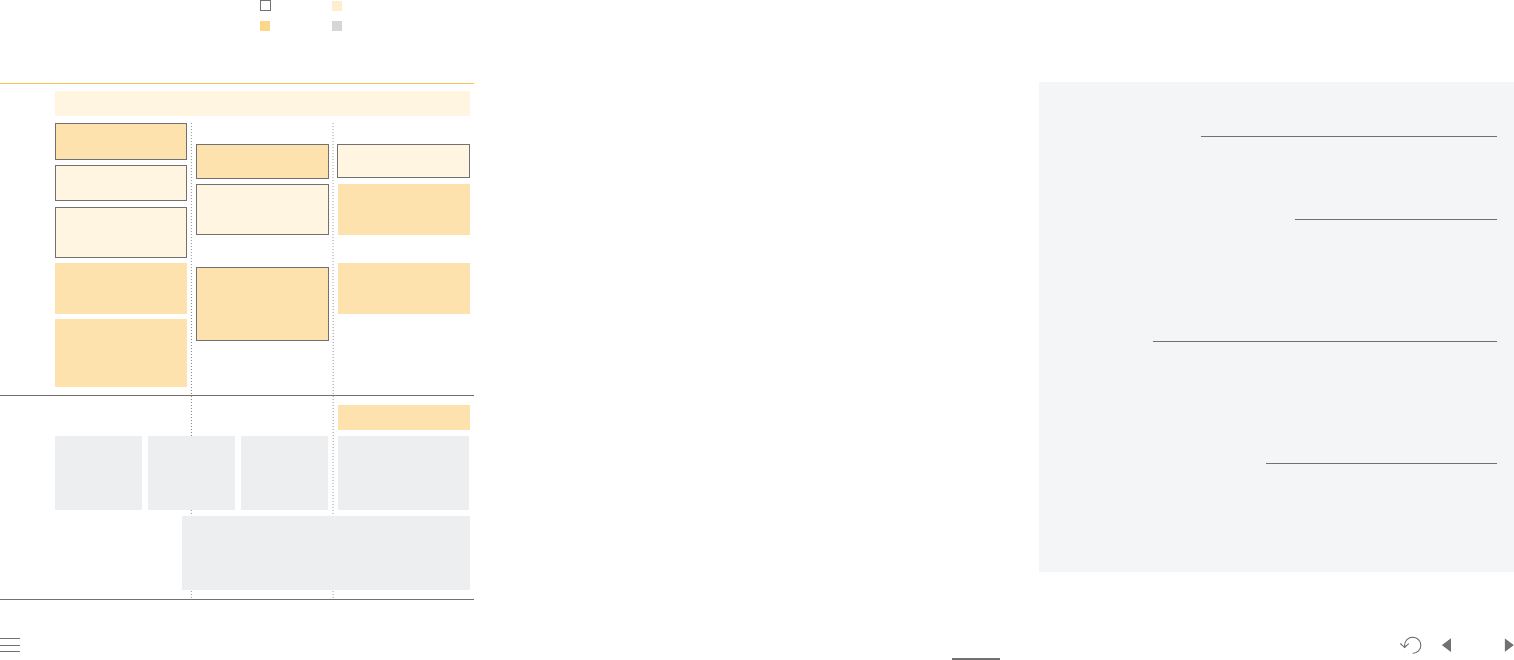
Our Company AppendixApproach to Sustainability Facts & Figures PrinciplePlanet
80
People
Samsung Electronics Sustainability Report 2023
ESG Capacity-Building
ESG Training System
In 2023 we’ve placed priority on building suppliers’ capacities in
sustainability management in areas including climate action, resource
circularity, human rights, compliance, and social responsibility.
In line with our sustainability-related policies, we have developed
training programs for our suppliers to help them meet global standards in
information disclosure and prepare for regulations such as the corporate
sustainability due diligence legislations in Europe. We strive to raise
awareness of the importance of responsible practices and build their
capacities on the ground in managing GHG emissions, conducting supply
chain due diligence, operating EHS systems, publishing sustainability
reports, among others. Moreover, legal compliance courses are offered
online which will soon become available to our second and third-tier
suppliers that have signed a fair trade agreement with us.
Compliance and Human Rights Training
Since 2015, we have hosted a range of compliance and human rights
workshops and training sessions for the heads and working-level staff of
our suppliers on a yearly basis. In 2022, 408 suppliers
1)
around the world
participated in our training.
· Sharing global and local legal revisions, audit results and best practices of our
suppliers, and environment- and safety-related trends of different regions
· Providing training on the prohibition on forced labor, mutual respect, humane
treatment, and anti-discrimination based on the Supplier Code of Conduct
· Providing human rights training encompassing diverse areas from recruitment
to corporate culture, personnel, and labor-management relations
· Providing industrial safety training on the protection of pregnant and nursing
employees, among others
2)
· Providing specialized training on chemicals and awarding suppliers with
outstanding performance in labor and human rights and environment and
safety
· Encouraging participating suppliers to actively share the details of our training
and provisions of the Supplier Code of Conduct with their subcontractors
· Providing training on the protection of women, local culture, and local business
environment targeting 22 suppliers advancing into Vietnam where the rate of
female employees is notably high
1) Including 98% (323) of high-risk suppliers and 85 suppliers projected to have
potential risks
2) Rate of employees subject to maternity protection at high-risk suppliers: 2.5% (based
on G-SRM information as of January 2023)
Migrant Worker* Recruitment Process Training
As per our Supplier Code of Conduct, we prohibit forced labor and
collection of recruitment fees from migrant workers hired by our
suppliers. If such case is identified, the respective supplier must
reimburse the fees within 90 days.
The collection of recruitment fees from migrant workers is
considered a highly serious violation of labor and human rights
along with prohibition on child labor and violation of working-hours.
We downgrade the rating of those suppliers that fail to achieve
improvement on the comprehensive evaluations. If they commit the
same violation repeatedly, we suspend transactions with them.
Based on this policy, we reimbursed a total of USD 1,125,734 to 1,649
migrant workers from 11 countries from 2017 to 2022. In 2021, we
established the Responsible Recruitment Procedure training course to
improve our suppliers’ understanding of the procedure, help eliminate
relevant risks, and offer a self-diagnosis tool. In 2022, we expanded
the group of countries subject to training to include Hungary, Slovakia,
Poland, and China and provided training on recruitment criteria, risk
identification and assessment, risk improvement, risk prevention
and mitigation, etc., for 505 labor and human rights staff at 213
suppliers. The training sessions were conducted in local languages
(English, Chinese, Thai, and Malay) to ensure the understanding of local
employees. This training course will soon be designated as a mandatory
training course for suppliers located in countries with migrant workers.
We plan to resume special audits on forced labor, which were
temporarily suspended due to the COVID-19 pandemic, in 2023 starting
with Southeast Asia and Europe. We will continue to improve the labor
and human rights conditions of migrant workers by closely monitoring
the appropriateness of recruitment fee calculation, legitimacy of
deductions from wages, actual reimbursement results, and other items
with forced labor risks.
* Rate of migrant workers at high-risk suppliers: 1.5% (Based on G-SRM information as
of January 2023)
ESG Training for Suppliers
New
Expert Track
Required
Basic (Recommended)
Training Details
Recruitment Criteria
Correcting and supplementing suppliers’ policies based on the provisions
related to the prohibition on forced labor in the Supplier Code of Conduct
Risk Identification and Assessment
Identifying the entire recruitment process related to recruiting agencies
in departure countries, recruiting agencies in destination countries, and
suppliers and assessing risks using the self-diagnosis tool
Improvement
Collecting data through migrant worker interviews and submitted
grievances, reaching conclusions in a transparent manner, and establishing
improvement plans
Risk Prevention and Mitigation
Analyzing fundamental causes, establishing subsequent corrective
measures, and performing training for migrant workers and recruiting
agencies
Environmental (E)
7 courses
Social (S)
9 courses
Governance (G)
6 courses
ESG Management Leaders (in connection with improvement tasks / E·S → E·S·G)
GHG Management
*DS separately managed
ESG Due Diligence on
Supply Chains
FTA Basics
Energy Management
System (ISO 50001)
Safety and Health
Management System
(ISO 45001)
Sustainability Report
Environmental
Management System
(ISO 14001)
Chemical
Substances
Control Act
Serious Accidents
Punishment Act
Occupational
Safety and
Health Act (risk
assessment)
Legally required training (4)
Sexual Harassment Prevention, Anti-Harassment Policy,
Workplace Bullying Prevention, Disability Awareness
Enhancement, and Privacy Protection
Coprosperity and
Cooperation Seminar
(second- and third-tier
suppliers)
Regulated Substances
Control (suppliers based in
Korea and other regions)
Fair Transactions
(medium-sized
companies)
Hands-On Fair
Transactions
(first-tier suppliers)
Supplier Code of Conduct
(7 areas)
(suppliers based in Korea
and other regions)
Chemical Substances
Control Manager
(first-tier, second-tier, and
third-tier suppliers)
First-tier suppliers
Second- and third-tier suppliers

Our Company AppendixApproach to Sustainability Facts & Figures PrinciplePlanet
81
People
Samsung Electronics Sustainability Report 2023
Environmental Health and Safety (EHS) and
GHG Emissions Management
The prerequisite for the development and clean production of eco-
conscious products is the fulfillment of our responsibility for our supply
chains. We work to reduce our environmental impact, mitigate the
generation of harmful substances, and improve workplace health and
safety in cooperation with our suppliers.
GHG Emissions Reduction
To ensure systematic climate action at the supply chain level, we
require suppliers that correspond to the top 90% of our purchase
amount to disclose relevant information, set targets, and implement
reduction activities. We monitor and support these activities while
developing policies to strengthen management and oversight or
suppliers’ participation.
GHG Emissions Management
Since we joined the CDP Supply Chain Program in 2019, we have
collected information on our suppliers’ emissions and renewable
energy use, engaged in GHG emissions reduction campaigns targeting
our suppliers, and organized regular seminars. The number of suppliers
participating in the CDP Supply Chain Program has continued to
increase from 163 in 2020 to 203 in 2021 and 308 in 2022. We also focus
on providing training to enhance their GHG management capacity.
In 2022, we developed the GHG management guidelines on how to
calculate GHG emissions, set reduction targets, and define reduction
activities; provided training on the guidelines for our suppliers; and
established the GHG Management course within the ESG curriculum at
the Training Center of the Partner Collaboration Academy.
Supporting GHG Reduction Activities
We strive to reduce GHG emissions across our supply chains in close
collaboration with our suppliers. We operate a funding program to
help them achieve energy efficiency, expand renewable energy use,
and develop carbon reduction technology. Moreover, we formed a
consulting unit dedicated to helping suppliers improve their on-site
practices.
Better EHS Management: 2022 Key Milestones in Numbers
505
primary suppliers underwent
regular environmental and safety
audits.
1,228
supplier employees completed
environmental and safety training.
60
suppliers that have high-risk
processes were provided with
support to prevent environment
and safety-related accidents to
ensure supply chain stability.
308
suppliers that participate in the
CDP Supply Chain program received
risk assessments and management
concerning their subcontractors.
455
trainees completed training on the
understanding of environmental
and safety laws and response
measures for the Serous Accidents
Punishment Act.
handling regulated chemicals and improving related control systems,
while providing support for the upgrading of local ventilation system,
chemical storage facilities, and chemical leak prevention equipment.
EHS Improvement Support
We have established an organizational unit dedicated to supporting
our suppliers’ environmental and safety management and operate a
range of programs to foster EHS model suppliers, provide specialized
support for suppliers that have high-risk processes, and assist them in
the attainment of ISO certification.
The DS Division closely communicates with the employees of our
suppliers via the Environment and Safety Portal for Our Suppliers. In
2022, a total of 2,267 inquiries were submitted and resolved on this
portal, contributing to the prevention of EHS accidents.
We host the Advanced Tech Fair to introduce innovative carbon
emissions reduction technologies and operate development funding
programs to promote GHG emissions reduction by our suppliers. We
encourage our suppliers to apply for ESG-related government funding
and consulting programs by keeping them informed. In 2023, we plan
to launch a pilot project with major suppliers to identify best practices
in GHG emissions reduction and share them with more suppliers.
Strengthening Management Policy
We continue to advance our supplier management policy to effectively
manage our suppliers’ GHG emissions. We mandate the calculation and
recording of energy use and direct and indirect GHG emissions (Scopes
1 and 2) for each business site through the Supplier Code of Conduct
and reflect GHG emissions information disclosure and reduction
outcomes in the comprehensive supplier evaluations. We give extra
points in the evaluations to suppliers with outstanding reduction
performance.
Harmful Substance Control
Eco-Partner Certification
For the meticulous inspection of not just supplied products but also
their parts, we operate the Eco-Partner Certification program. We
require our suppliers to undergo the Eco-Partner Certification review
every two years to maintain their status, and those failing to meet our
criteria are subject to transaction restrictions.
We issue the certification based on the results of the review of their
adherence to the Harmful Substance Operating Rules and environment
and quality control systems.
We require our suppliers to submit raw material data collected from
their raw material companies in combination with written proof that
guarantees the credibility of harmful substance data. We then visit
their manufacturing sites to thoroughly verify the submitted data.
Safe Use of Chemicals
We perform on-site audits to monitor whether our suppliers meet our
standards for the safe use of chemicals. We also offer consulting on
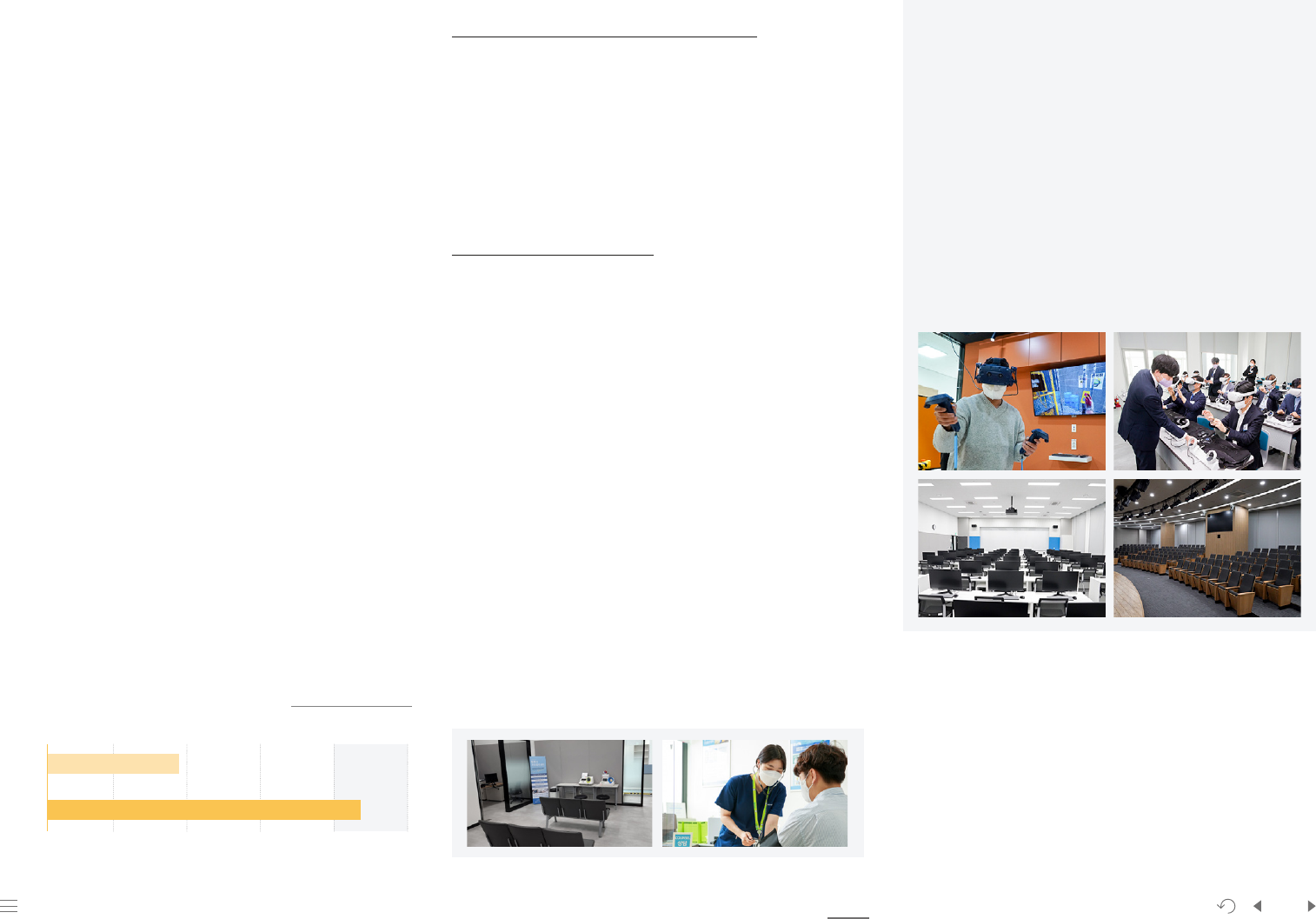
Our Company AppendixApproach to Sustainability Facts & Figures PrinciplePlanet
82
People
Samsung Electronics Sustainability Report 2023
Risk Assessment and Management of Our Suppliers
Risk Assessment
We evaluated the accident prevention capacity of our suppliers in
the 2022 comprehensive EHS capacity evaluations and reflected the
results in the supplier selection process.
Work Suspension System
The right to work suspension system includes preemptive measures
to prevent hazardous situations. To facilitate the effective operation of
the system, we established the Research Group for the Right to Work
Suspension to analyze the possibility of hazardous situations. In 2022,
our major remedies to build a safer work environment include the
installation of footholds and guardrails on facilities with the risk of fall.
We will continue to make improvements to ensure the safety of our
suppliers’ employees.
Environment and Safety Risk Management
We help our suppliers identify and eliminate risk factors through the
operation of the right to work suspension system, risk assessment
specialist training course, and audits on the results of work risk
assessments. Through the risk assessment specialist training course,
1,294 employees at 494 suppliers received training to grow into experts
capable of dealing with risk factors.
We performed audits on the results of work risk assessments to help
our suppliers proactively identify risk factors of each task and prevent
serious accidents. Through audits on 5,812 tasks of our major suppliers,
we detected 1,754 mid-to-high risk factors and found that the cases
of risk-factor detection by our suppliers doubled compared to the
previous year. We guided our suppliers to establish and implement
appropriate remedial actions and awarded best practices.
Disseminating Best Practices
Safety Management Convention for Suppliers To analyze the
safety promotion activities of the DS Division’s suppliers and share
best practices, we held the Safety Management Convention for our
suppliers. Through this event, we shared safety expertise in five major
areas with our suppliers to enhance their safety capacity. In 2022,
the event was held to highlight our suppliers’ efforts to identify and
eliminate risk factors and award outstanding companies. Special
lectures on how to build a safe work environment across the entire
supply chain were also organized.
EHS Innovation Day for Suppliers At the DX division, we hosted the
EHS Innovation Day for suppliers inviting them to share best practices
in workplace safety management. By sharing their experiences in
active EHS management – from issue identification to resolution –
suppliers were able to exchange views on better managing common
issues. The best practices were exhibited on site, of which five were
presented as cases of excellence – these cases were in the areas of
equipment management, risk assessment, compliance with standard
work process, ESG, safety culture.
Health and Wellness Centers
We operate health and wellness centers at each of our business sites
for our suppliers. At these centers we offer 11 health consultations and
personalized physical exercise programs to help employees prevent
brain and cardiovascular diseases and musculoskeletal disorders.
Advanced Physical Assessments
We offer advanced physical assessments to our resident suppliers’
employees aged 50 and older to help prevent brain and cardiovascular
diseases. In addition to legally required examinations, we provide
additional check-ups including ECG and HS-CRP. In 2022, a total of 324
employees benefited from this service.
After
training
93.0
Prior to
training
40.3
20 40 60 80 100
Suppliers’ Capacity to Identify Harmful Factors
Environment and Safety Academy
We offer environment and safety training at the Environment and
Safety Academy for the DS Division suppliers in Hwaseong since
2019 and Pyeongtaek since 2022.
The Pyeongtaek Academy operates the joint environment and
safety training program certified by the Ministry of Employment
and Labor and Human Resources Development Service of Korea,
a first in the industry, and is equipped with facilities to train over
35,000 trainees a year.
We strive to reinforce the environment and safety capacity of
our suppliers by utilizing the nation’s largest, state-of-the-art
infrastructure at the Academy and operating the nation’s first
“Cutting-Edge Human Resources Consortium Program.”

Our Company AppendixApproach to Sustainability Facts & Figures PrinciplePlanet
83
People
Samsung Electronics Sustainability Report 2023
Grievance Handling System
We support our suppliers in establishing and operating an internal grievance resolution process to facilitate communication between the executive
management and employees. We have operated a direct hotline for all suppliers since 2013 to collect reports on violations of the work environment
criteria or workers’ rights by our suppliers via telephone and email to complement on-site audits. We ensure the protection of informants’
confidentiality throughout the entire grievance process so that our suppliers’ employees can submit reports without fearing retaliation.
We provide hotline guidance posters in local languages and post them in offices, corridors, production sites, dormitories, and cafeterias.
Our organizational unit dedicated to grievance management verifies the factual grounds of all reports within one week of submission, notifies
informants of the findings and steps to be taken, and monitors respective suppliers to ensure that they take remedial actions. We strive to engage
employees in the design of grievance handling system by collecting their opinions on the hotline system through interviews, conducted during
on-site audits, and compliance workshops.
To monitor whether the reported grievances are being remedied effectively, we carry out informant satisfaction surveys since 2020. In 2022, the most
frequently reported issues were related to wages and superiors’ misconduct. We identified the causes in cooperation with the respective suppliers,
performed training to prevent recurrence, and confirmed that appropriate remedies were implemented. In 2023, we plan to conduct employee
satisfaction surveys on work environments targeting some of our suppliers in Southeast Asia. Based on the findings from this survey, we will identify
the grievances of frontline workers that have not been detected through due diligence, remedy the improvement points detected, and enhance the
work environments of our suppliers.
2020
13
10
2
2
4
2022
99
2
2
1
2021
13
10
1
1
3
Types of Grievances Submitted through the Hotline
(Unit: Number of submitted cases)
CEOs on Talk
Through “CEOs on Talk”, we engage the CEOs of our suppliers in establishing
a safety culture on site and discussing effective ways to prevent accidents.
We hold a virtual conference with CEOs of DS Division suppliers once a
month – twice a month with those suppliers who perform high-risk tasks.
At the beginning of the year’s event, we held a ceremony to pledge
industrial accident prevention, discussed recent accident cases and the DS
Division’s environment and safety policy, and organized seminars featuring
external experts.
We also held an in-person conference where we shared accident cases of
different industries, awarded best practices of safety culture, and engaged
in direct communication with our suppliers.
●
Superiors’ misconduct
●
Welfare benefits
●
Wages
●
Working hours
●
Others

Our Company AppendixApproach to Sustainability Facts & Figures PrinciplePlanet
84
People
Samsung Electronics Sustainability Report 2023
Stakeholder Communication
In order to build a corporate culture centered on respect for human
rights, we have organized an annual stakeholder forum in Vietnam
since 2018. In 2022, the fifth forum was held in collaboration with
the Vietnam General Confederation of Labor (VGCL) and Vietnamese
Ministry of Industry and Trade under the theme “Vietnam’s Measures
for Global Supply Chain Expansion and Due Diligence Response.” We
shared our activities aimed at nurturing Vietnam’s parts industry with
over 500 participants from international organizations such as ILO and
RBA, local NGOs, press organizations, and academic circles. We also
highlighted our efforts to cooperate with our suppliers and ensure
their compliance with global guidelines, including RBA and Joint Audit
Cooperation (JAC) as well as Vietnamese laws. We plan to continue
actively communicating our commitment to respect for human rights,
gender equality, and safe workplaces to our stakeholders throughout
the future.
Guarantee of the Freedom of Movement
In October 2022, we received a grievance report that one of our
suppliers in Southeast Asia was restricting an employee’s freedom
of movement on site for meals and drinks. We strictly prohibit any
restrictions on workers’ freedom of movement as they constitute
a serious violation of the prohibition on forced labor. We contacted
the respective supplier immediately upon grievance submission
and called for its correction. We confirmed that the supplier took
remedial actions and continued monitoring their implementation
status to prevent the recurrence of such incidents.
Accurate Calculation and Payment of Wages
In November 2022, one of our suppliers in Southeast Asia submitted
a grievance report that allegedly it had not properly included
overtime allowances in its wages. As a result of fact-checking with
the respective supplier, we found that overtime allowances were
omitted due to a temporary error in the online wage management
system. The Supplier Code of Conduct specifies that suppliers
should set overtime allowances higher than the hourly pay for
regular working hours and pay them pursuant to local laws and
regulations. We took steps to have the supplier calculate and pay
the unpaid allowances.
Mutual Respect among Colleagues
We urge our suppliers to build a work environment that ensures
respect for all workers through the Supplier Code of Conduct.
In April 2022, some employees engaged in a quarrel due to
miscommunication at one of our suppliers in Central and South
America. We conducted on-site training for mutual respect and
human rights among workers. We received feedback that the issue
was successfully resolved and plan to provide continued support for
creating a sound work environment.
Improvement of On-Premise Cafeteria Services
In February 2022, one of our suppliers in Central and South
American submitted a request for the improvement of on-premises
cafeteria services. We confirmed that its employees had continually
filed internal complaints due to the inadequate amount of food
served. As meals served at on-premise cafeterias are directly
related to the morale of employees, we recommended that the
personnel manager at the respective supplier seek a new catering
company and organize a tasting event. We confirmed that the
supplier hired a new catering company and took steps to prevent
the recurrence of such an incident.
Grievance Resolution Cases

Our Company AppendixApproach to Sustainability Facts & Figures PrinciplePlanet
85
People
Samsung Electronics Sustainability Report 2023
Innovation Support
Innovation Consulting
Opened the Consulting Center staffed with specialists in manufacturing,
quality assurance, development, and purchasing
Helped suppliers enhance their efficiency in added value, achieve
productivity and quality innovation, and improve their personnel, finance,
and system operation capacity
Supported 52 suppliers in 2022
Technology Support
Staged the Advanced Technology Trans Fair to introduce marketable
technologies owned by Korean universities and public institutions and
the Biz Technology Trans Fair to present commercialized technologies
Funded the Technology Development Based on Private-Public Joint
Investment project led by the Korean Ministry of SMEs and Startups from
2013* (KRW 30 billion invested in 2022 to provide support over the next
five years and KRW 5.7 billion offered to seven suppliers in 2022 alone)
*Approximately KRW 20 billion from 2013 to 2021
Transferred over 2,100 patents (cumulative sum as of 2022) free of charge
Partner Collaboration
Based on our vision of “We Buy Value, We Pay Trust”, we seek to achieve shared growth with our suppliers in a way that strengthens our supply chain competiveness as well as its sustainability. Driven by such efforts, Samsung
Electronics received the highest rating for 11 consecutive years in Korea’s Win-Win Growth Index which assesses comprehensive mutual growth and implementation of fair trade agreements.
Semiconductor Technology and Business Consulting
Product Performance Evaluations
Operating the R&D support system that evaluates and accredits the technical
performance and applicability of products developed by materials, parts, and
equipment makers to our mass production line
Conducted 139 performance evaluations in cumulative sum from 2007 to 2022
Patterned Wafers
Providing patterned wafers to corporates and research institutes, supporting
suppliers’ technological enhancement
Offered 1,104 patterned wafers in 2022 alone and 8,308 in cumulative sum from
2015 to 2022
Idle Equipment
Providing equipment unused by our semiconductor production and research
facilities to our suppliers to improve their product development environments
Selling idle equipment at discounted prices to those suppliers that wish to
purchase it
Piping Technology Academy
Established in 2018 to ensure the systematic cultivation of outstanding
semiconductor piping specialists in collaboration with our suppliers
Offering diverse courses including pipe floor plan, pipe removal, and technical
accreditation. Contributing to the resolution of the shortage of semiconductor
piping specialists. In 2022, 143 trainees (cumulative sum of 591 as of 2022)
completed the curriculum.
Semiconductor Business Consulting
1. Tailored Consulting for Materials, Parts, and Equipment Suppliers
Helping our suppliers identify tasks, resolve issues, and drive innovation
through on-site visits by our semiconductor consultants
Provided consulting on 31 tasks in the areas of choice (development,
manufacturing, quality, environment and safety, purchasing, sales and
marketing) in 2022
2. Business Operation Consulting
Sharing sector knowledge and experience with executive management of
supplier companies
Provided consulting on 18 tasks for 16 suppliers in 2022
3. Manufacturing Competitiveness Consulting
Helping second-tier suppliers identify tasks and achieve product and quality
improvement
4. Expert Dispatch
Sharing our knowhow by dispatching experts in technology, manufacturing,
and business operation to our suppliers
Dispatched 164 experts to 73 suppliers in cumulative sum from 2013 to 2022
Human Resource Development
Recruitment Support
Operating the Youth Job Center dedicated to assisting our suppliers in
finding the talents they need
Successfully matched our suppliers with 1,083 job seekers in 2022 by
providing services that specifically cater to our suppliers’ needs, staging
the Samsung Supplier Job Fair, and operating an online recruitment site
exclusively for our suppliers in collaboration with recruitment experts
Training Support
Offering approximately 449 courses free of charge
Provided training to 20,907 employees from 514 suppliers in 2022
Funding Support
Win-Win Fund
Providing low-interest loans up to KRW 9 billion for facility investment
and technological development to help achieve business stability
Launched in 2010 with KRW 1 trillion for first- and second-tier suppliers
Replenished by KRW 400 billion in 2018 to extend benefit to third-tier
suppliers
Payment Support Fund
Providing interest-free loans for our suppliers to enable them to pay their
sub-suppliers with cash within 30 days
Initiated in 2017 with KRW 500 billion to improve payment conditions
between first- and second-tier suppliers
Replenished by KRW 300 billion in 2018 to support transactions between
second- and third-tier suppliers
Incentives for Resident Suppliers
Evaluating the technological strength and environment and safety status
of first- and second-tier resident suppliers at our semiconductor business
sites and offering incentives for different grades
Provided the cumulative sum of KRW 607.8 billion, including KRW 93.1
billion offered in 2022
Partner Collaboration Academy
Since 2014, we offer capacity building programs near our Suwon
business site at a dedicated premise spanning approximately 9,917 m
2
.
These programs are offered free of charge to our first and second-
tier suppliers. Each curriculum is tailored to different needs of our
suppliers’ employees, from entry to executive levels, covering topics
including leadership, manufacturing, quality purchase, and sales. In
recent years, we’ve added course on environment and safety, fair trade,
and sustainability related topics including GHG emissions reduction
and supply chain due diligence.
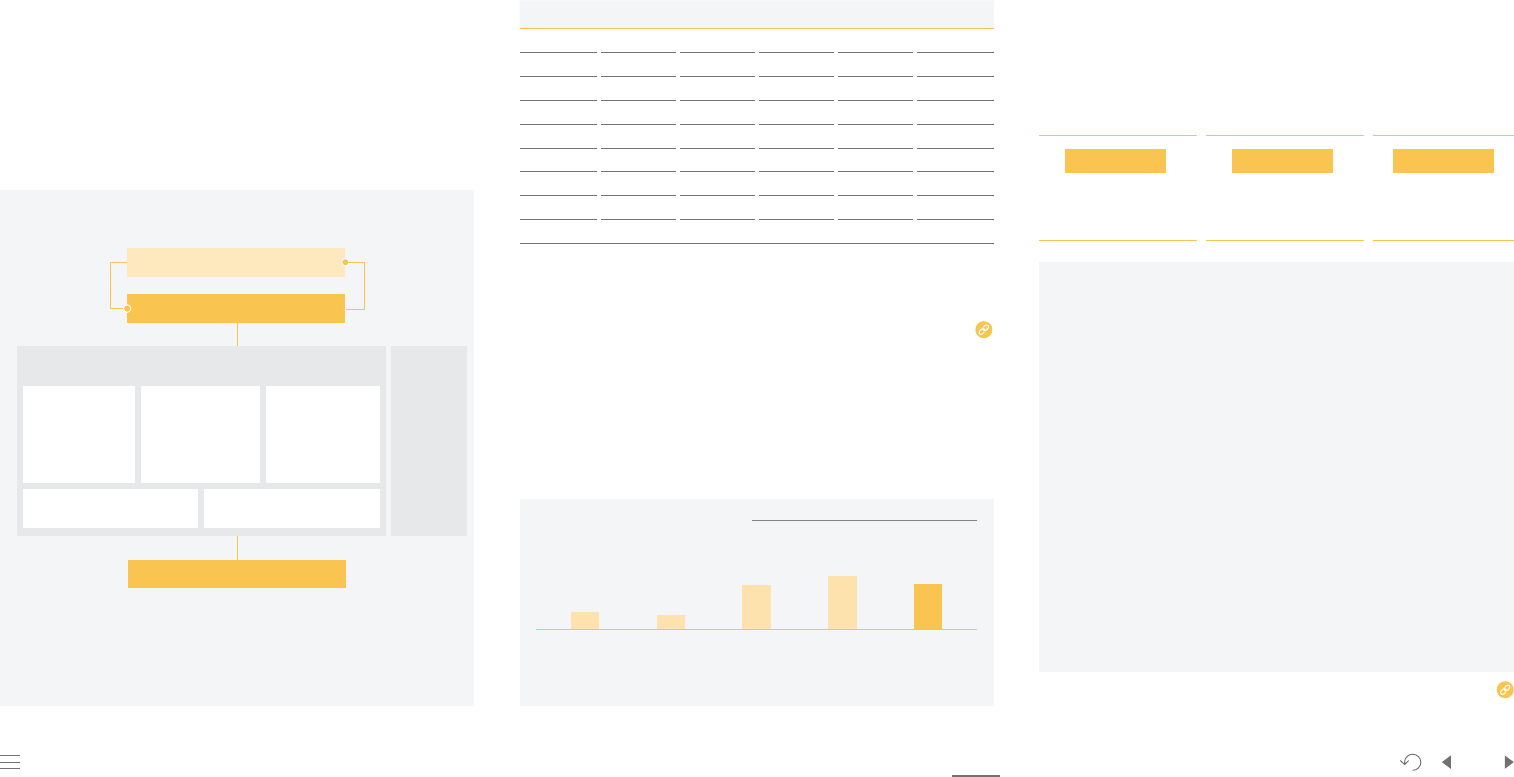
Our Company AppendixApproach to Sustainability Facts & Figures PrinciplePlanet
86
People
Samsung Electronics Sustainability Report 2023
Using the RMI’s templates on conflict and responsible minerals, including
but not limited to the Conflict Minerals Reporting Template (CMRT),
Extended Minerals Reporting Template (EMRT), and Pilot Reporting
Template (PRT), we collected data from all suppliers that we conduct
business with through our Global Supplier Relationship Management
(G-SRM) system on conflict and responsible minerals as well as other
information on smelters within the supply chain. In addition, we required
our suppliers to extend the ban on conflict minerals to their own
suppliers in accordance with our conflict minerals policy.
Responsible Minerals Management System
1) G-SRM: Global Supplier Relationship Management System
2) RBA: Responsible Business Alliance
3) RMI: Responsible Minerals Initiative
4) EPRM: European Partnership for Responsible Minerals
Clients and external stakeholders
Lower-tier suppliers and smelters
First-tier suppliers
Raising suppliers’
awareness
Inspect the Use of
Conflict-Affected and
High-Risk Minerals
in the Supply Chain
Conduct
Reasonable Due
Diligence and Verify
the Outcomes of
Inspections
Verify and Assess Risk Factors
within the Supply Chain
Develop Improvement Plans for
Risks and Report Relevant Data
G-SRM1
1)
Collab-
orative
responses
with RBA
2)
,
RMI
3)
,
EPRM
4)
,
and OECD
We internally review our suppliers’ data upon submission, perform
additional audits in relation to the submitted data, and sort suppliers
that require follow-up monitoring. In 2022, we reviewed the credibility
of data submitted by 438 suppliers around the world and their conflict
minerals policy implementation status.
* From 2020 to 2022, inspections were performed in a contact-free manner via
document review due to the COVID-19 pandemic.
438
2022
244
2018
225
2019
427
2020
493
2021
Number of On-Site Inspections
(Unit: Number of cases)
* We source tantalum, tin, tungsten, and gold, which are often linked to armed conflicts,
only from RMAP-certified smelters and refiners. We plan to gradually expand this
certification requirement to other minerals in collaboration with RMI.
**RMAP is the Responsible Minerals Assurance Process developed by RMI
Number of Smelters and Refiners within Our Supply Chains
Category 2018 2019 2020 2021 2022
Tantalum 40 40 38 38 36
Tin 73 76 53 55 59
Tungsten 41 41 42 40 39
Gold 104 104 107 107 99
Cobalt - 30 27 35 42
Mica - - - 10 19
Lithium - - - 16 11
Copper - - - - 33
Nickel - - - - 22
Through such efforts, we are able to screen out conflict minerals
illegally mined from 10 African countries including the Democratic
Republic of the Congo and only use minerals sourced from smelters
certified by globally recognized third-party accreditation entities. In
addition to conflict minerals, we continually monitor minerals that
entail human rights violations and environmental destruction issues
during the mining process and take necessary steps in cooperation
with other global organizations.
Responsible Minerals Partnerships
We aim to prevent and address any adverse social and environmental
impacts of our supply chains by sourcing minerals in a responsible
manner. To this end, we collaborate with global companies and
stakeholders in an array of campaigns, including the initiatives for
building a responsible minerals management system and standardizing
smelter accreditation.
Cobalt for Development
‧ We undertook the project to enhance the work environments of
artisanal cobalt mines and the living conditions of local mining
communities in the Democratic Republic of the Congo.
‧ The project was initiated in 2019 together with Deutsche
Gesellschaft fur Internationale Zusammenarbeit (GIZ), Samsung
SDI, BMW Group, and BASF.
‧ Volkswagen joined the project as a new partner in 2020.
‧ Key activities (as of 2021)
- Performed safety training for over 1,000 miners from 14
cooperatives
- Provided protective gear including helmets
- Conducted agricultural and financial training for more than
3,000 local residents
- Supported the foundation of 72 microbusinesses such as
bakeries and tailors
(Responsible Minerals
Initiative)
(European Partnership for
Responsible Minerals)
(Cobalt for
Development)
RMI EPRM C4D
Responsible Minerals
Responsible minerals refer to those mined in a way that respects
human rights and the environment and fulfills social responsibility.
We strive to eradicate human rights violations, such as child labor and
sexual violence, during the mining process and to protect the health
and safety of miners.
Our Responsible Minerals Management
We focus on raising awareness of responsible minerals issues,
conducting inspections on the status of responsible minerals use,
and identifying and remedying risk factors in relation to all of our
mass-produced materials suppliers based on the OECD Due Diligence
Guidance* for Responsible Supply Chains of Minerals from Conflict-
Affected and High-Risk Areas. We block the inflow of materials that are
not sourced in compliance with our responsible minerals policy from
the initial point of purchase.
* OECD Due Diligence Guidance for Responsible Supply Chains of Minerals from
Conflict-Affected and High-Risk Areas
Responsible Minerals Report 2023
List of smelters and refiners
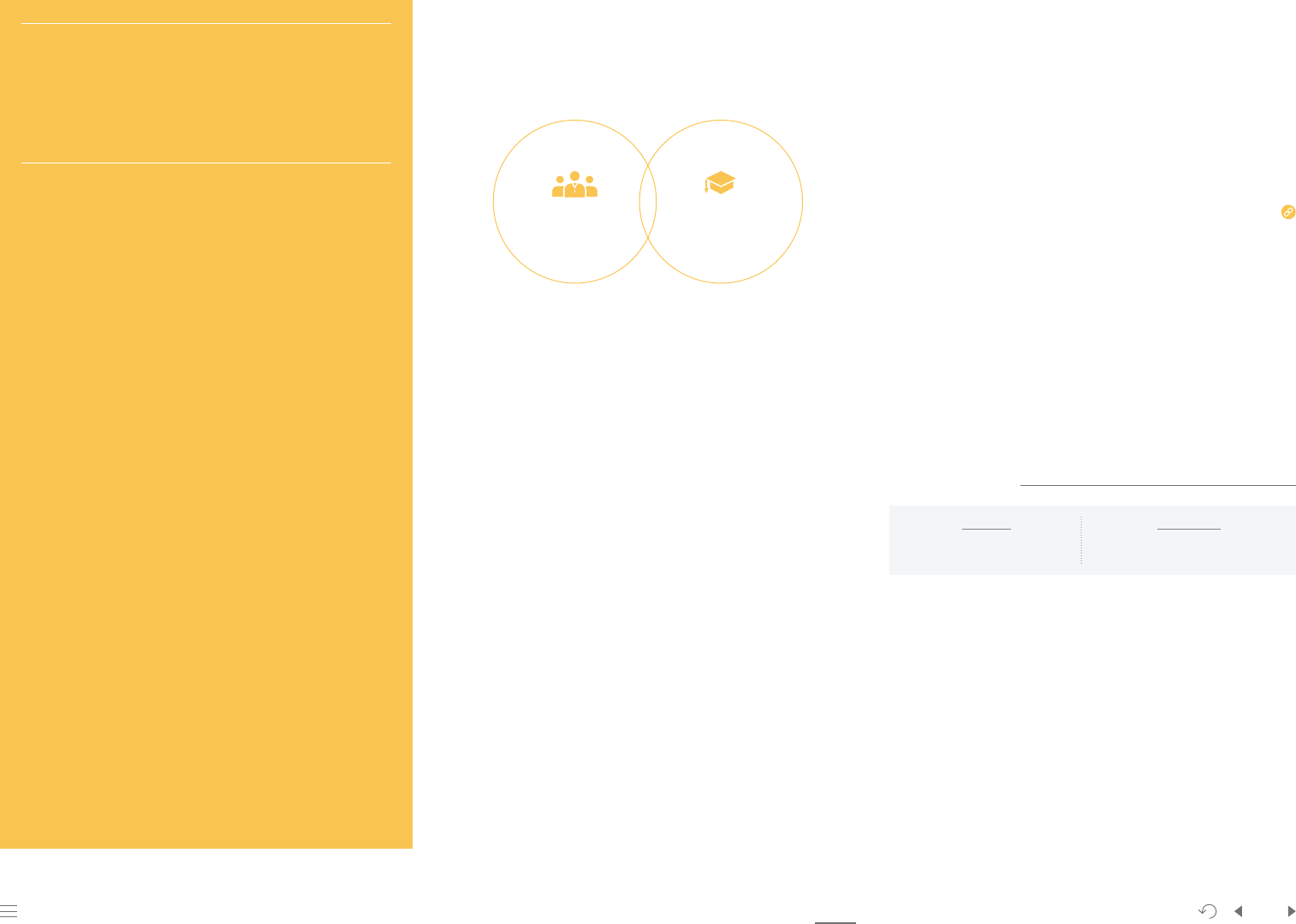
Our Company AppendixApproach to Sustainability Facts & Figures PrinciplePlanet
87
People
Samsung Electronics Sustainability Report 2023
Our CSR Activities
Education for Future Generations
We strive to empower young minds to drive innovation and positive
social change. We capitalize on our technology, knowledge, expertise,
and resources to help them develop future skills which include
technical skills as well as soft skills such as creative-thinking, curiosity,
and empathy. Moreover, we partner with government institutions and
organizations to provide education programs around the world.
Enhancing Creative Problem-Solving Capacity
Samsung Solve for Tomorrow
Samsung Solve for Tomorrow is an idea contest for youth designed
to advance their STEM (Science, Technology, Engineering and Math)
competencies and creative problem-solving skills required for
the future workforce. Teachers and mentor students of Samsung
employees on identifying the root causes of problems, finding viable
solution, and turning these ideas into action. In 2022, we provided a
total of KRW 20.5 billion in funding to Samsung Solve for Tomorrow.
Mission
Through our education programs, we aim to empower the youth to
drive positive social changes. The youth have unlimited potential – the
kind that may break new grounds and leave a mark in history. We help
young talents realize their full potential by equipping them with the
skills for the future workforce.
Core Values
Samsung follows a simple business philosophy: to devote its talent and
technology to creating superior products and services that contribute
to a better global society. At the core of this philosophy lies our focus
on people; thus the cultivation of talent has been our key to success.
Our CSR vision centers on Samsung’s values of People and
Coprosperity. The aim is to help individuals realize their potential to
the fullest, especially young minds that will become future leaders. We
utilize our knowledge and knowhow in technology and innovation to
provide greater access to opportunities for all.
Total Beneficiaries
countries
55
participants
250,304
Corporate Social Responsibility (CSR)
Under Samsung’s CSR vision of “Together for Tomorrow! Enabling
People”, we strive to provide equal access to education for the youth.
Together for
Tomorrow!
Enabling People
Education
for Future
Generations
ThemeVision
We announced our CSR vision “Together for Tomorrow!
Enabling People” in celebration of our 50
th
anniversary
in 2019. This vision is aligned with Samsung’s core values
of “People”, “Shared Prosperity”, and “Catalyzing Change ”
and reflects our commitment to fostering talents and
building a better world.
Empowering
Communities
CSR website

Our Company AppendixApproach to Sustainability Facts & Figures PrinciplePlanet
88
People
Samsung Electronics Sustainability Report 2023
Clean Water for Rural Communities (Brazil)
Three young friends living in Sao Paulo, Brazil, learned at school that the
use of pesticides at coffee plantations had continued to increase and
was polluting nearby water resources threatening the future of local
ecosystems. Seeking solutions, these students developed Macafiltro,
which purifies polluted water using macauba fruit commonly found in
the region. As the water supplied to rural communities typically does not
undergo any purification process, Macafiltro is attached to water supply
pipes to purify water as it flows to each household.
OUR CASE
Participant (Indonesia)
Ridwan applied for Samsung Innovation Campus on his teacher’s
recommendation after graduating from vocational high school. Although he
had no previous experience or knowledge in IT, he succeeded in developing a
website in cooperation with his team members over the course of just a few
months. He takes pride in helping many others resolve diverse issues through
this website. He was hired as an intern upon completing Samsung Innovation
Campus and plans to create an app with the design team.
OUR CASE
Participant Interview
"Working to solve the program’s tasks, we learned how to operate as a
team, with each of its members having a clearly defined role. It was also
a great opportunity for me to acquire new skills, such as communicating,
attracting new partners, and securing the funds needed to build a
prototype of the solution we proposed. I could also draw upon the
experience of other teams, including those with an international make-up.
I strongly recommend participation in Solve for Tomorrow for my peers, as
the entire undertaking is a great intellectual adventure."
Victoria Stanisławska
Runner-up in Samsung Solve for Tomorrow Poland (2021-2022)
On Forbes magazine’s list of “23 women worth following in 2023”
Staff Interview
"In a fast-paced world, the young generation is hungry to learn new things
and adapt to endless possibilities. Watching the young students absorb
knowledge so quickly never ceases to amaze me. What we need to do is give
the youth opportunities that will help them discover their passion. We truly
believe in their remarkable potential to reach new heights of innovation and
to develop life-changing solutions. We hope that the young generations
discover what they are interested in and get passionate about engaging
in various activities, such as Samsung Innovation Campus, to expand their
hands-on experiences and capabilities. Once you understand yourself, then
you will be able to create your plan and push toward your goal with greater
ease. We will accompany your journey towards a better future."
Asli Askin (Corporate Citizenship Manager, Samsung Electronics Türkiye)
INTERVIEW
Samsung Innovation Campus
Since 2013, we offer a range of technical training programs for adolescent students and young adults entering the job market. In 2019, we updated
and reconfigured these programs into Samsung Innovation Campus. Samsung Innovation Campus offers a range of curricula, from programming to
AI, in partnership with local education authorities, academic institutions, and civil society organizations in various countries.
Samsung Innovation Campus helps young students and adults develop skills required for IT functions such as programming, AI, IoT, and big data
through theoretical and hands-on training. It also aims to foster their soft skills such as creative thinking, communication skills, and empathy. In 2022,
we provided a total of KRW 7.8 billion in funding to Samsung Innovation Campus
Courses
countries
32
Total Beneficiaries
students
44,823
INTERVIEW
IoT
AI
Big Data
Coding and
programming
Soft skills
Workplace
capabilities

Our Company AppendixApproach to Sustainability Facts & Figures PrinciplePlanet
89
People
Samsung Electronics Sustainability Report 2023
Samsung Software Academy for Youth
Samsung Software Academy for Youth (SSAFY) was established
in December 2018, in collaboration with the Korea Ministry of
Employment and Labor. Since then, we have offered young Korean
students aspiring to become software developers a one-year program
of basic courses on algorithms, coding, and web design, and practical
training in utilizing AI, IoT, and other advanced technologies. As of now,
seven batches of 4,732 students in total have completed the program,
of which 3,857 landed jobs recording an 82% employment rate.
The SSAFY Advisory Group holds quarterly consultations with top-tier
experts in software learning, liberal arts, and CSR.
Samsung Smart School
Samsung Smart School supports schools in rural and remote areas
that lack digital educational resources with smart devices, training
solutions, learning contents, and interior remodeling. with the aim
of narrowing the regional education gap and strengthening future
skills of youth. Since 2012, we have supported a total of 193 classes at
98 schools in Korea. In 2022, we supported ten exemplary schools in
Korea selected in 2021. The program also provides faculty members
of beneficiary schools with regular training and access to external
support on utilizing smart devices. The smart devices and associated
support services are offered to the schools for up to two years.
Samsung Junior SW Academy
Samsung Junior SW Academy was launched in 2013 as part of a
partnership agreement with the Korea Ministry of Education. Since
then, we have trained teachers who are transferring their skills and
knowledge to their students at elementary and middle schools. In
2021, the program was revamped with a focus on AI. We adopt learning
contents developed jointly with AI experts in the training of teachers
and provide them with learning modules and practice-kits tailored to
young students.
Since 2015, we host the Samsung Junior SW Creation Contest inviting
young aspiring software developers to take part in deep dive trainings
and develop solutions that can drive positive social change. In 2022,
we provided a total of KRW 2.9 billion in funding to Samsung Junior SW
Academy.
Samsung Dream Class
Samsung Dream Class, which originally started as a combination of
after-school classes and vacation camps in Korea, was revamped in
2021 as a comprehensive education program built on three pillars:
career development, future skills training (e.g., global communication,
coding, math, logic), and academic curriculum. The program engages
Samsung employees and field experts as mentors. In 2022, we provided
a total of KRW 10.5 billion in funding to Samsung Dream Class.
My experiences at SSAFY enabled me to take a leap as a developer
"The process of solving problems that I encountered in individual projects,
rather than the outcomes themselves, was important for me. This
experience has been directly applicable to my communication at work
and in my professional growth as a self-learning developer. I am currently
working as a front-end developer at Nexon Korea."
Lee Eun-chong
(5
th
batch of SSAFY Seoul Campus, currently working at Nexon Korea)
INTERVIEW
Total Beneficiaries
students
43,012
teachers
708
Total Beneficiaries
middle school students
3,897
college students
500
Total Beneficiaries
school
10
classes
10
"Parents are highly satisfied as they can follow up with their children’s
progress at home. This program also works to bring parents and children
closer together as children teach their parents how to use different smart
devices. Digital classes can be easily set up based on the guide and video
materials provided by this program. I intend to continuously improve my
classes by exchanging effective teaching methods with my faculty peers."
Teacher at Cheongsong Elementary School
"Since 2012, Samsung Smart School has contributed to expanding access
to quality education and innovative training models based on its advanced
digital training system aimed at serving marginalized communities in
Korea. It has motivated an increasing number of students to engage in
self-led learning. The program was benchmarked by the government
in its smart education environment policy and is among the education
programs most preferred by school teachers."
Samsung Smart School Advisory Professor
INTERVIEW
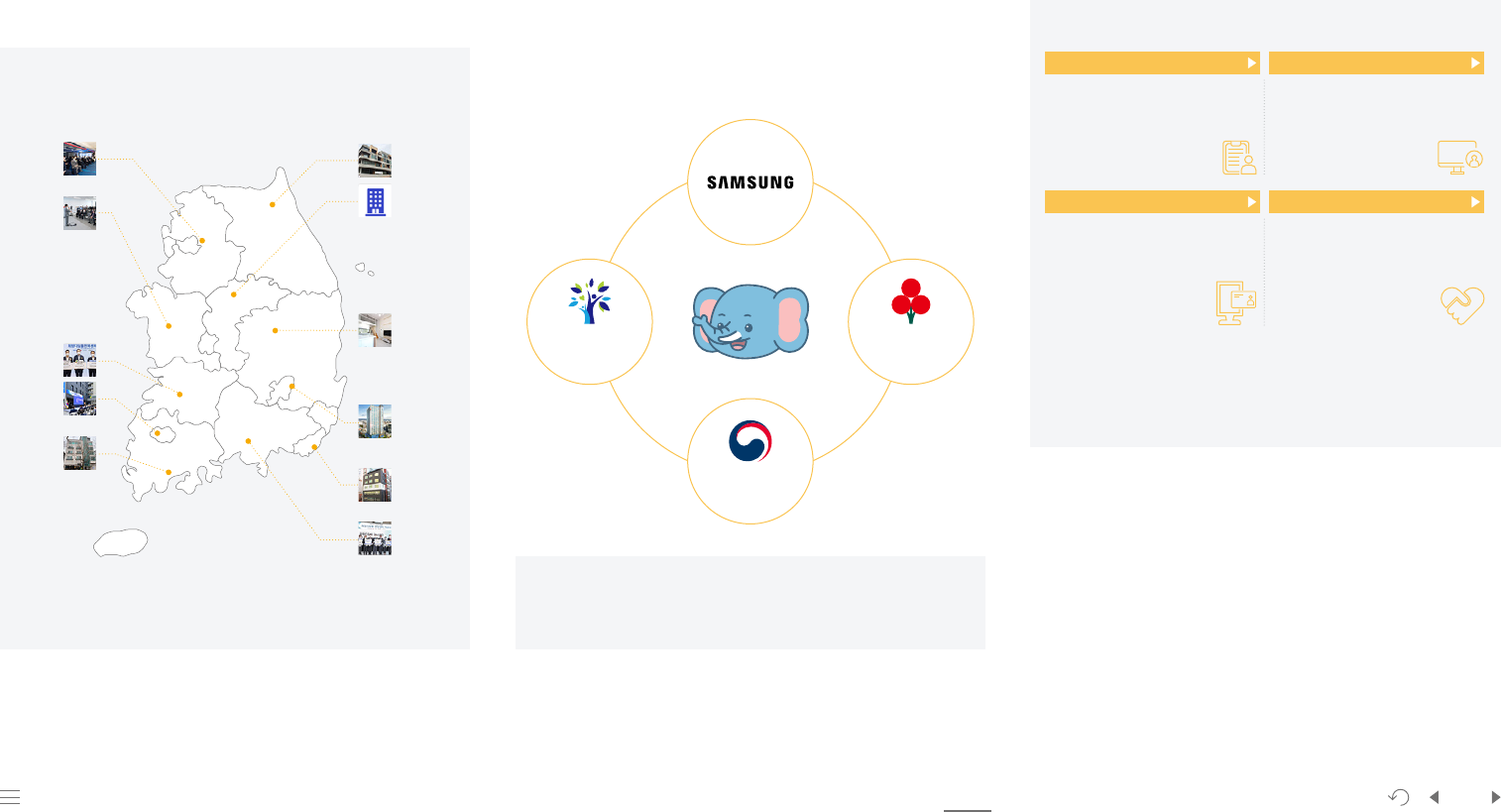
Our Company AppendixApproach to Sustainability Facts & Figures PrinciplePlanet
90
People
Samsung Electronics Sustainability Report 2023
Blue Elephant
Blue Elephant is a cyber-violence prevention program in Korea targeting
the youth, launched in partnership with the Blue Tree Foundation.
Sessions on developing prosocial behaviors and skills that help prevent
cyber violence are held in-person at the beneficiary schools.
The program induces behavioral change of young students through
rehabilitation services, including professional counselling, and strives
to foster a culture of non-violence through awareness-raising contents
and campaigns targeting all corners of society. It also supports
research on addressing the root cause of cyber violence and efforts
to develop institutional frameworks to prevent and respond to cyber
violence. In 2022, we provided a total of KRW 1.1 billion in funding to the
Blue Elephant program.
Kiosk of Sharing
The Kiosk of Sharing is designed to encourage donations by our
employees for underprivileged children. KRW 1,000 is donated every
time an employee ID card is tagged to a kiosk installed on site. When
donations reach the targeted amount, they are delivered to children of
vulnerable demographic groups. The Kiosk of Sharing is installed at all
business sites in Korea as of 2022 and has grown in global presence since
2019 currently active in Vietnam, India, China, Thailand, and the US.
Blue Tree
Foundation
Community
Chest of Korea
Ministry of
Education
Number of training sessions in 2022
308,941
sessions
Stepping Stone of Hope
Stepping Stone of Hope provides a residence for adolescents in Korea
who are forced to leave protective care facilities at the age of 18 due to
the nationally-set age limit. These facilities are provided to individuals
for up to two years, through partnerships with local governments
and civil society organizations. During their residence, independence
training and information on employment opportunities are provided
to help the young individuals stand on their own feet. In 2022, we
provided a total of KRW 6.5 billion in funding to the Stepping Stone of
Hope program.
Stepping Stone of Hope Centers
Gyeonggi
Chunanam
Jeonbuk
Gwangju
Jeonnam
Kiosk Donation System
· In Korea: KRW 950 million collected, 38,000 employees involved, and
340 children sponsored in 2022
· Global: KRW 100 million collected and 36,000 employees involved in 2022
* scheduled to open in
November 2023
Gyeongnam
Busan
Daegu
Gyeongbuk
Gangwon
Chungbuk*
1
Selecting children and teenagers
to be sponsored in individual
regions
3
Initiating fundraising (donations
made by tagging the employee ID
card)
2
Posting the stories of children to be
sponsored on kiosks
4
Delivering donations to sponsored
children after reaching the target
amount
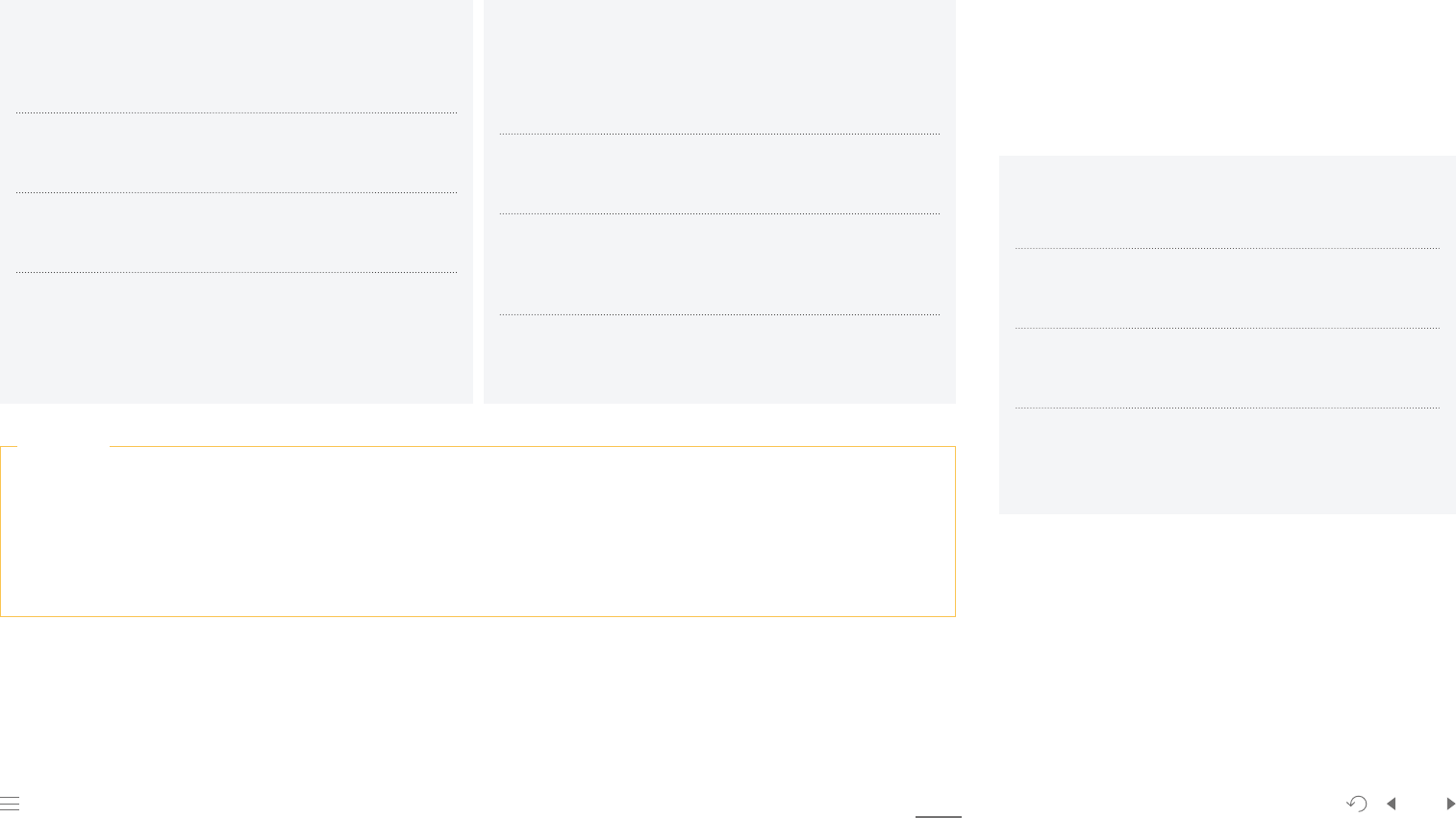
Our Company AppendixApproach to Sustainability Facts & Figures PrinciplePlanet
91
People
Samsung Electronics Sustainability Report 2023
SME & Startup Support
We help robust SMEs(Small and Medium Enterprises) and creative startups reach new heights by sharing our knowledge and expertise.
Smart Factory
200 of Samsung’s experts in a variety of fields, including quality assurance, logistics, and molding, work with SMEs at their sites and share their
knowledge and knowhow in establishing production systems and automation solutions and advancing production innovation through technology.
We supported a total of 3,087 SMEs in Korea from 2015 to 2022.
Creative Lab (C-Lab)
We operate C-Lab to develop innovative ideas into business
opportunities and contribute to bolstering the Korean startup
ecosystem.
As of February 2023, we have supported a total of C-Lab 856 startups
(391 in-house and 465 external) – of which 526 (465 from C-Lab Outside
and 61 from C-Lab Spinoff) secured a total of KRW 1.36 trillion in
cumulative investment amount.
C-Lab Spinoff
C-Lab Spinoff is designed to select projects with high growth potential
among those cultivated through C-Lab Inside, our in-house venture
program, and support them to become fully-fledged startups.
Smart Factory Support
Dong-A Plating headquartered in Busan specializes in surface processing, a key sector in manufacturing. Surface processing was one of the 3D (dirty, difficult,
and dangerous) industries shunned by young job seekers as it requires the use of chemicals such as hydrochloric acid and nitric acid. We helped Dong-A Plating
introduce a system for real-time data-based management of chemical use history and equipment conditions and achieve automation of dangerous and difficult
tasks to ensure the safety of workers. As a result, the company’s productivity increased by 37%, the defection rate improved by 77%, and the number of accidents
went down to zero. We plan to support Dong-A Plating to develop its smart factory system into an intelligent factory system.
OUR CASE
Enhancing Manufacturing Capacity
Smart Factory Solutions
Providing solutions for factory operation, manufacturing automation, process
simulation, ultra-precision processing, among others
Manufacturing Innovation
Transferring knowhow on site by dispatching a team of three to ten innovation
experts to each SME for eight to ten weeks
Technological Support
Offering technologies that are difficult for SMEs to develop or secure on their
own, including molding, processing, automation, and element technologies.
Intelligent Advancement
Providing consistent level-specific support to ensure data-based real-time
communication and supporting smart factory establishment to analyze,
project, and control data through the AI-driven system
Fostering Self-Sustainability
Marketing Channel Development
Participating in exhibitions to explore business opportunities, producing
and distributing promotional videos in 105 countries, becoming a vendor on
Samsung’s online mall for employees
Talent Cultivation
Fostering smart factory specialists, offering job-specific training, and
providing opportunities to benchmark our Gwangju business site
ESG Support
Facilitating sustainability management by creating a safe work environment,
reducing energy consumption, and introducing environmentally responsible
materials.
Ex-Post Management
Operating the Smart 365 Center, providing maintenance and repair services
as well as upgrades
Types of Support
Funding
Seed funding and other financial support
Stabilization Support
Pre-spinoff training and business mentoring to support early-stage
stabilization
Marketing Channel Development
Opportunities to become a vendor on Samsung’s online mall for employees
as well as its official e-commerce platform in Korea
Reemployment Opportunities
Founder employees are given the option to re-join the company within
a preset period of time, which enable them to take on new challenges
without fear of failure

Our Company AppendixApproach to Sustainability Facts & Figures PrinciplePlanet
92
People
Samsung Electronics Sustainability Report 2023
C-Lab Outside
C-Lab Outside was launched in 2018 with the aim of contributing to the
startup ecosystem in Korea by sharing our experiences and knowhow
from C-Lab Inside.
Social Ventures
We have supported social ventures via the C-Lab program since 2018.
Strengthening the Regional Startup Ecosystem in Korea
We opened C-Lab Outside Daegu Campus at the Samsung Creativity Campus
in Daegu in February 2023. The Campus is an extension of our startup
acceleration program launched in 2018 to foster outstanding startups in the
region. We have offered necessary infrastructure, which is in short supply
compared to the Seoul metropolitan area, in collaboration with the Daegu
and Gyeongbuk Center for Creative Economy and Innovation and helped
launch 185 startups in the area over the past 8 years.
These startups have recorded KRW 570 billion in sales, attracted new
investments totaling KRW 280 billion, and hired 2,400 new employees,
contributing to the local economy and employment. Some of these
startups have also participated in the Consumer Electronics Show
(CES) with us and won seven awards in recognition of their innovative
achievements.
OUR CASE
Waddle Barrier-free online shopping platforms and
solutions
Dot Incorporation Smart technology enhancing
accessibility to invisible information
Marine Innovation Environmentally responsible
packaging manufacturing solutions
based on seaweed byproducts
Cellico AR-based implantable electronic eyes for
the visually-impaired
RE:harvest Food upcycling solutions based on beer
brewing byproducts
Petnow AI-based pet biometric ID service using
smartphones
Silvia Contact-free cognitive healthcare platform for
the early diagnosis and prevention of dementia
Cosmos Effect Mobile pet registration service
DoBrain AI-based brain development diagnosis and
education solution for infants
2018
2019
2020
2021
Types of Support
Funding
Financial support of up to KRW 100 million without acquiring a stake
Infrastructure
Office spaces and meals within our business sites and access to commuter
shuttles
Mentoring and Consulting
Tailored programs in user verification, finance, marketing, and promotion
Supporting Growth
Participation in global and domestic IT exhibitions (e.g., CES)
and Demo Day events
Collaboration
Business collaboration opportunities with Samsung
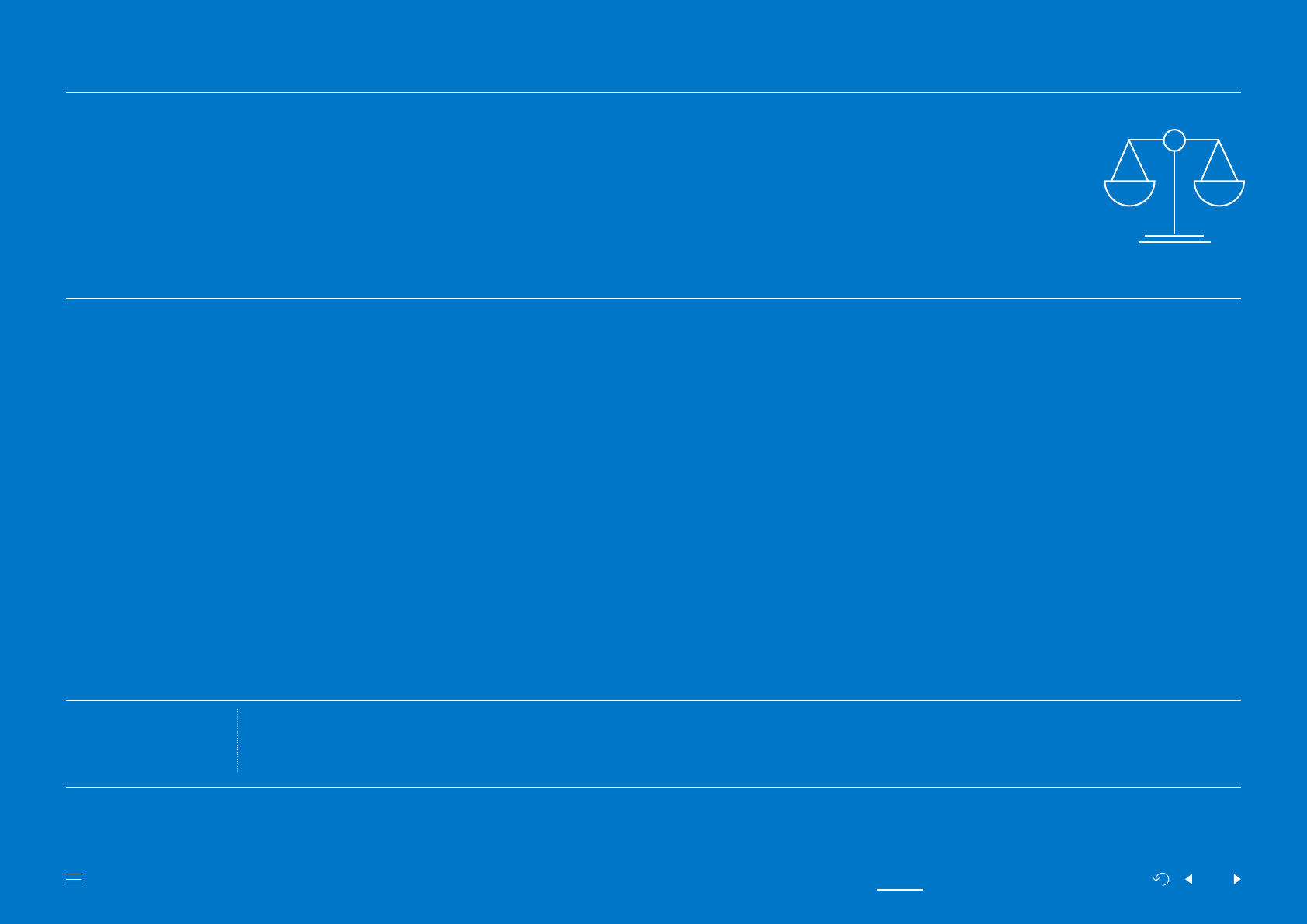
Our Company AppendixApproach to Sustainability Facts & Figures PrinciplePlanet
93
People
Samsung Electronics Sustainability Report 2023
Principle
94
Corporate Governance
97
Compliance & Ethics
Our Company AppendixApproach to Sustainability Facts & Figures PrinciplePlanet
93
People
Samsung Electronics Sustainability Report 2023

Our Company AppendixApproach to Sustainability Facts & Figures PrinciplePlanet
94
People
Samsung Electronics Sustainability Report 2023
Corporate
Governance
Board Composition
The Board consists of a minimum of three to a maximum of 14 members, pursuant to Article 24 of the Articles of Incorporation. We recognize the
increasing importance of the Board’s diversity and expertise, and therefore strive to ensure a diverse composition of the Board of directors in terms of
race, gender, religion, place of origin, nationality, among others. In particular, independent directors are selected on the basis of their expertise in finance,
law, IT, public administration, or sustainability, regardless of their nationality or gender. Independent directors bring diverse perspectives to the Board in
order to find optimal solutions and offer professional oversight and advice to the executive management. The Board consists of 11 members including six
independent directors.
Name
Jong-hee
Han
Kye-hyun
Kyung
Tae-moon
Roh
Hark-kyu
Park
Jung-bae
Lee
Han-jo
Kim
Sun-uk
Kim
Jong-hun
Kim
Jun-sung
Kim
Eun-
nyeong
Heo
Myung-
hee
Yoo
Executive
Directors
Independent
Directors
Gender
Male
Male
Male
Male
Male
Male
Female
Male
Male
Male
Female
Nationality
Republic of
Korea
Republic of
Korea
Republic of
Korea
Republic of
Korea
Republic of
Korea
Republic of
Korea
Republic of
Korea
USA
Singapore
Republic of
Korea
Republic of
Korea
Position
Chair, Management
Committee
· Member, Management
Committee
· Member, Management
Committee
· Member, Management
Committee
· Member, Management
Committee
· Chair, Board
· Chair, Audit Committee
· Chair,Sustainability Committee
· Member, Related Party
Transactions Committee
· Member, Compensation Committee
· Chair, Rel ated Par ty Trans actions
Committee
· Chair, Independent Director
Recommendation Committee
· Member, Sustainability Committee
· Chair, Compensation Committee
· Member, Audit Committee
· Member, Related Party
Transactions Committee
· Member, Sustainability Committee
· Member, Compensation
Committee
· Member, Sustainability
Committee
· Member, Independent Director
Recommendation Committee
· Member, Sustainability
Committee
· Member, Independent Director
Recommendation Committee
· Member, Sustainability
Committee
Date of
appointment
March 18,
2020
March 16,
2022
March 16,
2022
March 16,
2022
March 16,
2022
March 20,
2019
(serving a
second term)
March 23,
2018
(serving a
second term)
March 23,
2018
(serving a
second term)
March 16,
2022
November 3,
2022
November 3,
2022
Date of
completion
March 17,
2026
March 15,
2025
March 15,
2025
March 15,
2025
March 15,
2025
March 19,
2025
March 22,
2024
March 22,
2024
March 15,
2025
November
2, 2025
November
2, 2025
Area of
specialty
DX Division
DS Division
MX Business
Corporate
Management
Memory
Business
Finance and
CSR
Law and
Human
Rights
IT and
Business
Operation
Finance and
Investment
Environment
and Energy
International
Trade
Career highlights
CEO and Vice Chairman, Samsung Electronics
Head, DX Division, Samsung Electronics
CEO and President, Samsung Electronics
Head, DS Division, Samsung Electronics
President and Head, MX Business,
Samsung Electronics
President and Head, Corporate Management
Office, Samsung Electronics
President, Memory Business,
Samsung Electronics
Chairman, Hana Nanum Foundation
Former Vice Chairman, Hana Financial Group
Professor Emeritus, School of Law,
Ewha Womens University
Former Minister, Ministry of Government
Legislation
Executive Chairman, Kiswe Mobile
Former President, Alcatel-Lucent Bell Labs
CIO, Endowment Fund,
National University of Singapore
Former Managing Director, Government of
Singapore Investment Corporation (GIC)
Professor, College of Engineering,
Seoul National University
Former Vice Chairman, International
Association of Exhibitions and Events (IAEE)
Visiting Professor, Graduate School of
International Studies, Seoul National University
Former Head, Office of Trade Negotiations,
Ministry of Trade, Industry and Energy
Our corporate governance ensures that the
executive management is effectively monitored by
independent directors who have diverse expertise
and can remain objective. Responsible management
practices are implemented by the Board with
the heads of DX, DS, and all major business units
participating as executive directors.
Environmental, social, and governance issues
are overseen by the Sustainability Committee
– established through a restructuring of the
Governance Committee – under the Board.

Our Company AppendixApproach to Sustainability Facts & Figures PrinciplePlanet
95
People
Samsung Electronics Sustainability Report 2023
Board Principles
In 2018, we separated the Chair of the Board and CEO positions to increase
the independence and transparency of the Board. In February 2020, an
independent director was appointed as the Chair for the first time. In March
2023, an independent director was appointed as the new Chair.
The Chair balances different views serving as a mediator among
Executive Directors and Independent Directors to ensure objectivity in
the Board’s oversight of the executive management. Additionally, the
independent directors hold meetings to share their views on enhancing
shareholder value and on the overall business management.
Independence
Those engaged in our business management, holding shares or significant
interest in the company, or have been employed by the company within
the last two years are not eligible for independent directorships.
Transparency
Executive directors shall be appointed from the candidates recommended
by the Board. Candidates for independent directors shall be recommended
by the Independent Director Recommendation Committee, which is
composed of independent directors only.
Expertise
Independent director candidates are selected among those with
knowledge and experience in business management, economics,
accounting, law, technology, and sustainability management.
Diversity
The selection of independent director candidates is based on their
potential ability to bring diverse and independent perspectives to the
Board and is not limited by a candidate’s nationality, gender, place of
birth, religion or area of expertise.
Appointment of Directors
Directors are appointed by the resolution of shareholders at the
general shareholders meeting in accordance with Article 382 of
Korea's Commercial Act. Executive directors are selected among the
candidates recommended by the Board, while independent directors
are selected among the candidates recommended by the Independent
Director Recommendation Committee pursuant to Article 542-8 of the
Commercial Act.
The same Article stipulates that majority of an Independent Director
Recommendation Committee must consist of independent directors.
Our Independent Director Recommendation Committee consists only
of independent directors and strictly abides by the preset candidate
recommendation procedures. Each director’s term of office is three years.
A director may be reappointed through the general shareholders meeting
upon completion of the initial term. However, an independent director’s
total term is limited to six years pursuant to the Commercial Act.
Board Operation
Board Convocation
To convene a Board meeting, the Chair notifies each director of the
date, time, venue, and agenda at least 24 hours prior to the meeting
pursuant to Article 30 of the Articles of Incorporation and Article 8 of
the Board of Directors Regulations.
Individual directors are entitled to request the Chair to convene a
Board meeting, with the agenda and reasons clearly defined, if deemed
necessary. If the Chair fails to uphold this responsibility without a
justifiable reason, the respective director may directly convene a Board
meeting.
Board Resolution
Pursuant to Article 31 of the Articles of Incorporation and Article 9
of the Board of Directors Regulations, an agenda item is deemed to
have been resolved with the attendance of a majority of the directors
and a majority vote of the attendees unless otherwise prescribed in
relevant laws. As specified in Article 391 of the Commercial Act, all
directors may participate in a Board meeting digitally using remote
telecommunications devices capable of simultaneous voice transmission
and reception.
We systematically avoid potential conflicts of interest by restricting
the voting rights of those directors with special interests related to
certain agenda items pursuant to Article 9 of the Board of Directors
Regulations.
Board Evaluation
Independent directors are evaluated comprehensively across their
Board activities based on our internal criteria. Qualitative and
quantitative evaluations are conducted based on their meeting
attendance rates, performance as individual committee members,
level of expertise, understanding of material issues, and efforts to
ensure independence. The evaluation results are used to innovate
Board operations and enhance the efficiency and composition of the
Board and its affiliated committees.
Committees under the Board
The Board delegates its authorities to six affiliated committees
pursuant to Article 28-2 of the Articles of Incorporation and Article 11-2
of the Board of Directors Regulations to ensure greater efficiency in its
operation. In July 2021, we restructured the Governance Committee
into the Sustainability Committee, composed of only independent
directors to drive sustainability management in the areas of
environmental, social, and governance and enhance shareholder value.
The Management Committee comprises five executive directors
entrusted with relevant authorities to resolve general management
matters in a timely manner. The other five committees consist of only
independent directors to reinforce independence.
The composition, operation, and authorities of each committee
are specified in the individual committee regulations enacted by
the resolution of the Board. Matters resolved by the committees
are notified to all directors within two days. Directors may request
the Chairman of the Board to convene a Board meeting if deemed
necessary, and the Board may reconsider and revote on the decisions
made by each committee. However, decisions of the Audit Committee
are not subject to revote to ensure its independence.
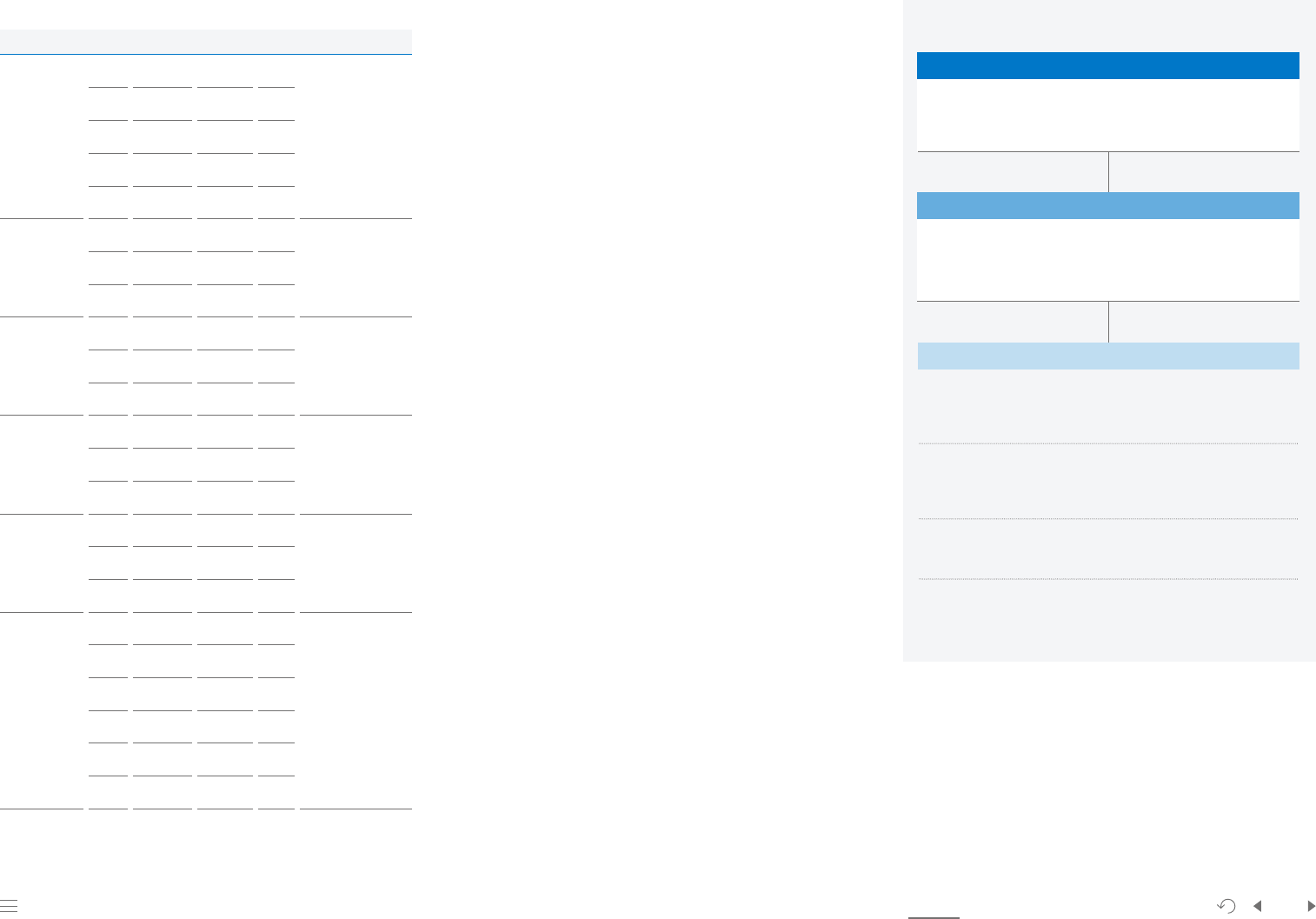
Our Company AppendixApproach to Sustainability Facts & Figures PrinciplePlanet
96
People
Samsung Electronics Sustainability Report 2023
Sustainability Governance
Samsung Electronics’ activities are supervised by the Board of
Directors, our highest decision-making body.
The Sustainability Committee drives sustainability management in the
areas of environmental, social, and governance to increase shareholder
value. The Sustainability Council, presided by the CEO, is convened
with the executives of relevant business and functional units to discuss
diverse sustainability-related issues.
The Corporate Sustainability Center, our sustainability control tower,
is responsible for establishing relevant strategies in collaboration
with relevant internal units and councils, monitoring outcomes, and
strengthening collaboration and communication with our external
stakeholders.
We also offer training for our employees to help them incorporate
sustainability into their everyday business.
The Sustainability Management Office within each business
unit establishes tailored strategies and supports their internal
implementation. Regionally-based sustainability units monitor and
identify issues of key interest to local stakeholders and develop
relevant projects.
To embed sustainability into our business, we have included
sustainability-related indicators in the performance evaluation of
organizational units and executives since 2021. The performance
metrics, depending on the area or function of the units and executives,
include indicators on GHG emissions reduction, renewable energy
transition, energy efficient product development, compliance, and
product accessibility. We plan to continue strengthening the link
between sustainability and performance management.
Board of Directors
Sets directions for sustainability management and
oversees progress and performance, both at the Board
and Sustainability Committee levels
Presided by the CEO, convened at least once per half year with
executives from relevant business and functional units to review
sustainability-related issues
Sustainability Council
Councils by Area
Planet
Environmental Management Task Force | EHS Council |
Scope 3 Task Force | Eco-Council
People (Tech for All)
Security and Privacy Protection Council |
AI Ethics Council | Accessibility Council
People (Human Rights)
Labor and Human Rights Council
Committee
Management
Committee (5)
Independent
Director
Recommendation
Committee (3)*
Audit
Committee (3)
Related Party
Transactions
Committee (3)
Compensation
Committee (3)
Sustainability
Committee (6)
Position
Chair
Member
Member
Member
Member
Member
Member
Member
Chair
Member
Member
Chair
Member
Member
Chair
Member
Member
Chair
Member
Member
Member
Member
Member
Category
Executive
Director
Executive
Director
Executive
Director
Executive
Director
Executive
Director
Independent
Director
Independent
Director
Independent
Director
Independent
Director
Independent
Director
Independent
Director
Independent
Director
Independent
Director
Independent
Director
Independent
Director
Independent
Director
Independent
Director
Independent
Director
Independent
Director
Independent
Director
Independent
Director
Independent
Director
Independent
Director
Name
Jong-hee
Han
Kye-hyun
Kyung
Tae-moon
Roh
Hark-kyu
Park
Jung-bae
Lee
Sun-uk
Kim
Eun-nyeong
Heo
Myung-hee
Yoo
Han-jo
Kim
Sun-uk
Kim
Jong-hun
Kim
Sun-uk
Kim
Han-jo
Kim
Jong-hun
Kim
Jong-hun
Kim
Han-jo
Kim
Jun-sung
Kim
Han-jo
Kim
Sun-uk
Kim
Kim
Jong-hun
Jun-sung
Kim
Eun-nyeong
Heo
Myung-hee
Yoo
Gender
Male
Male
Male
Male
Male
Female
Male
Female
Male
Female
Male
Female
Male
Male
Male
Male
Male
Male
Female
Male
Male
Male
Female
Details
*Chair position currently vacant and expected to be filled soon.
Committees under the Board
Sustainability Management
Deliberates and makes
decisions on general
management matters,
finance-related issues,
and matters delegated
by the Board
Screens and
recommends
candidates based on
their independence,
diversity, and
competence
Performs audits of
all business affairs
including financial
status
Aims to enhance
business transparency
by promoting voluntary
adherence to fair
transaction regulations
Aims to ensure
objectivity and
transparency in the
decision-making
process of director
compensation
Launched in July
2021 by restructuring
the Governance
Committee
Aims to fulfill corporate
social responsibility,
drive sustainability
management in the
areas of environmental,
social, and governance,
and increase
shareholder value

Our Company AppendixApproach to Sustainability Facts & Figures PrinciplePlanet
97
People
Samsung Electronics Sustainability Report 2023
Our Business Principles
Efforts to Ensure Compliance Management
The Compliance Team reports directly to the CEO, and the Chief
Compliance Officer attends all Board meetings and Management
Committee meetings to support decision-making. The Compliance
Team operates the Compliance Program Management System (CPMS),
an IT system that enables efficient oversight of compliance and ethics,
while managing potential risks in focus areas, such as anti-corruption,
fair trade, intellectual property rights, privacy protection, labor and
human rights, environment and safety.
Efforts to Ensure Ethical Management
Samsung Electronics, together with its partners, external stakeholders,
and employees, seeks to fulfill its roles and social responsibilities while
adhering to compliance and ethics. To this end, we have in place a set of
management principles and guidelines based on compliance and ethics.
At Samsung Electronics, compliance with
laws and ethical standards is a top priority
business principle. We conduct our business
in compliance with laws and ethical
standards to fulfill our social responsibilities
and build a sound corporate culture that is
fair and transparent.
Compliance &
Ethics
Business Principles
1.
We comply with laws and ethical standards.
2. We maintain an organizational culture of integrity.
3. We respect our customers, shareholders, and employees.
4. We care for the environment, health, and safety.
5. We are socially responsible as a global corporate citizen.
Business Conduct Guidelines for Employees
· The guidelines for our employees are posted in our intranet system in 15
languages including Korean.
· The guidelines are shared with all of our employees globally at least once a
year through offline and online training sessions.
Business Guidelines for Partner Companies
· We provide guidelines for our partner companies to ensure transparency
in transactions.
Focus areas of compliance management
Anti-corruption
Fair Trade
Environment
and Safety
Privacy
Protection
Intellectual
Property Rights
Labor and
Human Rights
Consumer
Protection
Focus Areas
of Management
Trade Subcontracting
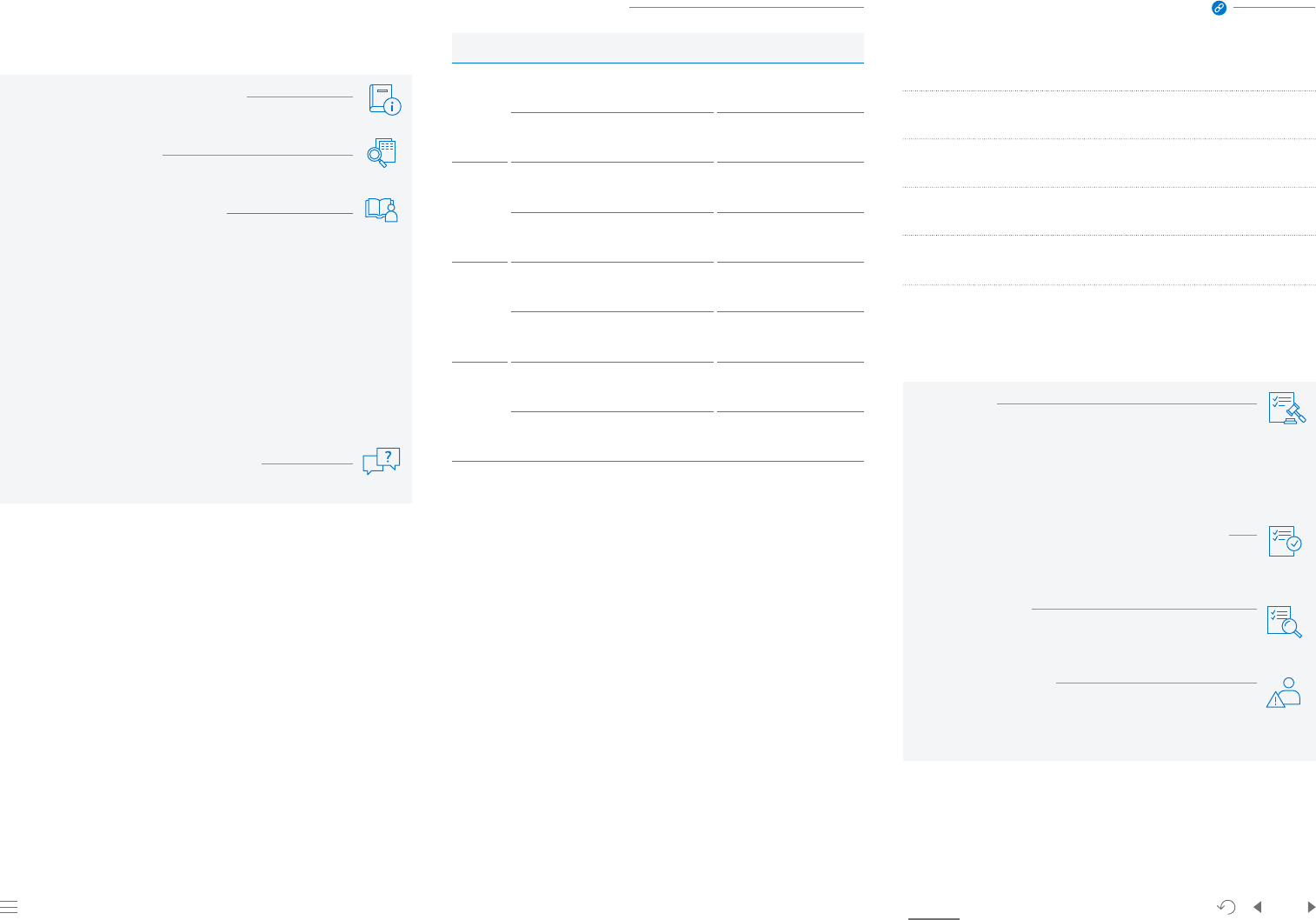
Our Company AppendixApproach to Sustainability Facts & Figures PrinciplePlanet
98
People
Samsung Electronics Sustainability Report 2023
Compliance and Ethics Programs
Prevention
Monitoring
Report results of the annual audit performed by dedicated
organizational units and specialists to the Board of Directors at
least once a year
The results of the annual compliance and ethics audit our business
sites in Korea and other regions are reported to the Board of Directors
at least once a year. Based on the results, we identify points of
improvement and reflect them in our business activities. In 2022,
we conducted audits on different areas each quarter and found
satisfactory results overall.
Receive reports on violations of laws and acts of corruption by the
company or its employees through the whistleblowing channels and
apply the principles of protecting the identity of whistleblowers and
preventing retaliatory actions against them.
We keep diverse whistleblowing channels open for internal and
external whistleblowers and receive reports via email, telephone, and
fax. All of our whistleblowing channels operate under a strict policy of
whistleblower identity protection and prohibition of retaliatory actions
– including confidentiality requirements related to whistleblower
identity and their reports, the prevention and suspension of any
unfavorable dispositions against whistleblowers and investigation
supporters, remedial actions for damage, and sanctions on those who
incur unfavorable dispositions.
Period
Description of Item Areas
Q1
Current status of confidential
information management
Trade secrets
Compliance of third-party production
in Korea and other regions
Technology leakage,
product liability
Q2
Compliance of organizations in Korea
involved in development
Trade secrets, technology
misuse
Voluntary compliance of global
subsidiaries
Compliance program
operation status
Q3
Compliance of global sales
subsidiaries
Fair trade, trade secrets
Risks related to external sponsorships
and internal transactions
Anti-corruption, fair trade
Q4
Compliance of patent
application process
Technology misuse, trade
secrets
Compliance of global
production subsidiaries
Technology misuse,
anti-corruption
Major Audit Activities in 2022 Our Compliance and Ethics Whistleblowing Channels
*Some channels are only available in Korea
Channel for internal whistleblowers
CPMS > Whistleblowing
Ethical Management website > Whistleblowing
Channel for external whistleblowers
https://sec-compliance.net https://sec-audit.com
Telephone
1811-6341 1577-7988
Email
cp.wb.sec@samsung.com audit.sec@samsung.com
Fax
031-277-1166 031-200-9966
Disclose compliance policy and guidelines
on the Compliance Program Management System (CPMS)
Monitor regulatory trends
to minimize potential non-compliance risks
Operating employee training programs
· Employee training: To emphasize the importance of Ethics and
Compliance Management to all employees – including contractual and
part-time employees – including contractual and part-time employees –
compliance and anti-corruption trainings are conducted once a year.
In addition, training on Korea’s Improper Solicitation and Graft Act is
provided to contractual administrative function employees who are
dispatched by partner companies. Training programs tailored to
specific job functions are also available.
· Executive management training: To strengthen the awareness and
leadership of the top executives, which is key to compliance and ethical
management
Compliance consultation through 1:1 sessions
Response
Assess Risks
Take stock of major violations in areas such as fair trade and
anti-corruption, and identify key risks based on the possibility
of occurrence and potential scope of impact
Incorporate the results of risk assessment into compliance programs,
such as employee training
Assessing effectiveness of our compliance control system
Assess whether our compliance control system is operated
in a way that meets relevant regulations
Prevent Recurrence
Establish measures to prevent recurrence by analyzing the
results of audits, whistleblower reports, and response to issues
Measures on employees
Impose disciplinary or corrective measures, including training,
pursuant to our internal standards based on the gravity of the
specific incident
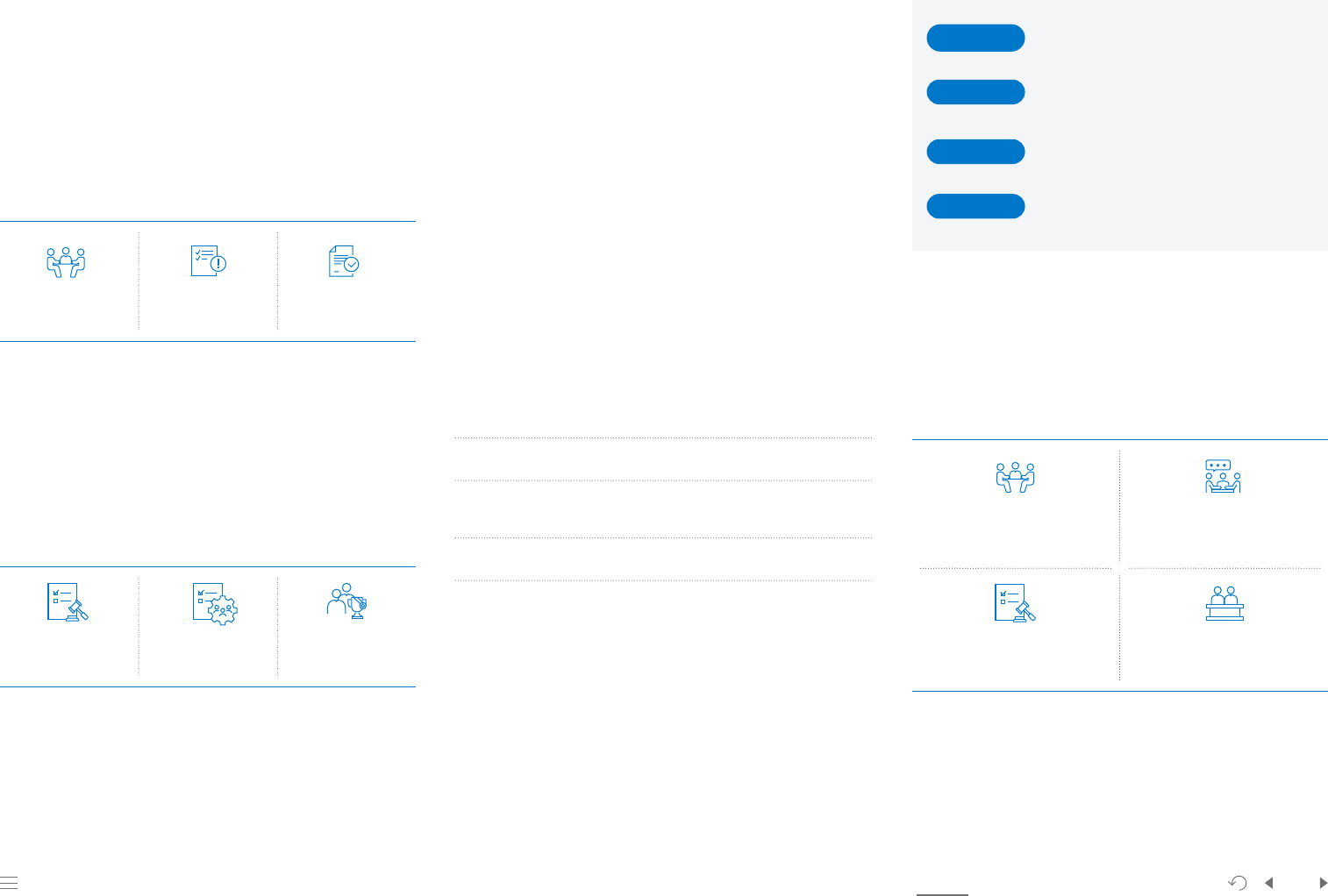
Our Company AppendixApproach to Sustainability Facts & Figures PrinciplePlanet
99
People
Samsung Electronics Sustainability Report 2023
Samsung Compliance Committee
An Independent External Committee to Monitor Compliance
The Samsung Compliance Committee is an external organization with
guaranteed independence and autonomy. It was launched in on February
5, 2020, under the aim of practicing integrity-based management,
which is one of our key values, by reinforcing compliance monitoring and
control over Samsung’s seven major member companies*.
It is composed of six external members including the chair and one
internal member. Chan-hee Lee, a former president of the Korean Bar
Association, currently serves as the second chair following the first
chair, Ji-hyung Kim, who is a former justice of the Supreme Court of
Korea. The Committee’s external members are selected from experts
equipped with knowledge and experience in diverse fields including
law, accounting, economics, and public administration.
* Samsung Electronics, Samsung C&T, Samsung SDI, Samsung Electro-Mechanics,
Samsung SDS, Samsung Life Insurance, and Samsung Fire & Marine Insurance
Key Activities of the Committee
❶
Hold regular and special meetings
❷
Review external sponsorships and internal transactions
❸
Operate a separate whistleblowing channels to receive reports on
compliance violations
❹
Assess our compliance system and make recommends for improvement
Implementation of the Committee’s Recommendations
The Committee delivers recommendations on a range of issues
to improve the compliance management practices of Samsung
member companies. We have developed measures to ensure their
implementation. We continue to work in collaboration with the
Committee to operate an advanced monitoring program and compliance
system and closely manage potential non-compliance risks.
Other Activities
November 2022
· Meeting with Business Support Task Force, EPC
Competitiveness Improvement Task Force, and
Financial Competitiveness Reinforcement Task Force
June 2022
· Meeting between the Committee’s Labor
Subcommittee and the labor-management
relations advisory group
June 2022
· Meeting with the executive management of
Samsung member companies
January 2022
· Discussion with external experts on ways to
improve corporate compliance
Strengthening a Culture of Compliance
Corruption Risk Review Process
The External Sponsorship Council conducts a preliminary review of
all external sponsorships of KRW 10 million or above and reports the
review results to the Audit Committee. External sponsorships of KRW 1
billion or above in annual amount require the approval of the Board of
Directors.
Furthermore, approval from the Compliance Team is required for
new vendor registration and signing of contracts in line with the anti-
corruption review process.
Evaluation and Awards
To foster a culture of compliance, we strive to improve the evaluation
system of employees and operate an award system. We have increased
the weight of compliance items in the evaluation of executives and
introduced compliance items in the evaluation of organizational
performance. Moreover, SEC Annual Awards are presented by the CEO
to employees and organizations for their contributions to building a
culture of compliance.
External Sponsorship
Council
Anti-Corruption Review
for Vendor Registration
Anti-Corruption Review
for Contract Signing
Executive Evaluation
Organizational
Performance Evaluation
Employee Awards
Formed a labor-management
relations advisory group of external
experts under the Board of Directors
Increased the weight of compliance-
related factors in the evaluation of
executives
Held a conference between senior
members of civil society organizations
and our executive management
Formed a regular council of Chief
Compliance Officers of member
companies

Our Company AppendixApproach to Sustainability Facts & Figures PrinciplePlanet
100
People
Samsung Electronics Sustainability Report 2023
Facts & Figures
113
Sustainability Value
Creation
101
Economic
Performance
102
Social
Performance
108
Environmental
Performance
112
Performance
by Division
114
Materiality
Assessment
116
Alignment with
UN SDGs
Our Company AppendixApproach to Sustainability Facts & Figures PrinciplePlanet
100
People
Samsung Electronics Sustainability Report 2023
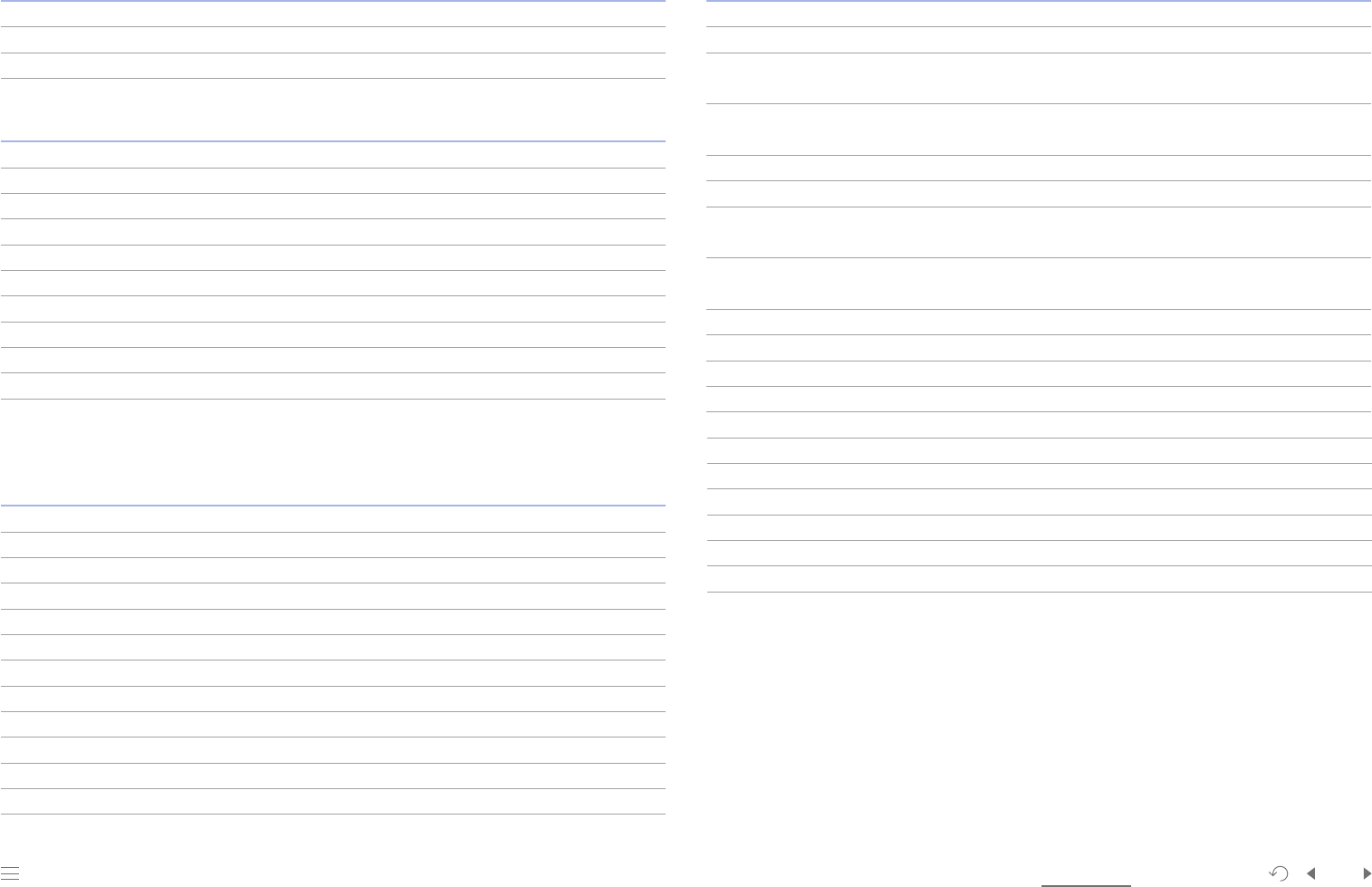
Our Company AppendixApproach to Sustainability Facts & Figures PrinciplePlanet
101
People
Samsung Electronics Sustainability Report 2023
Economic Performance
Key financial performance 2020 2021 2022
Sales KRW 1 trillion 236.8 279.6 302.2
Operating profit KRW 1 trillion 36.0 51.6 43.4
Net income KRW 1 trillion 26.4 39.9 55.7
1. Based on consolidated financial statements
Sales by division (based on net sales) 2020 2021 2022
Sales by division (absolute value)
DX KRW 1 trillion 148.9 166.3 182.5
DS KRW 1 trillion 74.1 95.4 98.5
SDC KRW 1 trillion 30.6 31.7 34.4
Harman
2)
KRW 1 trillion 9.2 10.0 13.2
Sales by division (percentage)
DX % 57 55 56
DS % 28 31 30
SDC % 12 11 10
Harman
3)
% 3 3 4
1. Based on net sales
2. Harman [sales by division (absolute value)]: Acquired in 2016
3. Harman [sales by division (percentage)]: Acquired in 2016
Sales by region 2020 2021 2022
Sales by region (absolute value)
Americas KRW 1 trillion 78.3 97.9 119.0
Europe KRW 1 trillion 46.0 50.3 50.3
China KRW 1 trillion 37.8 45.6 35.6
Korea KRW 1 trillion 37.0 44.0 48.7
Asia and Africa KRW 1 trillion 37.7 41.8 48.7
Sales by region (percentage)
Americas % 33 35 39
Europe % 19 18 17
China % 16 16 12
Korea % 16 16 16
Asia and Africa % 16 15 16
1. Based on net sales
Economic value distribution 2020 2021 2022
[Suppliers] Purchasing costs
1)
KRW 1 trillion 168.7 192.0 219.8
[Local communities] CSR costs
2)
KRW 1 trillion 0.5 0.4 0.4
[Shareholders and investors]
Dividends
3)
KRW 1 trillion 20.3 9.8 9.8
[Shareholders and investors]
Dividend payout ratio
% 78 25 18
[Creditors] Interest costs
4)
KRW 1 trillion 0.6 0.4 0.8
[Employees] Personnel expenses
5)
KRW 1 trillion 31.0 34.6 37.6
[Government] Taxes and public
duties by region
[Government] Taxes and public
duties by region
6)
KRW 1 trillion 5.9 10.2 13.0
Asia % 18 14 11
Korea % 51 67 74
Americas and Europe % 28 16 14
Others % 3 3 1
Percentage of distributed economic value
Suppliers
1)
% 73.5 77.0 79.3
Local communities
2)
% 0.1 0.1 0.1
Shareholders and investors
3)
% 8.9 3.9 3.5
Creditors
4)
% 0.3 0.2 0.3
Employees
5)
% 13.5 13.9 13.6
Government
6)
% 3.7 4.9 3.2
1. Suppliers: Costs related to all materials, products, equipment, and services purchased for business
2. Local communities: Total costs of CSR activities
3. Shareholders and investors: Dividends
4. Creditors: Interest costs
5. Employees: Sum of wages, retirement benefits, and welfare benefits included in sales costs, SG&A expenses, and R&D expenses
6. Government: Sum of corporate taxes (based on cash flow statement) and other taxes and public duties, from the report in 2023.
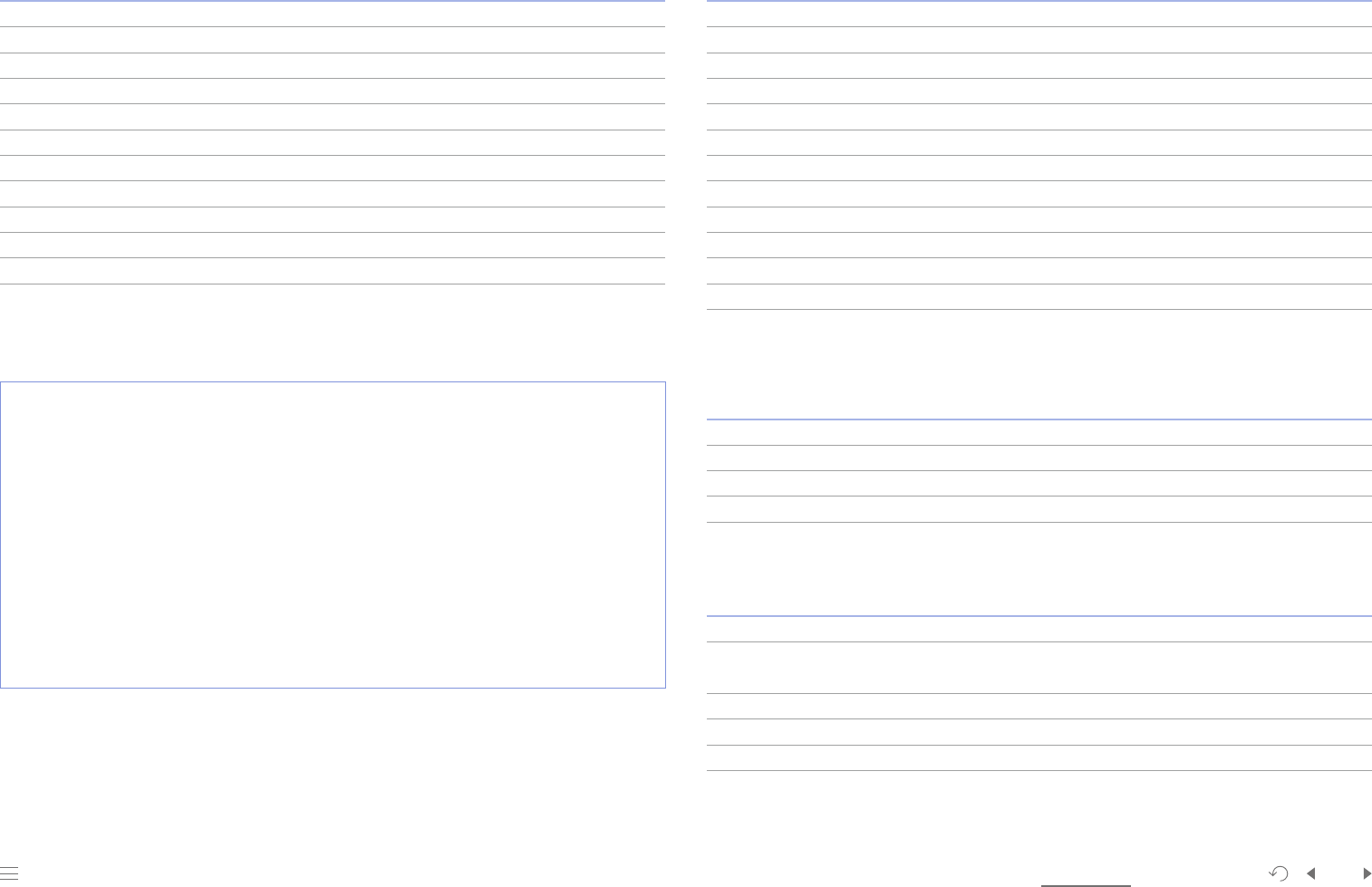
Our Company AppendixApproach to Sustainability Facts & Figures PrinciplePlanet
102
People
Samsung Electronics Sustainability Report 2023
Social Performance
Compliance and ethics 2020 2021 2022
Compliance training
Compliance training
1)
Individuals 115,787 141,723 126,867
Anti-corruption training
Anti-corruption training
2)
Individuals 187,228 198,592 254,045
Compliance whistleblowing
Compliance whistleblowing
3)
Cases 549 911 1,098
Corruption whistleblowing
Corruption whistleblowing
4)
Cases 728 929 999
Corruption whistleblowing rate % 11 12 13
Consumer complaint rate % 28 30 34
Others % 61 58 54
1. Scope of data collection for compliance training: Employees at our our business sites in Korea and other regions (including part-time employees)
2. Scope of data collection for anti-corruption training: Employees at our business sites in Korea and other regions
3. Compliance whistleblowing data: Based on statistics of our compliance microsite (https://sec-compliance.net)
4. Corruption whistleblowing data: Based on statistics of our ethics microsite (https://sec-audit.com)
Corporate citizenship 2020
3)
2021
3)
2022
Hours of employees’ volunteer work
Hours of employees’ volunteer work Hours 635,564 824,329 1,068,867
Hours of volunteer work per employee
1)
Hours 2.37 3.04 3.95
Cumulative number of beneficiaries
Samsung SW Academy for Youth Individuals 2,250 3,950 6,250
Samsung Dream Class Individuals 107,095 112,602 116,999
Samsung Smart School
2)
Individuals 4,237 5,917 5,917
Samsung Junior SW Academy Individuals 84,140 112,341 156,061
Stepping Stone of Hope Individuals 8,612 10,476 16,760
Samsung Blue Elephant Individuals 93,862 353,201 662,142
Samsung Solve for Tomorrow Individuals 1,948,186 2,146,951 2,397,255
Samsung Innovation Campus Individuals 35,802 74,984 119,807
1. Hours of volunteer work per employee: Including employees at all of our business sites in Korea and other regions
2. Beneficiaries of Samsung Smart School in 2022 Based on our business sites in Korea
3. Data updated for error correction in some countries in 2020 and 2021
SME support 2020 2021 2022
Beneficiaries of smart factory support
Beneficiaries of smart factory support
1)
Companies 369 284 277
Partner companies in our supply chains Companies 66 24 33
Non-partner companies Companies 303 260 244
1. Beneficiaries of smart factory support: Figures of 2021 corrected after the publication of the 2021 Sustainability Report due to
business discontinuation of two beneficiary companies
Privacy protection 2020 2021 2022
In-house consulting Cases 5,716 6,273 5,858
Response to government request for
information
1)
Requests Cases 188 179 187
Response Cases 130 122 126
Response rate % 69 68 67
1. Response to government requests for information: Compiled statistical data with regards to the warrants issued by Korean courts in
accordance with the applicable Korean laws
Status of Sanctions
The Korea Fair Trade Commission reported Samsung Electronics and former Director of the Future Strategy Office
Choi Gee-sung to the Prosecution on June 22, 2021, on charges of violating Article 23 (1) 7 of the Monopoly Regulation
and Fair Trade Act in relation to the in-house cafeteria catering transaction with Samsung Welstory. This case was
prosecuted on November 16, 2022, and criminal litigation is ongoing at the Seoul Central District Court. The Fair Trade
Commission issued a corrective order and imposed a fine of KRW 101.217 billion on Samsung Electronics for the same
transaction pursuant to the same Act on August 27, 2021. In September 2021, we filed administrative litigation against
the Fair Trade Commission with the Seoul High Court. On January 27, 2022, the corrective order was suspended.
Regardless of the ongoing litigation, we have opened up the bidding for our in-house food catering services, in line
with the recommendations of our Board of Directors and Compliance Committee as well as relevant government
policies, and in an effort to provide a diversified service to our employees. In 2022, all of our 36 in-house cafeterias
procured catering services through competitive bidding.
For the status of other sanctions imposed on the company, please refer to Samsung’s the Semi-Annual Business Report.
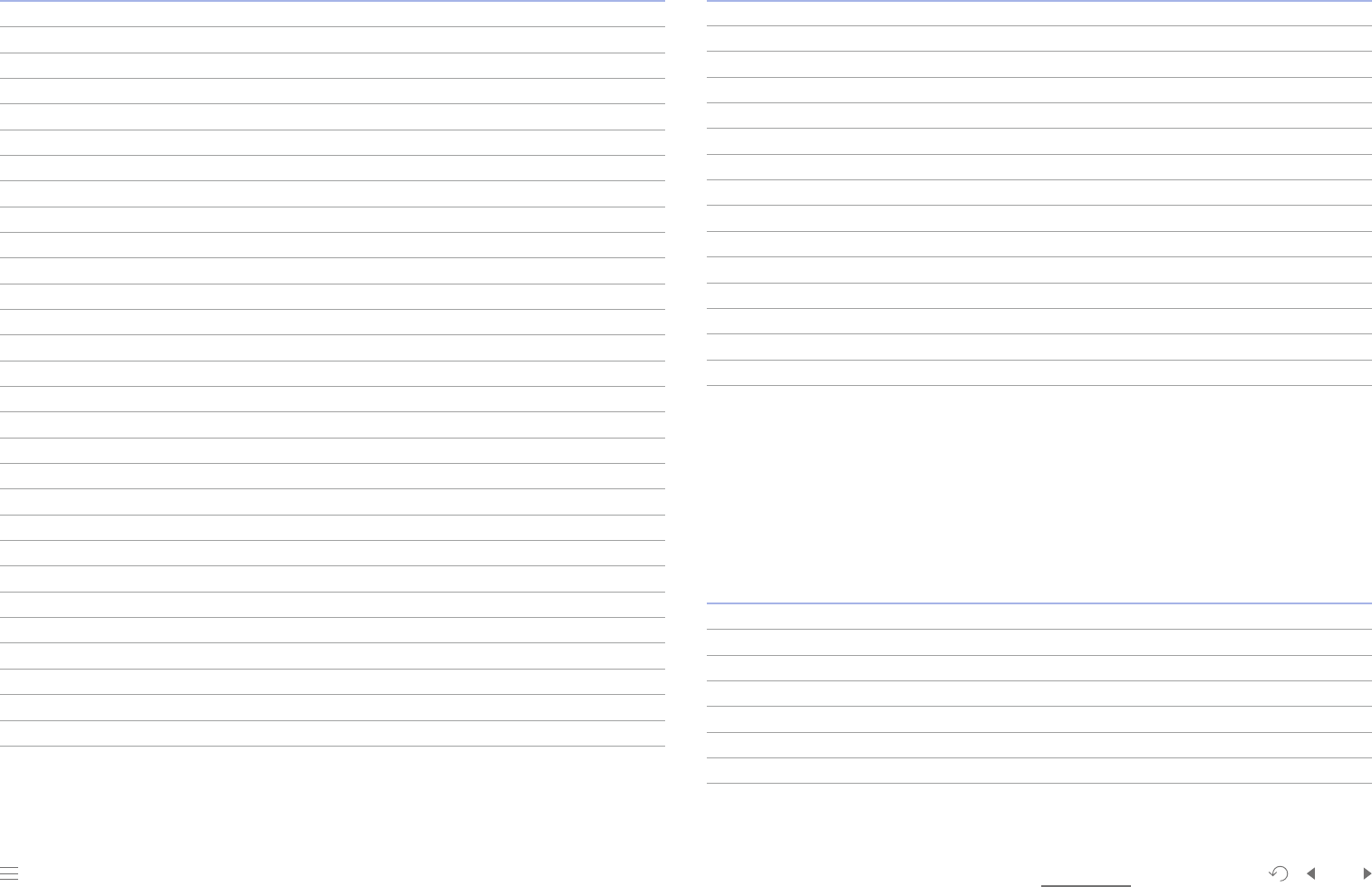
Our Company AppendixApproach to Sustainability Facts & Figures PrinciplePlanet
103
People
Samsung Electronics Sustainability Report 2023
2020 2021 2022Labor and human rights 2020 2021 2022
Number of employees
Number of employees
1)
Persons 267,937 266,673 270,372
Global* Persons 161,607 155,547 152,445
Korea Persons 106,330 111,126 117,927
Number of employees by employment type
Non-fixed-term employees Persons 264,030 262,794 266,705
Fixed-term employees
2)
Persons 3,907 3,879 3,667
Number of employees by age group
Under 30 Persons 99,823 89,911 83,169
30s Persons 106,236 108,469 111,651
40 and above Persons 56,380 68,293 75,552
Number of employees by job type
3)
Development Persons 71,539 75,229 80,496
Manufacturing Persons 127,256 122,809 117,190
Quality assurance and EHS Persons 19,354 19,459 19,763
Sales and marketing Persons 22,704 23,267 24,716
Others Persons 27,084 25,909 28,207
Number of employees by rank
Working level
4)
Persons 190,507 184,739 182,367
Manager level Persons 76,057 80,540 86,548
Executive level
5)
Persons 1,373 1,394 1,457
Number of employees by region
Korea Persons 106,330 111,126 117,927
Southeast Asia, Southwest Asia, and Japan Persons 101,929 94,583 88,992
China Persons 18,099 17,820 17,891
North America and Central and South America Persons 25,004 25,695 27,166
Europe Persons 12,861 12,704 11,710
Middle East Persons 3,160 4,171 4,303
CIS (Commonwealth of Independent States) Persons 1,748 1,739 1,756
Africa Persons 554 574 627
Number of non-Samsung Electronics employees
6)
41,633 50,080 54,492
Men Persons 24,761 31,926 32,803
Women Persons 13,025 13,266 16,773
Others** Persons 3,847 4,888 4,916
Number of non-Samsung Electronics employees by region
Korea Persons 27,861 34428 38492
Southeast Asia, Southwest Asia, and Japan Persons 3,590 4,305 4,583
China Persons 599 527 477
North America and Central and South America Persons 3,487 4,006 3,653
Europe Persons 4,598 5,003 5,846
Middle East Persons 581 691 852
CIS Persons 910 1,108 579
Africa Persons 7 12 10
Welfare benefit expenses in Korea and abroad
Welfare benefit expenses in Korea and abroad KRW 1 billion 4,655 5,073 6,092
1. Number of employees: As of yearend (excluding those dispatched by partner companies, those on leave, interns, and full-time students)
2. Fixed-term employees: Those hired pursuant to the Act on the Protection of Fixed-Term and Part-Time Employees at our business
sites in Korea and subcontractors and apprentices at our global business sites
3. Number of employees by job type: “Manufacturing” divided into “manufacturing” and “quality assurance and EHS”
4. Working-level employees: Encompassing those opting for flexible work arrangements and those not categorized under the manager
and executive levels
5. Executive-level employees: Including those at the vice president level and higher at our global business sites
6. Number of non-Samsung Electronics employees: Based on those who chose to indicate their gender
* "Global" refers to countries excluding Korea
** Those who chose not to indicate their gender
Percentage of new female hires and retirement rate 2020 2021 2022
Percentage of new female hires
Korea % 28.4 27.5 27.9
Global % 32.4 33.0 29.4
Retirement rate
1)
Total retirement rate % 17.7 13.9 12.9
Retirement rate of men
2)
% 8.5 7.6 7.0
Retirement rate of women
2)
% 9.2 6.3 5.9
1. Retirement rate: Ratio of those who retired during the respective fiscal year to the total number of employees
2. Retirement rates of men and women: Based on the number of employees in Korea and abroad who chose to indicate their gender
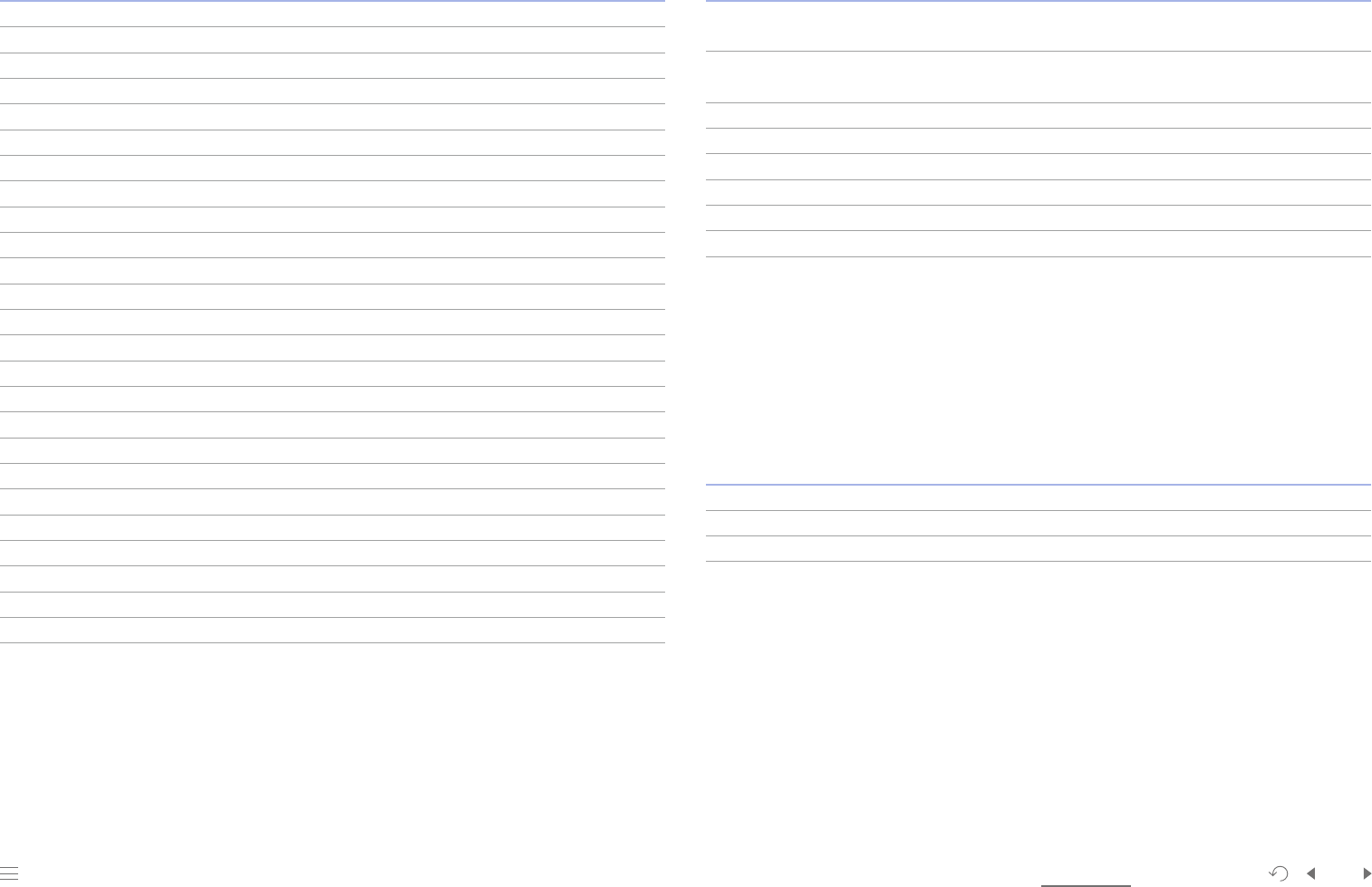
Our Company AppendixApproach to Sustainability Facts & Figures PrinciplePlanet
104
People
Samsung Electronics Sustainability Report 2023
Diversity and inclusion 2020 2021 2022
Percentage of female employees
Percentage of female employees
1)
% 37.3 36.3 35.1
Percentage of female employees by job type
2)
Development % 18.0 18.8 19.2
Manufacturing % 48.9 46.8 45.1
Quality assurance and EHS % 41.3 42.3 40.8
Sales and marketing % 31.5 32.3 33.6
Others % 35.8 36.0 35.9
Percentage of female employees by region
Korea % 24.9 25.1 25.2
Southeast Asia, Southwest Asia, and Japan % 52.7 51.4 49.5
China % 33.4 33.8 34.2
North America and Central and South America % 35.4 34.9 34.4
Europe % 33.8 34.0 40.1
Middle East % 11.3 14.5 15.6
Africa % 42.4 42.5 42.6
Percentage of female employees by rank
Working level % 46.3 45.3 43.9
Manager level % 15.3 16.1 16.9
Executive level
3)
% 6.6 6.8 6.9
Number of employees on parental leave
4)
Men Persons 856 999 1,310
Women Persons 3,041 2,936 3,054
Rate of return to work after parental leave
5)
Men % 93.8 96.3 96.5
Women % 98.9 98.9 98.9
Maximum number of children accommodated at
in-house daycare centers
Maximum number of children accommodated at
in-house daycare centers
6)
Persons 3,020 3,050 3,078
Number of in-house daycare centers
Number of in-house daycare centers
7)
Centers 13 13 13
Number of employees with disabilities
Number of employees with disabilities
8)
Persons 1,465 1,574 1,664
Percentage of employees with disabilities
Percentage of employees with disabilities
9)
% 1.5 1.6 1.6
1. Percentage of female employees: Based on the total number of employees
2. Percentage of female employees by job type: “Manufacturing” divided into “manufacturing” and “quality assurance and EHS”
3. Percentage of executive-level female employees: Including those at the vice president level and higher at our global business sites
4. Number of employees on parental leave: Based on the number of employees at business sites in Korea
5. Rate of return to work after parental leave: Based on the number of employees at business sites in Korea
6. Maximum number of children accommodated at in-house daycare centers: Based on our business sites in Korea
7. Number of in-house daycare centers: Based on our business sites in Korea
8. Number of employees with disabilities: Based on the number of employees at our business sites in Korea
9. Percentage of employees with disabilities: Based on the number of employees at our business sites in Korea
Safety and health 2020
4)
2021
4)
2022
Frequency rate
1)
% 0.035 0.106 0.155
Injury rate
2)
% 0.008 0.022 0.031
Injury rate of suppliers
3)
% 0.045 0.076 0.094
1. (Number of incidents / Total working hours) x 1,000,000; based on employees in Korea and at our global production sites
2. (Number of incidents / Number of on-site employees) x 100; based on employees in Korea and at our global production sites
3. Based on suppliers stationed at our sites
4. Data updated for error correction in some countries in 2020 and 2021
2020 2021 2022
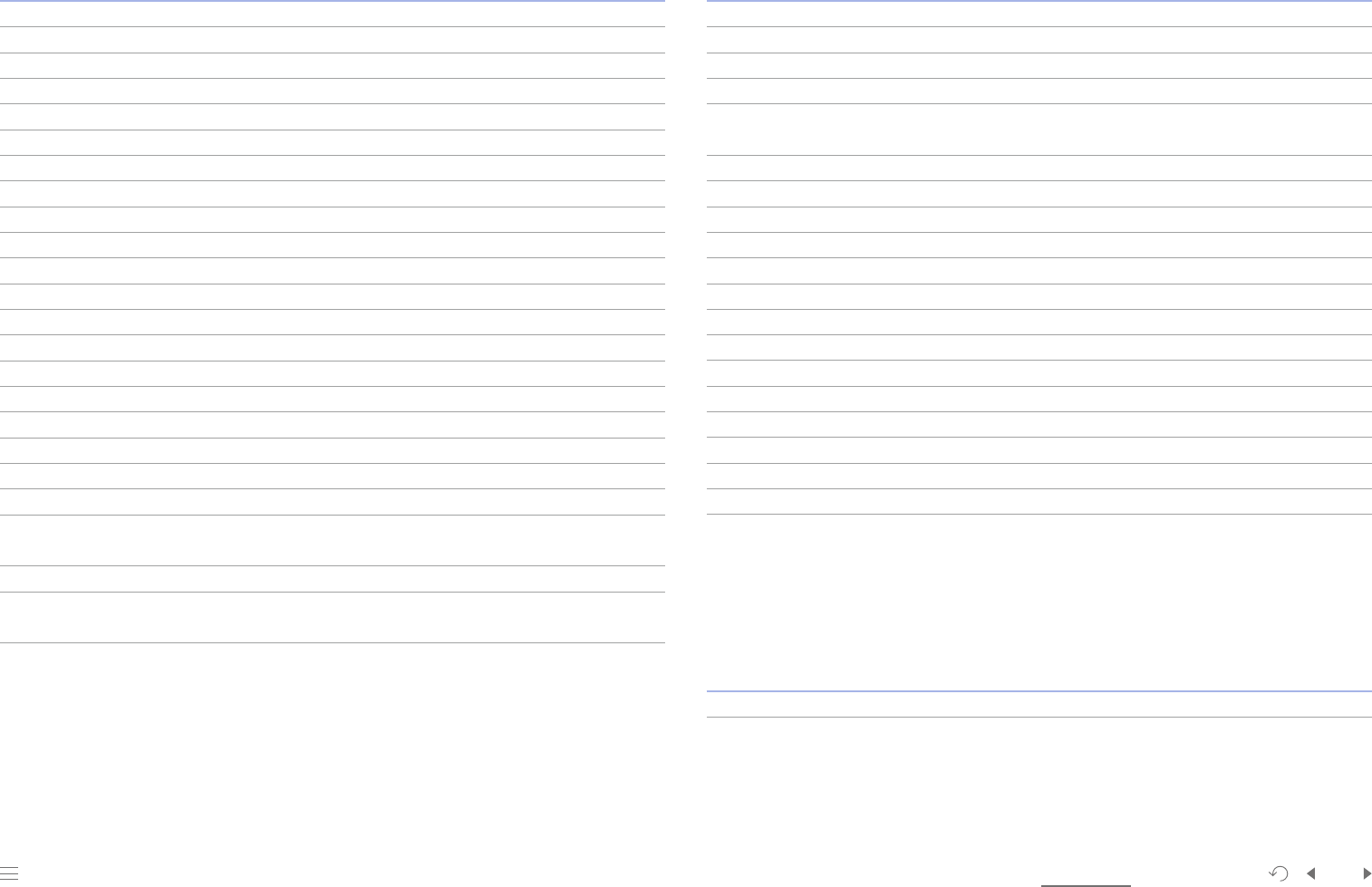
Our Company AppendixApproach to Sustainability Facts & Figures PrinciplePlanet
105
People
Samsung Electronics Sustainability Report 2023
Career development 2020 2021 2022
Number of training sessions
Total 10,000 cases 734 818 914
Global 10,000 cases 350 366 407
Korea 10,000 cases 384 452 508
Hours of training per employee
Hours of training per employee
1)
Hours 55.8 54.9 60.1
Global Hours 46.0 45.7 52.1
Korea Hours 70.8 67.7 70.5
Average hours of training by gender
Men Hours 59.6 58.2 61.1
Women Hours 49.4 48.2 58.3
Average hours of training by employment type
2)
Regular employees Hours 55.8 54.8 60.5
Non-regular employees Hours 52.2 43.8 40.3
Training expenses
Total training expenses
3)
KRW 100 million 1,014 1,321 1,853
Training expenses per employee
4)
KRW 1,000 953 1,188 1,571
Ratio of training expenses to sales
5)
% 0.05 0.05 0.07
Ratio of training expenses to personnel expenses
6)
% 0.6 0.8 0.5
Re-employment through the Career Development Center
Re-employment support through the Career Development
Center
7)
Cases 7,561 7,940 8,246
Re-employment through the Career Development Center
8)
Cases 6,679 6,982 7,286
Rate of re-employment through the Career Development
Center
% 88.3 87.9 88.4
1. Average training hours per employee: Online training + offline training
2. Average training hours per non-regular employee: Based on subcontractors and apprentices
3. Total training expenses: Employees in Korea
4. Training expenses per employee: Total training expenses / Total number of employees in Korea
5. Ratio of training expenses to sales: Total training expenses / Sales (sales of DX division (absolute value) + sales of DS division (absolute
value))
6. Ratio of training expenses to personnel expenses: Total training expenses / Total compensation for employees of the headquarters in
Korea
7. Cases of re-employment support through the Career Development Center: Cumulative sum since 2001
8. Cases of re-employment through the Career Development Center: Cumulative sum since 2001
Sustainable supply chain 2020 2021 2022
Comprehensive supplier evaluation
Percentage of evaluated suppliers
1)
% 92 93 89
Percentage of those rated outstanding % 73 68 62
Percentage of those with ISO 14001 certification
2)
% 86 88 90
Percentage of those with OSHAS 18001
certification
3)
% 47 47 50
Win-Win Fund
Funding KRW 100 million 9,736 9,734 9,942
First-tier suppliers KRW 100 million 7,294 6,590 6,997
Second-tier and third-tier suppliers
4)
KRW 100 million 2,442 3,144 2,945
Supplier incentives
Supplier incentives KRW 100 million 777 893 931
Companies participating in supplier training
Companies participating in supplier training Companies 720 911 1,053
First-tier suppliers Companies 511 520 537
Second-tier and third-tier suppliers Companies 209 391 516
Employees participating in supplier training
Employees participating in supplier training
5)
Persons 16,756 18,725 20,907
First-tier suppliers Persons 13,107 17,423 18,705
Second-tier and third-tier suppliers Persons 3,649 1,302 2,202
1. Percentage of evaluated suppliers: The annual comprehensive supplier evaluation - in 8 areas - applies to all suppliers, except for
those registered for less than a year
2. Percentage of suppliers with ISO 14001 certification: Fulfillment of ISO 14001 or equivalent is required as part of the Standard
Supplier Contract
3. Percentage of suppliers with OHSAS 18001 certification: Includes 23 suppliers with SA8000 certification
4. Second-tier and third-tier suppliers supported by Win-Win Fund: Third-tier suppliers included since 2018
5. Supplier training participating employees: Including cases of cross-attendance
Transparency in responsible minerals sourcing management 2020 2021 2022
On-site inspections of suppliers
1)
Companies 427 493 438
1. On-site inspections of suppliers aimed at eradicating the use of conflict minerals
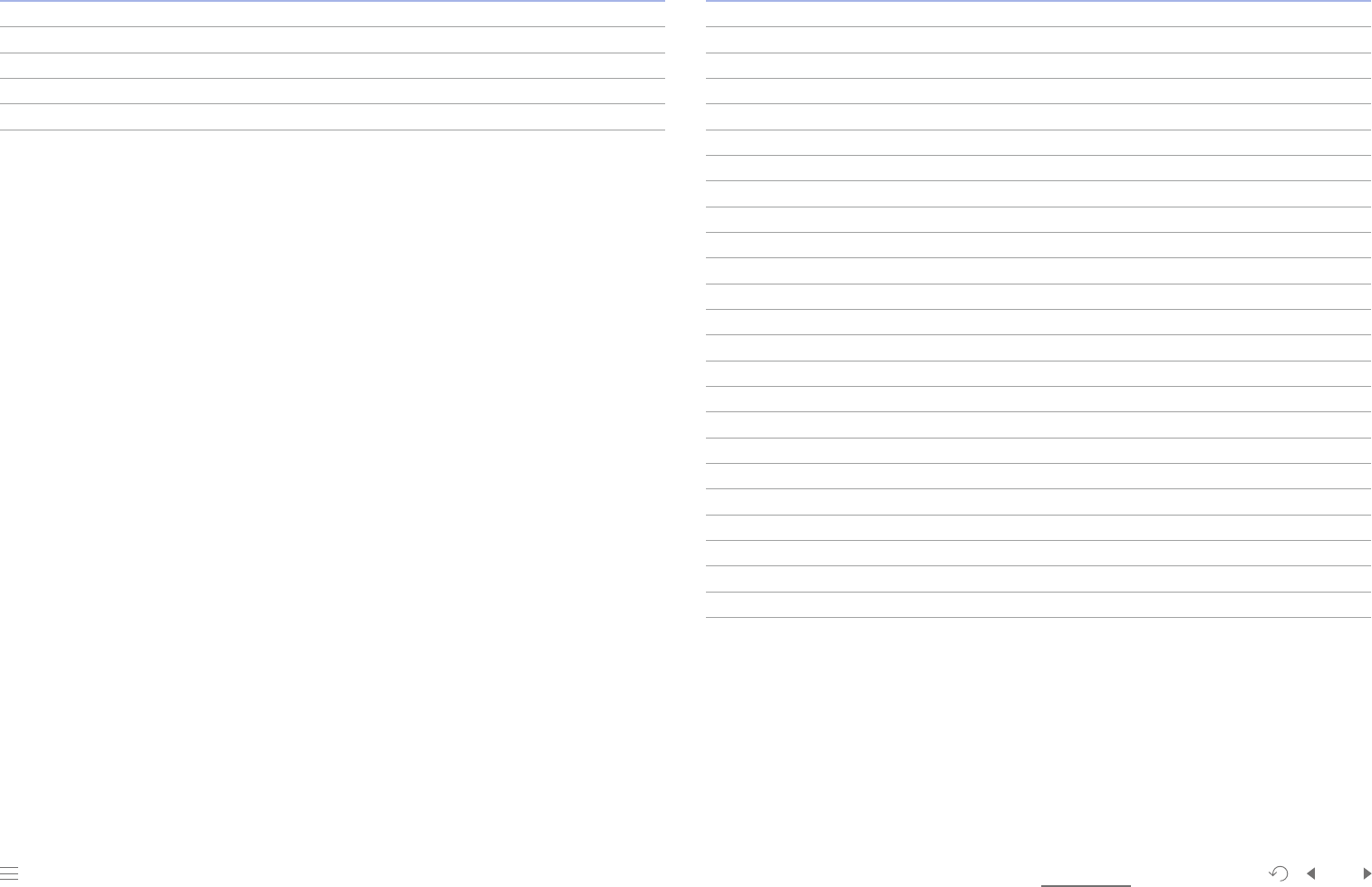
Our Company AppendixApproach to Sustainability Facts & Figures PrinciplePlanet
106
People
Samsung Electronics Sustainability Report 2023
Innovation support for first-tier suppliers 2020 2021 2022
Innovation support for first-tier suppliers Companies 28 30 66
Global Companies 0 0 5
Korea Companies 28 30 61
Work environment management
First-tier suppliers performing third-party audits Companies 78 108 121
Supplier Third-Party Audit Compliance Rate by Area
1)
2020 2021 2022
Labor and human rights
Freely chosen employment
2)
% 97 98 98
Guarantee of freedom of movement % 99 99 100
Prohibition of child labor % 100 100 100
Protection of underage workers % 98 100 100
Working hours % 82 87 93
Guarantee of at least one day off per week % 92 97 97
Wages and benefits
3)
% 90 91 96
Humane treatment % 100 100 100
Non-discrimination
4)
% 100 100 100
Freedom of association
5)
% 99 99 98
Safety and Health
Occupational safety % 94 96 95
Emergency preparedness % 96 95 94
Occupational injury and illness % 99 99 98
Physically demanding work % 95 99 97
Machine safeguarding % 98 99 98
Sanitation, food, and housing % 95 99 99
Environment
Pollution prevention % 99 98 99
Hazardous substances % 97 99 96
Wastewater and solid waste % 99 100 98
Air emissions % 100 100 99
Materials restrictions % 100 100 100
1. The figures include the improvement implementation results based on each year’s third-party audit (performed on 121 suppliers in
2022).
2. Freely chosen labor: Including prohibition of forced labor and establishment of relevant policies, labor contract-signing, guarantee of
freedom of movement and prohibition of keeping the original copy of an employee’s identification document
3. Wages and benefits: Including accurate calculation and payment of wages, provision of wage statements, prohibition of delay in the
payment of wages, prohibition of unjust penalty imposition and compulsory payments such as social insurance contributions
4. Non-discrimination: Including prohibition of discrimination based on gender and other personal traits to ensure access to equal
opportunities and pay, establishment of non-discrimination policies and procedures, provision of spaces for religious gathering
5. Freedom of association: Including guarantee of the right to establish and join labor unions, right to collective bargaining, freedom of
assembly and association and prohibition of discrimination against labor union members
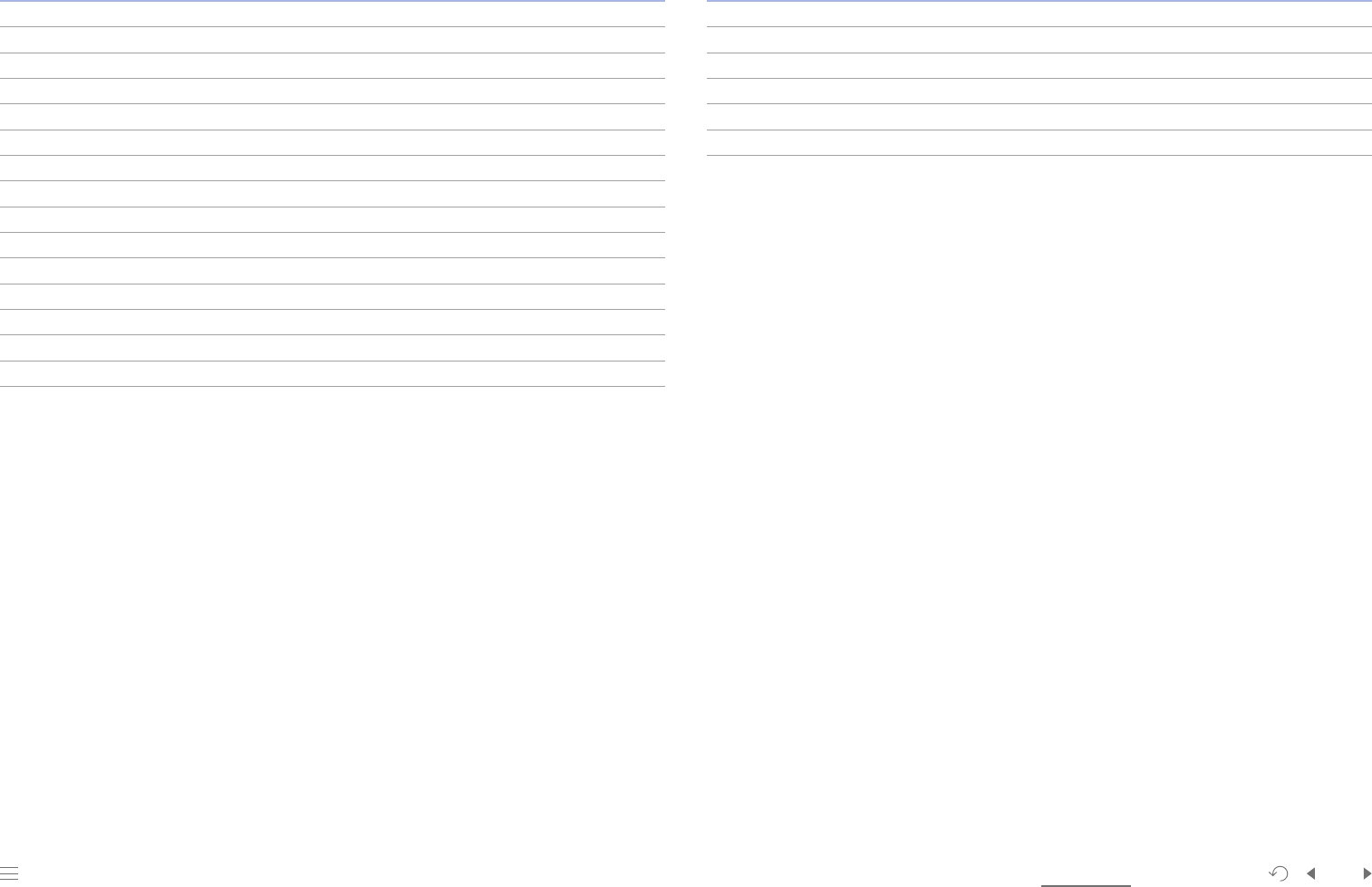
Our Company AppendixApproach to Sustainability Facts & Figures PrinciplePlanet
107
People
Samsung Electronics Sustainability Report 2023
Enhancement of customer value
1)
2020 2021 2022
Korea
Visual Display and Digital Appliances Score 77.3 80.6 83.8
Mobile and Networks Score 85.0 84.8 86.8
Global
Visual Display and Digital Appliances Score 66.8 69.2 71.2
Mobile and Networks Score 61.7 64.4 66.3
1. Customer satisfaction rate based on Samsung Customer Services' Net Promoter Scores (NPS)
* The CE Division (including Visual Display and Digital Appliances) and IM Division (Mobile and Networks) were integrated into the
Device eXperience (DX) Division in December 2021. The figures of 2020 and 2021 are based on the previous business categorization.
Ethics 2020 2021 2022
Corporate ethics % 96 98 100
Prohibition of ill-gotten gains % 94 98 100
Information disclosure % 97 100 100
Intellectual property % 100 100 99
Confidentiality and prohibition of retaliation % 97 100 100
Privacy protection % 100 99 100
Management System
Will for compliance % 99 100 98
Management responsibility % 96 100 95
Risk assessment % 87 97 92
Training % 95 100 98
Communication % 96 99 97
Employee feedback % 100 99 100
Remedial action % 91 98 95
Management of business improvement targets % 90 98 93
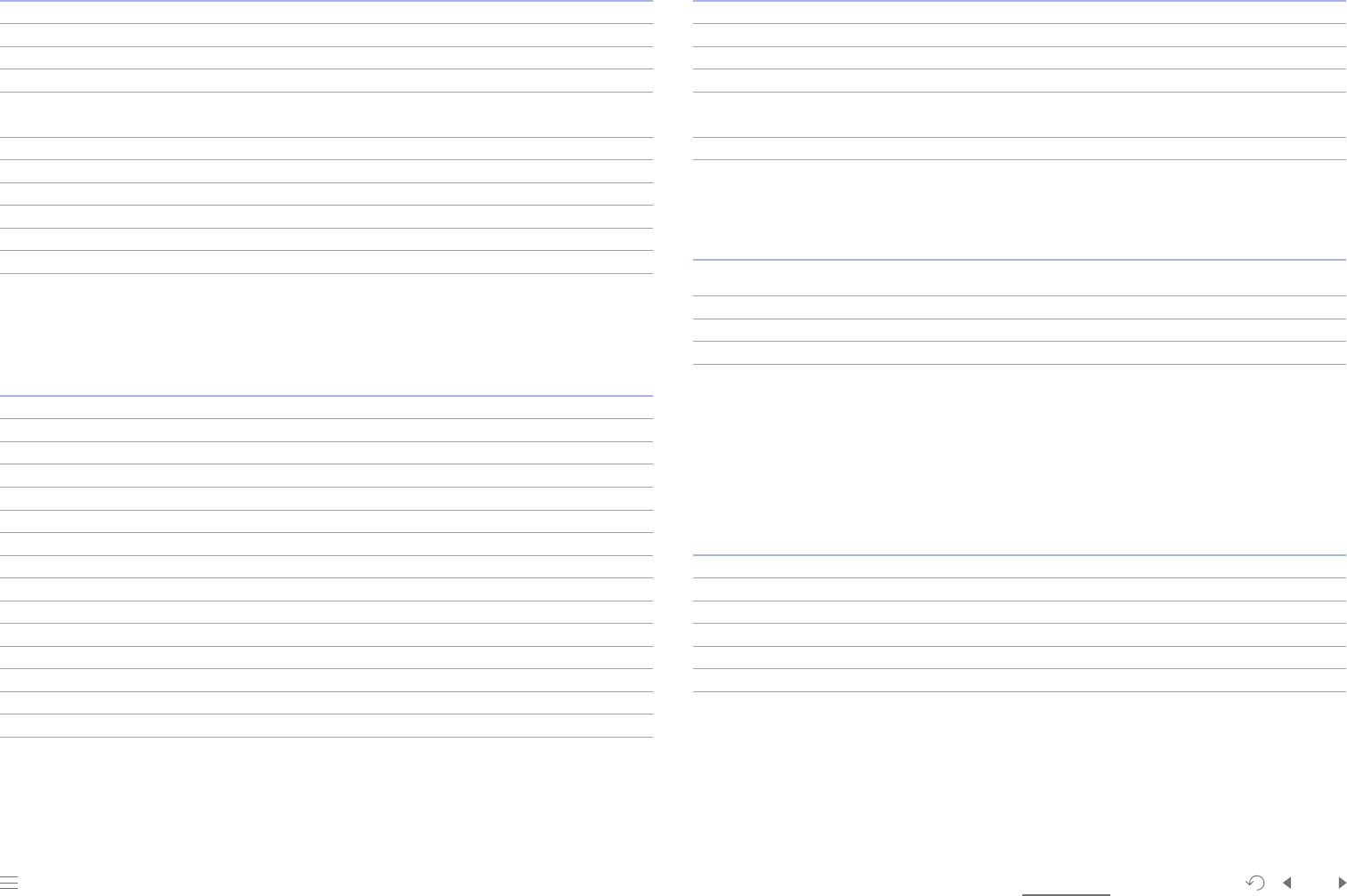
Our Company AppendixApproach to Sustainability Facts & Figures PrinciplePlanet
108
People
Samsung Electronics Sustainability Report 2023
Environmental Performance
GHG emissions management (Scope 1, 2) 2020 2021 2022
GHG emissions from business sites
GHG emissions from business sites
1)
1,000 tonnes CO
2
e 14,806 17,400 15,053
Direct emissions (Scope 1) 1,000 tonnes CO
2
e 5,726 7,604 5,972
Indirect emissions (Scope 2)
2)
1,000 tonnes CO
2
e 9,079 9,796 9,081
GHG emissions intensity
3)
Tonnes CO
2
e /
KRW 100 million
6.6 6.7 5.4
CO 1,000 tonnes CO
2
e 10,266 11,005 10,336
CH 1,000 tonnes CO
2
e 3 3 3
NO 1,000 tonnes CO
2
e 329 489 530
HFCs 1,000 tonnes CO
2
e 685 902 679
PFCs 1,000 tonnes CO
2
e 3,322 4,787 3,333
SF 1,000 tonnes CO
2
e 202 214 173
1. GHG emissions from business sites: Calculated based on country-specific GHG management guidelines, the IPCC Guidelines, and ISO 14064
* Location-based GHG emissions that do not reflect the use of renewable energy: 17,571,000 tonnes CO
2
e in 2020, 20,170,000 tonnes
CO
2
e in 2021, and 19,892,000 tonnes CO
2
e in 2022
2. Indirect emissions (Scope 2) from business sites: Market-based GHG emissions that reflect the use of renewable energy
3. GHG emissions intensity: GHG emissions from business sites (Scopes 1 and 2) / Sales (sales of DX division (absolute value) + sales of
DS division (absolute value), KRW 100 million)
GHG emissions management (Scope 3) 2020 2021 2022
Other indirect emissions (Scope 3)
1,000 tonnes CO
2
e 124,715
Purchased products and services
1,000 tonnes CO
2
e 14,596
Capital goods
1,000 tonnes CO
2
e 1,508
Fuel- and energy-related activities
1,000 tonnes CO
2
e 900
Upstream transportation and distribution
1,000 tonnes CO
2
e 3,965
Waste generation and treatment
1,000 tonnes CO
2
e 246
Business trips of employees
1,000 tonnes CO
2
e 87
Commuting of employees
1,000 tonnes CO
2
e 303
Rented assets
1,000 tonnes CO
2
e 107
Downstream transportation and distribution
1,000 tonnes CO
2
e 366
Processing of sold products
1,000 tonnes CO
2
e 142
Use of sold products 1,000 tonnes CO
2
e 101,236
Discard of sold products 1,000 tonnes CO
2
e 1,206
Leased assets 1,000 tonnes CO
2
e 1
Investment 1,000 tonnes CO
2
e 52
* Other indirect emissions (Scope 3): The internal calculation standard of 14 categories has been set in 2022 and all the categories have
been assured by the independent 3rd party. Data used for calculating suppliers' emissions - in the categories of Purchased goods &
services, Capital goods, and Processing of sold products - are based on 2021.
** Scope 3 emissions and assured categories in 2020 14,725.000 tonnes CO2e, sum of 4 categories (purchased products and services,
upstream transportation and distribution, downstream transportation and distribution, and business trips of employees)
*** Scope 3 emissions and assured categories in 2021 123,235,000 tonnes CO2e, sum of 12 categories (NOT including capital goods,
processing of sold products, and franchises)
Energy management 2020 2021 2022
Energy consumption at business sites
Energy consumption at business sites GWh 29,024 32,322 35,177
Electricity GWh 22,916 25,767 28,316
Others
1)
GWh 6,109 6,555 6,861
Energy intensity
2)
MWh/
KRW 100 million
13.0 12.4 12.5
Renewable energy consumption GWh 4,030 5,278 8,704
1. Others (Energy consumption at business sites): LNG
2. Energy intensity: Energy consumption at business sites (MWh) / Sales (sales of DX division (absolute value) + sales of DS division
(absolute value), KRW 100 million)
Energy efficiency of products
1) 2)
2020 2021 2022
Amount of GHG emissions reduced in the product
use phase
Amount reduced by year 1,000 tonnes CO
2
e 31,671 32,906 914(18,909)*
Energy efficiency improvement rate
Product energy consumption reduction rate % 32 33 2.6(18)*
1. Energy efficiency of products: Target product categories expanded in 2022 from 7 to 13
-2020-2021 7 major product categories (refrigerator, air conditioner, washer, TV, monitor, laptop, and smart phone)
- 2022 13 major product categories (refrigerator, air conditioner, washer, dryer, microwave oven, vacuum cleaner, TV, monitor, PC,
smart phone, tablet, wearable, and base station)
2. Energy efficiency of products: BAU base year changed from 2008 to 2021
-2020-2021 Reduction compared to 2008 BAU
-2022 Reduction compared to 2021 BAU
* Compared to 2008 BAU, the reduction in 2022 stands at 18,909,000 tonnes CO
2
e, which is equivalent to an average energy
consumption improvement of 18%.
Resource efficiency of products 2020 2021 2022
Plastic with recycled resin
Cumulative use
1)
Tonnes 276,972 310,291 409,117
Amount used by year Tonnes 30,992 33,319 98,826
Percentage of Plastic with recycled resin used
2)
% 4.3 4.4 13.9
Recycled packaging
Recycled packaging
3)
Tonnes 13,529 13,788 13,011
1. Cumulative use: From 2009
2. Percentage of Plastic with recycled resin used: amount of Plastic with recycled resin used / total amount of plastic used
3. Recycled packaging: Based on data collected in Korea
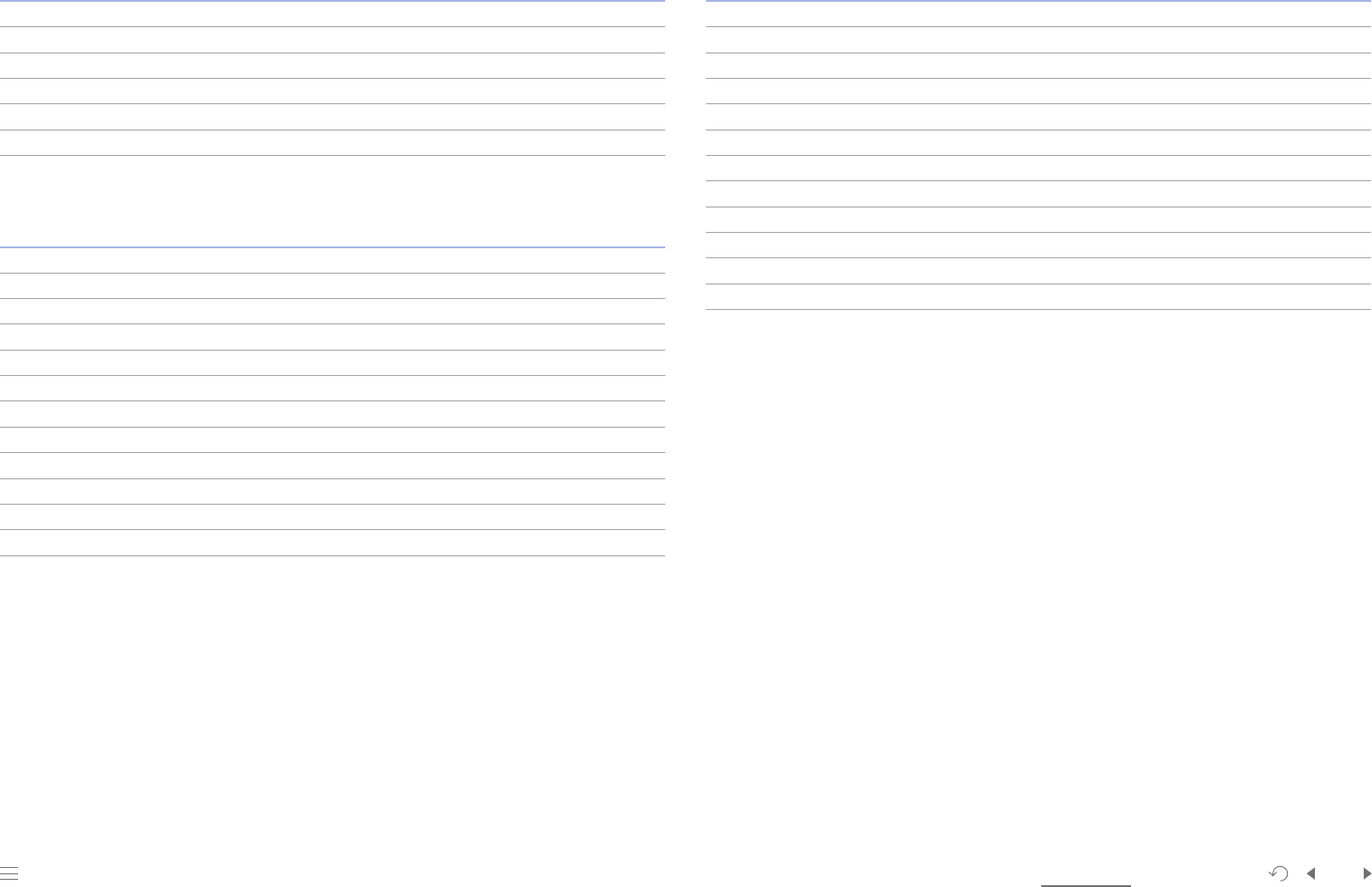
Our Company AppendixApproach to Sustainability Facts & Figures PrinciplePlanet
109
People
Samsung Electronics Sustainability Report 2023
Waste management 2020 2021 2022
Amount of waste generated
Amount of waste generated Tonnes 1,181,741 1,324,972 1,413,365
General waste Tonnes 835,875 903,753 931,929
Hazardous waste
1)
Tonnes 345,866 421,219 48 1,436
Amount of waste treated
Amount of waste treated Tonnes 1,181,741 1,324,972 1,413,365
Amount of waste recovered for recycling Tonnes 1,125,037 1,268,985 1,364,367
Incineration (off-site) Tonnes 23,346 26,078 25,479
Landfill (off-site) Tonnes 19,758 19,480 14,927
Others Tonnes 13,600 10,430 8,59 3
Percentage of waste recovered for recycling
Percentage of waste recovered for recycling % 95 96 97
1. Hazardous waste: Based on monitoring standards of individual countries where our business sites are located
Collection and recycling of e-waste 2020 2021
2)
2022
Cumulative amount of e-waste collected
1)
Tonnes 4,540,155 5,099,436 5,699,938
Amount of e-waste collected
Amount of e-waste collected Tonnes 506,627 559,281 600,502
Europe Tonnes 279,902 311,687 332,373
Americas Tonnes 41,426 46,584 50,955
Asia and Oceania Tonnes 185,299 201,010 217,174
1. Cumulative amount of e-waste collected: From 2009
2. 2021 Figures updated (due to the delay in data collection in some countries)
Amount of e-waste collected by year and product type
1)
2020 2021 2022
Amount of e-waste collected by year and product type Tonnes 113,850 120,718 132,681
Heat exchanger Tonnes 97,544 75,463 75,879
Telecommunications service equipment Tonnes 6,948 9,249 10,644
Display Tonnes 4,170 3,292 1,930
Other electric and electronics equipment Tonnes 5,188 32,715 44,228
Amount of materials recovered for recycling
2)
Amount of materials recovered for recycling Tonnes 97,815 103,716 111,406
Scrap metal Tonnes 52,666 55,843 57,763
Nonferrous metal Tonnes 11,779 12,489 11,996
Synthetic resin Tonnes 26,741 28,354 33,157
Glass Tonnes 2,883 3,057 4,068
Others Tonnes 3,747 3,973 4,422
1. Amount of e-waste collected by year and product type: From 2009
* E-waste classification system changed in 2021 from the existing system of “large-sized equipment, telecommunications service
equipment, medium-sized equipment, and small-sized equipment”
2. Amount of materials recovered for recycling: Based on data collected in Korea
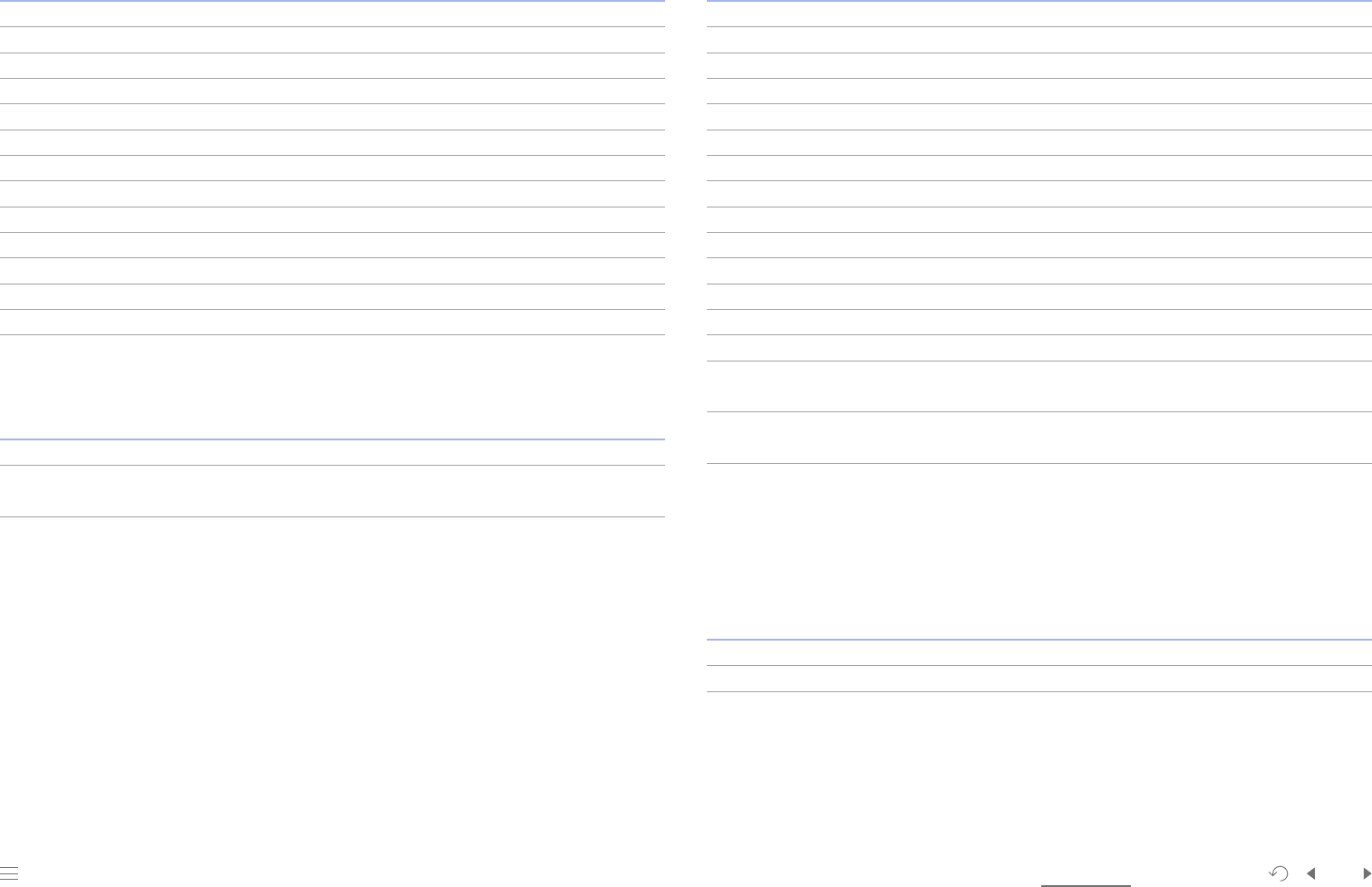
Our Company AppendixApproach to Sustainability Facts & Figures PrinciplePlanet
110
People
Samsung Electronics Sustainability Report 2023
Water management 2020 2021 2022
Water intake
Water intake 1,000 tonnes 141,648 163,660
1)
172,811
Municipal water (surface water) 1,000 tonnes 141,063 163,102 172,113
Underground water 1,000 tonnes 585 558
2)
698
Wastewater discharge
Wastewater discharge 1,000 tonnes 109,201 130,955 136,118
Water reused
Water reused 1,000 tonnes 70,181 93,949 116,590
Ultra-pure water reused
Supply 1,000 tonnes 57,226 61,986 70,989
Recovery 1,000 tonnes 19,691 22,543 24,731
Suppliers’ water consumption
3)
Suppliers’ water consumption 1,000 tonnes 70,128 84,737 94,814
1. 2. 2021 data updated for error correction
3. Suppliers’ water consumption: Based on the water consumption for Samsung Electronics product manufacturing by the top 90% of
suppliers in terms of transaction scale
Workplace environment management 2020 2021 2022
Investment in EHS KRW 100 million 9,412 13,997 21,836
Violations of environment-related laws
and regulations
Cases 0 0 2
1) 2)
Pollutant management
1)
2020 2021 2022
Air pollutant emissions
NOx Tonnes 652 717 785
SOx Tonnes 6 19 35
NH
3
Tonnes 71 68 95
HF Tonnes 18 22 19
PM
2)
Tonnes 210 163 207
Volatile organic compound emissions
Volatile organic compound emissions Tonnes 289 314 394
Water pollutant discharge
COD Tonnes 1,033 906 846
BOD Tonnes 315 266 313
SS Tonnes 377 393 411
F Tonnes 428 520 576
Heavy metals Tonnes 9 13 16
Consumption of ozone depleting
substances (CFC-11 eq)
3)
Consumption of ozone depleting
substances (CFC-11 eq)
Tonnes 2 1 2
1. To mitigate air pollutant emissions, we are pushing ahead with the introduction of a NOx reduction system, implementation of a
catalytic oxidation process, and installation of electric dust collection facilities. In accordance with the Montreal Protocol, all of our
business sites are gradually replacing the refrigerants for freezers and air conditioners with alternatives with less ozone depletion
potential (ODP). We are also working to remove water pollutants through our optimized wastewater treatment facilities prior to
wastewater discharge.
2. Previous dust emissions disclosure standards changed
3. Scope of data collection: Korea
Chemicals management
1)
2020 2021 2022
Chemicals consumption
2)
1,000 tonnes 455 520 578
Discharge of major hazardous substances Cases 0 0 0
1. Scope of data collection: Korea
2. Chemicals consumption: Based on the European Pollutant Release and Transfer Register (E-PRTR) from 2018
1. On 13 October 2022, the Gwangju City Hall imposed a fine of KRW 3.2 million on Samsung Electronics for violating Article 39 (Self-
Measurement), Paragraph 1 of the Air Environment Conservation Act regarding the recording of self-measurement results of air
pollutants. Samsung Electronics voluntarily paid the fine and conducts periodic cross-measurements to improve the reliability
of its measurements. For reference, the events related to the imposition of the above fines are as follows: On 2 March 2021, the
Yeongsan River Basin Environment Agency of the Ministry of Environment (MOE) notified Samsung Electronics' Gwangju Plant of
the cancellation of its designation as a green company, citing Article 16(3)(1) of the Environmental Technology and Environmental
Industry Support Act (Cancellation of Designation of Green Companies). On 7 July 2022, the Gwangju District Court sentenced two
employees of Samsung Electronics to a fine of KRW 3 million each for violating Article 18 of the Environmental Testing and Inspection
Act, and the sentence was upheld.
2. On 22 December 2002, the Ministry of Environment imposed a fine of KRW 1.6 million on Samsung Electronics for violating Article
31 (Operation of Emission Facilities and Prevention Facilities) of the Atmospheric Environment Protection Act. Samsung Electronics
has voluntarily paid the fine and is striving to comply with relevant laws and regulations by strengthening inspections of air pollution
prevention facilities.
For the status of sanctions related to environmental violations by other companies, please refer to the Business (Semi-Annual) Report.
On 10 June 2022, the Texas Commission on Environmental Quality (TCEQ) issued a Notice of Corrective Action regarding the
wastewater spill at the Samsung Austin Semiconductor LLC. (SAS) of the subsidiary of Samsung Electronics' DS Division, and no
financial sanctions such as fines were imposed as of the reporting date.
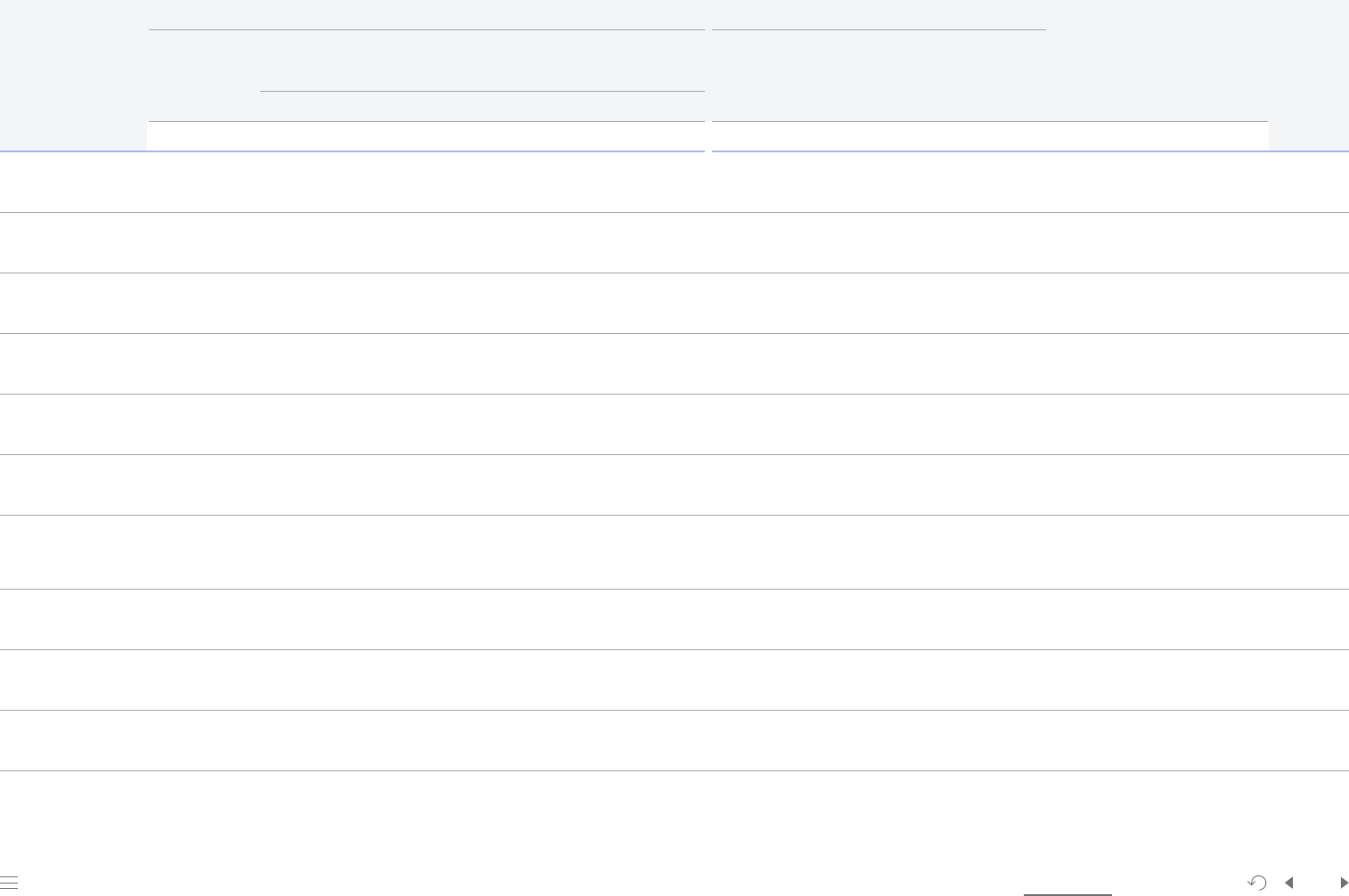
Our Company AppendixApproach to Sustainability Facts & Figures PrinciplePlanet
111
People
Samsung Electronics Sustainability Report 2023
Water intake Water discharge
Total amount of
intake
Water intake from third-party sources
(local governments, water utility
companies, etc.)
Direct intake
Total amount of
discharge
Direct discharge
into freshwater
ecosystems
Treatment and
discharge by third-
party agencies
Amount of water
used
Amount of water
reused
Basins
Region
Surface water Underground water Surface water Underground water
2021 2022 2021 2022 2021 2022 2021 2022 2021
1)
2022 2021 2022 2021 2022 2021 2022 2021 2022 2021 2022
Korea
1,000
tonnes
121,272 130,959 121,026 130,664 - - - - 246 295 97,720 103,786 64,974 63,633 32,746 40,153 23,552 27,171 64,787 86,331
4 including
the Han River
China
1,000
tonnes
18,716 18,733 18,716 18,733 - - - - - 15,327 15,324 - - 15,327 15,324 3,389 3,409 22,271 22,917
3 including
the Huang He
River
Europe
1,000
tonnes
208 365 205 329 - - - - 3 36 97 224 - - 97 224 111 142 3 -
2 including
the Danube
River
Russia
1,000
tonnes
100 56 100 56 - - - - - 31 30 - - 31 30 68 26 44 23
The Volga
River
Southeast Asia
1,000
tonnes
11,977 10,901 11,977 10,901 - - - - - 9,729 8,541 203 213 9,526 8,328 2,248 2,361 2,729 2,555
4 including
the Hong
River
Southwest Asia
1,000
tonnes
426 493 426 493 - - - - - 54 35 - - 54 35 372 458 215 199
2 including
the Ganges
River
North America
1,000
tonnes
10,380 10,734 10,380 10,734 - - - - - 7,654 7,894 - - 7,654 7,894 2,727 2,840 3,824 4,557
4 including
the Lower
Colorado
River
Central and
South America
1,000
tonnes
334 381 25 14 - - - - 309 367 117 115 100 96 17 19 217 267 13 8
2 including
the Amazon
River
Africa
1,000
tonnes
247 188 247 188 - - - - - 226 169 - - 226 169 22 19 61 -
2 including
the Nile River
Total
1,000
tonnes
163,660 172,811 163,102 172,113 - - - - 558 698 130,955 136,118 65,276 63,942 65,679 72,176 32,706 36,691 93,949 116,590
Available Water Resources by Region
1. Relevant figures changed due to the correction of direct underground water intake in 2021
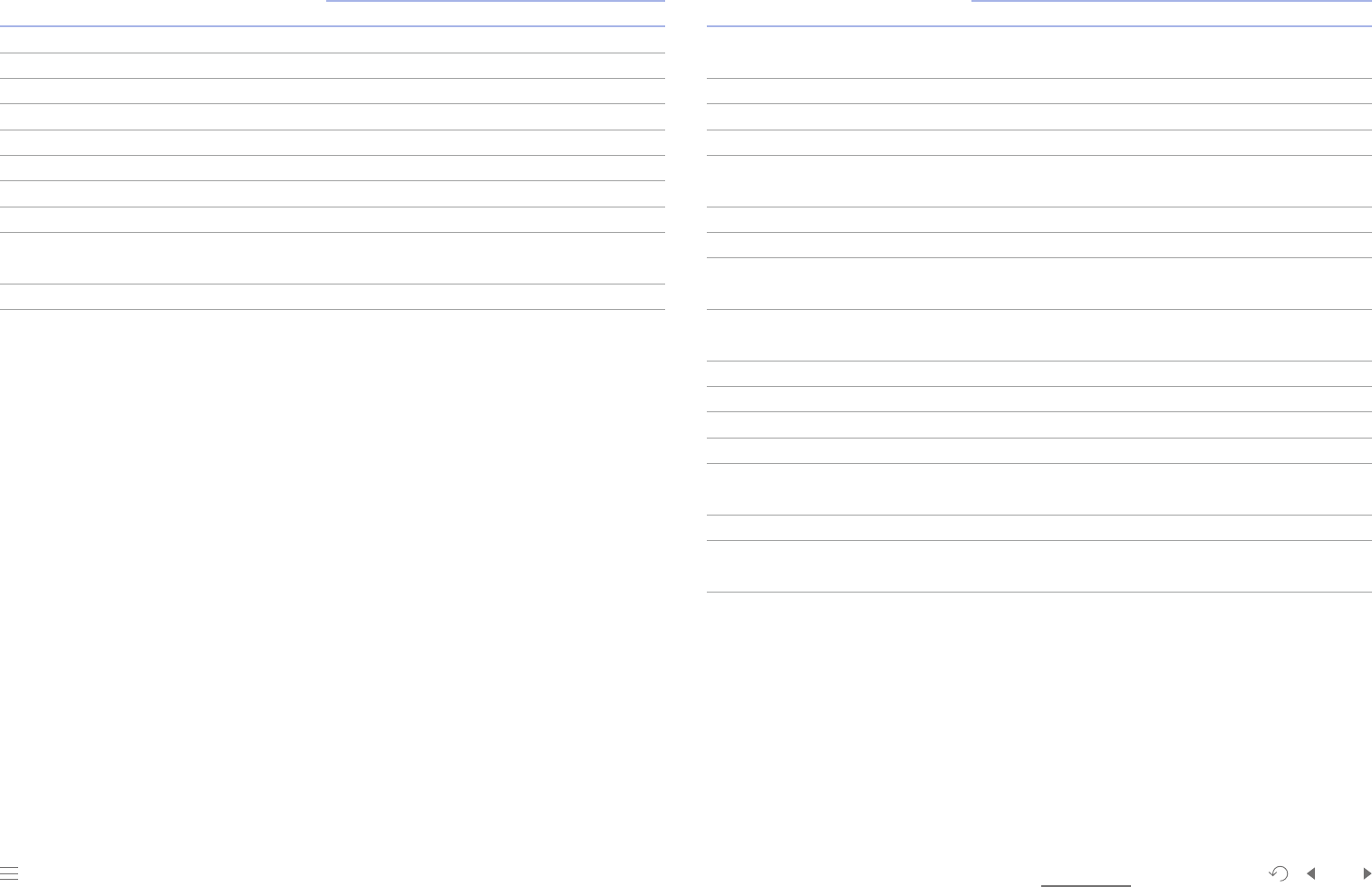
Our Company AppendixApproach to Sustainability Facts & Figures PrinciplePlanet
112
People
Samsung Electronics Sustainability Report 2023
Performance by Division
Supply chain management
DX DS Total
2021 2022 2021 2022 2021 2022
Comprehensive supplier evaluation
Suppliers evaluated
1)
% 97 91 82 83 93 89
Suppliers rated outstanding
2)
% 65 59 77 74 68 62
Suppliers with ISO 14001 certification
3)
% 88 90 89 92 88 90
Suppliers with OHSAS 18001 certification % 45
4)
47
5)
56 67 47 50
Supplier Training
Participating companies Companies 535 552 376 501 911 1,053
Participating individuals Persons 6,641 8,677 12,084 12,230 18,725 20,907
Supply chain work environment
management
Third party-audited first-tier suppliers Companies 84 93 24 28 108 121
1. All suppliers, excluding those registered for less than a year, evaluated in 8 areas
2. Higher score taken into consideration if evaluated for both DX and DS
3. ISO 14001 or equivalent certification required in the Standard Supplier Agreement
4. Including 12 SA8000-certified suppliers
5. Including 23 SA8000-certified suppliers
Environment
DX DS Total
2021 2022 2021 2022 2021 2022
GHG emissions from
business sites
1)
1,000 tonnes CO
2
e 1,790 366 15,610 14,687 17,400 15,053
Direct emissions 1,000 tonnes CO
2
e 263 254 7,341 5,718 7,604 5,972
Indirect emissions 1,000 tonnes CO
2
e 1,527 112 8,269 8,969 9,796 9,081
Other indirect emissions 1,000 tonnes CO
2
e 109,951 14,764 124,715
Energy consumption at
business sites
GWh 4,396 4,327 27,926 30,850 32,322 35,177
Electricity GWh 3,143 3,067 22,624 25,249 25,767 28,316
Others GWh 1,253 1,260 5,302 5,601 6,555 6,861
Renewable energy
consumption
GWh 556 2,856 4,722 5,849 5,278 8,704
Transition to renewable
energy
% 18 93 21 23 20 31
Waste generated Tonnes 348,427 329,861 976,545 1,083,504 1,324,972 1,413,365
General waste Tonnes 290,851 274,126 612,902 657,803 903,753 931,929
Hazardous waste
2)
Tonnes 57,576 55,735 363,643 425,701 421,219 481,436
Water intake 1,000 tonnes 19,392 18,822 144,269 153,988 163,660 172,811
Municipal water
(surface water)
1,000 tonnes 18,833 18,124 144,269 153,988 163,102 172,113
Underground water
3)
1,000 tonnes 558 698 0 0 558 698
Chemicals consumption
at business sites
4)
1,000 tonnes 8 6 512 572 520 578
1. Market-based GHG emissions that reflect renewable energy use
2. Based on the monitoring standards of individual countries where our business sites are located
3. Relevant figures changed due to the correction of direct underground water intake in 2021
4. Scope of data collection: Korea
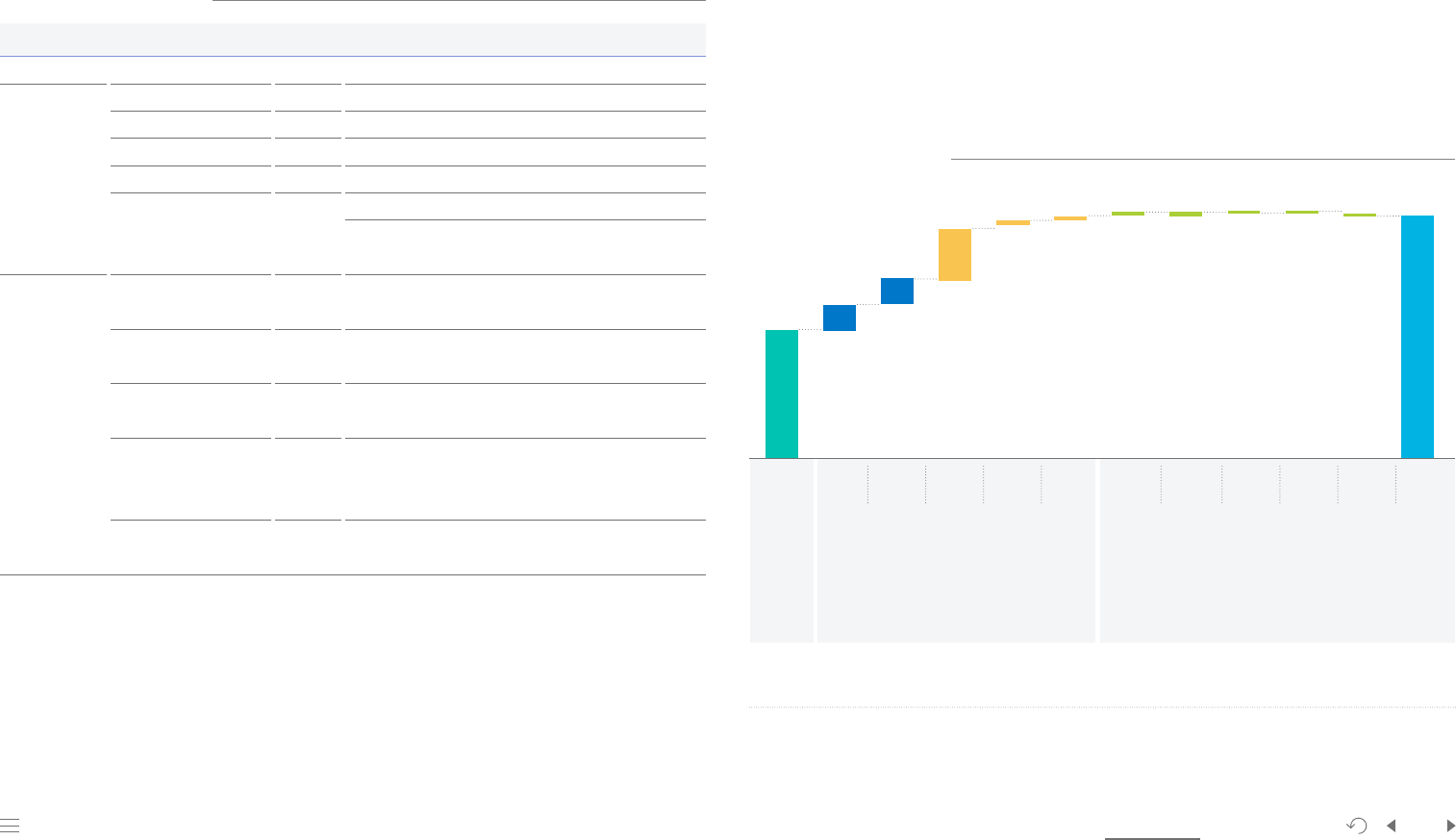
Our Company AppendixApproach to Sustainability Facts & Figures PrinciplePlanet
113
People
Samsung Electronics Sustainability Report 2023
Sustainability Value Creation
In order to quantitatively measure the positive and negative effects of our sustainability activities, we have
utilized the True Value method of KPMG since 2016. We also developed a set of indicators based on the results
of our research on the economic value of our socioeconomic activities to convert the measured effects
into monetary value. Our sustainability value consists of 1) financial value, 2) socioeconomic value, and 3)
environmental value, which are marked with + (positive) or – (negative).
Sustainability Value in 2022
We have continually monitored the latest global trends in socioeconomic value measurement research as
an extension of our efforts to more accurately assess the value of our sustainability activities. As a result,
we began to include wages and taxes, GHG emissions reduction in the product use stage, etc., in the set of
indicators to measure our socioeconomic value in 2023. Our total sustainability value created from January
1 to December 31, 2022, stands at around KRW 116.88 trillion. Our financial value reaches KRW 55.65 trillion,
a 39% increase compared to 2021. Our socioeconomic value stands at KRW 61.23 trillion incurred due to a
drastic rise in the amount of corporate tax paid (KRW 13 trillion) and wages and welfare benefits paid to our
employees (KRW 37.61 trillion). In 2023, our financial value is projected to decrease substantially due to the
global economic recession and industry stagnation. The drawback of the current measurement method is that
the sustainability value is heavily influenced by changes in the financial value. As such, we will continue to
strive to advance the measurement method by monitoring and analyzing related research trends.
Sustainability Value in 2022
55.65
13
10.53
37.61
116.88
0.99
0.44
0.0001
-1.34
-0.001
-0.004 0
Financial
value
Socioeconomic
value
Environmental
value
Development of
local communities
GHG emissions reduction
in the product use stage
GHG emissions
Impacts on the atmospheric
environment
Impacts on aquatic
ecosystems
Impacts of waste on
the environment
True Value
Government
Net income
Investor value
Employees
Supplier support
1. G. Psacharopoulos and H.A. Patrinos, Returns to investment in education: a further update (2004)
2. EPA, Technical update of the social cost of carbon for regulatory impact analysis (2013)
3. EEA, Revealing the cost of air pollution from industrial facilities in Europe (2011), Transportation Cost and Benefit Analysis II – Air
Pollution Costs, Victoria Transport Policy Institute (2011)
4. TruCost PLC, Natural capital at risk: the top 100 externalities of business (2013)
5. A. Rabl, J. V. Spadaro and A. Zoughaib, Environmental impacts and costs of solid waste: a comparison of landfill and incineration (2009)
* KRW 1,267 per USD and KRW 1,351 per euro based on the exchange rates on December 30, 2022
Value Measurement Methods
Category Type
Calculation Method
Financial value Benefit Net income of the year
Socioeconomic
value
Government support Benefit Corporate taxes paid to the government
Investor value Benefit Dividends and interest paid to investors and creditors
Employee support Benefit Wages and welfare benefits paid to employees
Supplier support Benefit Based on the amount of support through the Coprosperity Fund
Development of local
communities
Benefit
Donations for the resolution of individual communities’ issues
Calculation of the ROI (118%) of educational project
investment costs
1)
Environmental
value
GHG emissions reduction
in the product use stage
Benefit
Calculation of social benefits for GHG emissions reduction in
the product use stage
2)
GHG emissions from
business sites
Cost Calculation of social costs concerning GHG emissions
2)
Impacts on the
atmospheric environment
Cost
Calculation of social costs concerning air pollutant
(NOx, SOx, and PM) emissions
3)
Impacts on aquatic
ecosystems
Cost
Calculation of social costs concerning water consumption
based on the water stress levels of individual regions where
our business sites are located
4)
Impacts of waste on the
environment
Cost
Calculation of social costs concerning the burial, incineration,
and recycling of waste
5)
(Unit: KRW 1 trillion)
* The sustainability value in 2022, measured using indicators of the previous years, stands at approximately KRW 66.27 trillion.
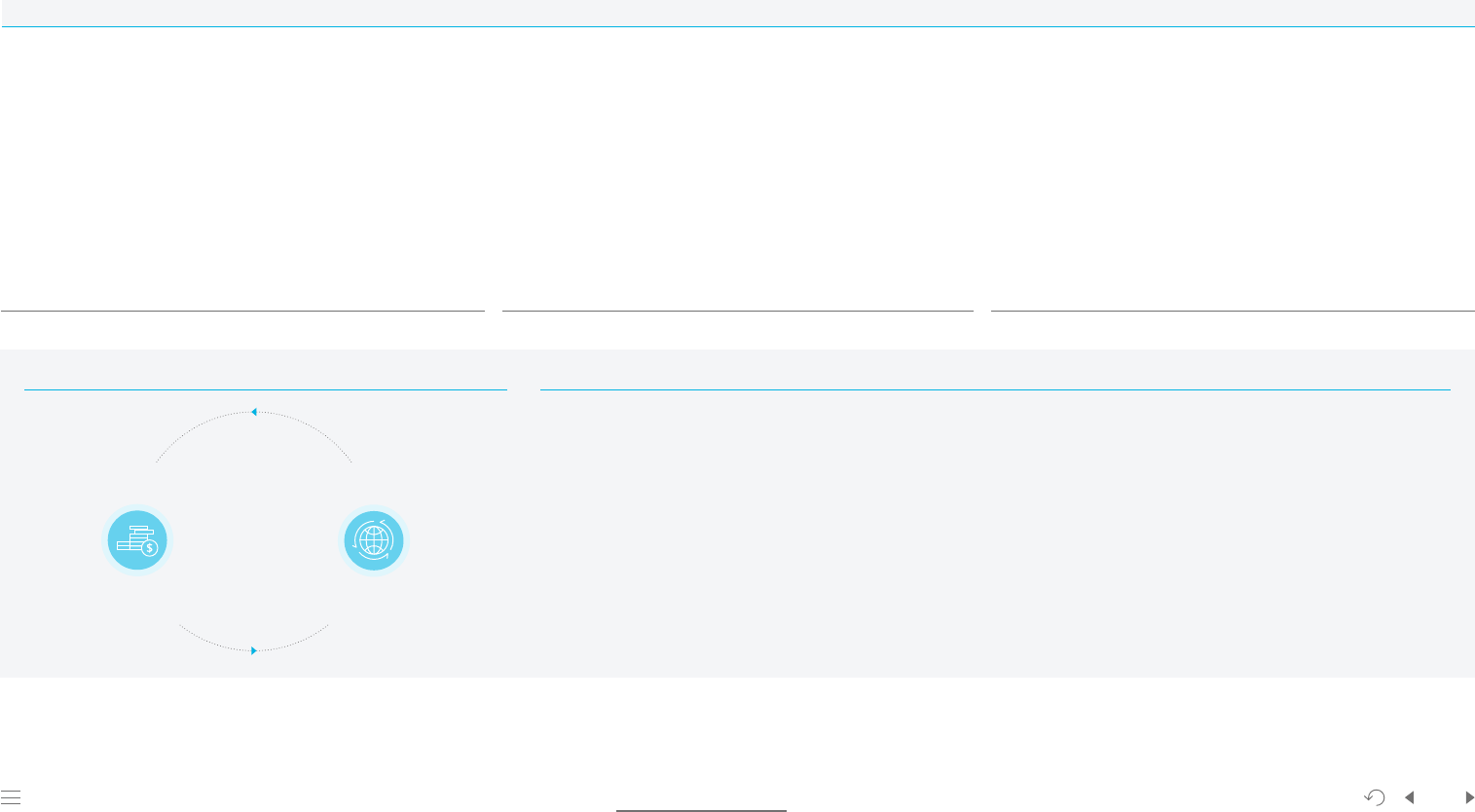
Our Company AppendixApproach to Sustainability Facts & Figures PrinciplePlanet
114
People
Samsung Electronics Sustainability Report 2023
Materiality Assessment
Every year we conduct the materiality assessment to identify key interests of our stakeholders and significant issues that affect our business, and communicate the findings to our stakeholders in a transparent manner. We
conducted the 2023 materiality assessment at the headquarters level and at our subsidiaries in Europe adopting the method proposed by EU's Corporate Sustainability Reporting Directive (CSRD). The double materiality
assessment as defined by CSRD takes into consideration both the level of social and environmental impacts of corporate activities and the impact of sustainability issues such as climate change and inequality on corporate value.
Assessing the positive and negative impacts of the assessed company on the
environment and society in the short term and mid-to-long term and related
sustainability issues
Assessing the social and environmental impact of individual material issues
through the quantification of the sustainability issues covered by the media
recently, competitors’ material issues, analysis of various international ESG
standards, and surveys of internal and external stakeholders
- Analyzing media reports and competitors’ issues
- Analyzing international standards (GRI, ESRS, UN SDGs)
- Conducting employee surveys
- Conducting external stakeholder surveys
Creating a comprehensive list of material issues including those already
identified in the previous sustainability report and new global issues
Identifying 21 issues based on global sustainability standards (GRI, UN SDGs,
TCFD, SASB), domestic indicators (K-ESG, KCGS), and analysis of the latest
industry trends
Pooling Material Issues Assessing Social and Environmental Impact
Assessing the financial impact of sustainability issues on the assessed company’s
economic value creation
Assessing the financial impact based on the findings from the analysis of ESG
information by key financial institutions and rating agencies, shareholders’ and
investors’ interests, and internal cost and profit analysis
- Analyzing ESG-related inquiries by financial institutions
- Analyzing ESG information disclosure by financial institutions and rating
agencies
- Conducting employee surveys and external stakeholder surveys
Assessing Financial Impact
Materiality Assessment Process
The double materiality assessment consists of three stages including surveys of internal and external stakeholders, to identify material issues based on their social and environmental as well as financial impacts.
Climate action and energy management
Sustainable supply chain
Talent development and quality of life
Human rights management
Circular economy
Water resource management
Corporate governance
Diversity and inclusion
Community development and corporate citizenship
Occupational safety and health
Compliance and ethics
Waste management
Product safety and quality
Privacy protection, data security,
and freedom of speech
Air pollution management
Stakeholder engagement
Transparent information disclosure
Biodiversity
Accessibility
Harmful substance management
Responsible technology use, marketing,
and customer relations management
Double Materiality
Risks and opportunities that
affect financial value
Impact on the environment
and society
Social and
Environmental Materiality
Financial
Materiality
Issue Pool
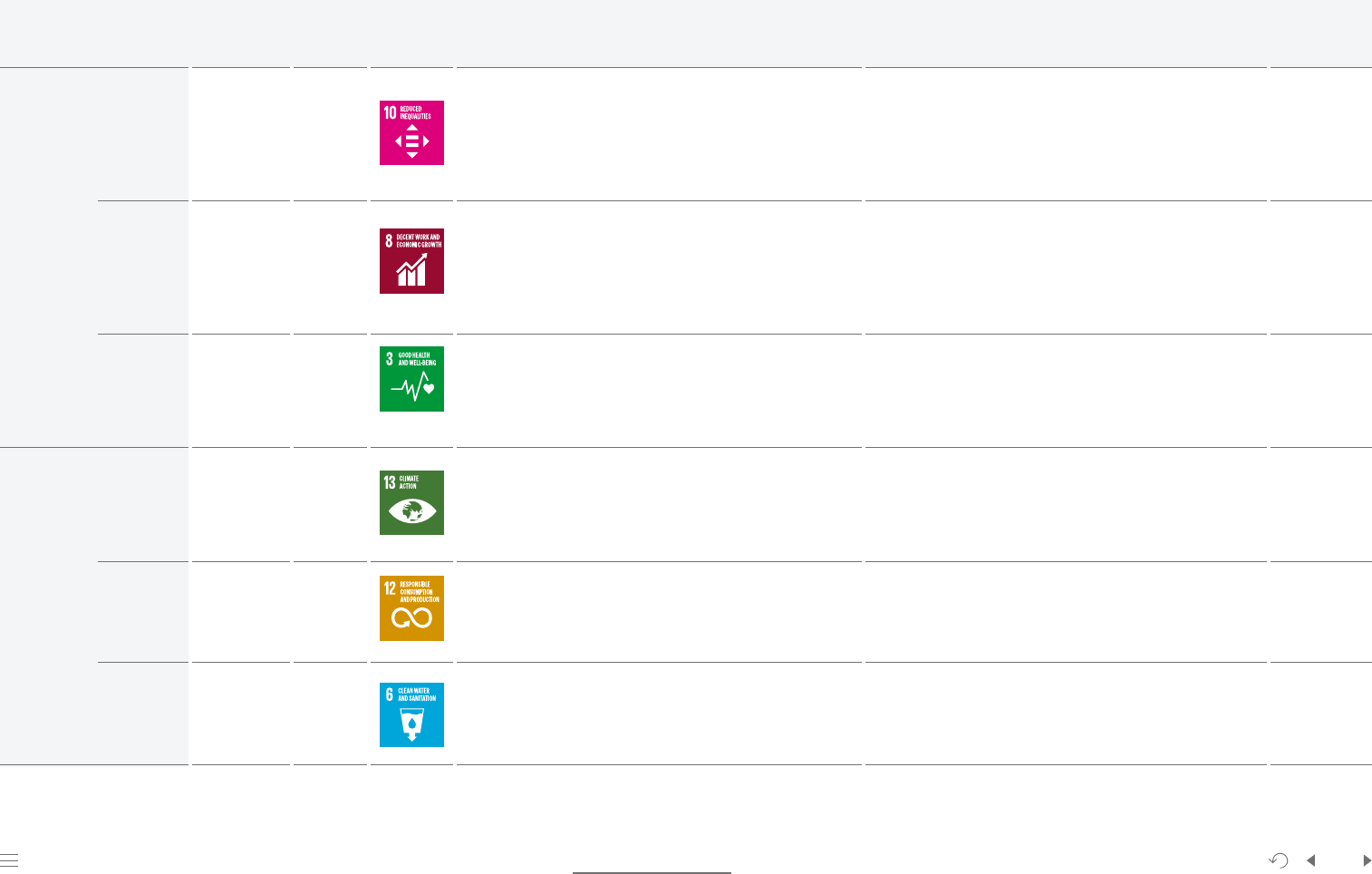
Area Issue
Social and
environmental
impact
Financial
impact
UN SDGs Response Activities
Sections for
reference
Social
Human rights
management
● ●
We ensure that current and potential employees at all of our business
sites are guaranteed equal opportunities. We do not discriminate against
employees or applicants based on their gender, race, ethnicity, nationality,
religion, age, marital status, sexual orientation, sexual identity and
manifestation, social status, disability, pregnancy, military service status,
genetic information, political inclination, etc.
· Expanding employment opportunities for persons with disabilities
· Operating an the in-house advisory group of persons with disabilities for
accessibility improvement
· Launching of Operating Hopes and Stars Forest, a subsidiary-type
workplace for employees with disabilities
· Supporting Employee Resource Group (ERG) activities
Diversity,
Equality, and
Inclusion
Sustainable
supply chain
● ●
We strive to help our suppliers to improve their performance in
human rights, environment, and health and safety as well as their
business competitiveness, to make our supply chain responsible
and environmentally aware.
ESG diagnosis and consulting for suppliers
Working environment and climate change management for suppliers
Establishment and operation of a grievance handling system for
suppliers
Partner collaboration activities such as Partner collaboration academy
and funding support
Sustainability
in Supply Chain
Talent
development
and quality of
life
● ●
We strive to create an environment where our employees can work
without worrying about health and safety. We also focus on minimizing
the impact of harmful chemical substances on the environment and our
employees’ health.
· Regular physical examinations for employees
Access to a Range of Capacity-Building Programs, Opportunities to
Switch Jobs Internally
The UniverSE
SCI(Samsung Culture Index)
Human Rights,
Human
Resource
Management
Environmental
Climate action
and energy
management
● ●
We identify and prioritize climate change issues based on their business
impact and probability of occurrence, analyze risks and opportunities, and
establish response measures accordingly. We strive to reduce our footprint
by investing in GHG emissions reduction equipment and optimizing
operations of our equipment.
Reducing energy for manufacturing and process gases
Expanding use of renewable energy
Identifying and implementing projects of GHG emissions reduction
Monitoring and managing suppliers' GHG emissions
Capturing carbon and reducing particulate matter
Climate Action,
Clean Tech
Ecosystem
Circular
economy
● ●
We reuse and recycle resources to ensure resource circularity and a
minimized environmental impact. We strive to expand the use of recycled
materials, improve product durability, reduce packaging sizes, minimize
the sourcing mining of new resources, and extend product lifecycles.
· Applying recycled and recyclable materials in products
· Researching on technologies contributing to a circular economy
· Expanding e-waste collection system
· Engaging in responsible minerals sourcing
Circular
Economy,
Sustainability
in Supply Chain
Water
resource
management
● ●
We ensure water resource efficiency by reducing water use and reusing
and recycling water. Our in-house standards for wastewater treatment
are more stringent than the legal requirements of individual countries. We
strive to minimize our impact on water resources.
· Monitoring and improving aquatic ecosystems
· Attaining Alliance for Water Stewardship (AWS) Platinum Certification
Sustainability
in Operations
Materiality Assessment Results
The issues of materiality identified through the 2023 double materiality assessment were climate action and energy management, sustainable supply chain, talent development and quality of life , human rights management,
circular economy, water resource management, and diversity and inclusion.
*Materiality:
●
High impact
●
Medium impact
●
Low impact
Our Company AppendixApproach to Sustainability Facts & Figures PrinciplePlanet
115
People
Samsung Electronics Sustainability Report 2023
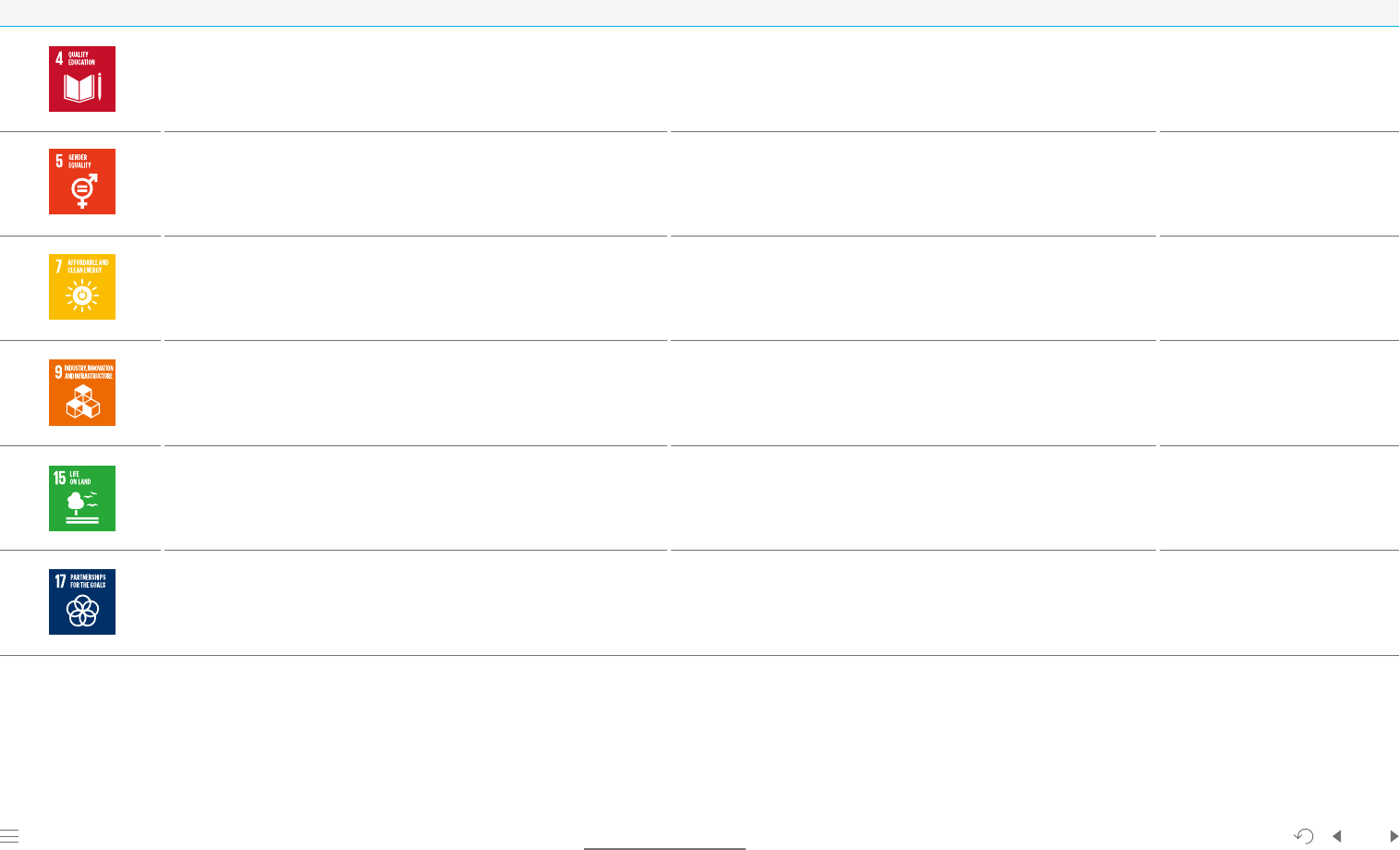
Our Company AppendixApproach to Sustainability Facts & Figures PrinciplePlanet
116
People
Samsung Electronics Sustainability Report 2023
Alignment with UN SDGs
Adopted at the United Nations General Assembly in September 2015, the Sustainable Development Goals (SDGs) aim to mobilize the international community’s efforts to establish a sustainable world by engaging in community
outreach, environmental preservation, and inclusive economic growth activities. The program began in earnest in 2016 with the aim of achieving the goals by 2030. As a responsible corporate citizen, we have strived to help
advance the achievement of the SDGs through our business operations. We have identified the goals with the highest relevance to our business areas and promote various activities according to the goals.
SDGs Objectives Activities Sections for reference
We help youth around the world develop the capabilities required to build a better future
based on our ICT expertise and knowledge.
· Samsung Solve for Tomorrow and Samsung Innovation Campus
· Samsung SW Academy for Youth and Samsung Junior SW Academy
· Samsung Stepping Stone of Hope
Empowering Communities
Based on our belief that access to equal opportunities is the key to economic growth,
political stability, and positive social change, we strive to offer women around the world
various channels to improve their lives.
· Female leadership goals
· Next generation female leader ship workshops
· Global self-diagnoses of gender equality
· Monitoring of gender pay gap
Diversity, Equity, Inclusion
We strive to expand our use of renewable energy to combat climate change. We take a
variety of different measures at our global business sites, from solar panel and geothermal
unit installation to renewable energy supply contracting and green pricing.
· Joining RE100
· Participating in ACEC
· Expanding renewable energy use
Climate Action
We strive to improve the accessibility of our IT devices and technologies to ensure that all
individuals benefit equally from our innovations. We comply with cybersecurity-related
international laws and regulations to protect consumers and maintain world-class product
and service security.
· Developing products based on accessibility technologies
· Reinforcing security based on the Samsung Knox platform
Tech for All
We take action to minimize any possible adverse impacts of our business sites on
biodiversity. We strive to preserve ecosystems by identifying endangered flora and fauna
near our business sites and engaging in activities to protect their habitats.
· Preserving river ecosystems
· Less microfiber cycle and filter in Washer
Sustainability in Operations,
Clean Tech Ecosystem
We share our advanced technologies to contribute to the resolution of a diverse range
of social issues (education, healthcare, employment, and environment). We also operate
programs that have been optimized for different local communities in cooperation with
stakeholders.
· Samsung Global Goals app
· Participation in the government-led Industrial AI Standardization Forum
· Samsung Software Developer Conference
· Samsung Future Technology Cultivation Initiative
Business Sustainability, Tech for All
*See “Materiality Assessment” for details on SDG-aligned activities linked to the issues of materiality

Our Company AppendixApproach to Sustainability Facts & Figures PrinciplePlanet
117
People
Samsung Electronics Sustainability Report 2023
Appendix
118
Independent Assurance Report
119
Verification Statement on Scope 1,2
Greenhouse Gas Emisson
120
Verification Statement on Scope 3
Greenhouse Gas Emisson
121
GRI Index
125
TCFD Index
127
SASB Index
128
About This Report
Our Company AppendixApproach to Sustainability Facts & Figures PrinciplePlanet
117
People
Samsung Electronics Sustainability Report 2023
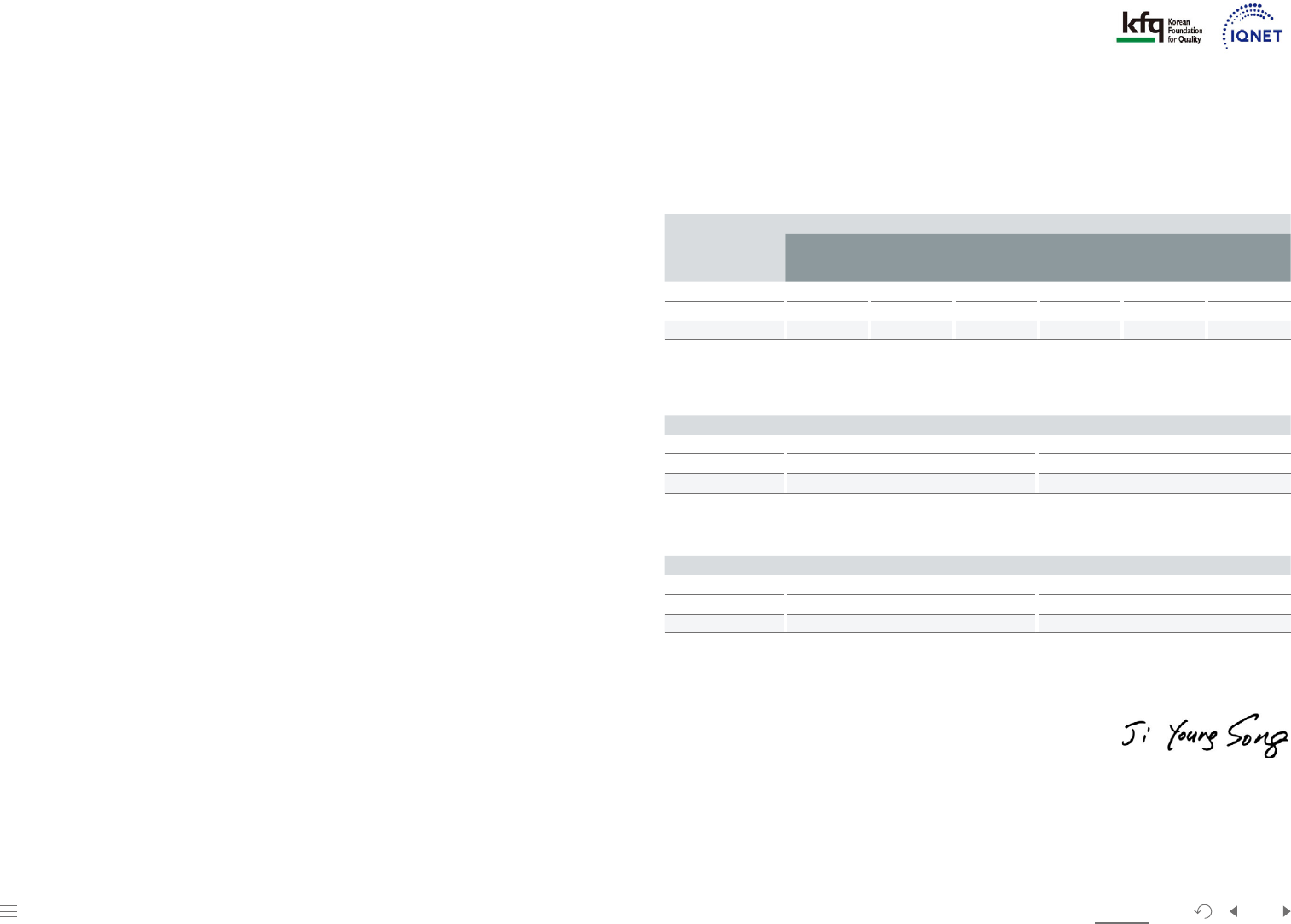
Our Company AppendixApproach to Sustainability Facts & Figures PrinciplePlanet
119
People
Samsung Electronics Sustainability Report 2023
Verification Target
Korean Foundation for Quality (hereinafter “KFQ”) has conducted the verification of “2022 Report on Quantity of emitted
Greenhouse gas Consumption (hereinafter ‘Inventory Report”) for Samsung Electronics Co..,Ltd (hereinafter “Company”)
Verification Scope
In this verification, domestic corporations and 25 overseas subsidiaries under operational control of Samsung Electronics
Co.,Ltd , and reported emission is including Scope 1 and Scope 2 emission.
Verification Criteria
The verification process was based on ‘Rules for verification of operating the greenhouse gas emission trading scheme
(Notification No. 2022 279 of Ministry of Environment)’, GHG Protocol Scope 2 Guidance’ and ‘ISO 14064-1,32006’
Level of Assurance
The Verification has been planned and conducted as the ‘Rules for verification of operating the greenhouse gas emission
trading scheme’, and the level of assurance for verification shall be satisfied as reasonable level of assurance. And it
confirmed through the internal review whether the process before the verification conducted effectively.
Verification Limitation
Accuracy and completeness of emission data reported in the ‘GHG Inventory’ are subject to inherent limitations due to their
nature and the methodology used in determining, calculating and estimating such data.
Verification Opinions
Through the verification process according to the ‘ISO 14064-32006’ KFQ could obtain reasonable basis to express following
conclusion on the Greenhouse Gas Emission Report
1) 2022 Samsung Electronics Co.,Ltd ., Greenhouse Gas Emission Report was prepared against ‘Samsung Electronics Co.,Ltd
., Greenhouse Gas Inventory Guideline’ developed based on the ‘Guidelines for GHG emission reporting and certification of
GHG emission trading scheme’, GHG Protocol Scope 2 Guidance’ and ‘ISO 14064-12006’
2) As a result of materiality assessment on 2022 domestic Greenhouse Gas Emission, material discrepancy is less than the
criteria of 2.0% for the organization which emits more than 5,000,000 tCO
2
eq/year in accordance with the requirements
of the ‘Guidelines of verification for Greenhouse gas emission trading scheme’.
3) For the 25 overseas subsidiaries, document review was conducted for entire 25 subsidiaries as well as Company self
assessment. The result of material discrepancy is less than 2.0%.
4) The efficiency of process emission reduction technology that affects the calculation of greenhouse gas emissions has to
reflect the values guaranteed by the government and third parties. However, the efficiency was calculated based on the
Company’s' own methodology, and errors are not included in the verification opinion.For the overseas subsidiaries, each
national net caloric value and electricity emission factor were preferentially used but net caloric value and electricity
emission factor were adopted from IPCC Guidelines or Korean Energy Law Enforcement Regulation in any change of these
parameters or factors. Also, in case of buying credits(ex. RECs) in the market, the offset credit is applied to evaluate the
emission and record separately in market base section.
5) Except unconsidered emission source in the ‘Samsung Electronics Co.,Ltd , Greenhouse Gas Inventory Guideline’, material
error, omission or insignificant issues was not found in 2022 Samsung Electronics Co.,Ltd ., Greenhouse Gas Emission
Verification Statement on 2022 Scope1, 2 Greenhouse Gas Emisson Report
GHG Emission verification results
(Unit: ktCO
2
eq)
Division
Total Domestic Overseas
Location
based
Market
based
Location
based
Market
based
Location
based
Market
based
Scope 1 5,972 5,972 5,100 5,100 872 872
Scope 2 13,920 9,081 9,830 8,935 4,090 146
Total 19,892 15,053 14,930 14,035 4,962 1,018
DX GHG Emission verification results
(Unit: ktCO
2
eq)
Division Location based Market based
Scope 1 254 254
Scope 2 1,681 112
Total 1,935 366
DS GHG Emission verification results
(Unit: ktCO
2
eq)
Division Location based Market based
Scope 1 5,718 5,718
Scope 2 12,239 8,969
Total 17,957 14,687
April 18
th
2023
CEO Ji Young Song
Korean Foundation for Quality
Organization
Samsung Electronics Co..,Ltd
Emission calculation period
The emission caculation period is from January 1 to December 31, 2022
Total emissions may differ ±1 ktCO
2
eq due to rounding differences in the summation process.
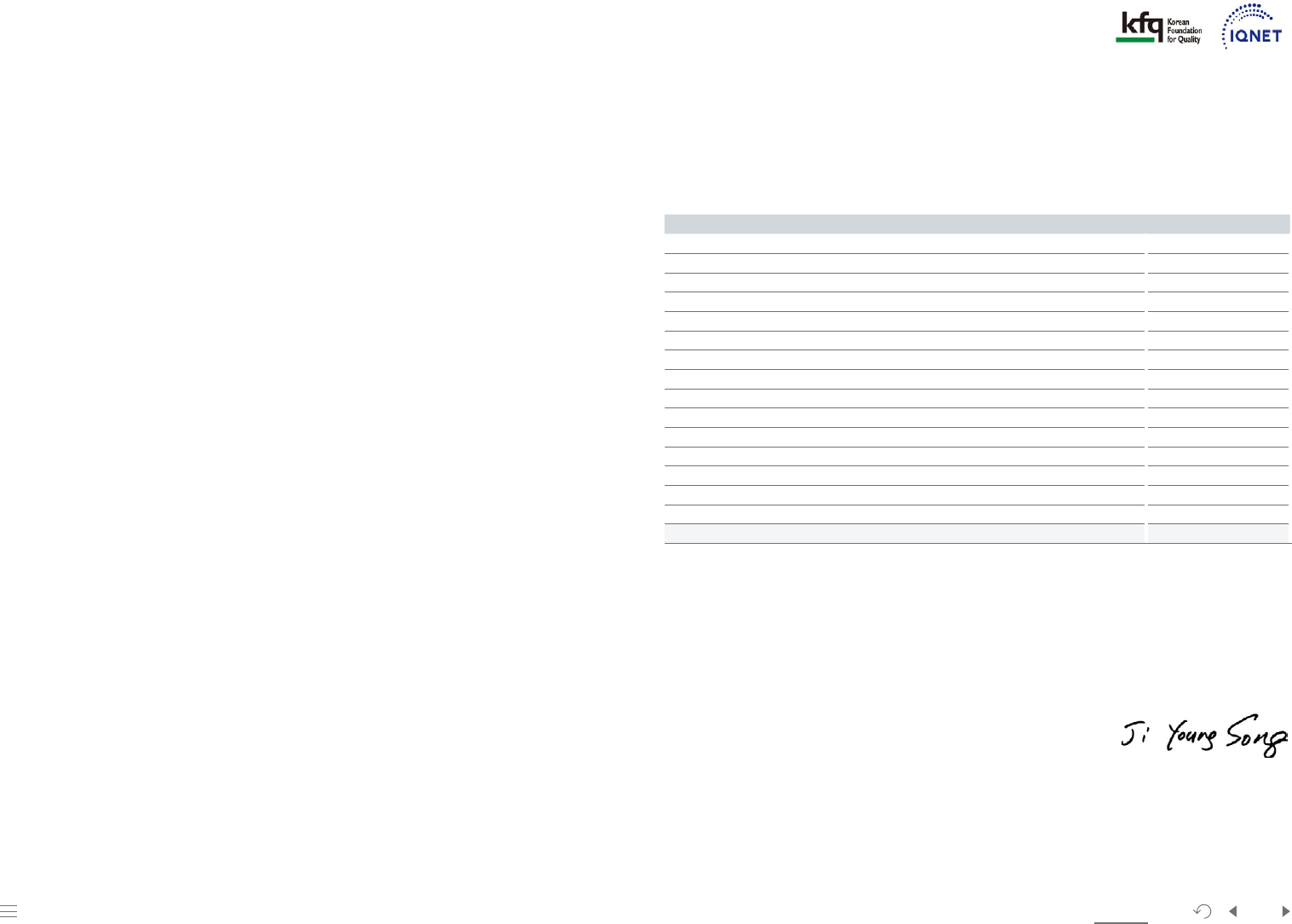
Our Company AppendixApproach to Sustainability Facts & Figures PrinciplePlanet
120
People
Samsung Electronics Sustainability Report 2023
Organization
Samsung Electronics Co..,Ltd
Emission calculation period
The emission caculation period is from January 1 to December 31, 2022
Company Scope3 Emissions verification Results
(Unit: ktCO
2
eq)
Category Scope3 Emissions
Purchased goods & services 14,596
Capital goods 1,508
Fuel-and Energy-Related Activities Not Included in Scope1 or Scope2 900
Upstream Transportation and Distribution 3,965
Waste Generated in Operations 246
Business Travel 87
Employee Commuting 303
Upstream Leased Assets 107
Downstream Transportation and Distribution 366
Processing of sold products 142
Use of Sold Products 101,236
End-of-Life Treatment of Sold Products 1,206
Downstream Leased Assets 1
Franchise N/A
Investments 52
Total 124,715
Data used for calculating suppliers' emissions - in the categories of Purchased goods & services, Capital goods, and Processing of sold
products - are based on 2021.
Verification Statement on 2022 Scope3 Greenhouse Gas Emisson Report
Verification Target
Korean Foundation for Quality (hereinafter ‘KFQ’) has been engaged by Samsung Electronics Inc. to independently verify
its 2022 Scope3 Greenhouse Gas Emissions and Energy consumption Report (hereinafter ‘GHG Inventory’). This verification
is for the purpose of a limited guarantee that Scope3 is free from material errors and distortions in technical content.
Verification Scope
The verification of other indirect emissions (Scope 3) was carried out in the self selected category according to the following
criteria.
* Verification Category: Purchased goods & services, Capital goods, Fuel and Energy Related Activities Not Included in Scope1 or
Scope2, Upstream Transportation and Distribution, Waste Generated in Operations, Business Travel, Employee Commuting, Upstream
Leased Assets, Downstream Transportation and Distribution, Processing of Sold Products, Use of Sold Products, End of Life Treatment
of Sold Products, Downstream Leased Assets, Investments
Verification Criteria
Technical Guidance for Calculating Scope 3 Emissions, Carbon Emission Factor (Korea Environmental Industry Institute),
World Resource Institute (WRI), GHG Emissions Calculating tool emission factor, National LCI database information network
and overseas information network, etc.
Level of Assurance
The verification was performed according to the procedure stipulated in ISO 14064-3, and through the verification and
cross validation of the Scope3 emission calculation results, there is limited assurance that the data applied to the emission
calculation is accurate and that the emission is calculated appropriately according to the verification criteria above. We
planned and conducted verification to obtain.
Verification Limitation
This verification is not for the purpose of verifying the validity of the calculation criteria set by the company itself. Assurance
results contain inherent limits of uncertainty inherent in the company's own calculation standards. Depending on our own
calculation standards, significant differences may occur in the emission calculation results, which may affect comparability.
Verification Opinions
Through the verification process according to the ‘ISO 14064-32006’ KFQ could obtain reasonable basis to express following
conclusion on the Greenhouse Gas Emission Report.
1) Scope 3 emissions for 2022 of Samsung Electronics Co., Ltd. were properly calculated according to verification standards.
2) For Scope 3 emissions, no significant errors or omissions were found, except for emissions information that was not
considered within the scope of the selected category. In the process of estimating the emissions, it was confirmed that the
estimates were reasonably based on objective grounds so that the emissions were not underestimated or overestimated
when estimating some activity data.
3) The standards set, estimated/assumed, and the relevant process when calculating emissions were transparently reflected
in the internal calculation process.
4) No material errors, omissions or inappropriate matters were found in the 2022 Scope 3 emission information and data
of Samsung Electronics Co., Ltd., except for emissions information not considered in the Samsung Electronics Co., Ltd.
greenhouse gas calculation guidelines.
April 21
th
2023
CEO Ji Young Song
Korean Foundation for Quality
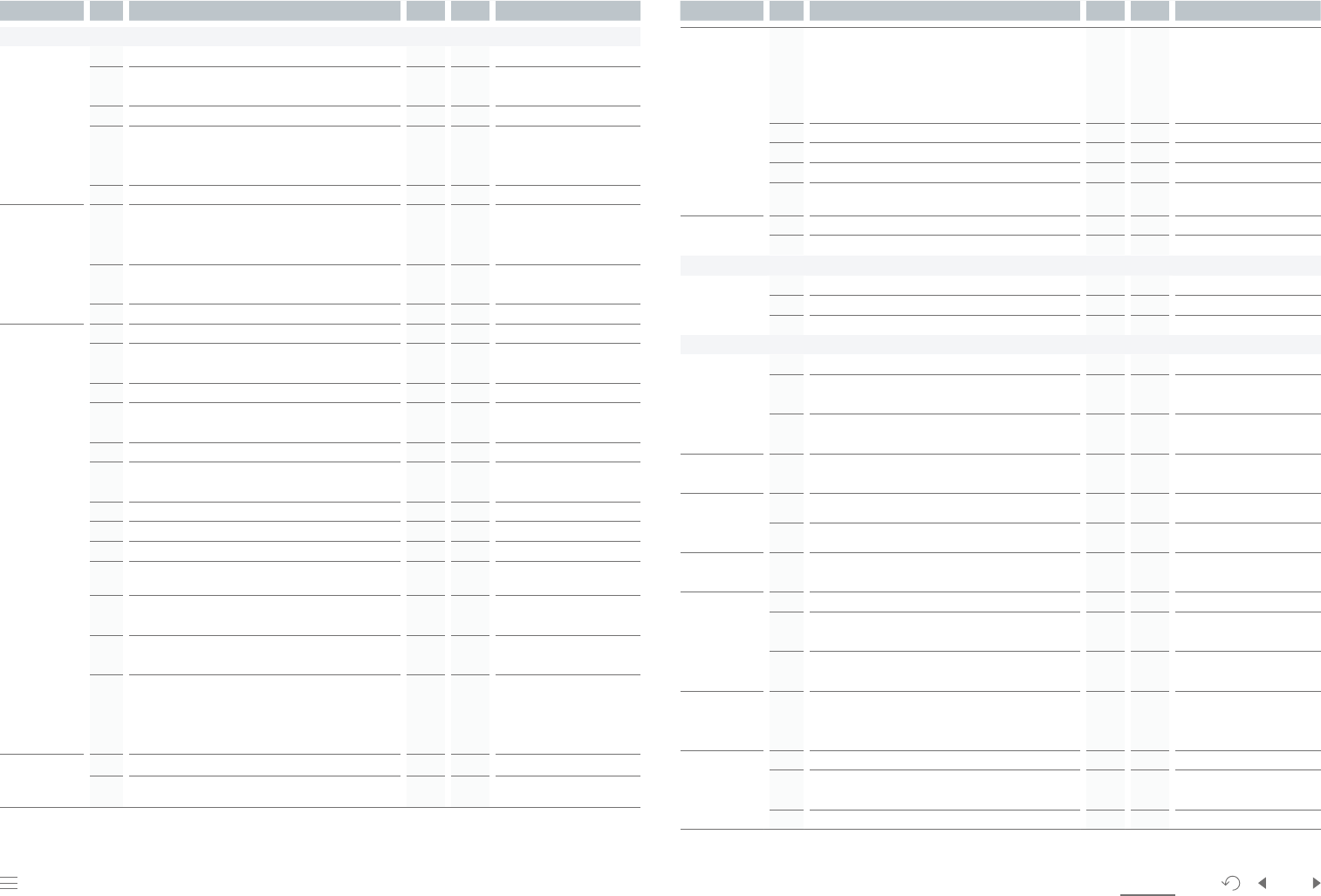
Our Company AppendixApproach to Sustainability Facts & Figures PrinciplePlanet
121
People
Samsung Electronics Sustainability Report 2023
GRI 3 Universal Standards
Disclosures on
Material Topics
3-1 Processes to determine material topics
114-115
3-2 List of material topics
114-115
3-3 Management of material topics
114-115
GRI 200 Economy
Economic
Performance
201-1 Direct economic value generated and distributed
101
201-2
Financial implications and other risks and
opportunities due to climate change
124
201-3
Define benefit plan obligations and other retirement
plans
-
Refer to the Annual Business
Report
Market Presence
202-1
Ratios of standard entry level wage by gender
compared to local minimum wage
43, 60,
79
Indirect
Economic
Impacts
203-1 Infrastructure investments and services supported
87-92
203-2 Significant indirect economic impacts
87-92
Procurement
Practices
204-1 Proportion of spending on local suppliers
X
Anti-corruption
205-1 Operations assessed for risks related to corruption
97-99
205-2
Communication and training about anti-corruption
policies and procedures
97-99
205-3 Confirmed incidents of corruption and actions taken
Refer to the Annual Business
Report
Anti-
competitive
Behavior
206-1
Legal actions for anti-competitive behavior, anti-trust,
and monopoly practices
Refer to the Annual Business
Report
Tax
207-2 Tax governance, control, and risk management
Refer to the Website
207-3
Stakeholder engagement and management of
concerns related to tax
Refer to the Website
207-4 Country-by-country reporting
101
GRI Index
GRI Standards No. Disclosures Status Page Notes
GRI 2 Universal Standards
The organization
and its reporting
practices
2-1 Organizational details
5, 6
2-2
Entities included in the organization’s sustainability
reporting
Refer to the Annual
Business Report
2-3 Reporting period, frequency and contact point
128
2-4 Restatements of information
X
Disclose the changes to the
report
2-5 External assurance
118
Activities and
workers
2-6 Activities, value chain and other business relationships
4-5, 6,
74-86
Refer to the Annual Business
Report
2-7 Employees
103-
104
2-8 Workers who are not employees
103
Governance
2-9 Governance structure and composition
94-96
2-10
Nomination and selection of the highest governance
body
94-96
2-11 Chair of the highest governance body
94-96
2-12
Role of the highest governance body in overseeing the
management of impacts
7, 94-
96
2-13 Delegation of responsibility for managing impacts
96
2-14
Role of the highest governance body in sustainability
reporting
96
2-15 Conflicts of interest
94-96
2-16 Communication of critical concerns
94-96
2-17 Collective knowledge of the highest governance body
96
2-18
Evaluation of the performance of the highest
governance body
94-96
2-19 Remuneration policies
Refer to the Annual
Business Report
2-20 Process to determine remuneration
Refer to the Annual
Business Report
2-21 Annual total compensation ratio
X
We made the decision to
keep this information private
based on the necessities of
our company.
Strategy,
Policies, and
Practices
2-22 Statement on sustainable development strategy
4
2-23 Policy commitments
97-99 Refer to the Website
GRI Standards No. Disclosures Status Page Notes
Strategy,
Policies, and
Practices
2-24 Embedding policy commitments
16, 24,
42, 43,
47, 59,
66, 71,
76, 79,
80
2-25 Processes to remediate negative impacts
43, 48
2-26 Mechanisms for seeking advice and raising concerns
97-99
2-27 Compliance with laws and regulations
110 Refer to the website
2-28 Membership associations
7, 40,
86
Stakeholder
Engagement
2-29 Approach to stakeholder engagement
7
2-30 Collective bargaining agreements
43, 77
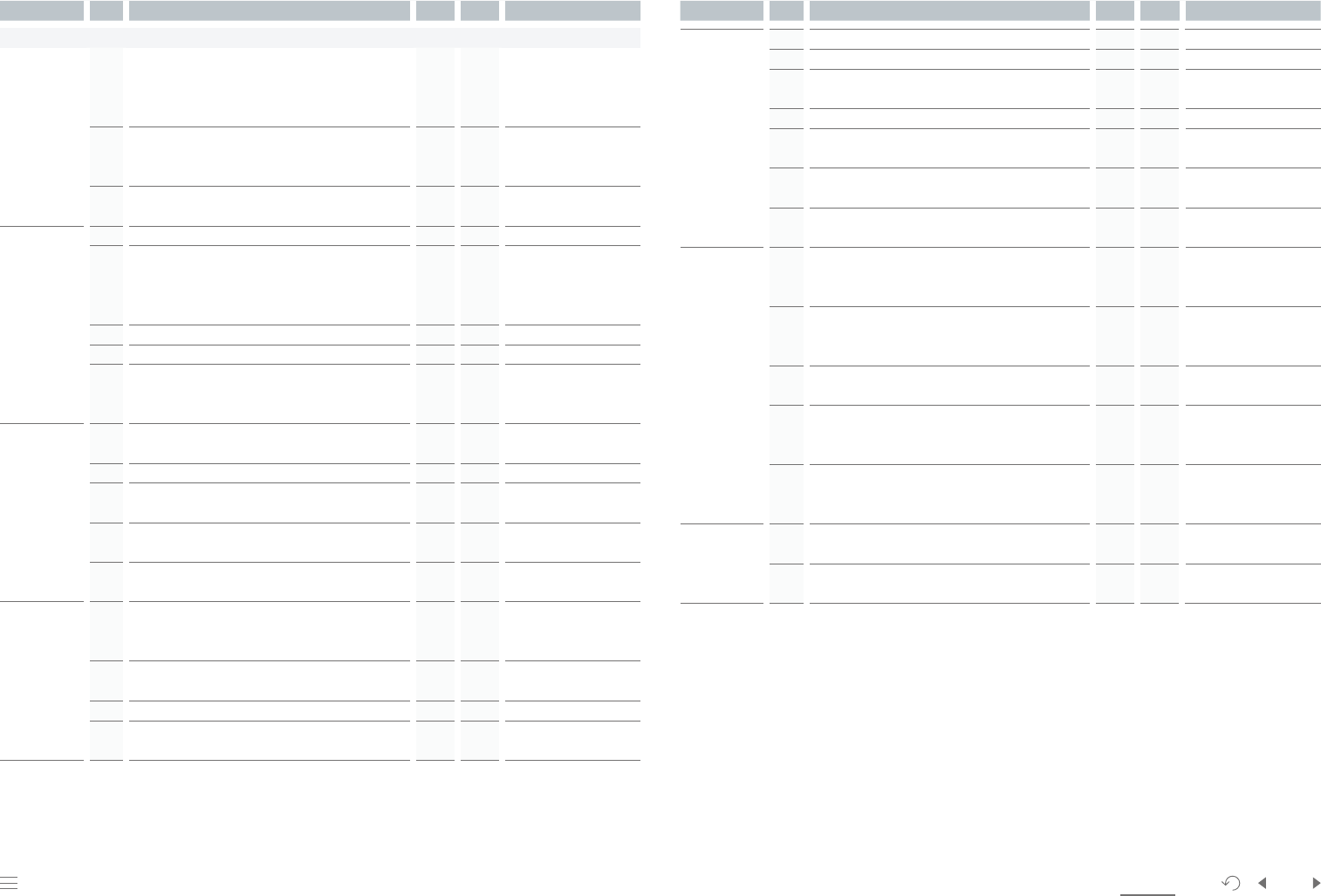
Our Company AppendixApproach to Sustainability Facts & Figures PrinciplePlanet
122
People
Samsung Electronics Sustainability Report 2023
GRI Index
GRI Standards No. Disclosures Status Page Notes
GRI 300 Environment
Materials
301-1 Materials used by weight or volume
X
We made the decision
to keep this information
private based on the
necessities of our company.
301-2 Recycled input materials used
24-26,
108-
109
301-3 Reclaimed products and their packaging materials
108-
109
Energy
302-1 Energy consumption within the organization
22, 108
302-2 Energy consumption outside of the organization
X
We made the decision
to keep this information
private based on the
necessities of our company.
302-3 Energy intensity
108
302-4 Reduction of energy consumption
20-24
302-5
Reductions in energy requirements of products and
servcies
10-13,
16, 21,
24
Water and
Effluents
303-1 Interactions with water as a shared resource
35-37,
110-111
303-2 Management of water discharge-related impacts
35-37
303-3 Water withdrawal
35-37,
110-111
303-4 Water discharge
35-37,
110-111
303-5 Water consumption
35-37,
110-111
Biodiversity
304-1
Operational sites owned, leased, managed in, or adjacent
to, protected areas and areas of high biodiversity value
outside protected areas
37
304-2
Significant impacts of activities, products, and services
on biodiversity
37
304-3 Habitats protected or restored
37
304-4
IUCN Red List species and national conservation list
species with habitats in areas affected by operations
37
Emissions
305-1 Direct (Scope 1) GHG emissions
108, 111
305-2 Energy indirect (Scope 2) GHG emissions
108, 112
305-3 Other indirect (Scope 3) GHG emissions
108,
113
305-4 GHG emissions intensity
108
305-5 Reduction of GHG emissions
17, 21,
23-24
305-6 Emissions of ozone-depleting substances (ODS)
108,
110
305-7
Nitrogen oxides (NOx), sulfur oxides (SOx), and other
significant air emissions
110
Waste
306-1 Waste generation and significant waste-related impacts
25-29,
108-
109
306-2 Management of significant waste-related impacts
25-29,
108-
110
306-3 Waste generated
25-29,
108-111
306-4 Waste diverted from disposal
25-29,
32-33,
110
306-5 Waste directed to disposal
25-29,
32-33,
111
Supplier
Environmental
Assessment
308-1
New suppliers that were screened using environmental
criteria
74, 84,
105
308-2
Negative environmental impacts in the supply chain and
actions
74
GRI Standards No. Disclosures Status Page Notes
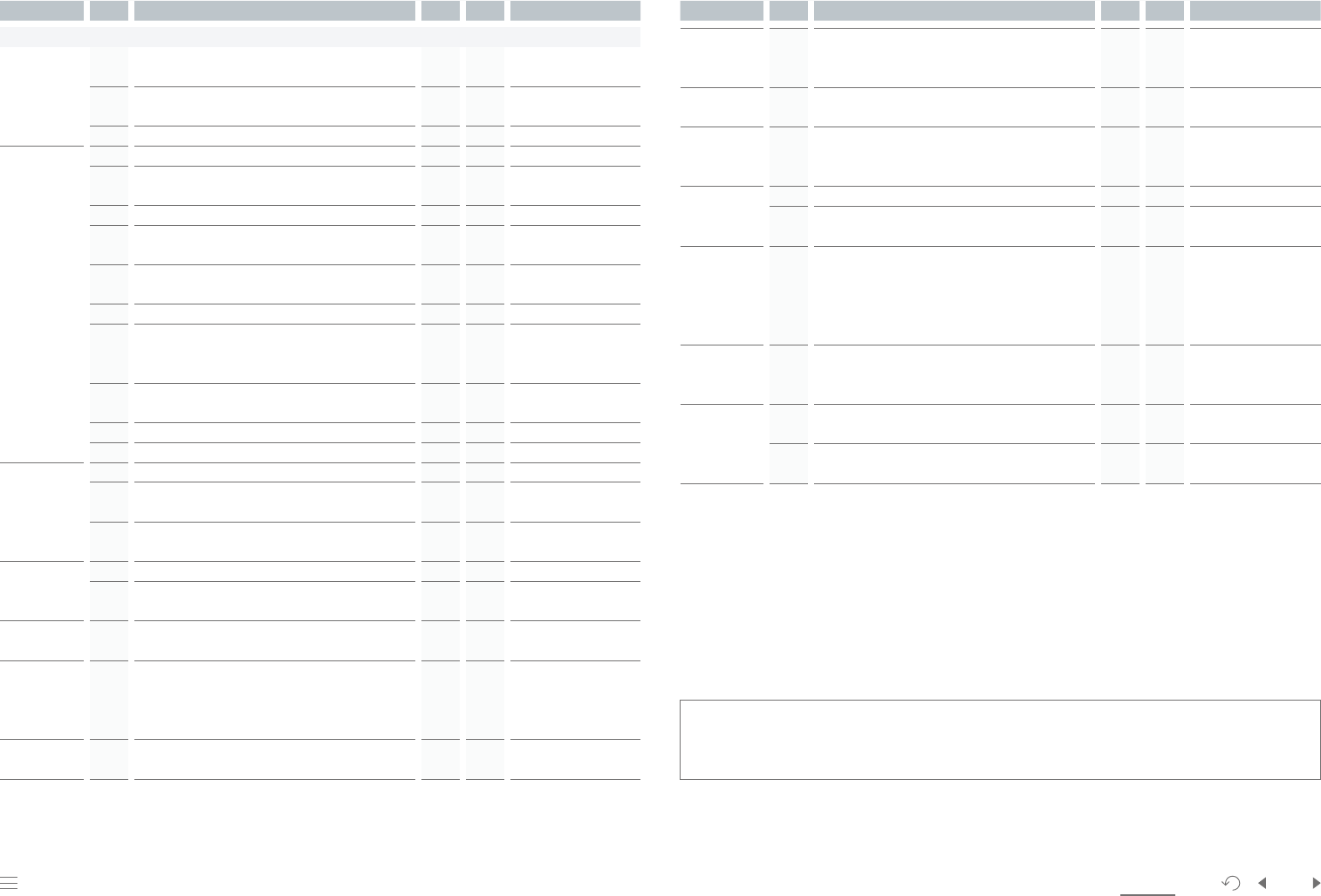
Our Company AppendixApproach to Sustainability Facts & Figures PrinciplePlanet
123
People
Samsung Electronics Sustainability Report 2023
GRI Standards No. Disclosures Status Page Notes
GRI 400 Society
Employment
401-1 New employee hires and employee turnover
103-
104
401-2
Benefits provided to full-time employees that are not
provided to temporary or part-term employees
57-58
401-3 Parental leave
104
Occupational
Health and
Safety
403-1 Occupational health and safety management system
50-53
403-2
Hazard identification, risk assessment, and incident
investigation
50-53
403-3 Occupational health services
50-53
403-4
Worker participation, consultation, and communication
on occupational health and safety
50-53
403-5 Worker training on occupational health and safety
50-53
403-6 Promotion of worker health
50-53
403-7
Prevention and mitigation of occupational health and
safety impacts directly linked by business relationships
50-53
403-8
Workers covered by an occupational health and safety
management system
50-53
403-9 Work-related injuries
104
403-10 Work-related ill health
85
Training and
Education
404-1 Average hours of training per year per employee
105
404-2
Programs for upgrading employee skills and transition
assistance programs
54-56
404-3
Percentage of employees receiving regular performance
and career development reviews
55
Diversity
and Equal
Opportunity
405-1 Diversity of governance bodies and employees
59-60
405-2 Ratio of basic salary and remuneration of women to men
60
Non-
discrimination
406-1 Incidents of discrimination and corrective actions taken
48
Freedom of
Association
and Collective
Bargaining
407-1
Operations and suppliers in which the right to freedom
of association and collective bargaining may be at risk
43-44,
77
Child Labor
408-1
Operations and suppliers at significant risk for incidents
of child
44, 80,
86
GRI Index
Forced or
Compulsory
Labor
409-1
Operations and suppliers at significant risk for incidents
of forced or compulsory labor
42, 44,
74, 80
Security
Practices
411-1
Security personnel trained in human rights policies or
procedures
N/A
Local
Communities
413-1
Operations with local community engagement, impact
assessments, and development programs
33, 45,
47, 87-
92
Supplier Social
Assessment
414-1 New suppliers that were screed using social criteria
105
414-2
Negative social impacts in the supply chain and actions
taken
74-82
Public Policy
415-1 Political contributions
Use of company funds for
political contributions
is prohibited by the
corporate Code of
Conduct
Customer Health
and Safety
416-2
Incidents of non-compliance concerning the health and
safety impacts of products and services
Refer to the Annual
Business Report
Marketing and
Labeling
417-1
Requirements for product and service information and
labeling
Refer to the Website
417-3
Incidents of non-compliance concerning marketing
communications
Refer to the Annual
Business Report
GRI Standards No. Disclosures Status Page Notes
· Statement of Use: Samsung Electronics has reported in accordance with the GRI standards for the covered period (from
January to December, 2022) .
· GRI 1 used: GRI 1 : Foundation 2021
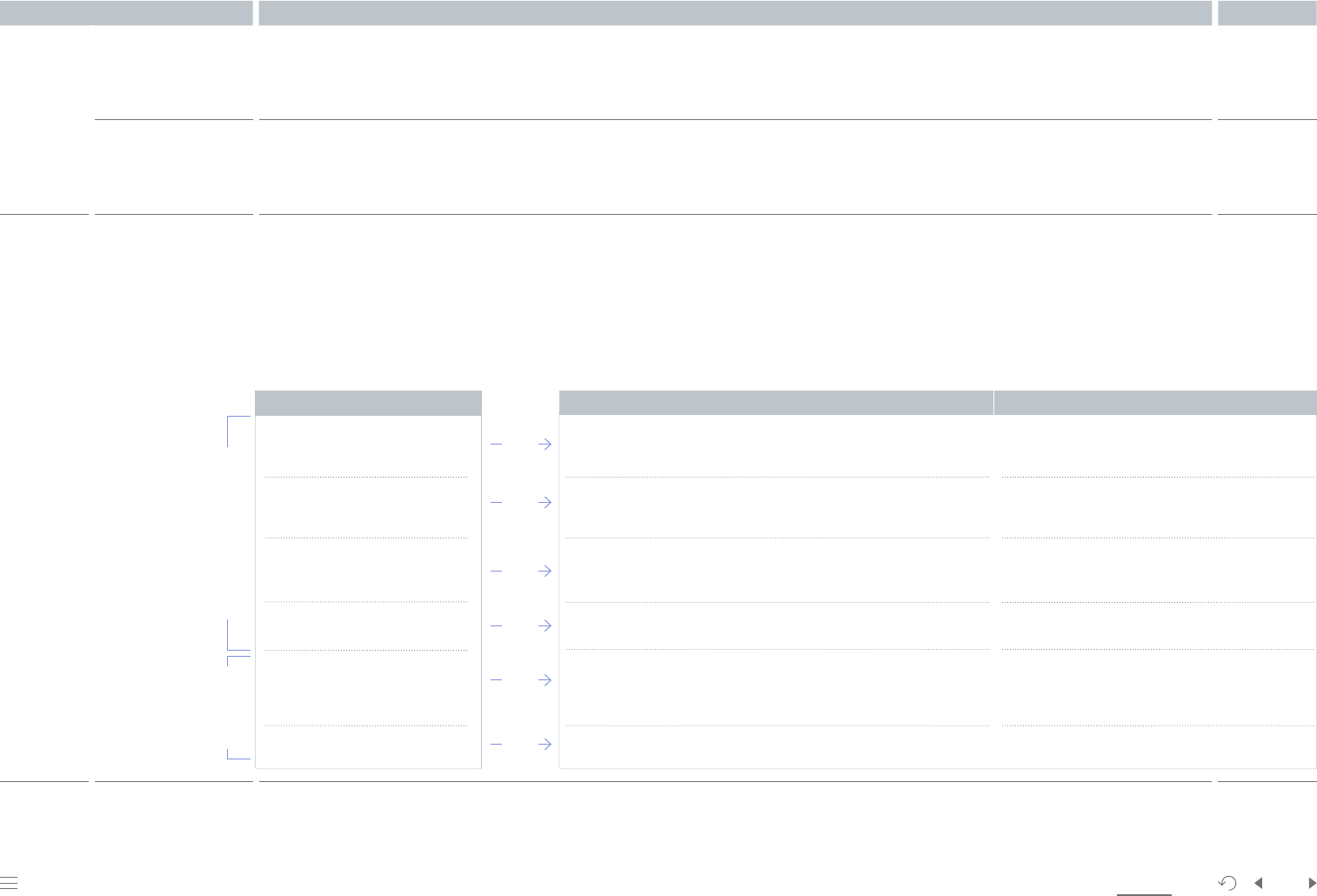
Our Company AppendixApproach to Sustainability Facts & Figures PrinciplePlanet
124
People
Samsung Electronics Sustainability Report 2023
TCFD Index
Category Our Performance Page
Governance a) Describe the board's over-
sight of climate-related
risks and opportunities.
We believe all environmental issues, including climate change, directly affect our business operations and financial performance. As such, these issues are supervised by the Board of Direc-
tors, our overarching decision-making body. The Board of Directors approves all strategies and goals related to environmental management, oversees their latest developments, and regu-
larly reviews our relevant activities through the Sustainability Committee comprised of independent directors. Our corporate environmental strategy encompassing mid-to-long-term climate
actions and resource circularity goals was passed by the Sustainability Committee in September 2022.
P.20, P.96,
P.124
CDP: C1
b) Describe management's
role in assessing and man-
aging climate-related risks
and opportunities.
The CEO establishes environmental management plans and reviews implementation progress through the Sustainability Council composed of the top executives of relevant units. We continue
to reinforce our environmental management capacity by strengthening environmental indicators in the performance evaluations of our business units. In addition, the Environmental Man-
agement Task Force defines action items/projects - including those related to climate action - and monitors progress. Each business manages and monitors their environmental issues on site
through their respective EHS meetings. The Eco-Council establishes strategies for developing environmentally responsible products while ensuring their quality.
P.20,
P.96,
P.124
CDP: C1
Strategy a) Describe the climate-re-
lated risks and opportuni-
ties the organization has
identified over the short,
medium, and long term.
The risks and opportunities posed by climate change are affecting our products and services, as well as our manufacturing processes, supply chain, R&D, and other business activities. Sam-
sung Electronics monitors the risks arising from its global operations in accordance with risk management processes and manuals in each field, including environmental safety, climate change
and energy, and compliance. To understand the financial impact of risks and opportunities arising from climate change, Samsung Electronics categorizes risk factors into transition risks and
physical risks and analyzes the risks; while and opportunities arising from them. In the short term, we see rising carbon credit prices, extreme weather events, and the introduction of high-ef-
ficiency technologies as potential risks, securing carbon credits and reducing energy costs are recognized as opportunities. In the medium term, we anticipate changing consumption patterns
and expansion of renewable energy use as opportunities, and physical impacts such as rising temperatures as long-term risks. For long-term risks, we establish response plans in line with
the Nationally Determined Contributions (NDCs) under the Paris Agreement, the Representative Concentration Pathways (RCP) scenarios of the International Panel on Climate Change (IPCC)
assessment report, and the International Energy Agency's (IEA) energy technology outlook.
P.22-23,
P.124
CDP: C2
Transition Risk and Opportunity
Physical Risk
and
Opportunity
Short-
Term
· Emission allowance prices falling due to the post-pandemic economic
slowdown - dropped to KRW 11,550 on the same day (April 27, 2023)
* Refer to Annual Business Report
· Minimize purchases with greenhouse gas reduction activities
· Mitigate carbon price sensitivity by securing external carbon
credits
· Increased investment in high-efficiency facilities, greenhouse gas reduction facil-
ities, and water recycling facilities
· Reduce workplace GHG emissions and reduce energy costs
· Create business opportunities such as energy management
systems
· High-efficiency and environmental product certification costs increased
· Sales of low-energy efficiency products decreased
· R&D investment in high-efficiency and environmentally responsible products increased
· Increase sales of launching high-efficiency, environmentally
responsible products
· Consumers’ awareness raised
· Production costs increased due to a short-term electricity price spike
· Customers’ demand for renewable energy
· Electricity expenses reduced through renewable energy sup-
ply contracts and participation in power generation projects
· Investment in environmental/safety/disaster prevention equipment increased
· Costs related to restoration and business opportunity loss in the event of natural
disasters increased
· Reducing insurance premiums by investing in facilities to
respond to natural disasters
· Creating new business opportunities such as national disaster
networks and safety communication networks
· Increased costs of operational costs such as cooling and heating facilities
· Increased investment in air-pollution prevention facilities
· Business expanded and sales increased (e.g., high-efficiency
air conditioners, air purifiers, dryers)
Climate Change Risks and Opportunities
❶
GHG emissions trading scheme
❷
High-efficiency technology
development
❸
Customer consumption pattern
changes
❹
Expansion of renewable energy
consumption
❺
Natural disasters
(e.g., storms, floods)
❻
Temperature rise and yellow sand
dust pollution
Financial Impacts of Climate Change Risks Financial Impacts of Climate Change Opportunities
Short-
Term
Mid-
Term
Mid-
Term
Short-
Term
Long-
Term
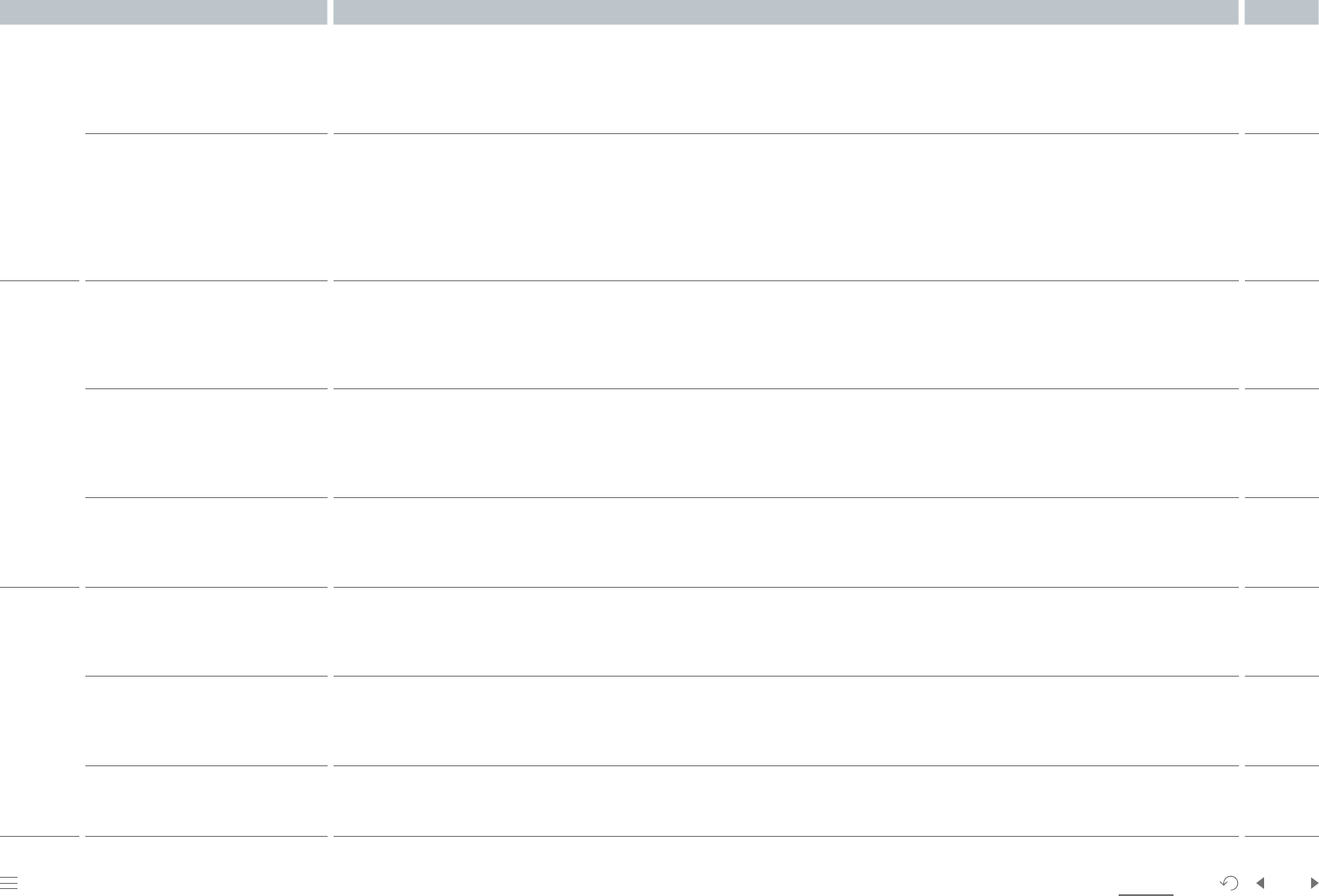
Our Company AppendixApproach to Sustainability Facts & Figures PrinciplePlanet
125
People
Samsung Electronics Sustainability Report 2023
TCFD Index
Category Our Performance Page
Strategy b) Describe the impact of climate-related risks
and opportunities on the organization’s busi-
nesses, strategy, and financial planning.
As climate change continues to have adverse effects around the world, many countries are strengthening their relevant regulations. The costs related to natural disaster recovery
and lost business opportunities are expected to rise in line with the aggravation of climate change. We continue to make investments in the areas of environment and safety and
disaster-proof equipment to preempt the impacts of natural disasters as much as possible, which in turn is expected to decrease our insurance premiums.
As a company subject to Korea’s emissions trading scheme, we project that our costs for responding to reinforced GHG emissions regulations and renewable energy purchasing will
inevitably increase. In addition, failure to comply with global regulations and implement proper climate actions may compromise our brand value and adversely affect our sales.
P.124
CDP: C3.3,
C3.4
c) Describe the resilience of the organization’s
strategy, taking into consideration different
climate-related scenarios, including a 2°C or
lower scenario.
Climate risks are anticipated to have far-reaching effects through a set of highly complex channels. We strive to identify the socioeconomic impacts of climate change on our business
through various scenarios, which are classified into aggressive action scenarios that require our global stakeholders to reach more ambitious targets and passive action scenarios
that focus on maintaining the status quo.
In accordance with the aggressive action scenarios, products with low energy efficiency ratings are projected to decrease in sales in the long term, while environmentally responsible ,
high-efficiency products- including air conditioners, air purifiers, and dryers - are expected to record continued sales growth. To remain prepared for such scenarios, we plan to make
continued investments to develop ultra-low-power semiconductors and improve energy efficiency across our product categories. We will also take active measures to ensure GHG
emissions mitigation and the transition to renewable energy.
P.124
CDP: C3.2a,
C3.4
Risk
Management
a) Describe the organization’s processes for
identifying and assessing climate-related
risks.
Our climate risks concerning business operations, product planning, and industry trends are assessed regularly by related organizational units - including EHS, marketing, sales, and
compliance - based on the environmental management frameworks of ISO 14001 and ISO 50001. Individual business sites are required to enter their GHG data - including electricity,
fuel, and process gases - into the EHS System, and we review their changes on a monthly basis and analyze the causes of such changes. The organizational units in charge manage
GHG emissions of our business sites in Korea and other regions in an integrated manner. Annual third-party audits are conducted to ensure the credibility and alignment of emissions
data.
P.20
CDP: C2.1b,
C2.2
b) Describe the organization’s processes for
managing climate-related risks.
To manage climate risks, the corporate unit in charge EHS monitors our energy consumption, GHG emissions, and renewable energy use as well as the physical impacts of climate
change. Relevant issues affecting or expected to affect our business sites around the world are discussed at the EHS Council and other regularly convened consultative bodies to seek
optimal solutions.
The Sustainability Council discusses relevant risks and opportunities from a company-wide perspective and makes necessary decisions. The Eco-Council examines climate change-in-
duced business opportunities and shares the findings with pertinent organizational units for execution.
P.18, P.20
CDP: 2.2,
2.2a
c) Describe how processes for identifying,
assessing, and managing climate-related
risks are integrated into the organization’s
overall risk management.
Given the large amount of energy required in manufacturing semiconductors, the prices of emissions permit and renewable energy use are considered factors that directly affect our
business and are thus closely monitored. In addition, climate change-related regulations of individual countries are included in our company-wide risk management system since
they are likely to influence our business activities and reputation.
P.20, P.124
CDP: 2.2
Metrics and
Targets
a) Disclose the metrics used by the organization
to assess climate related risks and opportu-
nities in line with its strategy and risk man-
agement process.
To assess and manage the risks and opportunities related to climate change, we closely monitor metrics including GHG emissions, per-unit GHG emissions, energy consumption,
renewable energy use, and water consumption of individual business sites as well as the ratio of recycled materials used in products, amount of e-waste collected, and average power
consumption of products.
P.18,
P.20-24
CDP: C6, C7,
C8
b) Disclose Scope 1 (direct emissions), Scope 2
(indirect emissions), and Scope 3 (miscella-
neous indirect scope) greenhouse gas (GHG)
emissions, and the related risks.
We disclose our Scope 1, 2, and 3 emissions via the Sustainability Report and CDP Report. P.108,
P.112
CDP: C6, C7,
C8
c) Describe the targets used by the organization
to manage climate-related risks and oppor-
tunities and performance against targets.
Please refer to the targets of the New Environmental Strategy and relevant progress specified in the 2023 Sustainability Report. P.20
CDP: C4

Our Company AppendixApproach to Sustainability Facts & Figures PrinciplePlanet
126
People
Samsung Electronics Sustainability Report 2023
SASB Index
Code Accounting Metric Page and Comment
Product Security TC-HW-230a.1 Description of the approach to identifying and addressing data security risks in products P.66-70
Employee Diversity &
Inclusion
TC-HW-3 30a .1
Percentage of gender and racial/ethnic group representation for (1) management, (2) technical staff,
and (3) all other employees
P.103-104
Product Lifecyle
Management
TC-HW-410a.1 Percentage of products by revenue that contain IEC 62474 declarable substances
We comply with global regulations (EU RoHS, REACH, TSCA, etc.) and manage internal rules in line
with domestic and international standards. We conduct rigorous pre-inspection and follow-up
management of all parts and raw materials used in our products. Please refer to p. 42 herein for
our efforts to manage potentially hazardous substances.
TC-HW-410a.2 Percentage of eligible products that meet the EPEAT registration criteria or equivalent
1)
· Computers: 54%
· Mobile phones: 95%
· Displays: 22%
TC-HW-410a.3 Percentage of eligible products that meet the ENERGY STAR® criteria
1)
· Audio devices: 65.8%
· Computers: 99.4%
TC-HW-410a.4 Weight of end-of-life products and e-waste recovered, percentage recycled P.13, P.17, P.28, P.109
Supply Chain Management
TC-HW-430a.1
Percentage of Tier 1 supplier facilities audited in the RBA Validated Audit Process (VAP) or equivalent,
by (a) all facilities and (b) high-risk facilities
P.45, P.105
TC-HW-430a. 2
Tier 1 suppliers’ (1) non-compliance rate with the RBA Validated Audit Process (VAP) or equivalent and
(2) associated corrective action rate for (a) priority non-conformances and (b) other non-conformances
P.45
Materials Sourcing TC- HW- 4 40a.1 Description of risk management associated with the use of critical materials P.86
1) Based on sales in North America (US and Canada)
Code Topic Page and Comment
TC-HW-000.A Number of units produced by product category P. 27-29, 2022 Annual Business Report (II. Business Overview)
TC-HW-000.B Area of manufacturing facilities P.6
TC-HW-000.C Percentage of production from owned facilities P. 27-29, 2022 Annual Business Report (II. Business Overview)
Hardware
Sustainability Disclosure Topics and Accounting Metrics
Activity Metrics

Our Company AppendixApproach to Sustainability Facts & Figures PrinciplePlanet
127
People
Samsung Electronics Sustainability Report 2023
SASB Index
Code Accounting Metric Page and Comment
Greenhouse Gas Emissions
TC-SC-110a.1 (1) Gross global Scope 1 emissions and (2) amount of total emissions from perfluorinated compounds P.21, P.108, P.112
TC-SC-110a. 2
Discussion of long-term and short-term strategy or plan to manage Scope 1 emissions, emissions
reduction targets, and an analysis of performance against those targets
P.15-17, P.21
Energy Management in
Manufacturing
TC-SC-130a.1
(1) Total energy consumption, (2) percentage of electricity delivered from grids, and (3) percentage
renewable
P.13, P.108
Water Management TC-SC-140a .1
(1) Total water withdrawn, (2) total water consumed, percentage of each in regions with High or
Extremely High Baseline Water Stress
P.35, P.110-111
Waste Management TC-SC-150a.1 Amount of hazardous waste from manufacturing, percentage recycled P.109, P.112
Employee Health and Safety
TC-SC-320 a.1
Description of efforts to assess, monitor, and reduce exposure of employees to human health hazards P.50-53
TC-SC-320 a. 2
Total amount of monetary losses as a result of legal proceedings associated with employee health and
safety violations
P. 501-502, 2022 Annual Business Report (XI. Other Information)
Recruiting & Managing a
Global & Skilled
Workforce
TC-SC-330 a.1 Percentage of employees that are (1) foreign nationals and (2) located offshore P.103-104
Product Lifecycle
Management
TC-SC- 410a .1 Percentage of products by revenue that contain IEC 62474 declarable substances
We comply with global regulations (EU RoHS, REACH, TSCA, etc.) and manage internal rules in line
with domestic and international standards. We conduct rigorous pre-inspection and follow-up
management of all parts and raw materials used in our products. Please refer to p. 42 herein for
our efforts to manage potentially hazardous substances.
TC-SC- 410a .2 Processor energy efficiency at a system-level: (1) servers, (2) desktops, and (3) laptops N/A
Materials Sourcing TC-S C- 4 40a.1 Description of risk management associated with the use of critical materials P.86
Intellectual Property
Protection & Competitive avior
TC-SC-520a.1
Total amount of monetary losses as a result of legal proceedings associated with anti-competitive
behavior regulations
P. 498, 2022 Annual Business Report (XI. Other Information)
Code Topic Page and Comment
TC-SC- 000. A Total production P. 27-29, 2022 Annual Business Report (II. Business Overview)
TC-SC- 000. B Percentage of production from owned facilities P. 27-29, 2022 Annual Business Report (II. Business Overview)
Semiconductors
Sustainability Disclosure Topics and Accounting Metrics
Activity Metrics

Our Company AppendixApproach to Sustainability Facts & Figures PrinciplePlanet
128
People
Samsung Electronics Sustainability Report 2023
About this report
The 2023 Sustainability Report - the 16
th
edition of the report - is published with the aim of communicating our economic, social, and environmental performances and relevant activities to our
stakeholders in a transparent manner.
Reporting Standard
This report aligns with the Global Reporting Initiative (GRI)
Standards: Core Option, and reflects the indicators of the UN
Sustainable Development Goals (SDGs), Task Force on Climate-
Related Financial Disclosures (TCFD), and Sustainability
Accounting Standards Board (SASB).
Covered Activities
This report covers the activities of all of our business sites
in Korea and other regions as well as our supply chains. Our
consolidated financial performance is reported in accordance
with K-IFRS, and our environmental performance is reported
based on data collected from 31 production sites in Korea and
other regions.
Covered Period
This report illustrates our performance and activities from
January to December, 2022. Performance as of May 2023 has
been included in some areas. The report provides quantitative
data of the last three years to illustrate recent YoY trends.
Reporting Cycle
Annual - previous edition published in June 2022.
Third-Party Assurance
Samil PwC, an independent assurance provider, conducted
a third-party verification to ensure confidence in the report-
making process and information disclosed, as per the ISAE3000
verification criteria.
Related Information
· Samsung Electronics Website
http://www.samsung.com/sec
· Sustainability Website
http://www.samsung.com/global/sustainability/main
· IR Website
http://www.samsung.com/sec/ir
· Samsung Newsroom
http://news.samsung.com/kr
http://news.samsung.com/global
For More Information
· Samsung Electronics Corporate Sustainability Center
· Address: 129 Samseong-ro, Yeongtong-gu, Suwon-si,
Gyeonggi-do (16677)
· Email: csr.partner@samsung.com
References
· Annual Business Report
· Corporate Governance Report
· Responsible Minerals Report
· CDP Report
· Global Code of Conduct
· Guidelines on the Global Code of Conduct
Forward-Looking Statement
Certain statements made in our Sustainability Report, including those related to our sustainability targets and
strategies, may constitute forward-looking statements under applicable laws. This Report contains forward-looking
statements that reflect Samsung’s current views with respect to future events and performance. These statements
involve risks and uncertainties.
You can identify forward-looking statements by the fact that they do not relate strictly to current or historic facts.
Examples of forward-looking statements include information concerning Samsung's outlook and guidance, as well
as any other statement that does not directly relate to any historical or current fact. In some cases, you can identify
forward-looking statements by terminology such as "may," "will," "could," "should," "forecasts," "expects," "intends,"
"plans," “aims to”, “goals,” “trying to,” "anticipates," "projects," "outlook," "believes," "estimates," "predicts," "potential,"
"continue," "preliminary," “strategy,” or the negative of these terms or other comparable terminology.
Although we believe that the expectations reflected in the forward-looking statements are reasonable, we can give
you no assurance these expectations will prove to have been correct. These statements are being provided for the
purpose of assisting readers in understanding our approach to key sustainability topics, strategies and initiatives,
and in obtaining a better understanding of our anticipated operating environment. Readers are cautioned that such
information may not be appropriate for other purposes.
Forward-looking statements in this document may include, but are not limited to: statements regarding Samsung’s
greenhouse gas emissions, energy consumption, water consumption, and other environmental targets, external
sustainability commitments and operational strategies. Many risks, contingencies and uncertainties could cause
actual results to differ materially from Samsung’s forward-looking statements.
Such factors may include, but is not limited to, the following : statements related to the expected effects on our
business of geopolitical events, global economic conditions, fluctuations in cost and availability of raw materials,
our ability to maintain favorable supplier relationships and arrangements, economic and political conditions in the
markets we serve, foreign exchange rates and fluctuations in such rates, fluctuations in tax rates, the impact of
future legislation, the impact of environmental regulations, unexpected business disruptions, the effectiveness of
our internal control over financial reporting, the results of governmental investigations, and the unpredictability of
existing and possible future litigation. Unlisted factors may present significant additional obstacles to the realization
of forward-looking statements.
This Report also includes forward-looking statements regarding our sustainability; safety and health; cybersecurity;
culture; diversity, equity, and inclusion; community engagement; and related goals, commitments and strategies.
Our actual future results, including the achievement of our targets, goals or commitments, could differ materially
from our projected results as the result of changes in circumstances, assumptions not being realized, or other risks,
uncertainties and factors.
Although Samsung believes that the forward-looking statements in this Report is based on information, assumptions,
and beliefs that are current and reasonable, such forward-looking statements – and the underlying information,
assumptions, and beliefs – are necessarily subject to a number of factors, risks, and uncertainties, which could cause
actual results to differ materially from management's expectations and plans as set forth in such forward-looking
statements.
Any forward-looking statement speaks only as of the date on which such statement is made, and
Samsung
undertakes no obligation to update any forward-looking statement, whether as a result of new information, future
events or otherwise.

